History of Religion :
The Paths of Christianity
Volume 2
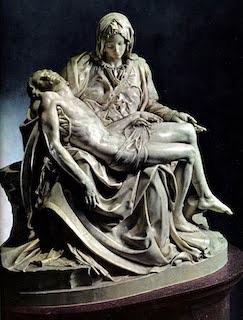


A strange sight was witnessed on the USSR Central TV on November 6, 1989: a deep-voiced, silver-haired priest of dignified appearance addressed viewers in a program called “Eternal Questions.” Such an event was unprecedented at the time, both for the Soviet audience and the state-run television alike. So much so that his ecclesiastical title—archpriest—was misspelled. What the audience could not have known at the time is that the speaker had been explicitly forbidden to use the word “God” in his 10-minute TV appearance. He spoke about a person’s inner world, the meaning of life, and eternal values. This first homily on the Soviet Central television can still be studied as a model of Christian kerygma, of how to express a man’s profound longing for higher meaning, something the priest has masterfully accomplished. The priest’s name was Fr. Alexander Men.
When religious freedom finally arrived in the Soviet Union, Fr. Alexander became a public figure, recognizable in every household throughout the USSR. Over the next two years, he delivered around 200 public lectures, speaking at Houses of Culture, universities, public schools, and even in stadiums. With his wide breadth of knowledge, he was able to get his message across to a broad audience of the Soviet people who were thirsting to hear the Good News, which had been largely out of their reach during their recent past dominated by Communist ideology. Still, the main audience in Fr. Men’s thirty years of priestly ministry was the Soviet intelligentsia—people of science, education, and culture.
On the early morning of Sunday, September 9, 1990, Fr. Alexander was on his way to Divine Liturgy when he was approached by a stranger. The stranger handed him a written note. (It is still a common practice in Russia to convey most intimate requests to a priest via a note.) Fr. Men put on his glasses, unfolded the paper and began to read. Suddenly, he was struck on his head with an axe by a second stranger from behind. Bleeding, he slowly continued on his way to church. “Who did this to you, Father Alexander?” asked a woman who came upon the bloodied priest. “No, it was no one. Just me.” He turned around and began walking back; as he reached the wicket gate of his house, he collapsed. His murder, unsolved to this day, sent shock waves across the whole country.
Alexander was born in Moscow in 1935 to secular, well-educated Jewish parents. His mother raised Alexander as an Orthodox Christian, after she had converted to Christianity and received baptism on the same day as her 6-month old son. It was the time of what became known as “the godless 5-year plan,” during which the Soviet authorities resolved to erase any mention of God. The anti-religious campaign was in full swing; even the calendar was transformed from a normal 7-day week into a 6-day week to make Sundays, along with religious holidays, fall onto work days. During that time, simply to believe was an act of bravery, and, since 1920s, a large portion of the remaining Russian Orthodox Church had gone underground in order to preserve their faith. From the early days and throughout his life, Alexander, through his mentors, stayed connected to the spiritual heritage of that part of the pre-Revolution Russian Orthodox Church best embodied by men such as the priest-saints Alexius and Sergius Mechevs and St. Nectarios of Optina. Already at the age of 12, young Alexander purposed in his heart to become a priest.
In 1953, the year of Stalin’s death, Men, who was fond of biology, began his university studies in the Moscow Fur-and-Down Institute. The Institute was transferred to the city of Irkutsk in Siberia in 1955. In 1958, when Alexander was set to graduate, he was expelled without a degree from the Institute because of his religious beliefs. The combination of Alexander’s outstanding intellect, superb social skills, and deep Christian faith was a bête noire for the Soviet system. Yet God’s hand was on the life of the future “apostle to the Soviet intelligentsia”: one month after he was expelled, Alexander was ordained a deacon; two years later, he graduated from the Leningrad Theological Seminary and was ordained a priest. In 1965, Fr. Alexander completed his studies in Moscow Theological Academy, done mostly through independent study, something he continued to pursue all his life, to his last day.
To put Men’s writings into context, we must understand what motivated him to become a voice for Christianity to his own people. The Soviet culture was categorically anti-religious, viewing any type of faith as its ideological adversary. All educational and social institutions upheld and coercively indoctrinated the materialistic creed that “science had proven that there was no God.” Materialism and atheism reigned uncontested in all quarters of society; any public mention of God, other than in a derogatory way, was considered scandalous. In the face of these universal anti-religious sentiments, there was Alexander Men, with his deep convictions, inner strength, wide erudition, and his unwavering belief in the power of Christ’s eternal message to reach his ideology-laden contemporaries.
Already as a college student, when Alexander had to take the State Examinations on political economy and Marxism-Leninism, he demonstrated his erudition and knowledge of these topics but refused to kowtow to the prevalent views or hide his Christian convictions. Needless to say, he had to suffer the consequences, but, providentially, his expulsion from the university solidified his path to priesthood and the life of ministry. During the 1960s, priests were limited to “church confines” with any activity outside the church walls strictly forbidden and all the happenings inside being closely monitored by the state security agents. The main focus of Fr. Alexander Men was to reach people with the message of Christ, for which he constantly sought new and creative ways. Fr. Alexander’s scholarship is marked by a deep understanding of the Christian message and how to convey this message to his main audience—people educated in the atheistic Soviet system. Because he could not publish in his home country, all his major writings were first published under a pseudonym abroad.
The breadth of Men’s views is sometimes confused with him being indiscriminate or insufficiently Orthodox in his convictions. However, Fr. Alexander’s living out the words of St. Paul, “I have become all these things to all, so that by all means I might save some” (1 Cor 9:22), points to the true source of his breadth. His numerous spiritual children and millions who have been reached with the profound message of Christianity remain a living legacy to his labors. Furthermore, the leading hierarchs in the Russian Church, men such as Metropolitan Anthony of Sourezh and Patriarch Kirill, highly praised Fr. Men’s works and his character as a priest.
Fr. Alexander’s own voice in his defense can be heard in his response to an anonymous critical letter by another priest. This response, given as an Appendix to Vol. 1, showcases Fr. Men’s scholarly approach to biblical studies and outlines his way of thinking by demonstrating that his approach does not constitute a novelty in the Church but, rather, extends the work of ancient Church Fathers in general and, in particular, the tradition of scholarship exhibited at the heyday of the Russian Church prior to the Bolshevik Revolution (and later continued by the Russian emigration, e.g., in St. Sergius Institute in Paris). Fr. Men’s works do not produce final answers to many of the questions being posed; he only exemplifies how to boldly engage the world with the goal of “unpacking” Christianity as a sanctifying force transforming humanity—an effort that requires prayerful and diligent work of today’s Christians. As such, Fr. Alexander Men was realizing Fr. George Florovsky’s famous thesis of “forward, to the Fathers!”
The first volume of History of Religion: In Search of the Way, the Truth, and the Life, is a condensed version of Men’s magnum opus under the same title, which consists of seven volumes. Men’s original work was more academic in nature even though it was written for the broad Soviet audience in mind. Fr. Alexander always prized a broad education and had plans to publish a more accessible version of his History of Religion. His untimely death stood in the way of his plans; this work was continued by his friends and family who condensed each of the seven volumes into the seven chapters of Volume 1.
The second volume, The Paths of Christianity, this book, provides a daring overview of the history of the Church in the first millennium, ending with the Baptism of Russia. In it, Fr. Men presents the history of the Good News spreading and taking root in medieval cultures. He does so without glossing over the more controversial aspects of Church history, adopting, so to speak, the vantage point of the Heavenly City of St. Augustine. The second volume is based on Fr. Alexander’s (incomplete) book The First Apostles (Chapter 1) and his notes on the history of the Church (Chapters 2 and 3) that he first prepared when he was still a young man, around the age of twenty. Similar to the first volume, this book acquired its final shape at the hands of Fr. Alexander’s friends who continued his work posthumously. As textbooks, both volumes are conceived to be accessible to entry-level undergraduate students.
As the translator, I felt that there was a considerable value in incorporating references to all the citations and expanding footnotes found in the original seven volumes and Men’s The First Apostles (but not available in the Russian edition of these textbooks). At times, when Fr. Alexander was paraphrasing rather than directly quoting his sources, a preference was given in this translation to quoting the original, indicating with square brackets and ellipses whenever the text was modified in some way. An index was also included to help those who want to use these books as a reference.
Since Fr. Alexander was a biblical scholar himself, who knew biblical languages and translated certain biblical passages directly from the original, none of the quotations of the Bible follow a particular English translation unless explicitly stated otherwise.
Fr. Alexander placed much importance on visuals to reach the audience with his message. Most of the illustrations found in these two volumes follow the Russian edition, but, in some cases, they have been replaced with thematically suitable alternatives. The original dating of some illustrations and artifacts has been changed to reflect the more recent sources for dating.
Like the Russian version, each of the two volumes has a section with suggested Further Reading. Whenever a suggested book was not available in English, this translation offers an alternative reading covering the same area. However, a more glaring gap exists in the reading list for the second volume, The Paths of Christianity, which, in its Russian version, includes the works of many excellent church historians of the pre-Revolution era and the first half of the 20th century (e.g., Vasily Bolotov and Anton Kartashev), experts in Eastern Church patristics (e.g., Archim. Cyprian Kern), and Soviet researchers of Byzantium (encyclopedias on Byzantine culture and writings)—the sources available only in Russian today.
On a personal note, as the translator, I have come to appreciate Fr. Men’s works in my own spiritual journey. My hope, as well as the motivation for taking on this task of translation, has been that these books will provide some wisdom and guidance in how to better navigate, reconcile, and integrate the deep spiritual heritage of humanity and of the Church with many of the challenges that face the modern world and society.
I want to acknowledge the help of many friends and family who contributed to improving this translation. Samuel Carthinhour, Waymon Lowie, and Maury Tigner spent countless hours poring over and improving my at times rugged translation. Holly Dzikovski, Matthew Andorf, and Gregory Fedorchak made many useful remarks on Volume 1. I am indebted to Hugh and Arlene Bahar for many excellent suggestions on how to improve both Volumes 1 and 2. Finally, this work would not have been possible without the continued love and support of my entire family: my wife Natalie, and sons Samuel, Alexander, and Matthew. Whenever any of the text reads fluidly, special thanks go to Natalie, whose graceful touch has enlivened not only this translation but imbues every day of my life with meaning and color.
Ivan Bazarov
May, 2021
Jerusalem, 30–35
Velleius Paterculus, a seasoned veteran and a confidant of Tiberius, was sitting in his library, finishing writing a book on the history of Rome. In that book, he examined the paths that had led the city on the seven hills—through wars and revolutions—to the position of a world power. Velleius lavished praise on Augustus and his successor for reviving “the old tradition[s]” by strengthening the rule of law and bringing glory to Rome for centuries to come.[1] The historian was convinced that the most important events in people’s lives were decided on the battlefields and in the offices of politicians. It never occurred to him, as he was writing the final lines of his book, that something new was being created far away in Jerusalem. And by whom? By a handful of tradesmen and fishermen from Lake Tiberias!
Those fishermen and tradesmen were not taken seriously even there in that strange eastern city located on the outskirts of the empire. The execution of their Master that had taken place a month prior appeared to have put an end to yet another messianic movement. The High Priest Joseph Caiaphas remained unruffled in the face of incredulous rumors that were circulating throughout Jerusalem at the time: what else to expect from the superstitious crowd. Pontius Pilate returned to Caesarea immediately after Passover and immersed himself in work; he had enough worries and concerns on his hands, and the incident with the “King of the Jews” quickly faded from his memory.
Meanwhile, the quarter in the eastern part of the city where Peter and the disciples settled with their friends, relatives, and new members of this religious community, had its own special existence. They lived as a big family with “one heart and soul” (Acts 4:32).
According to the Book of Acts, about one hundred and twenty Galileans arrived in Jerusalem. It is possible that their number was even larger, but traditionally 120 was considered a minimum for creating a separate community.[2] In Palestine and beyond, there were many such brotherhoods, or Haburot (associations), gathering together for prayer meals. The ecclesiastical and civil authorities were largely tolerant of them.
Those communities varied in their degree of isolation; some of them, such as those who lived near the Dead Sea, all but completely severed their connection with the rest of the world. The community of Christ’s disciples, who became known as the Nazarenes,1 was, however, different. That small group of devout did not intend to stay cloistered and isolate themselves either from the Temple or the faith of their fathers.
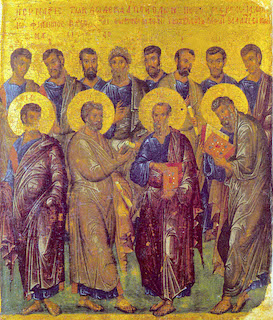
It was not because of inertia that they kept their attachment to the faith of their fathers. A departure from the Old Testament for Jesus’ disciples would amount to a departure from the Lord Himself who had lived and taught building on the foundation of the divinely revealed faith. His own coming was in fulfillment of biblical promises. The apostles were hoping that the New Covenant that He had established would quickly spread to all the people of God; although it did not happen, the Church continued to maintain a strong connection with the heritage of Israel through Tradition and the Bible.
Whereas men prayed separately from women in synagogues, and the rabbis did not allow women into their schools, the apostles did not want to disregard the will of their Master, who had been always surrounded by men and women alike as His disciples. Thus, the faithful prayed together in homes as if anticipating Paul’s words: “There is neither male nor female; for you are all one in Christ Jesus” (Gal 3:28).
Miriam, the Mother of the Lord, whose care was entrusted to John Zebedee, was surrounded by veneration, although she still humbly kept in the background. This explains the duality of Her image in the New Testament. On the one hand, She was the chosen one of God, “the blessed among women,” but, on the other hand, the Keeper of the Mystery, known only to a few followers. It was as if She Herself intentionally shun any fame or glory. The impression left by Her Person was, however, undoubtedly enormous. This explains the legends that surrounded the name of Mary already among the first generations of Christians.2
As in the days of Passover, both bitter and joyful, Her sister Salome, the wife of Zebedee, Mary Magdalene, and other Galilean women were inseparable from Her. They all went to Jerusalem with the apostles. Yet from that moment on, their traces are lost. Perhaps, these women, who treasured the memories of the Gospel events in their hearts, continued their humble service in the community, and some of them even returned to Galilee. Who were those who listened to their stories about the Teacher? Who was warmed by the fire of their faith? This we have no knowledge of. The work of God is often accomplished in mysterious ways and through inconspicuous people.
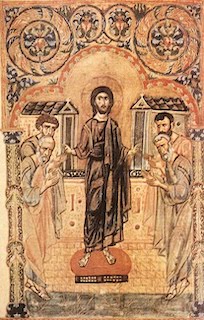
The Lord spoke of the calling of the Twelve, who, upon the advent of the Kingdom of God, would play the role of patriarchs and founders of true Israel, the Church of the New Testament. The biblical number was, however, broken because one of them fell away. Judas sided with the enemies of Jesus and then disappeared. Although his death was known about, there existed different accounts of it.3
To fill in the vacancy, Peter announced at one of the meetings the need to find another man in place of Judas. Convinced that the traitor’s end was foretold in Scripture, the apostle proposed replacing him with a disciple who had been with Jesus from the first days and saw the Risen One. Oddly enough, there were only two individuals who met the criteria: Joseph Barsabbas and Matthias. All the other possible candidates apparently remained in Galilee.
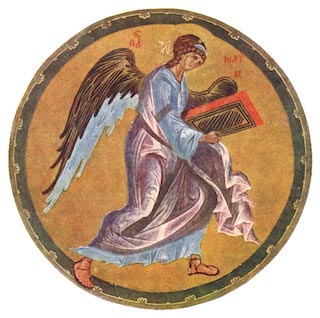
To decide between the two, they resorted to the Old Testament custom of casting lots and praying that God Himself would choose the worthier one. The lot fell to Matthias, and he was “numbered” with the Twelve.4 By this act, the apostles bore witness to their faith in the promise of Christ.[6]
Summer was coming in Judea. The grapes were not yet ripe, but the fields around Jerusalem had already turned yellow. The period of shavuot, or the weeks, leading up to the Feast of Pentecost, was drawing to a close. That year it fell on May 29th.
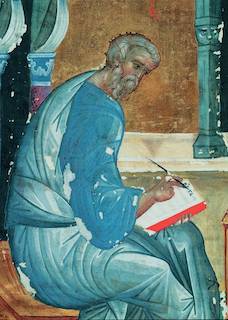
The celebration had long been timed to coincide with the beginning of the wheat harvest. During that time, the priests replaced the old bread before the altar in the Temple with showbread baked from the grain of the new harvest. But in addition to the wheat harvest, the feast of Shavuot commemorated the giving of the Law. The rabbis used to say that God’s voice at Sinai sounded in seventy different languages according to the number of the nations on earth.[7] In an apparent confirmation of this legend, Jerusalem turned truly multilingual during the holiday. It brought together representatives of “all Israel” from many parts of the world, as well as proselytes5 of various nationalities. Some pilgrims had not left Jerusalem since the days of Passover.
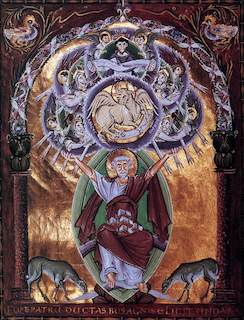
The Nazarenes were also filled with a festive anticipation. With great joy and hope, they were full of confidence that God had ordained them to be His witnesses. On the night of Pentecost, which was set aside for reading the Torah, the Lord’s disciples were looking for places in Scriptures that pointed to Christ. Every event in His life, His death, and Resurrection took on a new perspective in the light of the prophecies. They may have had access to small collections of Messianic texts: such scrolls already existed at that time, particularly among the Essenes.
With the onset of the festive night, the apostles were reading and praying in the upper room of their main meeting place. This house apparently belonged to Mary the Jerusalemite, the mother of John Mark (who later became a companion of Peter and Paul).
At the approach of the dawn, everybody present was overtaken by something utterly unexpected. They felt as if the fire of Heaven had pierced them, resembling the experience of the Old Testament prophets at the time of their calling. There were no words to describe such an unparalleled experience other than using symbolic imagery. Accordingly, the Evangelist Luke6 uses biblical symbols of epiphany when referring to the descent of the Holy Spirit: “a sound from heaven, as of a rushing mighty wind,” and “dividing tongues, as of fire” (Acts 2:2–3).
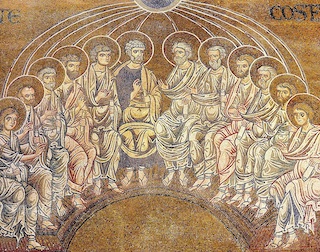
Outside observers could only see how a crowd of Galileans, easily recognizable by their guttural dialect, left the house and loudly praising God proceeded to the Temple. Standing among the columns of Solomon’s porch,7 they continued to pray and sing in the Temple.
The group of Galileans was drawing attention to themselves even though loud displays of emotion were common in the East. Their enthusiastic praising was not bound by their language, as they seemed to be speaking in an unknown dialect. What was absolutely incredible is that their ecstatic babble was intelligible to those whose hearts were open. They understood it despite the fact that many of them who lived far from Judea had long forgotten their native language, while others did not even know it. However, as is often the case, the miracle remained incomprehensible to skeptics and unbelievers. They were scoffing Galileans explaining away their ecstasy by wine.
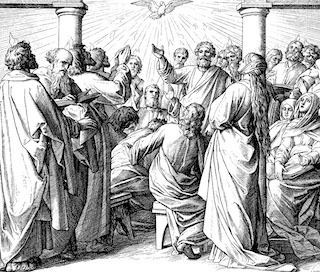
What does it mean to “speak in other tongues?” It is hardly possible to establish in detail what happened on the morning of Pentecost in 30 AD. St. Luke related a story of the event that had taken place half a century before he wrote his book. It is unlikely that the apostles received a permanent ability to speak foreign languages. Most likely, the Evangelist described a case of glossolalia, which refers to speech-like utterances in an ecstatic state. Glossolalia could explain why outsiders hearing the apostles thought they were drunk. The Apostle Paul, too, said that people speaking in “unknown tongues” may appear like madmen to outsiders who walk into a congregation (see 1 Cor 14:23). But this would be merely an outsider’s impression. Importantly, people who did not speak Aramaic were able to understand the apostles’ unusual praises. The message went from heart to heart, bypassing language barriers. This event could be seen as a foretaste of the universal spirit of the Gospel that transcends any country or tribe boundaries.8
Then why did Luke describe the events of Pentecost as unique? He must have been well aware of glossolalia often accompanying believers’ prayers when overshadowed by the Spirit in Christian communities, implying that the miracle was not in “speaking in tongues” per se. In early churches, the Spirit descended only through the laying on of the apostles’ hands. But the unique thing about the events of Pentecost was that the power of God operated without any intermediaries. The miracle was in the complete rebirth of the disciples: fearful and indecisive only a day before, they suddenly became courageous heralds for the Messiah.
A special outpouring of the Spirit was needed to give momentum, vitality, and insurmountable power to the nascent Church. Without such empowerment, the rapid spreading of the streams of the new faith would have been impossible. In only two or three decades, the Good News spread from Asia to Gibraltar—this was the tangible and indisputable result of the outpouring of the Spirit. And one more thing: the real witnessing began only when the “unknown tongues” fell silent.
Peter rose to the platform and the crowd immediately fell silent. The dozens of wondering, anxious, and questioning eyes were peering at him all around. While the fisherman had made proclamations at the command of the Teacher before, this time he was not in a Galilean village but in the spiritual center of Israel. He was addressing the crowds who had come from distant great cities; famous scholars may have been found among them. However, he was not the same Simon either. At first, he appeared small against the backdrop of huge buildings and the multitudes. As he continued, he seemed to have grown bigger with his voice thundering imperiously under the arches of the portico as if an experienced tribune was addressing the crowd. It was as though an ancient prophet suddenly appeared in Jerusalem.
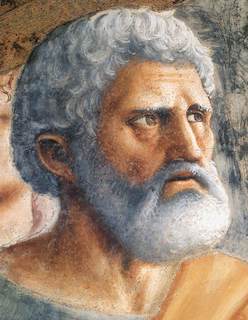
“Men of Israel!” solemnly proclaimed the Apostle. “Jesus of Nazareth, a Man attested by God to you by miracles, wonders, and signs which God did through Him in your midst, as you yourselves also know—Him, being delivered by the determined purpose and foreknowledge of God, you have taken by lawless hands, have crucified, and put to death. Him God raised up, having loosed the pains of death, because it was not possible that He should be held by it” (Acts 2:22–24).
Peter again made a reference to Scripture and came to a shocking conclusion: “Therefore, let all the house of Israel know with certainty that God has made this Jesus, whom you crucified, both Lord and Christ” (Acts 2:36).
The apostle stopped and silence spread over the crowd. If this man’s words were true, then something catastrophic had undeniably happened. It was unlikely that those standing in the crowd had ever seen the Nazarene, although it is possible that some of them might have been in the city during Passover. The execution of the Galilean Teacher had gone past them, leaving them indifferent, but upon hearing Peter’s words, they accepted them wholeheartedly. They were captivated not by theological arguments but by the power emanating from this man who resembled Amos and Isaiah. It became clear that God Himself was speaking through him.
“What shall we do? What shall we do, men and brethren?” a chorus of discordant voices was heard all around.
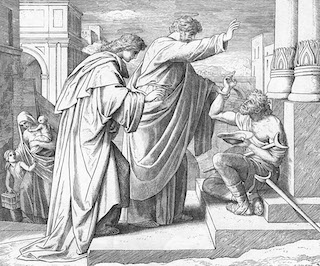
“Repent, and let every one of you be baptized in the name of Jesus Christ for the remission of sins; and you shall receive the gift of the Holy Spirit. For the promise is to you and to your children, and to all who are afar off, as many as the Lord our God will call” (Acts 2:38–39).
These words did not surprise anyone, for ablution had long become an accepted sign of spiritual cleansing—one that opened the way to a new life—practiced by many teachers, including John the Baptist.
The ensuing events transpired very quickly. The crowds led by Peter descended to the stone arcade where the stream formed the Siloam reservoir. The reservoir was partitioned into two sections: for males and females. The apostles were baptizing everyone who repented with pilgrims waiting in long lines for their turn. Some of them were baptized in the Temple pool—a mikveh—used for ceremonial immersion. By evening’s time, the number of converts had already reached three thousand.
The worshipers did not want to disperse. Instead they were intent on staying together: day after day, they eagerly listened to Simon Peter and other apostles. They learned from them that the Kingdom of God had already come and that the Savior brought reconciliation with God. They also heard that the Messiah expected them to be pure of heart and compassionate to one another and that He would soon appear to judge the living and the dead.
Caiaphas was most certainly informed about the incident; he may have even witnessed some of it himself. But the time was not right to take drastic measures because of the holiday, which brought many pilgrims to the city. Therefore, the members of the Sanhedrin decided to wait, hoping that the restless Galileans and their agitated supporters would soon leave the capital, and the wave of enthusiasm would die down on its own.
Their hopes, however, turned out to be false.
Christ once said to His disciples that if they had faith, they would do greater signs than He Himself had done (see Jn 14:12). The power of the Spirit manifested not only in the power of the apostles’ words, but also through their actions. Although even the disciples themselves were not initially aware of it. The miracles began when Peter and John came across a crippled beggar at the gates of the Temple who was asking them for alms. Obeying the Master’s command to help the afflicted, Simon boldly said: “Silver and gold I do not have, but what I do have I give you: in the name of Jesus Christ of Nazareth, rise up and walk.” With these words, he raised the beggar by his hand. “And immediately,” writes Luke, “his feet and ankles received strength. So he, leaping up, stood and walked and entered the Temple with them—walking, leaping, and praising God” (Acts 3:6–8). The healed man stayed with Peter and John in Solomon’s porch, which was quickly flooded with people filled with horror and delight at the miraculous healing performed by the apostles.
Again, thousands were baptized.
Not surprisingly, the apostle’s miracle caused a greater commotion than his preaching. Luke writes, “they brought the sick out into the streets and laid them on beds and couches, that at least the shadow of Peter passing by might fall on some of them” (see Acts 5:15). This is when the authorities realized and became increasingly concerned that the story of the Nazarene lived on and they could no longer delay an intervention.
The supreme tribunal, the Sanhedrin, was in the hands of the Sadducee party, representatives of the higher clergy and highborn chieftains. They looked with suspicion at all religious innovations, including the belief in the coming resurrection of the dead. The Sadducees got along well with the Roman administration while striving to suppress the rebellious mood among their own people. They were the ones who condemned Jesus and handed Him over to the procurator. Seeing that the disciples of the Crucified One were beginning to stir up trouble, the high priest ordered the arrest of Peter and John.
Caiaphas was surprised by the bold answers of the Galileans who were “uneducated and common men” (Acts 4:13). “Whether it is right in the sight of God to listen to you more than to God, you judge. For we cannot but speak the things which we have seen and heard,” (Acts 4:19–20), they said to the high priest. Although the feast passed and pilgrims were beginning to leave the city, Caiaphas still feared potential unrest and released the apostles after issuing them threats. However, he soon regretted and reversed his decision by ordering their second arrest.
Luke writes that an “angel of the Lord” freed Peter and John from prison and they voluntarily went back to the Sanhedrin to appear before the elders. It remains unknown whether it was literally a miraculous release or someone, risking a severe punishment, secretly organized their escape9 (Acts 5:19–20).
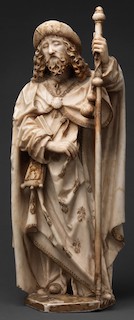
Caiaphas accused them of instigating unrest and insurrection: “You have filled Jerusalem with your doctrine, and intend to bring this Man’s blood on us!” This reference to Jesus by avoiding calling Him by name would become common among those in Judea who opposed Him and His followers (Acts 5:28). The Sanhedrin was wary that the speeches and the healing by the Nazarenes could reignite the memory of Jesus’ execution, which was beginning to fade away, and the crowd’s indignation against the legitimate authorities. But things have changed, and Peter stood firm, instead of hiding and trembling at the gates of Caiaphas’ house: “We ought to obey God rather than men” (Acts 5:29). The Sadducees were furious.
The help came from an unexpected direction. The party of the Pharisees in the person of their leader Rabban Gamaliel stood up in defense of the Nazarenes. It was later said of the Rabban that with his death, the glory of the Law ceased, and purity with abstinence disappeared.[8] The Pharisees, contrary to popular belief, were not uniformly sworn enemies of Christ. There were many of His secret and open followers among them. Furthermore, their old feud with the Sadducees only reinforced Gamaliel’s desire to free Peter and John. He declared that the truth of the new teaching could only be judged by God. More than once, there had been sectarians and deceivers who pretended to be messengers of heaven, but they all were quickly forgotten. “And now I say to you,” said the Rabban, “keep away from these men and let them alone; for if this plan or this work is of men, it will come to nothing; but if it is of God, you cannot overthrow it—lest you even be found to fight against God” (Acts 5:38–39). The words of the wise Pharisee had an impact, especially since Caiaphas realized that Pilate would be reluctant to side with the Sadducees again and authorize new reprisals.
Peter and John were punished with thirty-nine lashes; according to the Law, this number signified that the case was settled and that the person was cleared of guilt.[9] The cruel scourging did not crush the apostles; they went to the brethren, “rejoicing,” as Luke writes, “that they were counted worthy to suffer shame for the name [of Lord Jesus]” (Acts 5:41). The Sanhedrin positioned itself for further developments.
The opposition from the authorities was not the greatest challenge faced by the Church. The most pressing issue was how to organize and direct the lives of the converts who already numbered in several thousands. The majority of the Galileans and those who joined them had neither a permanent shelter nor income to support themselves in Jerusalem. The apostles did not want to leave the city because the Lord Himself commanded them to stay there for twelve years.10 Moreover, they could not abandon the newly baptized who were in need of the instruction, support, and care.
The disciples were not distinguished by any special experience or talent. Everything they were able to accomplish was performed by miracle, through the power of the Spirit.
One of such miracles was love among the believers. Believers were not simply “like-minded” individuals, but true brothers and sisters, united by strong cordial bonds. They were all willing to share their possessions—up to the last coin—with one another. The richer among them were selling their property or land and bringing the proceeds to the apostles as a contribution to the common treasury. Others shared their houses and fed the poorest among them. While people of means were in the minority, the community was materially sustained thanks to them. Among those who did much of the community were Mary, Mark’s mother, whom Peter lovingly called “his mother,” and her relative Joseph Barnabas, a Levite who had come from the island of Cyprus. He was a noble person called “the son of consolation,” Paul’s future friend and companion. He became a source of information to Luke who learned from him the stories about the early years of the Church in Jerusalem.
One of them is a sad recounting of the story of Ananias and Sapphira, showing that the community did not consist of ideal people. These two, wishing to be known as benefactors of the Church, brought Peter the money from the sale of their estate. By their account, they had given away everything they owned. In reality, the couple concealed some of their proceeds. Instead of the due recognition he was expecting to receive, Ananias was sternly rebuked by Peter who read the deceiver’s true intent. According to Church tradition, both Ananias and his wife, who followed in her husband’s steps, suddenly fell dead11 (see Acts 5:1–11). The apostle Peter’s indignation at their deception was not a spontaneous outburst of anger. According to Luke’s narration of the event, Peter’s pronouncement of the judgment that they “lied to the Holy Spirit” who lived in them revealed the pain of betrayal experienced by the body of believers.
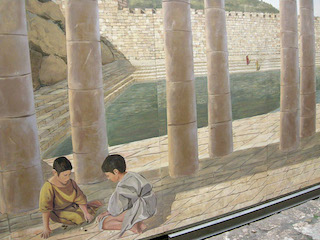
The apostle’s reproach to them is equally noteworthy: “What was acquired by selling, was it not in your control?” (Acts 5:4). These words reveal a voluntary nature of believers’ sacrifices to the apostles and that there was no strict charter in the Church, unlike that of Qumran that required a renunciation of all property. What the Jerusalem community valued was brotherly love, as expressed by believers freely and voluntary.
It was a common practice for believers to gather in their houses at night time: they solemnly broke Bread as on Passover, gave a Eucharistic12 prayer of thanksgiving, a reminder of the passion of Christ, and passed the Cup from hand to hand.
Jerusalem – Damascus, 35–37
There were several converts from the diaspora countries who got baptized on the day of Pentecost. At that time, the majority of the people of Israel already lived in Diaspora. By most optimistic estimates, out of the seven to nine million Jews who inhabited the Roman Empire, only one and a half to two million lived in Palestine.[11,12]
In Antiquity, two peoples—Greeks and Jews—were destined to live in large diasporas. The modest lots of their poor homelands became too narrow for them. The Greeks could be found from the Atlantic to the Indian Ocean. Jews also settled throughout the Mediterranean region and further to the East, as far as Parthia. The places of diaspora settlements usually coincided with the caravan routes. Living alongside the Greeks, the Jews embraced many elements of their civilization, and those among them with a Greek mother tongue became called Hellenists. They kept their biblical faith and made an effort to visit the Temple at least once a year; some of them, having traveled to Jerusalem, chose to stay in the homeland of their ancestors for good.
However, the poor knowledge by Hellenists of their ancestral tongue prevented them from merging with the locals; they were often treated with arrogance, if not with contempt, so they preferred to settle in special quarters of the city and establish their own synagogues. Among the several hundred prayer houses in the capital, a considerable number belonged to those who came from Egypt (Alexandria and Cyrene), Antioch, and Asia Minor. A separate group was comprised of the “Libertines,” the descendants of Roman freedmen.
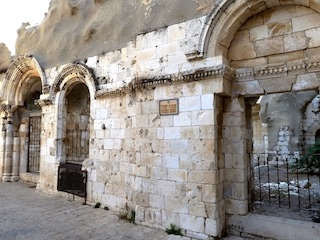
These people read Scripture only in the Greek translation and followed the customs learned in foreign countries. The most educated of them applied themselves to philosophy and literature that arose at the fusion of Judaism with Hellenism.
The entry of the Hellenists into the Church marked an important milestone. Despite creating many difficulties, it broadened the intellectual horizon of the Church and introduced new trends into it.
The main challenge was that people from the diaspora lived in a certain isolation; language and cultural barriers set them apart from the Hebrews—the Aramaic native speakers. And this could not but affect their standing among the Nazarenes.
It is generally believed that Luke gave an idealized picture of the life of the first community of believers, but in reality, he did not hide its dark sides, as can be seen from the episode with Ananias and Sapphira. Nor was he silent about the tensions that arose between the groups of Hebrews and Hellenists. We do not know the exact nature of those tensions. The Evangelist only points out that as a result of those tensions, Greek-speaking Christians began to complain about their brethren. They claimed that their poor, especially widows, were being neglected in the daily distribution of bread.
Whether this was indeed the case or the reproaches stemmed from the suspicion by the Hellenists, the apostles realized an imminent need to solve the problems, which emerged in the community. Otherwise, they would have to carry the responsibility to attend to the everyday community needs themselves, “having left the word of God.” Therefore, the apostles decided to follow the path of the division of labor: having conferred with other elders, they proposed to create a council of “seven men” of good reputation,13 wise, and filled with the Spirit, and entrust them with the task of organizing daily sustenance.
The proposal was immediately accepted. It was quite consistent with the Jewish tradition of appointing a collegium of “seven virtuous men” to head urban communities. Following that model, the apostles chose the Seven14 for the ministry: Stephen, Philip, Prochorus, Nicanor, Timon, Parmenas, and Nicholas. To fend off any future conflict, all seven candidates came from Hellenists.
As it was typical with the appointment of the members of the Jewish Council, hands were laid on them15 with a prayer that the Spirit of God would assist them in their work. This meant that it was not simply an administrative position, but rather an office of ministry. Apparently, each of the seven men ordained for “serving the tables” celebrated the Eucharist as the head of the congregation. The apostles themselves could hardly keep up with everything, considering that the number of the faithful by that time had reached eight thousand.
Thus, the problem seemed to have been resolved with no apparent obstacles standing any longer in the way of the Church. People were treating the Nazarenes—pious, kind, and zealous in the Law—with love and respect. The authorities were no longer acting hostile toward them. The followers of Christ were tacitly recognized as an independent community. Nothing seemed to forebode new trials. The Church did face a difficult prospect of spreading the Gospel to the Gentiles, but the Nazarenes were in no haste to do so because there was still plenty of harvest at home.
Some Church historians argue that Christ never intended a global mission for His disciples. Indeed, in the beginning, He said that the apostles should not preach among the Samaritans and Gentiles, but He also predicted that people would come to the Kingdom of God from east and west (see Mt 8:11). If we ignore these words and the command given by the Risen One “to go and make disciples of all the nations” (Mt 28:19), it becomes unfathomable how Christians came up with the idea of a global mission. It so happened that the mission itself was precipitated by an unexpected crisis caused by Stephen’s preaching.
St. Stephen stood out among the Seven, most likely serving as their head. All of them were devoted not only to practical affairs, charity, and Eucharistic meals, but also to proclaiming the word of Christ. In Acts, Philip is even called an evangelist. Stephen, evidently, proved to be the most dynamic of them. In addition to fulfilling the ancient commandment of Scripture and the precept of the Church—to care for the poor—he was also active as an evangelist.
Christ’s teachings did not abolish the Law and rituals but singled out trust and love as their essence. Christ Himself called the Temple a house of prayer, although He did not regard the Temple buildings and the magnificent sanctuary decorations as something foundational. Buildings can be destroyed; only spirit and truth are indestructible. He Himself built the Church in three days, giving her new life by His resurrection.
This message of Christ about the secondary role of external forms of worship was also at the center of St. Stephen’s preaching. Only fluent in Greek, he most often addressed his fellow countrymen, the Hellenists, in synagogues. Many of them were sympathetic to his ideas, as their ancestors were able to preserve and deepen their faith despite the distance separating them from the Temple.
However, not everyone among the repatriates was like that. Having resettled to Palestine, some became even more zealous in their piety than the most extreme orthodox native to the Land. Stephen’s words cut them to the quick, causing most heated arguments and even a rift in the Greek-speaking synagogues. The more persuasive Stephen’s arguments based on the prophets were, the more anger and opposition they caused among his opponents. In the end, his opponents—the traditionalists—prevailed and they even managed to stab Stephen in the back. Their informers came to the Sanhedrin and accused Stephen of insulting the sanctity of the Temple and blaspheming the Law.
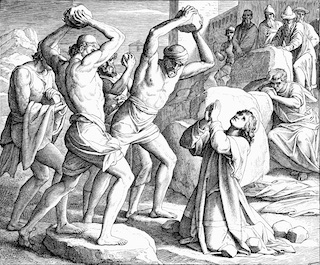
Around that time, an unrest broke out in Jerusalem. Pilate’s cruelty exceeded all limits, and the situation in the country reached a breaking point. A delegation of locals was hastily dispatched to the governor of Syria, Vitellius, with a demand to remove the procurator from Judaea. Vitellius realized that the matter had taken a dangerous turn, and ordered Pilate to appear before the court in Rome, temporarily replacing him with a certain Marcellus.16
It was during that brief moment of anarchy, which had spurred rampant fanaticism, that the agitated crowd incited by the Hellenists seized Stephen and brought him before Caiaphas. “This man,” shouted the accusers, “does not cease to speak blasphemous words against this holy place and the Law… We have heard him say that this Jesus of Nazareth will destroy this place and change the customs which Moses delivered to us” (Acts 6:13–14).
Stephen was asked if he would plead guilty, but he categorically rejected the slander. As he stood before the judges, he felt a surge of supernatural inspiration, and his face resembled the fearsome face of an angel (see Acts 6:15). He began his defense from afar.17 His goal was to show that the entire history of God’s people paved way for Jesus’ coming, and that His death was far from being a tragic coincidence. He recalled the Covenant with Abraham, the deliverance from Egypt, the Law given through Moses, the Promised Land, and the construction of the Temple. Concurrently, he emphasized how often God’s people had opposed His will. He further spoke of the brothers who had sold Joseph into slavery, the Israelites who had rebelled against Moses, the golden calf, and the temptations of idolatry. God had a great purpose, which went far beyond the construction of the Temple.
Stephen’s gaze rose above the angry crowd to witness a divine vision flashing before him. “Behold,” he exclaimed, “I see the heavens opened, and the Son of Man standing at the right hand of God” (Acts 7:56).
Upon hearing those words, the crowd roared with rage. The fanatics covered their ears to block out his words. The trial stopped in its tracks. The building was quickly overrun by the crowd: no one was paying any attention to Caiaphas. Although he was in the position to interfere by calling the guards, he caved in to the crowd and turned the Hellenist over for lynching.
Stephen was hauled out of the hall and dragged to the gates of the city with the crowd screaming in a frenzy (someone remembered the old custom of carrying out capital punishments outside the city walls). This is where the bloody execution took place: he was thrown off the cliff, and the accusers finished him off by stoning. Meanwhile, Stephen was praying for his murderers.
The instigators, however, did not want to stop at one victim. They launched a manhunt for Stephen’s supporters in the city. Apparently, they were mainly looking for Hellenists, and did not spare even women. The apostles were left alone for the time being; the Galileans’ respect for the Temple was too obvious to accuse them of sacrilege.
St. Luke writes that in those days all the faithful fled the city (see Acts 8:1). Yet it appears that most took refuge in Bethany and other nearby villages only soon to return to the city. The Hellenists, previously led by the Seven, were the ones who left Jerusalem for good. Some went to the cities in the north and along the seacoast; others left Judea to return to their native lands, in particular, Antioch.
Thus, the death of St. Stephen served as an unexpected impetus for further expansion of the Church. There was another aftermath of this tragedy. As St. Augustine put it, in response to the first martyr’s prayer, the Church received the Apostle Paul.
As the murderers were executing St. Stephen, they laid their garments at the feet of a young Pharisee, Saul of Tarsus. He did not take part in the execution; yet, having volunteered to guard the clothes, he expressed his solidarity with them. Convinced of the justice of the punishment, Saul, although not cruel by nature, was adamant. The Pharisee, having conquered any doubts that may have crept into his soul, joined the manhunt for the Hellenistic Nazarenes.
Like Stephen, Saul18 was not a native of Judea. He grew up in the diaspora, in the Cilician capital city of Tarsus, where East and West met; philosophy, sports, and trade flourished. Saul’s family had a hereditary Roman citizenship, as evidenced by the Tarsian’s other name—Paul, which was of Latin origin. However, he was proud that he had not become a Hellenist, but was “a Hebrew of the Hebrews”:[18] he preserved his paternal language and kept to the traditions of his ancestors.
And now he was standing at the edge of the cliff, looking down with a heavy feeling at the motionless, blood-covered body of Stephen. It was all over. Or was it?
Soon Saul learned that some devout Jews managed to take away the body and bury it with honors, even though mourning was not in order for those whose bodies were stoned.[19] It could only be explained by the fact that there were many supporters of Stephen. They had to be crushed immediately to capitalize on the anger of the townspeople, before the new procurator would arrive.
Saul knew that the respected Gamaliel was opposed to violence, yet Rabban, too, could be mistaken in not taking the threat seriously enough. The young Pharisee thought that new rioting could be avoided if the apostates were given a fair trial. The Council and Caiaphas would support such measures for they cared deeply about upholding the Temple’s authority.
At the meeting of the elders, Saul sided with the members of the Sadducee party, although they were hostile to him as a Pharisee, and was eventually appointed to be in charge of the persecution. Many Nazarenes were thrown into jail; while awaiting trial, they were being forced to deny and curse the name of Jesus. Yet Saul craved even more retribution. Having begun to act in concert with the Sadducees, he was determined to go all the way. He was informed that the heretical contagion was spreading out, and that Damascus had become one of its centers, with the sect of the Nazarenes taking root in that populous Jewish colony.
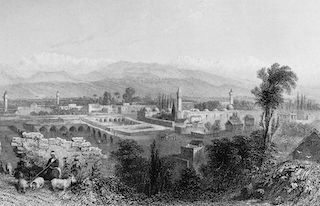
Saul knew he had no time to waste. He came to Caiaphas and asked for a mandate: he planned to find the sectarians in Damascus and bring them to Jerusalem in custody. While Caiaphas was mainly concerned with the events in the capital, he liked the indomitable fervor of the young scribe. Paul’s zeal gave him hope of stifling the unrest before the arrival of the procurator. The high priest readily gave Saul letters to the heads of the Damascus synagogues and appointed him as his shaluach—an emissary or a messenger.
Fate moves in mysterious ways: in a week, this shaluach-inquisitor would turn into a different kind of messenger—the apostle of Jesus Christ.
Shortly before Passover, Saul, accompanied by Caiaphas’ men, left the city gates. The Pharisee, invigorated by his mission, set out on a long journey as a defender and servant of the Law of God. He was driven by his ostensibly righteous anger, which may have concealed his inner turmoil. His main enemy was no longer the defeated Stephen or other apostates from Hellenists, but as Caiaphas, he was seeking to eradicate from the national memory the very name of the crucified one, Yeshua Ha-Notzri, the alleged messiah.
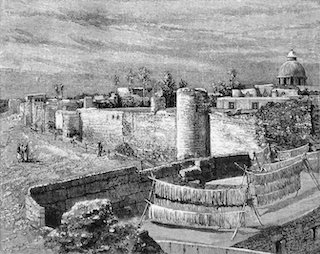
They had to travel at night along the rugged Syrian roads to avoid heat exhaustion. Moving forward in the darkness, Saul was immersed in agonizing thoughts. He could not shake them off, and yet he remained firm, with no visible sign of hesitation. They had been traveling for over a week. Damascus was already in sight. Vineyards, fields, and orchards spread across the vast plain surrounding the city. Saul and his companions no longer made stops to rest. They moved hastily, ignoring the midday heat. The Pharisee was pondering how to begin his conversation with the elders, to convince them of the need for drastic measures, and then to take the guilty back to Jerusalem.
Suddenly the tense silence was struck by an incomprehensible sound, a flash of light that momentarily eclipsed the sun.
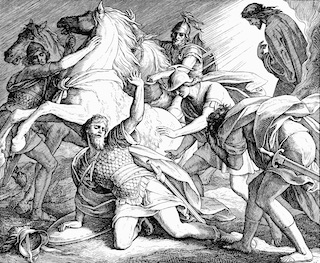
When people came to their senses, they saw their leader Saul lying motionless in the middle of the road. They rushed to him, picked him up; he was fumbling around like a blind man. They had to lead the Tarsian by the arm. This was not the manner in which they expected to enter Damascus. They had been led by an ardent zealot and a judge who was suddenly reduced to a helpless, withdrawn, and blinded man.
The whole group was dumbfounded at what had happened and had no explanation for it.
Years later, as if answering this very question, Paul wrote: “He, who had separated me from my mother’s womb and called me through His grace, was pleased to reveal His Son in me” (Gal 1:15–16).
The Evangelist Luke probably heard from the apostle more than once the story about his encounter on the outskirts of Damascus. The Lord Himself overtook him and set him on a new path. “He heard a voice,” writes Luke, “saying to him, ‘Saul, Saul, why are you persecuting Me?’ And he said, ‘Who are You, Lord?’ Then the Lord said, ‘I am Jesus, whom you are persecuting’” (Acts 9:4–6).
In Damascus, Saul asked his companions to take him to Straight Street to see a certain Judas. Still bewildered, the escorts, nevertheless, obeyed him. In a state of near shock, the Tarsian stayed with Judas for three days without eating. He was surrounded by complete darkness.
On the third day, he was found by a respected Jew in the city named Ananias. We do not know when and where he became a Christian, only that Ananias had already learned from hearsay the name of the persecutor. Not daring to disobey the command of God, he went to see the notorious persecutor. Ananias entered the house of Judas, inquired about Saul, and when they brought him to the blind Pharisee, he exclaimed: “Brother Saul, the Lord Jesus, who appeared to you on the road as you came, has sent me that you may receive your sight and be filled with the Holy Spirit!”
“And it was,” writes Luke, “as if scales immediately fell from his eyes” (Acts 9:17–18).
That same day, the Tarsian was baptized in the name of Jesus. Then, according to Acts, Paul openly declared himself to be a confessor of the newfound faith. But in the Epistle to the Galatians, the apostle himself makes a clarification. According to his report, shortly after his conversion, he withdrew to Arabia, at the neighboring Nabataean Kingdom (see Gal 1:17).
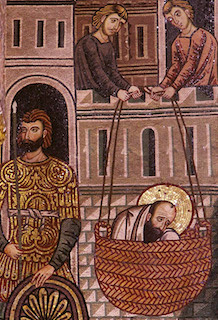
Apparently, he was unable to immediately face those who had been waiting for him as a stern guardian of orthodoxy. Paul’s soul required solitude. He needed to come to his senses and to process everything that had happened to him.
Paul did not stay long in Nabatea. His seething energy could not bear inactivity. Soon after, he reappeared in Damascus and went to the synagogue on Sabbath. Of course, everyone was eager to heed the Sanhedrin’s envoy, who had disappeared shortly upon his arrival. What would he say? Would he refute the delusions of the new sect or demand immediate punishment for its members?
But instead, to everyone’s amazement, the Pharisee professed himself to be a follower of Jesus. He openly called Him the Son of God and the Anointed One.
Stunned, looking at each other in disbelief, they were asking among themselves: “Could it be the same Saul?” Yet out of respect for the guest from Jerusalem, they restrained themselves from interrupting his speech.
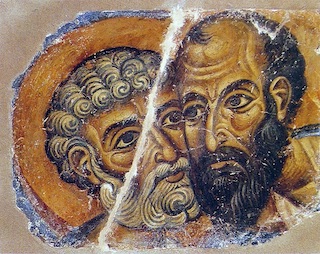
Day after day, the Tarsian preached, taught, and held disputes. The entire colony of Jews was at a loss not knowing what to do. However, as time passed, towards the end of the third year, the elders of the Damascus community finally lost their patience. They decided to dispose of Saul by their own means and “took counsel to kill him” (Acts 9:23).
At this time, the city was transferred by the Romans to the possession of the Nabatean king Aretas IV. An ethnarch (governor) began to rule in Damascus on behalf of the king.19 After he was informed that a certain Jew was sowing unrest, the ethnarch made orders to seize Paul and to guard all the city gates. The Tarsian escaped death by having been lowered in a large basket down the city wall during the night time.
He could have returned to his homeland Tarsus but first he felt compelled to come to grips with his past and visit Jerusalem where he had “persecuted Jesus” and His Church.
The return trip from Syria to Judea felt as a torture for Saul. After all, he had set out to Syria with a proud sense of fighting for a just cause only to return to Jerusalem laden with guilt, vividly remembering Stephen and knowing that the Nazarenes in Jerusalem dreaded a mere mention of Saul’s name.
Saul was returning alone. On the way back, he was wondering how his new coreligionists would receive him. Would not his conversion be viewed as an insidious move by a spy who sought to infiltrate their circle with the intention of destroying them? The very first meeting with the disciples showed that his fears were indeed justified. Paul was being shunned; they refused to talk to him, and not a single of them believed in his sincerity. Although few knew him personally, everyone could remember the role the merciless Pharisee played in the case of the Hellenists.
Feeling bitter, Paul was on the brink of departure. He understood why the believers were treating him that way; he would have likely acted similarly. Suddenly Joseph Barnabas, the patron of the Jerusalem Church, came to Paul’s aid. This humble and selfless Cypriot showed discernment and understanding toward Paul, having comprehended that Paul’s coming to the faith was a great gain for the brethren. After conversing with the Tarsian, he almost forcibly led him to Peter.
For the first time, the two future pillars of Christianity came face to face with each other—a fisherman from Capernaum and a learned rabbi, a native Israelite and a man raised in the Greek-speaking world. At first glance, they could not have been more different; yet Christ brought them together.
Paul also met James but did not seek to meet others of the Twelve. Still he spent two weeks with Peter in the house of Mary. All that time they talked and prayed together. The Pharisee was won over by Cephas’20 warmth. The apostle did not boast before the new convert, nor did he pride himself on knowing Jesus in the days of His ministry. It was the fact that the Messiah, no longer subject to death, was living again there and then among them rather than that of His earthly life that they both treasured the most.
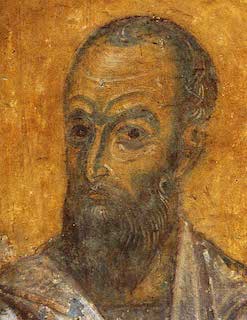
Together with Peter, Paul visited the House of God, and there, during prayer, he was moved again by the sense of Christ’s presence. His voice resounded in the Pharisee’s heart, and now Paul’s calling was finally made clear: his word would not be received in Jerusalem; the Lord instead was sending him “far away to the Gentiles” (Acts 22:21).
Gentiles! The multifaceted world of nations who did not know God. They had long threatened Israel, and Israel had tried to fend them off and ignore them. Surrounded by them, the Old Testament Church saw itself as a type of ark, enveloped on all sides by the waves of the flood. Whenever an attempt at proselytizing was made, it focused on accepting a new individual on board of this ship and turning him into a Jew.
But now, by the will of Christ, the boundaries of the Church were expanding. Saul was called not just to “rescue” individual souls. A global task lay before him: to go into the thick of the pagan world and penetrate it with the light of the Gospel.
Arriving in his hometown, Paul apparently told his family about the transformation which had taken place in him, but he was not met with sympathy. In any case, we know nothing of his family there.21 Perhaps they stopped supporting him. Fortunately, Saul was able to provide for himself. According to custom, rabbis used to make a living by their handicraft while teaching the people for free. In his father’s workshop, Paul had learned how to make tents, which were willingly bought up by army suppliers and merchants.
Paul’s preaching in the synagogues of Tarsus was also unsuccessful: he shared the lot of many prophets who had been rejected in their own country. Yet the years he spent in his hometown would not go fruitless for the apostle. In fact, it was then that Paul, whom we know as the teacher of the faith, was formed.
What did the Gospel of Jesus Christ mean to him? First of all, a new stage, or phase, of the same Revelation, the beginning of which went back to the forefather Abraham. Whereas previously, the will of the Lord had been revealed only in the Law and in the teaching imparted by the prophets and sages, now God was speaking directly to people through His Anointed One.
The source of Paul’s spiritual power was living in Christ. Paul, who “had not known the Lord according to the flesh,”[20] was able to grasp and communicate the essence of the Gospel like no one before him. And this has become both a great lesson and hope for the Church.
Palestine – Syria, 36–43
The unexpected conversion of Paul, the resignation of Caiaphas, and the arrival of the procurator to Judea all helped bring the life of the Church back on a peaceful track. Furthermore, the domestic religious conflicts receded into the background as the entire country was faced with an external threat. In the spring of 37, the twenty-five-year-old Gaius Caligula was proclaimed emperor by the troops. He was beloved for his military courage, but it soon turned out that the new Caesar was a real monster, as the Romans themselves began to call him.[21–23] A mentally ill man, a maniac, and a sadist, he seriously fancied himself to be a god and demanded that altars and temples be built everywhere in his honor.
Although the Empire since the time of Augustus had already grown accustomed to it, the Jews, naturally, resisted the order and sent a deputation to Rome headed by Philo, hoping to get the order revoked. Caligula greeted the envoys with mockery and ordered the governor of Syria, Petronius, to erect his royal statue in the Temple of Jerusalem itself. If necessary, Petronius was allowed to resort to the use of violence. Judea was seething, and the people were ready to take up arms. Petronius was buying time because he realized that to carry out Caligula’s order meant to trigger a war. Agrippa I, the grandson of Herod the Great, who lived at the court of the emperor, urged him not to take such extreme measures. Finally, everyone breathed freely—on January 24, 41 AD, the conspirators did away with Gaius and elevated Claudius to the throne.
During this time, full of anxious expectations, many Nazarenes returned to Jerusalem and were able to live there free of persecution. However, the community’s life had changed; now, the practice of communal sharing of property had been replaced by organized care for the church’s poor.
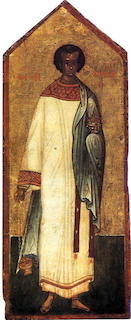
At this time, the apostles received startling news: the Hellenist Philip, one of the Seven, began to baptize people of non-Jewish confession in Samaria.
Historians and biographers of Saul of Tarsus often portray him as the main initiator of the conversion of the Gentiles, who almost single-handedly “led the Church to the wide open spaces of the world.” In fact, Paul was not the first to embrace the idea of preaching the Gospel to the Gentiles. It started with the Hellenists who had left Jerusalem following the death of Stephen. Their mission would expand in concentric circles: from the Samaritans to the proselytes, and finally to the Gentiles. They were convinced that they must hurry to spread the news of Christ everywhere before His second coming.
Philip played a leading role among these preachers. Young and energetic, ready to proclaim Christ under any circumstances, he devoted himself entirely to the cause of evangelism.
When Peter and John Zebedee learned of the conversions among the Samaritans, they immediately set off for Samaria. The Jerusalem headquarters felt responsible for everything that went on in the Church. The journey of the apostles was not long: two or three days of travel and they arrived at their destination.
Having found Philip, the apostles became convinced that God had blessed his bold undertaking. He managed to achieve success quickly and break down the wall of alienation. Perhaps it helped that Philip was not a native Jerusalemite and spoke Greek. The Samaritans knew this language well: since the time of Pompey and Herod, their capital underwent a strong Hellenization and received the name of Sebastia.
“And there was great joy in that city,” remarks St. Luke (Acts 8:8). Philip taught, healed the sick, and baptized new converts. Among them was a certain Simon of Gitta, who was reputed to be a prophet and a conjurer. This strange character, highly popular among the Samaritans, was at first inseparable from Philip, which must have served to give more publicity to the Gospel’s preaching.
In history, the figure of Simon bifurcates, as it were, into two distinct characters. In Acts, he appears to be a simple-minded and superstitious person. On the other hand, his compatriot from Gitta, St. Justin (born c.100), portrays him as a theosophist—a mystic, the author of an intricate occult doctrine.22 The information about Simon, scattered among other antiquity writers, is extremely contradictory.[24–33] Some argue that he was an apologist of the Samaritan religion, others that he believed in a supreme deity, compared to whom the God of the Bible was an inferior and imperfect being.
Subsequently, the enchanter traveled far and wide, incorporating into his system various elements of the then fashionable teachings. In Alexandria, Simon became acquainted with aggressively anti-Jewish writings of Apion and adapted Apion’s views to his own. Thus, he allegedly claimed that “whoever believes the Old Testament is subject to death.”[31] If true, then Simon was encroaching on the Torah itself. However, back at the time of his meeting with Philip, he was still in the process of searching and was eager to join the new movement.
Simon, who was hungry for all kinds of miracles, was particularly struck by Philip’s healings. The apostle Peter, however, made on him an even greater impression. The Samaritan saw in the fisherman a powerful magician who possessed the main secrets of the “sect.” Upon his arrival in Samaria, Peter began to gather the newly-baptized for prayer. The apostle would lay his hands on people, and the Spirit of God overshadowed them—this was like a Samaritan Pentecost. People were mysteriously transformed, experiencing the Lord’s power.
Simon of Gitta was determined to acquire at all cost this power for himself, which he thought to be magical. He approached Peter with money, asking to be initiated into the mystery of administering of the Spirit. The apostle was deeply offended by this suggestion, which showed that the Samaritan viewed the grace of Christ as a magical gift that could be automatically sold or bought! “May your money perish with you,” Peter burst out, “because you thought that the gift of God could be purchased with money!” (Acts 8:20).
Simon, confused and frightened, began to ask for forgiveness. However, his remorse was hardly genuine. Once he realized that he would not be able to take the position in the church which he had hoped for, he left and founded his own sect. This sect would later be regarded as Christian even though it had nothing to do with the Gospel. According to tradition, Simon would continue to oppose the Apostle Peter for years everywhere Peter went, even as far as Rome.23
The Church Fathers saw Simon of Gitta as “the founder of all heresies.” Indeed, his theosophy, as far as we can tell, opened a long series of attempts to replace Christianity with a motley mixture of popular superstitions and Gnostic occultism. In those days, as during any time of crisis, people were especially keen on all kinds of arcane teachings allegedly containing “all the answers,” something that would allow the Simonians to continue to exist for the next several centuries.[34,35]
Meanwhile, Peter and John completed their mission among the newly baptized and returned to Jerusalem. On their way back, they themselves began to address the inhabitants of that area with the words of the Gospel. Their visit to Samaria also demonstrates just how fervently the Church was protecting her spiritual unity.24 From then on, the apostles and their successors would closely monitor everything that happened in their scattered communities, maintaining a genuine connection with them.
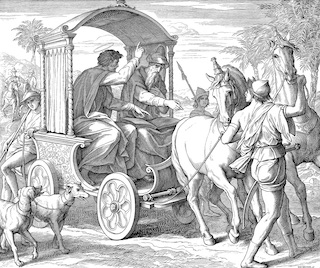
Twenty years after these events, the Evangelist Luke met Philip in Caesarea, from whom he learned about the further progress of preaching the Gospel in Palestine. In particular, Philip relayed to him an episode to which he attached great significance. Obeying a command from above, Philip abruptly left Samaria. God directed him to the road leading south from Jerusalem to Gaza. This may have seemed like a pointless exercise given that the city of Gaza with its surroundings had remained deserted since their destruction by Alexander’s troops. The evangelist Philip knew, however, that the Lord was calling him there for a reason.
And it came to pass that a lone chariot appeared on the abandoned old highway. It clearly belonged to a foreigner: chariots had not been used in Judea for a long time. Philip, without hesitation, caught up with the rider and began to walk alongside. A dark-skinned, fancifully dressed man sat in the carriage, reading aloud an open scroll. And, as happens during a long monotonous ride, the fellow travelers got into conversation. The visitor turned out to be a eunuch, courtier of the Ethiopian queen of Aksum. A Jewish colony had long existed in his homeland, and many Ethiopians favored the refined monotheism of the Bible. Among them was this nobleman, who was returning from his pilgrimage to Jerusalem. Having passed Gaza, he continued his way along the sea to far-off black Africa. This remarkable conversation between the representatives of such alien cultures was only made possible by two factors: the Jewish Diaspora and the spread of Hellenic civilization. Both travelers knew Greek and shared a common faith. The Ethiopian pilgrim was reading Isaiah in translation,25 and Philip inquired whether he understood what was written. The man replied that he would like to receive some clarification, and invited the Hellenist to join him in his chariot.
It is remarkable that Philip did not offer so much as a new doctrine or life rules to the stranger but, according to Luke, “preached the good news of Jesus” (Acts 8:35). His words were so convincing that his fellow traveler, seeing a pond near the road—probably dug by nomadic shepherds—posed a direct question: “Here is the water; what prevents me from being baptized?” (Acts 8:36).
Philip had always been quick and intuitive. He chose to disregard the fact that the entire instruction of the Ethiopian consisted of a single road conversation, and that, strictly speaking, he was not even a proselyte. Only those who had been made part of the Jewish community were considered true proselytes, whereas eunuchs could not be accepted into it.26 In a word, he was willing to overlook all the restrictions. The horses were stopped, and both the Hellenist and the African entered the water. Thus, the first representative of nations, to whom salvation had been promised through the ancient prophet, entered the family of Christ’s disciples.
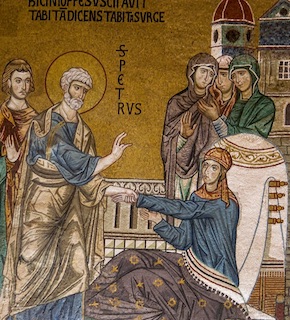
There existed a tradition in the early Church that this man, baptized by Philip, later laid the foundation for Christianity in his homeland.27
Philip spent the subsequent years in the cities located off the coast of the Mediterranean Sea in Israel, where he continued to preach. In Caesarea, he found himself a wife and settled permanently in this Hellenized city. He had four daughters who became famous for their prophetic gift. A new community of the faithful was formed around Philip destined to have a long and glorious history, which would become associated with the names of Origen, Pamphilus, and Eusebius.
As previously mentioned, a new tradition of visiting all recently formed churches was born during the events in Samaria. Therefore, around 40 AD, it became necessary to visit the Palestinian coastal region. The Apostle Peter, this time unaccompanied, set out on the journey again, “passing throughout all quarters” (Acts 9:32). His main goal was to attend to the organization of the young communities; and for them, the arrival of Peter was dear, above all, because they saw in the apostle a witness to the life and resurrection of the Messiah. The apostle continued his Teacher’s work: Luke speaks of two miracles performed by Peter in the coastal region, the rumor of which spread far and wide.
He stayed in Jaffa for a long time. The church there consisted mainly of poor folk, who had always been dear to the heart of the apostle. He chose to live with a tanner in a neighborhood considered “unclean” by the rabbis.
The Book of Acts emphasizes that the people in this “church of the poor” were especially cordial and helped each other whenever possible. The only wealthy member of the Jaffa fellowship was a certain Tabitha, and she too devoted all her strength to serving people. Together with pious widows, she sewed clothes for the poor.
To pagan Caesarea the Apostle Peter came under the most extraordinary circumstances. Orthodox Jews disliked that city, where the Procurator used to live, surrounded by offensive statues and imperial emblems. Perhaps, Peter, too, was reluctant to travel there, especially since there was no church in Caesarea at the time (Philip would settle in Caesarea at a later point). Yet God had a different plan.
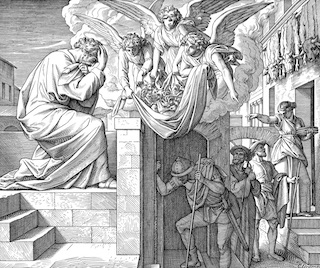
One sweltering afternoon, the apostle went up to the roof of the tanner’s house for prayer at the appointed time. When he finished, the fisherman wanted to enter the upper room, where the women were preparing dinner for him. And at that moment, as if half-asleep, he saw a large piece of cloth tied at four corners let down in front of him. It contained animals prohibited for food by the Law. “And a voice came to him,” writes St. Luke, “Rise, Peter; kill and eat.” The apostle saw this as a test of his devoutness and resolutely refused. No “unclean food” would ever touch his mouth! Peter absorbed with his mother’s milk the age-old traditions that helped the Old Testament Church to stay separated from the Gentiles. These traditions had been sanctified by the blood of the martyrs. But the mysterious voice said: “What God has cleansed you must not call unclean.” The vision was repeated three times. Peter was perplexed. However, he soon became convinced that the vision had a deep meaning (Acts 10:9–18).28
The apostle had not yet come down from the roof when three strangers approached the house: a Roman soldier with two companions. They said they were sent by the Caesarean centurion29 Cornelius. Their master had long and sincerely believed in one God and was friends with the Jews. He belonged to the group of the so-called “God-fearing” or semi-proselytes, who, without performing all the rites of the Law, chose to substitute them with works of charity. And now God commanded him to meet with a certain Peter, who lived in Jaffa at a tanner’s place.
To invite pagans, even those who believed in God, into one’s house or visit them meant to go against the accepted practice. And Peter, probably, would have hesitated, had he not been under the impression of the strange vision. Did it not mean that it was the will of God for him to bypass the old order? He cordially received the Romans, allowed them to stay with him, and then followed them back to Caesarea the next morning. To emphasize the importance of the encounter, he took with him several Jewish brothers from Jaffa.
They walked along the sea coast quickly, without stopping. Finally, they could see the panorama of the city with its customs houses, theaters, and palaces. It was the first time the fisherman had seen that city, and everywhere he looked—there were signs of the Roman presence. Cornelius was already waiting for them, having gathered, as for a solemn occasion, his relatives and closest friends. He was the commander of a privileged Italian cohort, which included volunteers from Roman citizens of Italy (the bulk of the garrison consisted of Syrians, Greeks, and Samaritans); but, forgetting about the pride of an officer and a Roman, he greeted the Galilean fisherman at the door and bowed to the ground in an oriental manner. “Stand up; I am only a man myself,” the embarrassed Peter raised him and entered the house.
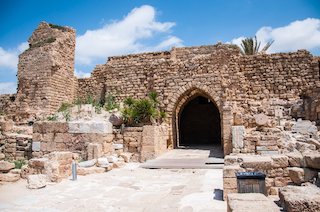
Upon seeing the audience, he immediately informed them that his coming had been precipitated by special circumstances. “You know,” he said, “that it is forbidden for a Jew to associate with or to visit anyone of another nation; but God has shown me that I should not call anyone impure or unclean” (Acts 10:24–28).
A conversation ensued, during which Cornelius recounted his recent vision. The apostle knew immediately that he was in the group of people marked by deep faith. He was astounded—the old notions were receding in the face of the new reality. “Truly I understand,” he admitted, “that God shows no partiality. But in every nation whoever fears Him and does what is right is accepted by Him. He has sent this Message to the people of Israel, preaching peace through Jesus Christ, who is Lord of all” (Acts 10:34–36).
Those present may have heard about the Man who had been executed by the procurator about ten years ago, and now they learned that “God raised Him up,” that He appeared to the chosen witnesses who ate and drank with the Risen One. “Of Him,” Peter concluded, “all the prophets testify that everyone believing in Him receives forgiveness of sins through His name” (Acts 10:43).
The Romans began to praise God and pray fervently. Their state was so familiar to Peter! Wasn’t that how the Spirit of God gave wings to the apostles on the day of Pentecost?
“Who can forbid those who, like us, have received the Holy Spirit to be baptized with water?” Peter exclaimed (Acts 10:47).
There had been a time when, in order to enter the Covenant, one had to “become a Jew.” Now God was opening new ways, for Jesus of Nazareth was “Lord of all.” The boundaries of God’s people were expanding, reaching the ends of the earth.
The apostle stayed in the house of Cornelius for several days. Having baptized the centurion and his loved ones, he conversed with the new converts as a friend, ate with them at the same table. Although the semi-proselyte formally belonged to the category of the Gentiles and, therefore, it was unlawful to share a meal with Peter, the centurion became a brother to the apostle. The Galilean fisherman could not have known that at the same moment, far to the South, the first African Christian was being carried to his homeland in his chariot.
Whereas Peter was able to forget about all the conventions in Caesarea, he was quickly reminded of them upon his return to Jerusalem. The twelve and the elders already knew that Simon “had gone to the uncircumcised and ate with them” (Acts 11:3). Reproaches fell on Peter from all sides. Proud of ancient traditions, the Jerusalemites continued to live in the old world. The apostle had to defend himself, referring to the vision and the descent of the Spirit on the “Gentiles.”
“When they heard this,” writes Luke, “they quieted down and glorified God, saying, ‘So then, even to Gentiles God has granted repentance to life’” (Acts 11:18). In fact, they “quieted down” but not for long, and it is easy to see why. After all, the Law was given from above. Can a single vision undo what people have lived with for centuries? The elders were convinced that the only way to enter the Church was to become a Jew first. The very concept of a baptized Gentile seemed paradoxical to them.
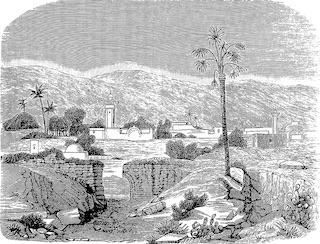
The inertia of conservatism would continue to run in Christianity in different forms and appearances for centuries to come.
Thus, the Jerusalemites concluded that the incident with Caesarea’s officer had been an exception. But less than a year later, they were again confounded by another piece of news coming from Antioch, the capital of the Syrian province.
It was about some Hellenists who had reached Phoenicia and Cyprus. At first, they preached only among the Jews, but in Antioch they ventured to speak directly to the Gentiles: not proselytes or God-fearing men like Cornelius, but those who revered the Roman, Greek, and Syrian gods (Acts 11:20). This audacious act defied all reasonable bounds.
Not only was the mission within Israel far from complete, but how was it even possible to induct into the New Testament Church those who had not yet become acquainted with the Old Testament truths?
According to the established custom, they decided to send an envoy to Antioch. They chose Joseph Barnabas for that task—everyone knew his tact and ability to rise to the challenge even in most difficult situations. It was he who had received Paul when others would turn away from him. In addition, Barnabas was originally from the island of Cyprus and knew the area well.
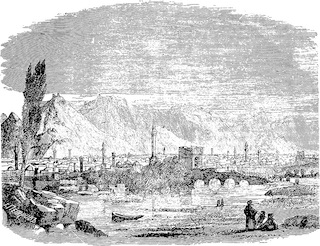
An indefatigable walker, Joseph probably preferred to travel on foot by way of Damascus and Hama, the distance that could be covered in two weeks. As he approached Antioch, he hardly suspected that he was heading to the city that would be called the second capital of Christianity.
Rome and Jerusalem continue to play a major role in world events. Antioch, on the other hand, is all about the past; a remote Arab settlement now huddles in its place. Yet in the days of the apostles, it was the “pearl of the Orient,” the seat of the Roman Governor of all Syria and Palestine. Hellenistic monarchs had founded it a little over 300 years prior to that as a fortified city on the Orontes river for the purpose of linking the Mediterranean with the East.[38] The Roman emperors had continued to expand and beautify Antioch.
As he approached the city, Barnabas could see the even rows of buildings, surrounded by greenery of gardens and public parks. The luxurious villas of the nobility gleamed white among the cypresses and myrtle trees. The city walls were flanked by the pinkish cliffs of Mount Silpius on one side and the wide navigable Orontes on the other.
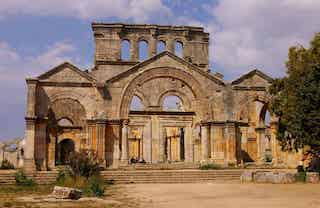
The multi-storey buildings of Antioch were richly decorated; gilded arches and columns were not uncommon. The craftsmen who decorated this third largest city of the empire (after Rome and Alexandria) adapted to the vulgar tastes of the local customers. The cultural level of Antioch was not high. In fact, the capital of Syria could not boast of any outstanding scholars, writers, or artists.
The population of Antioch at the time was nearly a quarter of a million. In the city’s marketplace, it was said, one could get acquainted with the customs of any country. Greeks, Romans, Phoenicians, and Jews all maintained their own neighborhoods separate from the Syrians. The ancient erotic cult of Astarte with its processions and frenzied orgies became intertwined with the imported Hellenic cult. The famous Daphne grove, dedicated to Apollo, attracted many travelers from all over the world.
Antioch’s public was characterized by a lively and free disposition. It thought nothing of booing a famous actor or toppling the statue of the emperor. Yet serious rioting had been rare. The city had an active commercial life, sports competitions and performances were arranged, all kinds of entertainment were devised. The festivities often lasted all night. The street lights did not go out until morning. Brothels lured in customers. Inns, taverns, courtesans, flutists, and dancers were all an integral part of the life of Antioch.
Such was the city that would later become the birthplace of St. Ignatius the God-bearer and St. John Chrysostom, as well as many hermits and ascetics.
In this place of bustle and revelry, mixing of peoples, languages, and faiths, the Jews constituted an enclosed world, as if a city within a city. Yet for all their isolation, they could not avoid frequent contact with the Greeks, Syrians, and other Gentiles. According to Josephus, the Jews of Antioch “made proselytes of a great many of the Greeks perpetually, and thereby, [to an extent], brought them to be a portion of their own body.”[39]
To arrive at the Jewish quarter, the envoy of Jerusalem had to walk almost six kilometers along the central avenue that stretched across Antioch. It was lined with statues and included a covered colonnade that protected it from the heat and bad weather. An hour after Barnabas had passed the city gate, he was among his own people in the street of Singon.
The meeting with the brethren astonished Joseph. Not only did he find a large number of Gentiles who were baptized directly from “Hellenism,” but he saw that these people were aglow with the spirit of faith and devotion. All doubts vanished. Life itself had proven the fearless Hellenists to be in the right, who were unafraid to bring into the Church those who only yesterday had revered idols.
How could one denounce these people who had left the world of superstition and unbridled morals for the sake of a pure life in Christ? “When [the Apostle Barnabas] witnessed the grace of God,” Luke writes, “he rejoiced and began to encourage them all with resolute heart to remain true to the Lord; for he was a good man, full of the Holy Spirit and of faith” (Acts 11:23–24).
Barnabas remained in the city, sending word to Jerusalem that the community of Antioch was flourishing. As a representative of the Mother Church, he was tacitly accepted as a mentor. But it proved harder to deal with the “Greeks” than with the Jews, who had been brought up on the Word of God. Mere disgust with their old way of life was not enough. The moral and religious views of the neophytes had to be completely transformed: they needed to be taught as if they were babes. This raised many questions. To what extent should the Gentiles be initiated into the religion of the Covenant? What should replace the regulations and rituals given by the Scriptures and the fathers of Israel? And should they eventually become something like proselytes in the bosom of the Church?
The Jewish believers continued to live according to the Law, that is, to regulate their daily life with the directives of their ancestral religion. This inevitably separated them from the newly baptized Gentiles. In short, there was no end to the difficulties and problems. Joseph realized that he could not cope with them on his own.
And then he thought of the Tarsian whom he had once welcomed so cordially in Jerusalem. It had been several years since Paul had withdrawn to his native town, and nothing had been heard of him since. Hoping to find him, Barnabas left Antioch and took the northern road to Tarsus.
40–45
Even earlier, when Joseph Barnabas used to live in Cyprus, he probably visited Tarsus and might have even met Paul’s family. Now, having come to that city, the Levite easily found him and offered to come with him to Syria. The Tarsian agreed to it right away: he must have taken that offer as a call from above, for having had no success in his hometown, he had been yearning for a different task. Soon the Antiochians were able to welcome this new member to their Church.
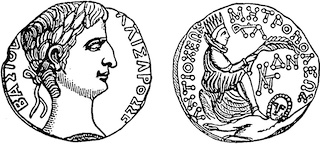
They had heard many remarkable and controversial things about Saul from those who lived in Jerusalem. His arrival was anticipated with excitement and curiosity. However, the Tarsian could hardly have made a strong impression when they first met him. Next to Barnabas, a tall, portly man with a calm, dignified manners, whose appearance the pagans found resembling that of Zeus, Saul looked rather unimposing: outspoken and abrupt, he was small in stature, with fused eyebrows and a large hooked nose. He was in his early thirties but already bald with a hint of gray in his beard. Only his gray eyes commanded a certain power of attraction.30
With the tacit consent of the whole church, Saul, who had been brought to Antioch as Barnabas’ assistant of sorts, soon found himself among its leaders. His education (he was the only theologian among the brethren) and extraordinary personality must have played a role in this. The Antiochians soon realized that in Paul they were dealing with a true prophet of God’s mercy. The very miracle of his calling, his encounter with the Risen One, who had imperiously turned around the course of Saul’s life, brought to remembrance the stories of Amos and Isaiah.
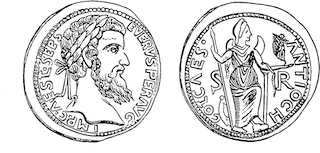
Saul was entirely given over to a single sublime vision. It seemed his every step was taken in the living presence of the Lord. Detachment from earthly things was combined in Saul with striking common-sense realism. A visionary and a mystic, soaring in the realm of spirit and lofty meditations, he bore, however, little resemblance to the refined dreamer depicted by El Greco on his canvas. The apostle became the first among the the Church ascetics who knew how, while living in God, to keep their feet on the earth. He did not shy away from solving important practical problems, revealing a remarkable organizational talent. Underneath his unremarkable appearance lay an iron will, which manifested itself more than once in critical situations. Paul knew how to remain steady—whether he was facing a large crowd, judges, or an imminent threat. For example, he was once the only man not to lose his nerve who took action that led to the salvation of everyone on board the ship battered by the storm and on the verge of destruction (see Acts 27:31–44).
A life without family, without a home, can dry up a man’s soul, turning him into a gloomy and withdrawn character, but that did not happen to the apostle. St. Paul was not without a sense of humor and, sometimes was able to defuse a tense atmosphere with an unexpected joke; being hot-tempered by nature, he learned to restrain himself, demonstrating remarkable humility and tact. We know of many people for whom the apostle had feelings of deep affection and friendship, and they responded to him in kind. Over the years, he acquired devout and selfless students—“children,” as he sometimes would call them. Yet as great as their love was for him, so vehement was the hatred of his opponents. It is significant that it was Paul, and not Barnabas or other missionaries, who suffered the most at the hands of both the Jews and the Gentiles. As we shall see, he was often met with misunderstanding and condemnation even among his own coreligionists.
His talents, deep knowledge of the Bible, and the reach of his vision set the apostle head and shoulders above those who surrounded him, and perhaps he felt lonely because of this. Yet he was never a loner. Always seen in the midst of people, Paul was a natural communicator.
One of the most important tasks facing the Antioch community was the need to determine the status of the baptized Gentiles. Was it necessary to demand that they accept the totality of the Old Testament rules regulating one’s life, the entire intricate conglomerate of ecclesiastical statutes of Judaism? Paul was aware that some Jewish teachers believed that circumcision along with the observance of all the statutes of the Torah was superfluous for proselytes.31 In proclaiming Christ to the Gentiles, the apostle fully approved of that view. In this, he was not guided by tactical considerations, as some of his biographers are inclined to think. In contrast to the Near East, the Greco-Roman world viewed the ritual of circumcision as something alien, but this could not be viewed as an insurmountable obstacle—after all, each ancient religion had its own taboos and innumerable rituals. A requirement for those converting to another faith to adopt its customs would not be surprising. It was considered common practice: in the eyes of Gentiles, religion was inseparable from its sacred ceremonies. Let us recall that the peoples who converted to Islam also accepted the “seal of Abraham” (circumcision) along with it.
Note also that the masses tended to attach weight only to ancient religions, so the preacher of a new religion would always have to invoke some time-honored authority. A doctrine that had no primordial roots seemed a suspicious, purely human invention. For the baptized Gentiles, the role of such “historical foundation” was served by the Old Testament, and therefore there was no compelling reason for the newly converted Gentiles to refuse the Bible ordinances.
The position of St. Paul in relation to the Law was guided, on the one hand, by the prophetic formula: “mercy is higher than sacrifice,” and, on the other, by his view of Sacred history. Following the arrival of the new Messianic era, when God now “creates all things new,” the former Law has become “old.”32 Christ has made a new Covenant with the faithful, in the light of which all ancient religious ordinances are fading like the stars at sunrise. To those in whom the Spirit of the Savior reigns, the magical rituals of polytheism are but rubbish, and even the sacred symbols of the Old Testament, by and large, have became a thing of the past.
Such resolve to challenge the millennia-old norms could have only originated with someone whose life was fully surrendered to Jesus Christ. “In Christ Jesus,” the apostle would say a few years later, “neither circumcision nor uncircumcision avails anything, but faith working by love… [and] a new creation” (Gal 5:6–7; 6:15).
The Nazarenes of Jerusalem had not yet separated themselves from the Jewish community and would come to pray at the Temple. However, the situation among the Antiochians was already different. There emerged a brotherhood virtually independent from the synagogue and variegated in its composition. Even so, its members viewed the “Israel of God,” the Church of Judea, as their source. The holy city where the Twelve lived was naturally recognized as a bulwark of the faith. Like the diaspora Jews, the Antiochian Christians maintained constant contact with Jerusalem. The emissary-apostles and itinerant prophets served as the connecting link.
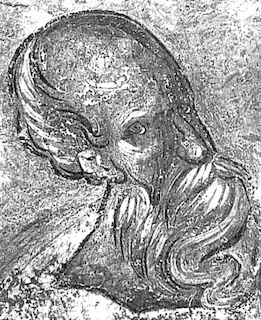
In the early 40s, several such prophets visited the Syrian capital, and one of them, named Agabus, announced the onset of famine throughout the Roman Empire. The Mother Church was already going through difficult times, and it was decided to collect donations in advance for “the brethren living in Judea.” This continued the Old Testament practice of organized aid to the poor (see Acts 11:27–30).33
Indeed, a wave of crop failures soon swept across the shores of the Mediterranean. Emperor Claudius could barely procure enough bread for his capital.34 And the situation in the provinces was far worse. The calamity was about to reach Palestine. However, before the famine would break out there, a different kind of storm swept over the Jerusalem Church.
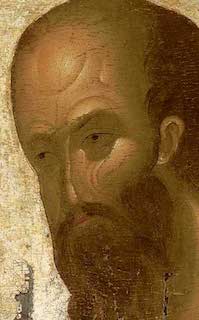
While Agabus was visiting the Antiochians, the government in Judea changed hands. In an effort to calm the country which had been agitated by the follies of Caligula, Claudius sent, in place of a procurator, his confidant Agrippa, the grandson of Herod the Great, and gave him the title of king. Fifty-year-old Agrippa, a clever intriguer who managed to survive in his role of Caligula’s confidant, decided to seize on the moment. His youth had passed among the Roman court nobility, and now he urgently needed to change his lifestyle. Agrippa wanted to look like a real Jewish monarch, and he tried to prove to Jerusalem his orthodoxy by all means at his disposal. To this end, the puppet king decided to start reprisals against dissidents. And there were a lot of them in the country.
Among them, the Nazarenes were the most defenseless. Therefore, the king attacked them first. This took place in the third year of his reign, in the spring of 44. On a false denunciation, the Galilean James, the son of Zebedee, was arrested and soon executed. It remains unknown what specifically he was accused of, though we know that James, like his brother, was a man of an ardent character (hence their nickname “the Sons of Thunder”). Perhaps the informer used some careless word dropped by James in reference to the authorities. Thus the prophecy of Christ was fulfilled: the first of the Twelve “drank the cup” that the Teacher had spoken to him about many years ago.35
Seeing that the Sanhedrin, with which Agrippa ingratiated himself in every way possible, approved of that measure, the king decided not to stop there. He ordered the arrest of Simon Bar-Jonah, the head of the Nazarenes. A show trial was planned this time, which, however, had to be postponed on the account of Passover.
Agrippa was not really interested in justice, and it meant that Peter’s path from the prison cells of the Antonia Fortress could only lead to the executioner’s block. The whole Church was filled with sorrowful expectation. The faithful were praying in the house of Mary, the relative of Barnabas.
Then something incredible happened.
A mysterious hand led Simon out of the Fortress, and only when he found himself in the night street, he realized that what was happening to him was not a dream. Having crossed the sleeping city, he was able to reach the house of Mary. Luke describes his unexpected appearance so vividly that his words clearly echo the story of an eyewitness. “When Peter knocked at the gate, a servant girl named Rhoda came to answer. And having recognized Peter’s voice, in her joy she did not open the gate, but ran inside and announced that Peter was standing at the gate. They said to her: ‘You are out of your mind!’ Yet she kept insisting that it was so. So they said, ‘It must be his angel.’ Meanwhile, Peter continued knocking. When they finally opened the door and saw him, they were amazed. And having motioned with his hand for them to remain silent, he recounted how the Lord had delivered him out of prison and said, ‘Report these things to James and the brethren.’ Then he left and went to another place” (Acts 12:13–17).
The words about “James and the brethren” in this story deserve some attention. Obviously, already then, James was in a position of leadership among the Nazarenes. Now, when Peter was forced to leave Jerusalem, the leadership of the community fell on the shoulders of the Brother of the Lord, who became its de facto head. Most likely, the Apostle Peter, along with the inseparable John, found refuge in their native Galilee. From this time on, they would appear in Jerusalem only as guests of honor.
After the mysterious disappearance of the prisoner from the Fortress, Agrippa must have tried to locate and arrest James. However, he did not succeed in carrying out his intention. At that time, the king was in Caesarea, where he held negotiations with the Phoenicians. There, during a lavish festival in honor of the emperor, Agrippa suddenly felt ill and had to be carried out of the theater. Five days later he died in terrible agony. It is possible that he was poisoned by one of his courtiers who had been bribed by the ambassadors of Tyre.36
The danger hanging over the Jerusalem church was temporarily evaded. Two years later, however, the famine that everyone had feared began in Judea. When the Antiochians learned of this, they dispatched Barnabas to their Jerusalem brethren to take the money they had collected in advance. Acts says that Joseph was accompanied by Paul, but the apostle himself does not mention this. Perhaps he accompanied Barnabas only to the border of the country.37
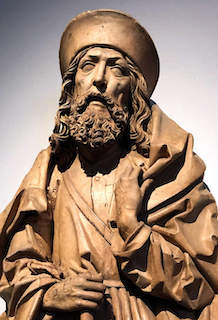
On his return to Antioch, Barnabas took with him the young man John Mark, the son of Mary, who was also his cousin.
Cyprus – Galatia, 45–49
Meanwhile, the leaders of the Antioch Christians pondered the need for preaching in the neighboring lands. The experience of their Church showed that there was a real opportunity to proclaim the Gospel not only to the Jews, but also to the Greeks and those whom the Greeks called barbarians. And there was a need to hurry. The more people would enter the Church before the coming of the Lord, the more faithfully they would have fulfilled His command.
One day, when the brethren gathered to celebrate the Lord’s Supper, the Spirit of God announced to them through one of the prophets: “Set apart for Me Barnabas and Saul for the work I have called them to” (Acts 13:2). No one doubted what this work was about: the Word of Christ had to “spread and multiply.” A fast was announced, and all prayed fervently for the success of the new undertaking. During the prayer, the elders laid their hands on the elect according to the biblical tradition. They were now regarded as messengers of the Antiochian Church, its apostles.
But where should they go, and where to begin? Barnabas offered to go first to the nearest island of Cyprus. This was his native land, and the missionaries could easily find a new haven there. Having taken Mark as their assistant, they set off without any delay.
There were boats and small ships going down the river to the Seleucian port, but the three travelers preferred to take the picturesque mountain road that stretched among the groves and springs. The road was paved with smooth blocks by the Romans to ease the passage of caravans and advancing troops.
Not even a day had passed before Barnabas, Saul, and Mark were already descending to Seleucia Pieria, from where they promptly proceeded to the pier replete with the sails and masts of merchant ships. There was a regular maritime connection at the time between Seleucia and Cyprus. Having made arrangements with the shipowner, the missionaries went on board towards the end of the day.
The mountains of the coast, illuminated by the sunset, were receding behind the stern. The ship, having raised its sails, was leaving the bay, heading southwest. This was the beginning of the long travels of “the Apostle to the Nations.” Gazing into the vast expanse of the sea, he could hardly foresee what lay ahead of him; he could have hardly imagined his future journeys, during which he would cover a distance of many thousands of kilometers. And how? On flimsy boats, on mules, and most often on foot, sleeping in the open air and at inns, eating a handful of olives or flatbreads, experiencing a thousand inconveniences and dangers.
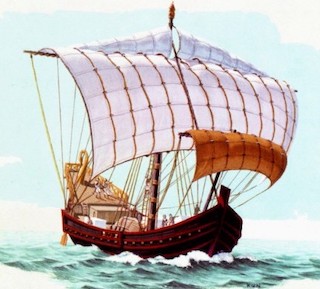
Years later, when looking back, Paul would recall how often he was on the brink of death. “From the Jews five times I received forty stripes minus one. Three times I was beaten with rods; once I was stoned; three times I was shipwrecked; a night and a day I have been in the deep; in journeys often, in perils of waters, in perils of robbers, in perils of my own countrymen, in perils of the Gentiles, in perils in the city, in perils in the wilderness, in perils in the sea, in perils among false brethren; in weariness and toil, in sleeplessness often, in hunger and thirst, in fastings often, in cold and nakedness” (2 Cor 11:24–27).
Paul could have continued laboring peacefully in Antioch among his ardent supporters and caring friends. But the die had been cast: his faith in his mission, willpower, energy, and incredible endurance would guide Paul for the next twenty years, enabling him to lead such a life. He made this choice willingly at the behest of God and his own heart.
The visit to Cyprus was not yet recognized as the beginning of mission among the pagans. The final plan for such mission would mature only during the journey itself and take its final shape in 49 AD following the meeting with the apostles in Jerusalem.
On the second day, the ship entered the Salamis Harbor of Cyprus. As a transit point between Syria and the West, this mountain-forested island had belonged to the Romans for the last hundred years. Cyprus was called the island of Aphrodite, although it was Astarte, the great goddess of Asia, who was worshipped there under that name. The island was also a home to populous Jewish colonies. Barnabas used to live in one of them; he immediately introduced his companions to the circle of Jewish Cypriots, and the missionaries began to visit the synagogues of Salamis. There they began telling about the great events that had taken place in Jerusalem, about the imminent coming of the Messiah, and apparently people listened to them with openness and interest: the first seeds of the Gospel may have already been sown here by the local Hellenists.[52]
As the days passed, Paul began to hurry his friends. He was irresistibly drawn further—to where the strange and unknown lands lay. He was visited by dreams and visions: he looked in them for signs that would indicate the way.
Barnabas did not object—the initiative had clearly passed into the hands of Paul. Perhaps, even then, Mark did not quite like the fact that his relative, the prophet and teacher so revered in Jerusalem, allowed himself to be so influenced by the Tarsian. Be that as it may, both Levites concurred with Saul’s desire to leave Cyprus.
To reach its western port, the travelers had to cross the entire island on foot, covering almost a hundred kilometers. They reached the sea at New Paphos, where the residence of the Roman proconsul was located.
While the missionaries were waiting for a passing ship heading west, they were unexpectedly invited to the house of the governor himself, Sergius Paulus, who turned out to be a man of learning, of inquiring mind, with an interest in Eastern religions.38 His entourage included some Jewish magicians,39 whose famed art he sincerely believed. A certain Bar-Yeshua, nicknamed Elymas, enjoyed the special patronage of Sergius Paulus.
Apparently, the proconsul also regarded the preachers of Christianity as initiates of some new kind of magic. He wanted to meet with Barnabas and Saul to learn more about their teaching. However, Bar-Yeshua became concerned that this could undermine his authority in the eyes of the ruler. And when the apostles came to see Sergius Paulus, the exorcist tried to denigrate them in every way possible in front of his patron. Saul could not stand idly by: for the first time in his life he was speaking about faith to a Roman nobleman, and some conjurer stood in his way! Looking intently at the magician, the apostle literally pinned him to his place with the stern words: “Now the hand of the Lord is against you, and you shall be blind, not seeing the sun for a time!” (Acts 13:11).
Immediately, all those present saw how Bar-Yeshua began groping around in horror.
The Book of Acts says in passing that the proconsul “believed,” yet most likely he only showed favor to the preachers. Luke does not say that he was baptized, and the missionaries did not linger on the island, which would have been natural had the conversion of Sergius Paulus turned out to be serious.
The closest region to Cyprus was Asia Minor, its southern coast. This is where the apostles next sailed to, soon landing near the city of Perga. Whereas Cyprus could still be viewed as a continuation of the familiar biblical lands of Syria-Palestine, now, stepping off the ship, the travelers found themselves in an entirely different world. People in strange, unusual clothes scurried about the pier speaking incomprehensible languages. The area was surrounded by malarial swamps, and the ghostly silhouettes of mountains loomed in the distance. Arduous crossings using deserted roads awaited the apostles, and anyone they met could turn out to be a robber: dangerous Isaurian bandits roamed the local forests. Roman civilization had barely touched these remote lands, inhabited by semi-savage warlike tribes. Still, Saul and Barnabas knew that some cities had Jewish communities and that it would be possible to move around the country from one community to another.
The Romans called this province Galatia, although the real Galatians, or Gauls, lived farther north, in the very heart of the peninsula.40
The missionaries walked upstream along the river bank and after a few kilometers reached Perga, a large, well-maintained city with a forum, palaces, theaters, and aqueducts. In addition to merchants and Roman colonists, pilgrims would often travel to this city, attracted by its temple of Artemis. This goddess had been revered in Asia Minor from time immemorial.
John Mark was horrified to learn that they were going to venture further into this realm of forests, mountains, unknown tribes, and pagan gods. He felt overwhelmed by homesickness: he wanted to be back in Jerusalem, in his mother’s house, among his own. He flatly refused to go further. In vain did Saul and his cousin try to persuade him; Mark turned back and boarded the next ship bound for Judea (see Acts 13:13).41
Barnabas remained loyal to the Tarsian, and now, just the two of them continued on the road that stretched directly north off Perga. They probably learned that there were many Jews living in Antioch of Pisidia. While the diaspora served as a guiding thread to the apostles, Rome, too, unwittingly assisted them.
Asia Minor, inhabited by many Aryan tribes42 before its capture by the Turks, had always had a mixed population. Hittites, Cimmerians, Gauls, and Greeks waged wars here, creating and destroying states. Warhorses’ hooves trampled these plateaus and valleys long before the invasions by the Persians and Alexander’s phalanxes.
It is impossible to imagine the mission of Barnabas and Paul taking place outside the confines of the Roman Empire. Around the time of their journey, Plutarch would write with enthusiasm about the transformative role of Rome: “The world was filled with unspeakable violence, confusion, and revolution in all things, until such time as Rome was raised to its just strength and greatness… comprehending under her power many strange nations and dominions.”[60] Of course, not everything was as splendid as the philosopher portrayed, but we must admit that the unified Roman law and order was an invaluable factor for the mission, while the international Greek language allowed people to understand each other anywhere in the Empire.
However, we should also remember that the evangelists mainly had to travel along the empire’s barbaric outskirts. The influence of the center reached primarily the cities, which were connected by the system of the Roman military roads. It was these roads that Saul and Barnabas unswervingly followed wherever they went.
Two men, staff in hand, wearing traveling cloaks were walking briskly along a wide paved road: one was tall and stately, and the other was squat and stooped. They had been walking for a day, two, three. Once in a while, they were overtaken by horsemen and postal carts; trade caravans and detachments of soldiers would be encountered along the way. The road ran across the plateau surrounded by gentle, forested hills. Occasionally, their route was traversed by rivers, which they had to cross by boat. Meadows began to give way to cliffs, groves, and bushes. On the third day, the expanse of a large lake opened up on their left against the backdrop of a bluish distant mountain range.
For about a week the apostles had continued their journey, until they descended into a valley surrounded by green groves. Houses clung to the slopes of the mountain surrounding a pagan temple. Traces of the Roman presence could be seen here and there: a colossal aqueduct, porticos of massive administrative buildings.
This was Antioch of Pisidia, which had received its status of a colony under Augustus. After staying in an inn for a short while to recover their strength, the missionaries took time to inspect the area. They inquired the whereabouts of the synagogue and went there on the first Sabbath.
The community, lost in the pagan country, greeted them as welcome and honored guests. At that time, a constant connection was maintained between the centers of the Diaspora; courier merchants and teachers of the Law brought books, news, decrees of the Sanhedrin and collected church donations. Such visitors had the right to address those gathered in the synagogue with a word of edification. Therefore the apostles were invited to speak to the congregation, especially after Paul had introduced himself as a rabbi, a disciple of the famous Gamaliel.
There could be no better opportunity. Having climbed the platform, Paul began his address. His sermon was so new, unexpected, and unusual that the apostles were invited to speak in the synagogue again the following Sabbath. They went out into the street, surrounded by the crowd, who escorted them back to the inn. People were clearly excited and asked many questions; the arrival of the guests from Judea became a significant event in their quiet provincial life.
The first century AD is usually portrayed as a time of religious decline and indifference, but in fact it was distinguished by the spirit of God-seeking and thirst for truth. The wars that had raged for centuries subsided, and life was returning to its peaceful course. Imperial taxes were counterbalanced by increased prosperity brought about by the rapid development of agriculture, communication routes, trade, and crafts. Yet man shall not live by bread alone. The cult of Caesar along with antiquated religious beliefs could not satisfy the spiritual hunger. Therefore, the words of the new sermon found fertile ground in Galatia.
Word of Paul and Barnabas spread throughout the town. The next Sabbath, not only proselytes and synagogue regulars, but also a large group of those who had never before stepped inside a synagogue, filled the pews and courtyard of the house of worship.
The leaders of the congregation watched this gathering of Gentiles with increased alarm and annoyance. They considered the preaching of the guests to be their internal affair. For generations, they had jealously guarded their faith from outsiders. Their sense of belonging to an ancient culture confined within the walls of their voluntary ghetto made them similar to those traditionalist Christians who would later be known for their ingrained distrust of the neophytes. Luke explicitly says that these people became “filled with envy” (Acts 13:45).
Paul and Barnabas felt a wall of hostility rise around them. Leaving the synagogue, they spoke out directly: their message was not wanted here, so they would go to those who would receive it.
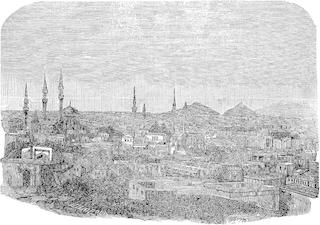
From that day on, the preachers began to gather people in the houses of proselytes and Gentiles and converse with them. They baptized those who had believed. However, their opponents were not going to tolerate this. With the help of influential matrons close to the Jewish community, they succeeded in getting the authorities to expel the newcomers from the city. It was not difficult to find a formal reason: Roman laws prohibited the establishment of new cults.43
This conflict, having thus broken out, never abated, accompanying the apostle throughout the rest of his life.
From there, the travelers decided to continue their journey to the southeast, to the region of Lycaonia. This decision was prompted by two reasons: first, there were many Jews in this region’s border city of Iconium, and the apostles never deviated from their rule of first taking their message to the Jews. Second, it was there that the only road south of Galatia led, stretching all the way to Paul’s birthplace, Tarsus. Having passed the flat, sun-scorched plain, the evangelists entered Iconium a few days later. Surrounded by gardens, Iconium resembled an oasis in the desert.
The same series of events happened here as in Antioch of Pisidia. First, a discussion in the synagogue, after which “a great multitude both of the Jews and of the Greeks believed” (Acts 14:1), followed by a new wave of hostility. Probably, the men who had been dispatched from Pisidia after the apostles managed to set against them both the Jewish community and the Roman administration. However, the adversaries could not immediately expel the preachers this time: the number of those who converted and sympathized turned out to be too great. Therefore, Paul and Barnabas stayed in Iconium for several weeks.
They managed to consolidate the first circle of Christians, the nucleus of the future church. Their sick would be healed through the prayers of the missionaries. Following the Lord’s command, His servants healed not only the spirit but also the body. In their eyes, human ailments were a symptom of the universal sinfulness of mankind that had fallen under the power of demonic forces. That is why, prayer over the sick, which accompanied their preaching, was an important aspect of evangelism.[63]
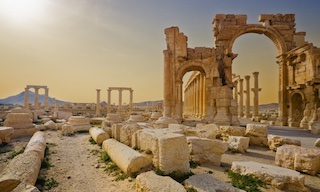
Paul himself rarely baptized neophytes, leaving it to Barnabas; he considered his main task to be “the ministry of the word.” This does not mean, however, that he viewed baptism as something secondary. Although baptism was very early referred to by the pagan term mysterion (sacrament), it was fundamentally different from the sacraments (or mysteries) that flourished in the Hellenistic world. The rites of pagan mysteries signified man’s partaking of the secret forces of the dying and resurrecting nature. Meanwhile, the Gospel’s baptism, like its prototype, the baptism of proselytes, served as an entry point into the family of the people of God, the community where the Spirit of Christ was at work. By entering it, the new convert was uniting with the Lord Himself.
Meanwhile, in Iconium, the controversy surrounding the preaching of Christianity continued. Legend has it that the apostles were eventually sentenced to exile from the city: a certain Iconian nobleman, whose fiance Thekla had decided to follow Paul, filed a complaint against them. But according to Acts, Paul and Barnabas secretly fled the city as soon as they learned that “the Gentiles and Jews, together with their rulers, set out to mistreat and stone them” (Acts 14:5).
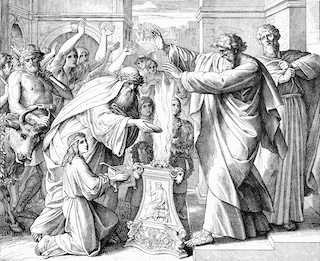
It was impossible to return to Antioch. They had to move further into the depths of the mountainous country, where only Gentiles lived. Anxious, the missionaries approached Lystra, a small Lycaonian town. They could barely understand the local language. Here lived the highlanders, relatives of the ancient Hittites, whose kingdom had fallen many centuries earlier. These people, though Hellenized, retained many features of their former way of life. There were no proselytes to be found because there was no synagogue in the town. This was the first time Paul and Barnabas encountered such a situation. They tried in vain to make contact with the Lycaonians, saying that they brought them the message of salvation. They had, however, too little in common with these people to count on success. Still, Paul was not going to retreat.
The turning point occurred unexpectedly under circumstances that might otherwise have caused a smile had they not nearly cost the apostle his life.
Among those who listened to St. Paul was an incurable man with paralyzed legs. When he caught the word salvation in the Jew’s speech, he seized upon it as his last hope. The apostle noticed it and, looking intently at the Lystrian, as he would do in such cases, commanded him to get up. There were loud shouts from the amazed crowd: a miracle took place—the cripple hesitantly got to his feet. A commotion started: the Lycaonians began talking excitedly about something the missionaries could not make out.
Soon a solemn procession was pulling toward the city gates. Priests in wreaths marched in front, leading bulls; the altar of Zeus, which stood at the entrance to Lystra, was hastily decorated with garlands; there was discordant singing and shouting. It was only now that the missionaries understood what was happening: it turned out that the superstitious people imagined that the gods themselves had come to them, as, according to legends, it had happened in the olden days.44 The stately looking Barnabas was mistaken for Zeus, and Paul, who spoke on behalf of both, for his messenger, Hermes.
The apostles were in utter despair. They tore their clothes, as Jews would do upon hearing sad news, and rushed into the middle of the crowd, begging them to stop their sacrilege. “What are you doing?” they shouted in Greek. “We are also men like you!” (Acts 14:15) The meaning of these words finally reached the audience. The crowd was feeling disappointed and bewildered: the people wanted to believe, yet the feast did not materialize.
The missionaries did not expect this turn of events. It became obvious that it was too early to speak about Christ here. The efforts of their mission in Lystra were nevertheless rewarded with a remarkable conversion. Paul met there a pious Jewess named Eunice, who was married to a Lycaonian Greek. She got baptized together with her mother. When the apostle visited Eunice, her son Timothy, a boy of about fifteen, listened attentively to his message. The love of Scripture was instilled in him by his mother from early childhood, although, apparently, she did not circumcise her son in deference to his father. The fascinating words of a man who had come from the homeland of his mother’s ancestors captivated the teenager. He quickly grew attached to Paul with all his heart. In a few years, Timothy would become his “son,” his beloved disciple and reliable assistant.
As soon as Paul and Barnabas began to feel accustomed to the Gentile town, their work was once again interrupted. The fanatics in Antioch and Iconium had easily guessed where the missionaries’ route lay next, and they soon showed up in Lystra. They no longer complained to the authorities but decided to deal with Paul directly. They managed to instigate a crowd of townspeople, who, without warning, surrounded the Tarsian and began stoning him. Paul collapsed and fainted, and the murderers, thinking him dead, dragged him out of the city gates and dumped him in the field.
Barnabas and a handful of Lystrian neophytes immediately learned of this. They rushed to search for the body and, finding Paul motionless and bloodied, began to mourn his death. Probably, among them was the lad Timothy. As they stood heartbroken, Paul suddenly began to show signs of life. With the help of his friends, he got to his feet, and, under cover of darkness, he was taken indoors. The wounds were not life-threatening, and the next morning Paul was able to leave the city. Together with Barnabas, they went further southeast, to the neighboring city of Derbe.
The apostle was inspired by the thought of his having suffered for Christ’s sake, just like the Hellenist Stephen had done twelve years ago. Perhaps the scars left by the Lystrian stoning became what he would later refer to as the wounds of Christ that he bore on his body.[65]
In Derbe, his pursuers left him alone, apparently believing that he had died. There he founded another community, which, as in Lystra, consisted almost entirely of the Gentiles. Having made “many disciples” in the town (Acts 14:21), the missionaries were going to continue along the Roman road to Tarsus, where they could rest before returning on foot to Syria and Syrian Antioch.
But suddenly there was a new obstacle. The apostle had a fit of severe illness, which would continue to torment him on occasions. He himself believed that this disease was sent to keep him humble. “There was given me,” he writes, “a thorn in my flesh, an angel of Satan to torment me so that I would not exalt myself. Three times I prayed to the Lord to take it away from me, but He said to me, ‘My grace is sufficient for you, for My power is made perfect in weakness’” (2 Cor 12:7–9).
It is impossible to know precisely what kind of illness it was. It is only clear that it was recurring at regular intervals. Some biographers believe that Paul, “like other great historical figures—for instance, Caesar and Napoleon—suffered from epileptic fits.”[66] Others are inclined to think that the “thorn in the flesh” was malaria, which Paul contracted in the marshy lowlands of Pamphylia.
In any case, the missionaries chose not to return via the eastern road. Perhaps Paul’s illness was not the only factor in their decision. The apostle was sensitive to the inner voice: he constantly felt Christ as a mysterious Companion in his apostolic labors. Then something, which Luke is silent about, made him decide to take a risky step: despite the apparent danger, to return via his previous itinerary in order to encourage the young communities.
The missionaries remained in Derbe while Paul was still weak from illness, where he was surrounded with affectionate care from the brethren. Once the apostle’s health improved, the missionaries set off on the return journey: again through Lystra, Iconium, and Antioch of Pisidia. They could not stay in these cities for long: they came and went, avoiding prying eyes. And yet they succeeded in their main goal: they not only strengthened the spirit of the Christians but also appointed elders or presbyters for them.
This act marked a new stage in their apostleship. This was the beginning of the history of the Church further taking root on Gentile soil.
Presbyters were not leaders of the Church; such leadership was to appear later; their main ministry was in presiding over the Sacred Meal. From the very beginning, presbyters would not be elected but rather appointed by the apostles, just as Christ set aside the Twelve for Himself.
Thus, it was believed that the apostles passed on to the presbyters presiding over the Sacred Meal the gift that they, in turn, had received from Christ Himself. Other ministries within the congregation were determined by abilities or charismas: some became prophets, others—teachers, yet others—evangelists; but in essence all had equal standing. This combination of the spirit of brotherhood and apostolic authority provided churches with vitality and stability.
From Pisidia, the apostles went to the sea, reached the port of Attalia, and from there sailed directly to Syria. Thus ended their first trial mission journey.
They returned victorious. Everyone thanked God for opening the hearts of the Gentiles to the Gospel. It was a great celebration for the Antiochian Church and at the same time a triumph for young Christianity.
Syria – Judea – Asia Minor, 49
The joy that reigned in the Church of Antioch was soon overshadowed. Some brethren from Judea appeared at one of the prayer meetings and baffled everyone with their words. Acting as the guardians of the purity of orthodoxy, they declared to the baptized Gentiles: “unless you are circumcised according to the custom of Moses, you cannot be saved.” In other words, anyone who wanted to become a full-fledged Christian had to first enter the fold of Judaism.
Their statements were not without grounds or merely borne out of prejudice: according to the Scriptures, the ordinances of the Old Testament Church were commanded from above, and moreover, “for time everlasting.”[67] The Lord Jesus Himself kept them and taught that every letter of the Law mattered and that He did not come to abolish the Torah.
It was difficult to argue against such weighty arguments, which, however, could not sway St. Paul. The missionary knew more than just the letter of the Law. He boldly countered the formal correctness of the orthodox with revelation whose inner authenticity was indisputable to the apostle. He was convinced that it was no longer required to hold onto the old markers of belonging to the people of God in order to attain union with God in Christ, especially for non-Jews.
It mattered a great deal to Paul how his friend Barnabas, one of the most respected members of the Mother Church, would react to his words. Joseph supported him, albeit after some initial hesitation. However, the rest of the Jerusalemites continued to press their case; the discussion inevitably turned into a quarrel. The faithful were confused and discouraged: on the one hand, the word of Jerusalem carried weight and authority, and on the other hand, the success of the missionaries in Galatia proved that God Himself had blessed their undertaking. Neither the elders nor the converts of Antioch considered themselves capable of dealing with such a complex theological dispute. Naturally, the idea arose to send envoys of the Church to Judea, so that they could obtain a final clarification on the matter there.
Everyone, of course, wanted to include Barnabas and Paul in the delegation, but the Tarsian was not sure at the time whether he should participate in this delicate matter. Subsequently, he would himself emphasize that he agreed to it only “because of a revelation” (Gal 2:2). As a representative from the baptized “Greeks,” they took a certain Titus, who later became the apostle’s assistant.
On their way south, they visited communities in Phoenicia and Samaria, founded by the Hellenists fourteen years earlier; everywhere they went they were received with honor.
But what awaited the delegates in Jerusalem? They hardly expected the same kind of reception there. Paul and Barnabas could easily imagine the kind of rebuff they were about to receive in the capital of Judea.
In the years since that memorable Pentecost, the Jerusalem community had developed its own strong traditions. Two waves of persecution did not crush it; moreover, the position of the Nazarenes had been greatly improved following the death of King Agrippa I. The Pharisees at the time were headed by a liberal teacher, Yohanan ben Zakkai. He was known for his tolerance and believed that even Gentiles could be saved by good works. Yohanan shunned extremists calling for war with Rome; he considered his main task to strengthen faith and piety. His motto was: “Serve the Almighty not out of fear, but out of love.”[68] Yohanan’s influence partly explains why many Pharisees became close to the Nazarenes, and some were even baptized. James, the Brother of the Lord, also greatly contributed to this.
The prestige of the Nazareth Family increased greatly since Peter and the other apostles left the city in the early 40s. Its members, especially James, were living examples of ancient traditional piety. He was considered almost the thirteenth apostle to whom, in addition to Cephas and the sons of Zebedee, Christ had imparted certain secrets. The brother of the Lord was called Tzaddik, a Righteous Man, and Obliam, a bulwark of the people. Already during his lifetime, he became legendary. They said that this honorable old man was a living personification of the Law for whose sake heaven and earth had been created. He was a Nazirite, consecrated to God from birth: he did not drink wine, did not cut his hair, and abstained from meat. As James passed through the streets, he was greeted as a high priest; he allegedly even dressed like one, in a linen ephod, and had the right to enter the Holy of Holies.45 The Pharisees had nothing to reproach such a man for. He truly “surpassed them in righteousness” (Mt 5:20). His strict observance of the Torah was, in the eyes of its devotees, a serious argument in favor of the teachings of the Nazarenes.
Following the example of James the Just, the faithful who rallied around him would still refer to their houses of worship as synagogues; as before, they scrupulously performed all the rituals, kept the Sabbath, and limited themselves only to foods permitted by the Law. As in the early days, they counted on a speedy conversion of the entire nation, which would be transformed from a sinful Israel into “the Israel of God.”
The great advantage of the church of St. James was that it maintained an authentic tradition surrounding the Gospel events. The parables and sayings of Jesus were well remembered in their circle; it was from here that the first accounts and writings would soon go out into the world forming the basis of the future Gospels.
Nevertheless, their commitment to ritual piety unwittingly alienated the church of St. James from the spirit of Christ’s freedom. It can be argued that while it preserved the priceless riches of the Gospel, it did not penetrate its essence as much as the Apostle Paul did. The Jerusalemites excessively cherished the ritualistic shell of the faith—the form, wherein the danger of stagnation lay.
It is easy to imagine how saddened these devout people were at the news from Antioch. They could not begin to understand how a whole community of fellow believers could be neglecting the Law of God. Apart from the Christians from among the Pharisees, those who called themselves the Ebionites or the poor, were likely the most indignant about it. These people, who had not yet broken away from the Church, were predisposed towards extreme legalism. The Ebionites wanted to preserve the order of the first days of the community: they refused private property and lived on alms.
The core of the Ebionites was formed, apparently, from the Essenes who converted to Christianity and brought with them a tendency towards severe asceticism. Naturally, the Antiochians who refused to be circumcised were, to the zealots of the Law, radicals and apostates.
Paul was anxiously thinking about all of this when the walls of Jerusalem finally appeared beyond the hills.
Having arrived in the city, the envoys wanted to meet with the most influential brethren, who were revered as pillars of the Church. Fortunately, Peter and John Zebedee had arrived in Jerusalem by that time.
Thus, Paul met with Cephas for the second time, but now not as yesterday’s adversary and a novice, but as a preacher and a pastor who had labored greatly for the cause of God. The conversation was also attended by the Apostle John and James the Just.
The Tarsian told them of the miraculous manifestations of God’s grace in Syria and the Galatian province, how he and Barnabas opened the door of faith to the foreigners, and, towards the end, using his favorite expression, he posed the question: “Have I run in vain?” (Gal 2:2).
His account made a strong impression. However, the issue could not be resolved by a private conversation alone—something Paul viewed as the most crucial. The traditionalists were unwilling to accept what they regarded as a harmful innovation. Anyone who wished to enter the New Testament Church, they insisted, must first accept the Mosaic sign of the first Covenant. In particular, they demanded this from Titus.[72]
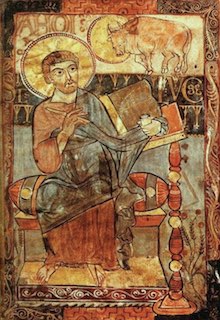
Paul resisted such an outcome with all his might. The apostle would later write in his Epistle to the Galatians that he and Barnabas “did not yield submission even for an hour” to the “false brethren secretly brought in,” as he bitterly referred to his former associates in Pharisaism, “who came to spy on our freedom, which we have in Christ Jesus” (Gal 2:4–5). Paul, who was always willing to meet others halfway in things he considered non-essential, remained adamant in this case.
To avoid an impasse, a general council of elders of the Jerusalem Church, headed by the three pillars, had to be convened. Probably, the number of those gathered was small enough that they could all be accommodated in a single house. This meeting went down in history under the name of the “Apostolic Council.”
The meeting began with a sharp public debate. Luke mentions it in passing, speaking only of “much disputing” (Acts 15:7), but we are already familiar with the argumentation of those who opposed the Antiochians, as well as the fact that it was not easy to refute: they were backed by the letter of the Bible and citing Christ Himself. The orthodox could have also pointed to the example of the Mesopotamian king of Adiabene, whose mother recently visited Jerusalem: having believed in the true God, he accepted circumcision, despite the fact that the liberal Jews tried to dissuade him. Would not this man serve as a living reproach to the Gentiles who had converted to Christianity?
It should not surprise us that the first serious crisis in the Church arose in connection with the rituals. It is easier for people to give up their beliefs than their customs, as can be explained by human psychology. Although the ritual is the channel through which the rivers of spiritual life usually flow, it is easier to maintain rituals than to remain true to the spirit. Thus, Russian Old Believers would rather have been put to the stake and thrown in prison than change their practice of two-finger crossing and seven prosphora. The memory of the Maccabean martyrs who had died for the Law was still fresh in Israel at the time—and that included Jewish believers in Jesus.
After many centuries, it seems that the controversy that divided the Church might have been averted had Christ accurately defined the place of the Law in His teaching. However, the fact that He preached exclusively among the Jews, who accepted the Torah as an axiom, can help us understand why He could not have expressed Himself all the way. Even so, His words already contained a prerequisite for the revision of the Mosaic Law. First, the Lord spoke of having come to “complete” the Law,[73] then He defined a new stance towards revenge and oath-taking, forbidden food and divorce, and finally He pointed out the two chief commandments in the Torah.
The Law was given by God, and only God can change it, let alone cancel it. In this case, it could only be the Messiah, the Son of the Heavenly Father, who would have such authority: “But I say to you….” All future specific reinterpretations of the Old Testament in the light of the New, Christ left to His disciples, to whom He promised the assistance of the Holy Spirit.
At the Jerusalem Council of 49 AD, this heavenly assistance was indeed made manifest.
A miracle occurred when the floor was taken by Simon Bar-Jonah, whose commitment to tradition was beyond doubt.46 It was expected that the first among the apostles would back up the orthodox, but instead Peter spoke in favor of the liberal practice of the Antiochians. He recalled how he baptized the uncircumcised in Caesarea and how the Spirit of God descended on them in his presence. This proved that it was the will of the Lord to accept into the Church even those who did not observe the Jewish rituals. The Apostle John also expressed his agreement with Cephas.
Then Paul repeated, this time for all those gathered, his account of the mission, and the elders involuntarily fell silent as they listened.
There is an opinion among historians that this is how the “Council” ended.47 They believe that Luke augmented his description with an account of yet another meeting of the elders in Jerusalem. This hypothesis is questionable, however, because it ignores the important practical problem that would undoubtedly have been raised: if it was possible to baptize foreigners without requiring them to be circumcised and keep the Law, then how could they be in communion with their fellow Jewish brethren? After all, the canons that regulated every step of the Jew, first and foremost, sought to separate the faithful from the outside world. For example, eating meat without draining blood was just as impious for the Jews as to eat non-Lenten food on Good Friday for subsequent generations of Christians.
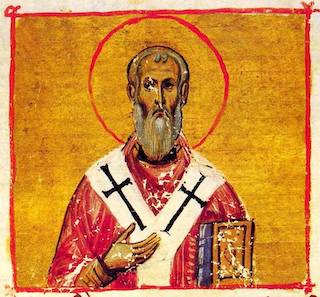
In the end, St. James offered a compromise: Jewish Christians would continue to keep their fathers’ rituals, while the rest would be constrained by minimal rules.
“My judgment is,” said James, rising, “that we should not make it difficult for the Gentiles who are turning to God but write to them to abstain from the things polluted by idols, from fornication, from anything strangled, and from blood” (Acts 15:19–20).
In fact, this was an entirely traditional way out. Such simplified commandments were called Noah’s, and it had long been believed that by observing them, a believing alien could be saved.48
Thus, the Brother of the Lord, and the entire “Council” with him, laid the groundwork for the first national Church, in this case, the Israel’s. This move entailed both great prospects and significant risks. The Church’s readiness to take into account the religious and cultural characteristics of the peoples it enlightened was fruitful, but at the same time, there was a threat of self-isolation of local churches. As long as the Empire existed, this danger was insignificant: within the borders of the state, all peoples were united by a single Greco-Roman culture. Later, however, this threat would increase. Most Church schisms, at times assuming the guise of heresies, have been expressions of such centrifugal tendencies among the local Churches.
The apostles, probably anticipating the danger of divisions, proposed to legitimize the custom, which would become a guarantee of Church unity. “Having recognized the grace given to me,” the Apostle Paul later recalled, “James, Cephas, and John, who were esteemed to be pillars, gave me and Barnabas the right hand of fellowship, that we might go to the Gentiles, and they to the circumcised, only that we should be mindful of the poor—the very thing I also was eager to do” (Gal 2:9–10). Caring for the needs of the Mother Church, especially its members who had chosen voluntary poverty, became an act that strengthened the link between her and the new communities.
An epistle was composed, which Paul and Barnabas were instructed to take to Antioch.
The fact that the pillars openly and publicly acknowledged Paul’s right to be the Evangelist to the Nations became an important outcome of the Jerusalem meeting for the missionary personally. “To give the right hand of fellowship” in ancient times meant to reach an agreement; thus, the status of the Tarsian and Barnabas was approved and confirmed; various roles had been delineated. James remained the head of the Jerusalem Christians, Cephas and the son of Zebedee continued their preaching among the Jews, whereas Paul and Barnabas were assigned to convert the Gentiles.
The envoys returned to Syria with a deep sense of relief. The forced retreat of the orthodox was a great victory, which became a turning point in the history of young Christianity: the Lord revealed new ways, which were past finding out for some and even feared by others.
The prophets of the Jewish community, Judas Barsabbas and Silvanus, often called Silas for short, reinforced the message of the “Council” with their authority. They spent time praying and preaching among the Antiochians before returning to their homeland. All arguing seemed to have quieted down.
Soon Silvanus, who apparently felt drawn to Paul, made a second visit to Antioch.49 This time the prophet came with the Apostle Peter, who went on a new round of church visits. Cephas was immediately won over by the fraternal atmosphere of the Antioch Church. The fisherman entered the life of that community with his usual openness. Whenever the faithful came together for a meal and the Lord’s Supper, he would sit with them at the same table, not asking who was a Jew and who was a Greek. Suddenly, however, the peace of the community was disturbed once again.
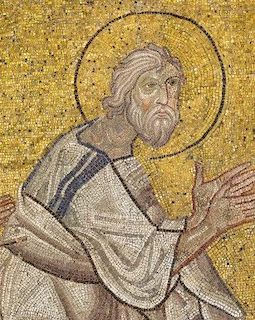
The orthodox in Jerusalem had insisted that James should send certain men to check how rigorously the principle of the two churches was being implemented. Imagine their dismay when they saw Peter himself eating “unclean” food along with everyone else, forgetting about his duty as an orthodox Jew. Their sidelong glances and murmurs in turn confused the apostle. Fearing further offense, he stopped coming to the communal meals altogether. The same tactic was adopted by Barnabas.
Paul was indignant: how could one allow dilapidated partitions to separate those who had been united in Christ? All differences must be forgotten around the Meal of Christ! The Tarsian did not even try to reconcile this conviction with the dictates of the “Council”; he hoped that the Lord would soon be revealed to the world, and all the perplexities would disappear by themselves. What he was really concerned about was that the latest gesture by the Apostle Peter and Barnabas could negate any progress that had been achieved in Jerusalem.
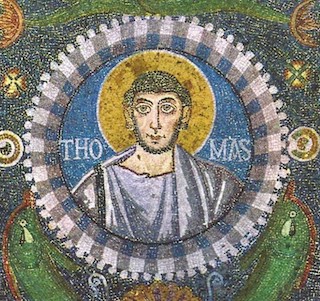
It became obvious that the Council had left many questions unanswered. All this weighed on Paul; he was irresistibly drawn to where he could start all over again, without looking back at the Old Testament churchmen.
He offered Barnabas to visit again the congregations that they had founded in southern Galatia. Barnabas, also distressed by what had happened, gladly agreed to it—he felt relieved to be able to leave Antioch.
They started getting ready for the road. Joseph again wished to take with him John Mark, who had recently come to Antioch with Peter and Silvanus. Paul, however, flatly refused: he remembered how the young Levite had abandoned them at the very beginning of their journey and considered Mark an unreliable companion. But Barnabas, preferring his own nephew to Paul, declared that in this case he and Mark would sail for Cyprus. It is unlikely that he was guided by a mere resentment; apparently, the peace-loving Joseph was afraid that, should he continue with Paul, he would be destined to a life of constant strife and would invariably find himself in precarious situations.
Thus diverged the paths of these two remarkable men. From this time on, Barnabas disappears from our sight. He continued to work for the Gospel, but without Paul; as the years passed, the quarrel would be forgotten, and the apostle would speak with great warmth of Joseph and Mark. However, the course of events could not be undone. The Tarsian was to become the main figure in the missionary work among the Gentiles.
Both men suffered a setback from the incident. Yet Silvanus was able to encourage Paul to some extent by announcing that he was ready to accompany the missionary. This was an unexpected stroke of luck. The prophet of the Church of Jerusalem could dispel the suspicions of the orthodox; in addition, Silvanus, like Paul, had Roman citizenship, which was no small thing when it came to traveling across the Empire.
The Apostle Peter remained in Antioch. After spending some time there, he followed Paul’s example. Accompanied by his wife and John Zebedee, he visited a number of Judeo-Christian communities outside Syria, and later probably even visited Greece. In Cyprus, he found Mark, who began to serve the apostle as his personal translator: Peter knew Greek poorly.[77,78]
The fate of the rest of the Twelve is shrouded in mystery. Luke says nothing about their lives after 42 AD. According to later legends, Andrew, Peter’s brother, preached in Asia Minor and the Black Sea region, Thomas in the Parthian countries and India, and Thaddeus and Matthew in Syria. There is no doubt that the apostolic journeys did in fact take place, but the accuracy of the stories about them, borrowed from the Gnostic books, is highly questionable.50
It is difficult to explain why those who had been living witnesses of the Savior’s earthly life seemed to dissolve into the nameless mass of believers and almost nothing is known about them. However, this fact gives their fate a special grandeur: their lot is an example of the fulfillment of the words of Christ: “Unless a grain of wheat falls into the ground and dies, it will remain alone; but if it dies, it will bear much fruit.”[81]
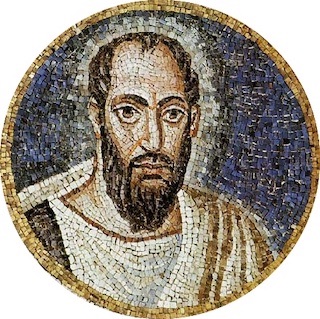
As for Paul, his period of independent missions began. The subsequent years would bring him both much joy and sorrow. Sometimes it would seem like the whole world was in arms against him. The Jews would curse him as an apostate from the Law, the Jewish Christians would look upon the Tarsian as a libertine, and the Gentiles would persecute him as a troublemaker. And even after the death of the Apostle of Nations, the disputes surrounding his name would not subside. “The whole image of this man is so uniquely vivid that ‘the Paul question’ will forever remain one of the central questions of Christian history, a source of inspiration for all and ‘a stone of stumbling and offense’ for many.”[82]
Pondering new, broader plans, St. Paul chose a route by foot through the mountain passes that led from Antioch to Galatia. After leaving the Syrian capital, he and Silvanus walked along the coast, visited Paul’s hometown, and from there moved into the mountains. A good Roman road enabled them to pass safely through the gloomy ravines of Cilicia. After descending into the valley, they turned west and reached Lycaonia. A joy awaited Paul there: his churches continued to thrive. In Lystra, he found a young, energetic helper. Timothy, Eunice’s son, whom he converted back on his first journey, grew up to become a favorite of the entire community. Having heard many good reports about him, the apostle decided to take him along. He baptized Timothy and, probably on the advice of Silvanus, agreed that he should go through the circumcision rite. The rite was performed in accordance with the Law, which determined the nationality of a person by his mother’s side. With this step, Paul wanted to demonstrate his loyalty to the “Council” and safeguard himself from criticism.
When some biographers say that the Apostle Paul was an ailing, weak man, they forget what an incredible effort the work of an evangelist required of him. In crossing the country, he, Silvanus, and Timothy covered in a relatively short time the same distance that separates Moscow from the Caucasus. Behind the terse lines of Acts are the endless dusty highways running across the hills and plateaus, on which the missionaries would swelter in the heat of the day and shiver from the cold under some tree at night when there was no lodging around nearby.
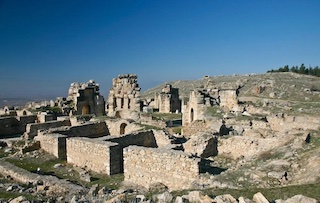
Yet with every step of his arduous journey, Paul grew convinced that he was being led by an unearthly power—that of the Spirit of Christ, which, as it were, was fused with his spirit. “I can do all things in Christ who strengthens me,” he used to say (Phil 4:13). This experience stood in stark contrast with his prior dry studying of the minutiae of the Law. Back then, God was seen as a fearsome Parent, commanding and exacting, and now, through His Son, He was pouring out His strength, salvation, and love. It was as if the Risen One Himself lived and acted through His messengers.
At last, after the scorching heat, the travelers found themselves in a pleasant breeze among the pines of Mount Ida; seagulls appeared in the sky. The fortified Roman town of Troas emerged on the high hill ahead. Beneath its walls and streets, the famous Troy of Homer lay in eternal sleep. As they stepped onto the seashore sand towards the sparkling azure waters of the Aegean Sea, the three men could see in the distance the outline of the islands that served as a bridge connecting the continents of Asia and Europe. Was it time to take it? Was it the reason the Lord had brought them here, to Ilion’s coast?
The missionaries stayed in Troas for a while. Then Paul had a dream, as vivid as reality itself. A man in Macedonian clothing began to ask him insistently: “Come over to Macedonia and help us” (Acts 16:9). This meant an end to their uncertainty: it was this country beyond the wide expanse of the sea that was waiting for them next.
The summer of the year 49 was on the wane when the travelers found a ship sailing to the Balkans. Now there were four of them: in Troas they met a Greek physician, Luke, who decided to accompany them to Macedonia. A Christian, probably baptized in Antioch, he frequented that area on business related to his profession: in ancient times, extensive traveling was expected of all learned men.
Luke turned out to be a happy find for Paul. He was welcomed not only as a doctor (recall that the apostle was tormented by bouts of illness) or a guide; in him the Tarsian found a reliable assistant and a close friend.
A man of an easy-going character and a kind heart, the physician proved to be an indispensable companion. Perhaps he did not always understand Paul—this was the fate of most who knew him—yet he became sincerely attached to him. In the Book of Acts, his love for the apostle can be felt in every line dedicated to Paul. Thanks to this book, we have a more accurate account of Paul’s subsequent mission: Luke describes the events as an eyewitness and a direct participant.
The apostle’s travels were never an easy ride; and the ship they boarded did not look like modern, comfortable vessels. Passengers crowded the tiny deck amid bales, ropes, and huge clay jars filled with grain, olive oil, and wine. Such sailboats were not very reliable in the open sea, so the captains preferred coasting, for fear of losing sight of the shore. This time, however, their voyage would not be long.
Balkan countries, 49–52
On the same evening, sailing with a favorable wind, the ship reached the rocky island of Samothrace, where they dropped anchor, and the next day they were already entering the harbor of the Macedonian port of Neapolis. Yet Paul did not want to stop at this transit point, preferring cities with a more stable population, where it would be easier to establish a missionary center. Therefore, having come ashore, they continued on, climbing the mountains, and a few hours later they reached the Via Egnatia—a military and postal road connecting the Black Sea region with the Adriatic. The road crossed the area where the borders of Albania, Macedonia, Bulgaria, and Greece now converge and where there had not yet been a single Christian.
Macedonia looked very different from the arid lands of Hellas or Judea with their barren landscapes. The wide highway led the missionaries through shady oak and coniferous forests, past streams and meadows. Above all this, in a blue haze, soared the summit of Mount Pangaion, where the first streaks of snow were already visible. Its vicinity was populated with shepherds and farmers, who had the reputation of being down-to-earth, calm, and hardy.
A few hours later they descended into the valley and entered Philippi. During the rule of the father of Alexander the Great, gold miners had settled here, and later Augustus expanded the village, giving it to his veterans. He conferred it with the status of an imperial colony in memory of his victory over the Republican forces.
After Luke arranged for lodging, they began to plan their next move. When preparing to preach to the Gentiles, Paul did not intend to deviate from his old tactics—to go first to the Jews. It turned out, however, that there were almost none in Philippi. There were not even ten men needed to establish a synagogue.[83]51 Only a small handful of those professing Judaism used to gather for prayer outside the city gates by the stream.52
When the Sabbath came, the missionaries went to the designated spot. They found several women on the shore, almost all of them married to Gentiles. Paul sat down on the grass with them and, asking each about her life and gradually moving on to the main thing for which he had come to Philippi. He spoke of the Messiah, of the forgiveness of sins, of grace, and of the imminent coming of the Savior into the world.
Thus, under the open sky, among the riverside willows and stones, under the quiet splashes of water, the words of the Gospel were heard for the first time by the inhabitants of Eastern Europe.
Paul grew particularly fond of Lydia, a proselyte from the city of Thyatira in Asia Minor. She was the first to be baptized in the name of Jesus; “The Lord,” Luke writes, “opened her heart” (Acts 16:14). Lydia immediately volunteered to help the missionaries and compelled them to stay at her house. Having broken his own principle, Paul not only agreed to accept her hospitality, but would also make use of Lydia’s financial support in the future. She was a merchant in purple cloth, which was then very highly prized, and it was not burdensome for her to provide shelter and food for four travelers. Paul accepted her help with confidence, as he was convinced of Lydia’s unselfishness and kindheartedness.
After a while, several men were also converted: Epaphras,53 Clement, and few others. They showed the same faith and devotion to the apostle as the women. Among the Philippians, Paul was finally able to be truly at rest: he felt as if he were at home. And in the future, this church rarely caused him serious grief. Wherever his subsequent travels took him, the memory of the Philippian Christians would always warm his soul, filling him with tender gratitude. Truly, these people were a gift for the pastor, who still had to endure a great many ordeals, slights, and moments of anguish.
The Apostle Paul did not belong to those who by their preaching could move the masses (like Luther), nor would he become a popular saint about whom the people would be making legends. His talents were best revealed through personal contact or in the circle of a small community. That’s when his natural shyness would fade, and he would turn into a wise mentor, a friend, and a father.
Paul’s style was especially well suited to the atmosphere in Philippi. Their spirit of civic cohesion and order also made it easier for him to carry out his plans. In a few months, Paul created a strong community and appointed its overseers: bishops and deacons.
However, the work of preaching by Paul and Silvanus in Philippi was not always peaceful. Two conversions were associated with violent events, as a result of which the missionaries would have to leave the city.
It all started with a girl, a slave of a Roman, who used to follow Paul and his companions each time they went to the stream, where the faithful still gathered. She was shouting in agitation: “These men are the servants of the Most High God, who proclaim to us the way of salvation” (Acts 16:17).
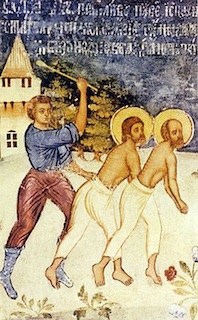
The apostle, seeing that she was possessed, paid no attention to her for some time, but gradually he grew uneasy lest such a strange escort should provoke discontent of the townsfolk and set them against the Christian community. In the end, his patience ran out. One day, hearing the familiar screaming behind him, he turned sharply and in the name of Jesus commanded the madwoman to be silent. The power of his words had an immediate healing effect: the slavegirl calmed down, came to her senses, and obediently returned to the house of her masters. And then the most unpleasant thing was revealed: it turned out that many in Philippi took the incoherent mumbling of the sick woman for Pythian prophecies. People would inquire her and pay her money for divination, which went into the pocket of her owners. When they noticed the apparent signs of her recovery, they realized that they had lost their source of easy income and decided to get even with the preachers.
After inciting some neighbors, they ambushed Paul and Silvanus in the street and dragged them to the city square to the praetors, the local magistracy. Luke and Timothy were left alone, apparently being mistaken for servants. Fearing ridicule, the owners of the slavegirl did not voice their actual complaint to the praetors, but instead merely stated: “These men, being Jews, disturb our city and preach customs which are not lawful for us as Romans to adopt or to practice” (Acts 16:20–21).
The praetors, sensing the belligerent mood of the crowd, did not bother to hear out the strangers: they ordered them to be immediately stripped of their clothes, tied to poles, and flogged with rods. Then, exhausted and bloodied, they were thrown into the city prison with their feet fastened in the stocks for greater intimidation.
When the missionaries came to their senses in the darkness among the prisoners, they did not lose heart. To suffer for the Lord was an honor for them. When they began to pray and sing, other inmates were amazed at the conduct of the new prisoners.
At midnight, the jailer was awakened by an earthquake. Earthquakes—large and small—were not uncommon in those parts, and his first thought was about the prison cells he was responsible for. As soon as he reached the spot, the Roman, despite the darkness, immediately realized that the doors were open. That meant the prisoners had escaped. The laws provided for the death penalty if the guard had lost his prisoners. Not wanting to end his days in shame, the jailer drew his sword, but a voice from the darkness stopped him: “Don’t harm yourself, for we are all here!” (Acts 16:28). It was Paul who shouted, having guessed the keeper’s intention.
Torches were brought in, and, indeed, it turned out that the prisoners were still there. The Roman realized that these strangers had stayed put so as not to place him in grave danger. This had such an effect on the jailer that, bowing low to Paul and Silvanus, he freed their shackled feet, led them out of the cell, and brought them to his house. There he washed and bandaged the strangers’ wounds as best as he could, and bombarded them with questions. He had already heard that they were proclaiming some kind of salvation, and he asked them how to attain it. The words about Christ sounded again, not by the quiet river, but in the dimly lit room where the guard’s family had gathered, and where they were baptized. The Philippian Church gained a few more souls.
There were no more ground tremors.54 The next morning, the praetors, believing that they had taught the strangers a good lesson, sent an order to release them. It meant, “the incident has been settled, you can leave now.” Yet Paul realized that if this matter were to end in such a manner, a shadow would fall on the Philippian Christians: their mentors would have left with a stain of dishonor. And in the Roman setting, this could not be ignored. Therefore, he indignantly declared to the lictors who brought that order: “We, Roman citizens, were publicly beaten and thrown into prison without a trial, and now they are secretly releasing us? No! Let them come here themselves and bring us out!” (Acts 16:37).
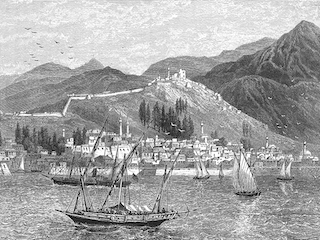
The words civis Romanus sum, “I am a Roman citizen,” had a sort of magical hold in all parts of the empire, especially in the colonial city—this Rome in miniature. A Roman citizen could only be punished after a proper trial.55 The praetors realized what a mistake they had made by not investigating the matter. They had no choice but to personally come to the prisoners, apologize and politely ask them to leave the city.
The missionaries returned to Lydia’s house, where others had already despaired of seeing them any time soon, and, following a farewell conversation, they set out. Paul left Luke behind in Philippi to help establish the community in the faith.
Paul, Silvanus, and Timothy once again walked on the Via Egnatia through the woodlands and then by the seacoast to the west. Five days later they descended to the bay area, where the city of Thessaloniki, a large port, the capital of one of the Macedonian regions, was located. Its inhabitants were engaged not only in trade; its suburbs were blooming and its ground was fertile—a true paradise for the peasants. It was here that the apostles decided to continue their work of evangelism.
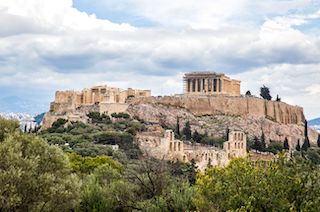
The Jewish population of Thessaloniki was significant. Appearing in the synagogue, Paul was able to converse with them unobstructed for a period of almost one month. According to Luke, he “showed and proved” (Acts 17:3) to them that the Messiah was to suffer for the sins of men, and that this Messiah was Jesus, crucified in Jerusalem and risen again. “And some of them were persuaded and joined Paul and Silas, along with a great multitude of the God-fearing Greeks, and of the leading women not a few” (Acts 17:4).
A large community was formed as a result, the majority of whom were Greek Macedonians. They were primarily farmers, dockworkers, artisans, and small traders. The neophytes were particularly impressed by the prophecy of the imminent coming of the Savior. They were willing to preach the Gospel themselves in order to save others. The Thessalonian church became the first preaching church. Subsequently, the Macedonians, primarily from this community, would often accompany Paul on his travels. Two years later, the apostle would write with satisfaction that his coming to Thessaloniki “was not in vain” (1 Thess 2:1) and that the fellowship of Christians there became “a model to all the believers in Macedonia and Achaia” (1 Thess 1:7).
The apostle was undoubtedly excited to have been able to interact with the new Latin world in Macedonia, and yet Athens, where he arrived in the late autumn of 50, must have struck him even more. There he saw the true Hellas, without signs of foreign influence, proud of its great past. Admittedly, the time of its heyday was far behind: civil wars and foreign invasions had since ravaged the country; its population was thinned out and impoverished.
In the city center, virtually at every step, Paul encountered statues of gods and heroes, covered with faded paint, but still majestic. Yet their looks aroused nothing but indignation in the apostle. Never before had he been enclosed by such a dense circle of pagan symbols. To top it all off, he could sense his chronic illness approaching.
Nevertheless, the apostle could not remain inactive for long and decided to try to preach the Gospel in that city of idols.
The meeting with the Jews in a small synagogue in Athens was peaceful, though fruitless. Paul was more interested in the agora, the main square of Athens. He watched as groups of students and tourists were strolling along it, as philosophers and orators were gathering in the shadows of the porticos. It was an ancient open square, a place for the free exchange of ideas.
Although the philosophical genius of Athens had faded by that time, the names and books of the great sages had not been forgotten there. Their legacy was studied and their ideas were debated.
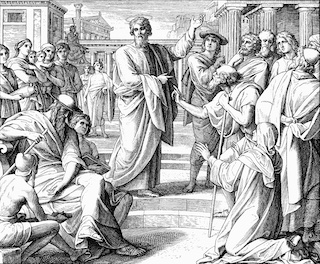
It was with some hesitation that Paul ventured to make contact with that audience, full of snobbery and prone to make stinging jokes. Unwittingly, he followed the example of Socrates: he began to walk around the agora and engage in conversation with random people. A few days later, the teachers of the Stoic and Epicurean schools took interest in him. They noticed that Paul was familiar with some elements of their doctrines. Yet the spirit of his conversations seemed so strange to the Athenians that they could not grasp what exactly he was teaching.
The starting point of his speech was the altar he had seen in the city, an altar dedicated to “an unknown god” (Acts 17:23).56 Such altars were erected when people did not know which deity to thank or propitiate. In Paul’s eyes, they were a symbol of the spiritual search by paganism. “This one whom you, not knowing, honor, I preach to you,” he said to the Athenians (Acts 17:23).
But who is this mysterious Unknown One? He is, the apostle continued, “The God who created the world and all that is in it. He, being the Lord of heaven and earth, does not live in man-made temples. Nor does He require the service of human hands, as though He needed anything, Himself giving to all life, and breath, and all things. From one blood He produced the entire human race to dwell on all the face of the earth, assigning predetermined times and limits to their habitation in the hope that they might search for Him and find Him, though He is not far from each of us; for in Him we live and move and have our being” (Acts 17:24–28).
Believing that the bridge had been laid, the Tarsian went on to the most difficult part. “Therefore,” he said, “God now commands all people everywhere to repent; for He has appointed a day in which He will judge the universe with justice through a Man whom He appointed, having provided proof to everyone by raising Him from the dead” (Acts 17:30–31).
Here Paul got interrupted. Some started laughing: what else to expect from Eastern superstitions? Others evasively told him, “We will hear from you about this at another time” (Acts 17:32). They had clearly lost interest in the stranger: hearing about some resurrected man was for them a waste of time.
Paul had to admit his complete defeat. The arrogance of the skeptics was more impenetrable than the fanaticism of the zealots of the Law. With the exception of two or three conversions, including a member of the Areopagus, Paul had no success in Athens. There were so few believers that they could not form even a small community.
Timothy arrived just in time to cheer up his mentor. He described the events in Macedonia, the persecutions, and the perseverance of the faithful. The Tarsian’s soul yearned to visit them, but the state of his health and the threat of new conflicts prevented him from going.57 He chose to remain by himself, sending Timothy back to the Macedonians. Instead, the apostle intended to follow through with his plan: to go to southern Greece with its main city of Corinth. It was there that Paul arranged to meet with Timothy again.
The apostle was relieved to leave Athens. After saying goodbye to his beloved assistant, he walked by himself along the road, looking at the golden rocks, the hills crisscrossed by wild goat trails, and the scrubby olive trees. Here, each area reminded passersby of the events of Greek history. Yet Paul was thinking of something else: what was awaiting him in Corinth? He felt tired, sick, and depressed. He had no illusions about that city. Everyone knew about “frivolous Corinth,” a place where people came to sell, buy, and spend money. Located on the isthmus between the two seas, the city had long been known as a den for all kinds of riffraff. Unlike the quiet Athens, which dreamed of its past, Corinth had achieved its recent prosperity under the Romans.
At the Isthmian Gate, visitors to Corinth could see a monument to Diogenes, the sight of which could only increase Paul’s apprehensions. After all, it was this sage who used to walk around Corinth in broad daylight with a lantern, claiming to be looking for an honest man and yet not being able to find one. However, things turned out unexpectedly, and the apostle proved to be more fortunate than the philosopher: Paul was rewarded in Corinth for his failure in Athens.
The first surprise awaited the missionary in one of the Jewish streets. There he met a certain Aquila and his wife Priscilla. Both turned out to be Christians.
Natives of the Black Sea region, the couple came to Greece after long wanderings. They used to own a workshop in Rome, but not long ago Caesar Claudius ordered the Jews to leave the capital, and Aquila and Priscilla found refuge in Corinth. Here they took up their craft of tentmaking. For the apostle, this encounter was a great success. Now he could enjoy working alongside his new brethren.
He also made acquaintances with the other inhabitants of the Jewish colony, but, having learned from his own bitter experience, he proceeded with great caution. The Corinthian Synagogue was considered the most famous in the province of Achaia, and its rabbis enjoyed considerable influence. Paul did everything in his power not to come into conflict with them prematurely. It was only when Silvanus and Timothy finally arrived that he felt more confident and began to speak openly in the meetings about Jesus the Messiah, who preceded His final coming by first appearing in the form of the “suffering Servant.” The effect exceeded all expectations. The head of the synagogue, Crispus, and his family were baptized. Overjoyed, Paul, contrary to his custom, personally performed this sacrament on him. Another respected member of the community, Justus, in whose house next to the synagogue Paul stayed, also converted to Christianity. Yet none of it could protect the Tarsian from the machinations of the opposing party. Under their pressure, Crispus was removed from his position, replaced by a certain Sosthenes, and a campaign of persecution of the missionaries began.
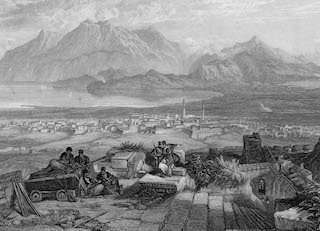
Paul then continued his preaching in the house of a Roman named Gaius. As a mark of the beginning of a new phase of the mission, he himself baptized Gaius, as well as Stephanas, the first Greek convert in Corinth. Paul appointed the latter as a leader of the young church.
Now there was a paradox: more people sought faith and salvation in the dissolute and frivolous city of Corinth than in any other place before it. Having seen this, the apostle decided to stay there longer. The number of Christians was rapidly increasing, which required a longer-term nurturing program.
Paul lived in Corinth for a year and a half, and that is where his pastoral talent became fully manifest. He toiled with tremendous energy, giving all of himself to the cause of evangelism. Behind him were hundreds of miles of travel and ten communities, founded by him personally, from Asia Minor to the Balkans. Almost single-handedly, he had accomplished the impossible, and he knew that this reflected tangible help from above. Working with people in Corinth was not easy, but he could hear the voice of Christ: “Do not be afraid, but speak, and do not keep silent; for I am with you, and no one will harm you, because I have many people in this city” (Acts 18:9–10).
The apostle did not forget about his other “children.” He was not able to visit Macedonia during that time but once again sent the indefatigable Timothy there. The young man completed the assignment. This was when Paul set to work on the most significant task in his life and that of utmost importance to the whole Church. He sat down to write an epistle, probably his earliest, to the Thessalonian Christians.
Corinth – Ephesus – Jerusalem – Antioch, 51–54
Already in the Old Testament period, it became a custom to exchange epistles between Jewish communities scattered throughout the world. Since regular mail in the Roman era served only the needs of the state, private letters would be delivered by couriers. Paul had no shortage of such people: Timothy, Titus, and other helpers were ready at a moment’s notice to take the precious scroll to its addressees, who were awaiting it with hope and impatience.
Paul’s writings formed, as it were, an integral part of his missionary preaching. Although mainly focused on pastoral objectives, these letters allowed the apostle to continue to guide the life of the new converts from a distance. He made it a rule to address not only the elders of the churches, but all the faithful, thereby emphasizing their joint responsibility for the work of God.
The legacy of Paul is among the earliest written Church documents known to us, whereas the four Gospels were composed only towards the end of the apostolic age. The letter to Thessaloniki was received by the Christians there only twenty years since the Savior had walked this earth.
Timothy, without delay, took the letter to Macedonia. Yet as soon as he returned, Paul was forced to write to the Thessalonians again. From his faithful disciple, he learned that someone had spread in that community the text of a prophecy, attributed to Paul himself, about the imminent coming of the end of the world. It was necessary to stop the temptation as soon as possible, calm people down, and provide the necessary clarifications.
When speaking about the end of the world in his second epistle, the apostle undoubtedly had in mind both the Old Testament prophesies and the words of Jesus. He explained their meaning and how they predicted a temporary triumph of the enemies of God who would trample on His inheritance.[87] In modern parlance, these prophecies reveal a strengthening of the demonic locus in human history as Judgment approaches. By invoking the biblical teaching about the kingdom of a false messiah, the Antichrist, Paul sought to restrain the impatience of those who believed that the fruit had already ripened.
Paul made it clear that the time of the Antichrist was yet to come.
Rejecting the futile guesswork of the Thessalonians, he urged them not to deviate from what had been preached to them. He was even not afraid to use a Pharisaic term for that. “Stand firm and hold fast to the traditions,” he wrote, “which you were taught whether by word or by our epistle” (2 Thess 2:15).58 Fidelity to the original message of the Gospel should serve them as a guide and a cure from illusions.
Paul particularly stressed the salubrious role of a working life, because he was well aware of the contemptuous attitude towards it in the Greco-Roman milieu: work was viewed as a humiliating obligation, unworthy of a noble person (2 Thess 3:6–13).59 The apostle categorically rejected attempts to justify such a view by appealing to the approaching last times. Paul himself always worked tirelessly, and he called on his followers to do the same.
Eighteen months passed since Paul had first settled in bustling, noisy Corinth. There were now more Christians there than in any other city where the apostle had preached before. After the clash with the synagogue authorities, he grew increasingly close to the Greco-Roman population. The lands of Syria and ancient Jerusalem started to seem like a distant dream. However, the Tarsian did not intend to create an isolated Greek church. He did not forget his duty to preserve the unity of all the faithful. It was this duty that made him part from the Corinthians, among whom he had labored so successfully, and return to the East again.
In the summer of 52, when the navigation was already in full swing, he went to Cenchreae, the port of Corinth, taking with him Aquila and Priscilla. He left Silvanus and Timothy in the city to continue the work of evangelism.
Before sailing to Judea, however, the apostle wanted to visit the city of his dreams, Ephesus, even if for a short period. For a whole week, the sailboat maneuvered among the islands of the archipelago, until it approached the shores of Asia. From the harbor, Paul and his companions, walking up the river, reached Ephesus.
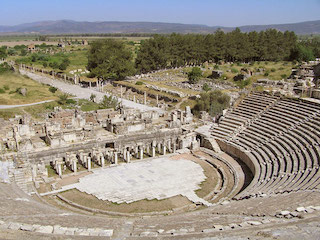
After the cool sea breeze, the heat and stuffiness of the city seemed especially oppressive. Dust clouds were everywhere, raised by the lines of carts that stretched from gate to gate. Ephesus amazed everyone who first appeared on its streets among the forest of columns, magnificent monuments, and statues. The sophistication of Athens, the commercial atmosphere of Corinth, the breadth of multilingual Asia—all combined here near the giant sanctuary of Artemis, one of the seven wonders of the world. Throngs of pilgrims, merchants, mule drivers, and sailors crowded around the shops. Although the feasts in honor of Artemis were over, the city was bustling with business.
The Jewish quarter of Ephesus was under the direct protection of Rome; it was extensive and prosperous. The missionaries, contrary to their expectations, were received very cordially here; Paul had grown unaccustomed to such respectful treatment on the part of his fellow tribesmen. His address in the synagogue made a good impression (the slanders of the adversaries did not reach here). Paul was even asked to stay longer in Ephesus, but he explained that he was bound by a vow to visit Jerusalem for the feast of Pentecost and offer a sacrifice in the Temple; only then he could come back to Asia again.
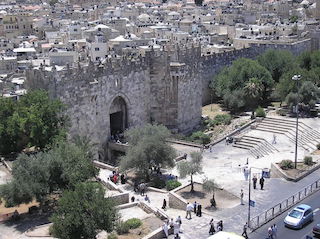
Leaving Aquila and his wife behind to gradually prepare the ground for his preaching, Paul returned to the harbor by boat and sailed from there to Judea.
Luke speaks very briefly of his further journey. According to the Evangelist, “having arrived at Caesarea, he went up to Jerusalem, greeted the Church, and departed to Antioch” (Acts 18:22). This reluctance to go into details seems strange: after all, the meeting with James and the Jerusalem Christians would have been an important event in the life of the Tarsian. Apparently, Luke, who tended to avoid describing conflicts, kept silent about the cool reception given to his teacher in the church of James. The Brother of the Lord himself could not refuse fellowship with Paul, although the latter was already reputed to be a blasphemer of the Law, but there were probably some who saw in his arrival an open challenge to the traditional piety. Wasn’t it time to put this freethinker in his place rather than speak to him peacefully, as James did? By what right did he, who had not known Jesus, dare to go against the age-old foundations? Why did he not become a humble disciple of the true apostles? The Tarsian claimed that Jesus Himself had appeared to him, but was that sufficient? Could he equal those who lived next to the Messiah? Most likely, this false Pharisee and false apostle was a disguised enemy of the Church.60
The Christian legalists did not confine themselves to whispering behind Paul’s back, but planned to take serious measures against him. As soon as Paul, dejected and saddened, left for Antioch, they began to act. James, mindful of the “Council,” hardly approved of the fanatics, but the elder was no longer able to restrain them. They hurried to the cities where Paul had preached, starting from Galatia, and everywhere they sought to convince the newly baptized Greeks that the Tarsian had deceived them, that it was not enough to be baptized for salvation, and that they had to accept the Law of Moses.
The unsuspecting apostle surrounded by friends had been living in Syria for almost a year when the news from Galatia hit him like a bolt from the blue: those loyal to him reported that his cause was on the verge of collapse. The simple-minded Galatians succumbed to the admonitions of Paul’s opponents, renounced their teacher, and hastened to receive circumcision.
The apostle was dejected by this turn of events. What should he do? Cancel the promised trip to Ephesus and rush to Galatia instead? But first, he should write a letter to his first-born children, who, alas, turned out to be so unsteady. Shocked by the news, grieved and discontented, he sat down to dictate.
It may seem at first that the preacher’s pride was hurt. Yet this was not the case: he was forced to defend his authority not for its own sake, but for the sake of the Truth revealed to him. Despite his own feelings, he did not deny that his rivals, too, were preaching the Good News. But the apostle insisted that its meaning became distorted in their mouths. Paul’s sharpest rebuttal was directed at the methods employed by the false brethren, who spoke lies about him, taking advantage of his absence and wanting to denigrate him. He labored not for himself but for God, as he was not sent by men but by Christ Himself, who chose Paul to be His servant from the womb. The apostle once again reinforced his point that his teaching to the Galatians was the Revelation of God and not a human doctrine.
Paul’s critics pointed out that Christ Himself kept the Torah. Yes, the apostle answered, Christ obeyed the Law, but at the same time He rose above it. As a Man, He went through the human way of being “under the Law”, but not for the sake of enslavement to the letter, but for the sake of His loving filial submission to the Father. He is the only Chosen One, the true Son, sent, despised, who surrendered Himself to the service of the Father; therefore He grants all those who believe in Him the joy of being adopted by God.
“And because you are sons, God sent the Spirit of His Son into your hearts crying: ‘Abba, Father!’ Therefore, you are no longer a slave, but a son; and if a son, then an heir of God through Jesus Christ… Stand firm therefore in the liberty by which Christ has made us free, and don’t be entangled again with a yoke of bondage” (Gal 4:6–7; 5:1).
By bondage, the apostle meant the reduction of faith to a system, a canon, a formal rule, i.e., what was most accessible to people. However, this incomplete form of faith has outlived its time. God has laid the foundation for a new world. It is here, now.
Having hastily sent his epistle with a confidant, the apostle decided to go there to heal the wounds inflicted on immature souls with his own presence. Nevertheless, the Ephesian plan remained in effect as well. Paul went there on foot—across the entire peninsula—with the intention of visiting the Galatian cities.
For the third time, he was making his way along the familiar road, winding through mountains and gorges of a boundless semi-wild country.
We do not know for sure what communities he visited or how successful he was. He never again met with the Galatians and apparently did not write to them. His First Epistle to the Corinthians, however, suggests a hint of the outcome of his visit. In that letter, Paul mentions donations by the Galatian churches to Jerusalem (1 Cor 16:1). At the same time, there is evidence that the orthodox trend continued to spread in Asia Minor until the end of the first century. This can be seen from the Book of Revelation, as well as the Second Epistle of the Apostle Peter to the Christians of Pontus, Galatia, Cappadocia, Asia, and Bithynia, which shows that the Christians living there no longer regarded Paul as their only mentor.
Could this be the reason why he lost the desire to visit Derbe, Iconia, and Lystra during his next trip? All the same, he crossed the lands of inner Galatia and Phrygia without stopping there, and from there he turned west toward the coast.
In the fall of 54, he was already back at Ephesus, the final destination of his third journey.
Asia Minor – Greece, 54–57
At Ephesus, Paul immediately met with his faithful co-workers, Aquila and Priscilla. The long-awaited rendezvous with friends was especially heartwarming after all the recent disappointments and arguments, as well as the grueling journey. Over time, the couple had completely adapted to the capital of Asia Minor; but without the apostle, they did not take further steps in the work of evangelism. There was, however, one exception. While going to synagogue on Saturdays, they met an extraordinary man, a Jew from Alexandria named Apollos. A brilliant scholar of the Bible and philosophy, he won everyone over with his eloquence and erudition. In essence, Apollos was already a Christian. He embraced the elements of the Gospel, apparently, from the Essenes who came to faith in Christ, and since then he became imbued with the missionary zeal of a neophyte. Perhaps, Apollos remained influenced by his great countryman Philo, who was using an ingenious method of allegorical interpretation of the sacred books. This method, which would be later adopted by many Church Fathers, helped him to see more clearly the connection between the two Testaments. In Ephesus, a small community of twelve men who shared his views formed around Apollos.
Despite the fact that Apollos could claim to be a teacher himself, he listened with noble humility to the two artisans who “explained to him more precisely the Way of the Lord.”[89] When the Alexandrian had to go on his business to Greece, Aquila gave him a letter of recommendation to the Corinthian brethren, hoping that his knowledge and eloquence would be useful to the Church.
Upon hearing their story, the Apostle Paul immediately sensed that he would find a like-minded coworker in Apollos, who in some ways might be superior to him. The Alexandrian had a deeper knowledge of the Hellenic world than Paul, who had received a purely rabbinical education. The apostle, not bound by jealous rivalry, welcomed the unexpected addition of a new companion. He later wrote to the Corinthians: “I planted, Apollos watered… But he who plants and he who waters are one” (1 Cor 3:6,8). Paul received the disciples of Apollos with the same alacrity. When he learned from them that they had never heard of true baptism in the Holy Spirit, he instructed them in the faith and prepared them for the sacrament. During the prayer, he laid his hands on them, as the first apostles did, and all the newly baptized “began to speak in tongues and prophesy.”[90] It was as if they were born again, having received what they lacked in the teachings of Apollos.
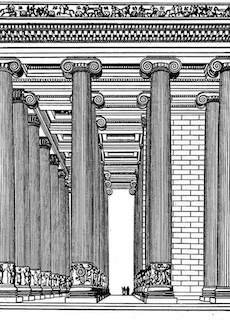
As soon as Apollos returned from Corinth, he, naturally, wanted to meet the famous enlightener of the nations. Wrapped in an Egyptian linen cloak, he entered the gates of Aquila’s workshop. The yard was littered with bales and bundles of rope. The guest had to step over them, making his way to the shaded corner. There, on a mat, leaning over, sat a bald, short, middle-aged man in work clothes. On his head, there was a knitted yarmulke; he had a crooked nose, a graying beard; his hands, accustomed to work, were quickly sorting and twisting the black wool intended for travel tents. Bundles of the finished fabric were piled separately; they would be fetched by merchants and carried to the marketplace. The man raised his gray eyes, reddened from exertion, and looked at Apollos.
Apollos had heard before that the Tarsian was unattractive in appearance, but he was still involuntarily struck by the mundane scene and his strange face. Aquila came out of the house and introduced them. But as soon as a conversation was struck up, Paul was instantly transformed. Now there was no doubt: before Apollos was the same indefatigable traveler, a man of the Spirit, who had traversed the seas and lands, everywhere scattering the seeds of the Kingdom of God with a firm hand.
From that day on, Apollos would be actively involved in the work of the apostle. Indeed, the harvest was plentiful in the populous Ephesus, which then had up to a quarter of a million inhabitants, not counting visitors. It was easy to get lost there, which was exactly what the missionaries wanted. The authorities of the “free city” had long been accustomed to streams of worshippers, wandering preachers, and representatives of various cults. The synagogue chiefs, although they had already grown cold towards Paul, had not yet shown much hostility.
On the other hand, the outbursts of pagan fanaticism characteristic of places of mass pilgrimage could prove far more dangerous. In spring, Ephesus hosted lavish festivals in honor of the goddess Artemis. They were accompanied by horse races, sports competitions, performances of singers and poets. Solemn processions would stroll along the central avenue at the foot of the huge theater, heading for the temple located in the northern suburbs.
The idol of Artemis, revered throughout the land, was hidden from the public eyes behind the walls and the fence of 120 tall columns. It was rumored to have fallen straight from the sky. Whether it was a meteorite or an archaic fetish, the traditional image of the goddess was well known to everyone: her statuettes were sold at every corner on the feast days. The many-breasted figurines, loosely resembling bunches of grapes, depicted the goddess as a nourishing mother ready, as it were, to nurture the whole world. Untold riches had been accumulated in the treasuries of her temple. The Romans knew this and viewed Ephesus’ riches as their own, despite providing a semblance of autonomy to the capital of Asia Minor.
The early Christians of Ephesus must have noticed just how jealous the locals were of their national cult. A slightest insult could result in bloody riots. And Paul deliberately and consistently tried not to hurt the feelings of the Gentiles, which allowed him to live and work in safety.
Never before had Paul been so popular as during those three years at Ephesus, and nowhere had his gift of healing been manifested with such power. He was constantly followed by crowds, just as Jesus a quarter of a century earlier. Sometimes healing came when a handkerchief or an apron of the apostle was placed on the sick.
Yet there was a downside to it all. The buzz that spread the fame of the Tarsian across the city also fueled the superstitious passions. It must be said that Ephesus had long been a center of occultism and magic. Everywhere on its streets, one could see the advertisements of healers, astrologers, and interpreters of dreams, luring in anyone who wanted to know the future or achieve success in business. There was even a special literature on divination, called the “Ephesian writings.” Quackery and exploiting popular credulity were commonplace in Ephesus.
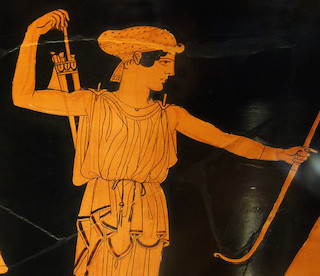
Sooner or later, experts in magic would see Paul as a dangerous competitor. In imitation of him, some itinerant Jewish healers even tried to heal in the name of Jesus. One time such an experiment ended in utter failure: some possessed man rushed at the unfortunate healers, screaming, “Jesus I know, and Paul I recognize, but who are you?” And he beat them severely (see Acts 19:15).
As we already know, a whole team of dedicated missionaries worked under Paul’s leadership. In addition to Aquila, his wife, and Apollos, as well as old friends Titus and Timothy, who came from Corinth, the sources name many others from different parts of the empire.
Relying on their support, Paul revived his long-cherished plan: to circle once again the shores of the Aegean—Asia Minor, Macedonia, and Achaia; then, after sending financial aid to Jerusalem, to reach via Rome the western border of the civilized world—Spain. Paul apparently wanted to postpone the journey to Roman Africa and Egypt until the very end of his mission,61 and thus intending to complete the full circle around the ecumene.62 If his plan succeeded, the whole Mediterranean would soon hear the news of Jesus.
Paul began to implement his far-reaching plan by sending Timothy and Erastus ahead of him to Macedonia, arranging to meet them at Corinth.
The Corinthian church was his greatest concern. For some reason, Silvanus departed from the city (he later joined the Apostle Peter), and the new converts were left on their own. Paul wrote them a letter that did not survive to this day, but its contents are generally known. In it, he strictly ordered a boycott of those members of the community who indulged in debauchery, drunkenness, or participated in pagan festivals. He could easily surmise the existence of such phenomena given the prevailing mores of the “frivolous Corinth.”
The brethren became confused by the epistle, imagining that their teacher was ordering them to cut off any contact with the outside world. Paul would later explain, however, that he was only afraid of the “Corinthian contagion” entering the church. As to “those outside the church,” he believed that a different set of standards would be applied to them. “For what have I to do with judging those who are outside?” he wrote. “But those who are outside, God judges” (1 Cor 5:12–13).
The apostle’s premonition proved to be right. When he was about to leave for Macedonia in the early spring of 57, some servants of a rich Christian woman named Chloe arrived from Corinth. They reported that the community was not doing well. One brother married his stepmother, despite the fact that both Jewish and Roman laws condemned such marriages as incestuous. In Corinth, however, they turned a blind eye to it. The weakening of moral standards also affected the Lord’s Supper. Rich people, who brought more to the tables than others, rushed to get enough for themselves, sometimes returning home drunk. Moreover, controversies broke out among the faithful, leading to the formation of rival factions in the community. Some grew so fond of Apollos’ interpretations and preaching that they claimed to be his followers. And since the disciples of Peter (or perhaps the apostle himself) had visited Corinth, some distanced themselves from Paul and became known as the Cephas’ disciples. “Look,” they said, “the Tarsian did not dare to take money from us, like Peter and the other apostles, thus admitting to their higher status. And in general, Paul can not be figured out: one moment he goes against the Law, the next he observes Jewish customs.” They regarded Paul’s freedom and missionary flexibility as duplicity.
Apostle Peter, if he did visit Corinth, was hardly guilty of undermining Paul’s authority. Humble and kind, he did not like to put himself above others; consequently, the conduct of the “Cephas’ disciples” was entirely of their own doing. These disputes and differences led yet another group of Christians to refuse to associate themselves with the name of any apostle; they began to call themselves simply Christ’s followers.
This news upset Paul much more than the troubles in the distant Galatian backwoods. Destructive forces had shaken a large, budding church. Although most Corinthians remained loyal to their mentor, the schism itself was a sad symptom. Paul saw in it not only an encroachment on him personally but a betrayal of something immeasurably more important—the spirit of the Church. The Tarsian, who had long since learned how to control his innate impatience, now had to demonstrate redoubled self-composure and tact in order to cope with the unexpected disaster. The trip to Macedonia was temporarily postponed.
While Paul was pondering what to do next and waiting on the Lord to show him the way, three elders of the Corinthian church who were ardently devoted to the apostle came to Ephesus by ship: Stephanas, Fortunatus, and Achaicus. They succeeded in dispelling his worst fears and persuaded him that the turmoil was nothing other than growing pains, aggravated by the restless nature of the Corinthians. Thus, it was still okay not to rush to Greece, but first to proceed to the Macedonian lands as planned. During that time, the trustworthy Timothy, with his characteristic gentleness and sensitivity, would travel to Corinth and make preparations for the apostle’s upcoming visit.
Paul also wanted Apollos, whom the Corinthians insistently invited for a visit, to accept their invitation as a gesture of goodwill. However, the Alexandrian, disconcerted at having unwittingly given a pretext for the unrest, chose to remain in Ephesus.
As the apostle was saying goodbye to the envoys of Corinth, he handed them a letter for the entire community, in which he outlined his position on schisms and answered the questions that perplexed the believers. The Corinthians were concerned about many things: what should be the Christian view on marriage? Was it permissible to eat food from a meal offered to gods? Who was more important in the Church: the apostles, the prophets, or the teachers? Would the dead really rise to life on the Day of Judgment, or should the resurrection be understood differently?
It was not easy to cover all these topics in a single epistle; therefore, his letter turned out to be very lengthy, almost like a book, and in the New Testament it became known as the First Epistle to the Corinthians.
While his letter was calling for like-mindedness among the believers, the Apostle Paul did not want to constrain the freedom of the Corinthians with rigid dogmatism. “For there must also be differences among you,” he wrote, “that those who are approved may be revealed among you” (1 Cor 11:19).
His argument was that only the uncoerced love for the One who died for people, and not some imposed arguments (be it a miracle or the voice of reason), can serve as the true foundation of faith. In Jesus, nailed to the stake, there was nothing that would draw anyone to Him forcibly. Indeed, a person is usually enticed by either the display of strength or the power of the mind. At Calvary, however, we all become witnesses of the ultimate humiliation. This is how the Son of God chose to reveal Himself to the embittered world.
To be clear, the apostle did not seek to change the existing world order. What was happening among unbelievers was only of limited concern to him, for the days of “this age” were numbered. Believers should remain in the same life situation as when they were first called. Whether a Jew, an alien, a free person, or a slave, none of it any longer mattered. Only one thing mattered, “that each one should remain with God.”[92]
When reading Tacitus, Suetonius, or Josephus, one is struck by how much the ancient world was similar to our own, and how much people were full of malice, cynicism, indifference, and inhumanness. And against this background, Paul appears as a messenger from a different world. Even next to the writings of the enlightened and humane literary figures and philosophers of those days, the words of the tentmaker from Tarsus sound like a miracle. He does not advocate a “betterment of morals” or a change in societal institutions, but instead proclaims one Truth that was then seen as nothing other than irrelevant and almost insane. He calls love the only viable answer for this lost world. Love is higher than supernatural signs, higher than great exploits, and spiritual ecstasies. When describing love, Paul starts sounding as a poet and not only as a prophet.
“If I speak with the tongues of men and of angels, but have no love, then I am a sounding brass or a clanging cymbal. If I have the gift of prophecy, and understand all the mysteries and all knowledge, and have all faith so as to move mountains, but have no love, then I am nothing. And if I give away all my possessions and deliver my body to be burned, but have no love, it profits me nothing. Love is patient, love is kind, it does not envy, it does not boast, it is not proud. It does not behave rudely, does not seek its own, is not provoked, thinks no evil. Love takes no pleasure in evil, but rejoices with the truth. It bears all things, believes all things, hopes all things, endures all things. Love never fails. Although prophecies will cease, and tongues will be silenced, and knowledge will pass away. For we know in part and we prophesy in part. But when the perfect comes, the partial will be done away with…. Now we see, as it were, in a mirror dimly, but then face to face…. And now these three remain: faith, hope, and love; but the greatest of these is love” (1 Cor 13:1–10,12–13).
This hymn is the pinnacle of Paul’s preaching. It was poured out of his depths in a single breath, as if flowing from someone who was struck by a blinding light. His words evoke the elation of epiphany and the blows of hammer that bring down all the obstacles that stand in the way of the Good News. These lines of love dictated by Paul have elevated the author—perhaps, for the first time in all of his writings—to the same heights as the Gospel writers.
Asia Minor – Macedonia – Greece, 57–58
At the end of his long epistle, the Apostle Paul asked the Corinthians to attend to raising funds for the poor in Jerusalem. Following the example of the Galatians, he advised them to put aside an amount they each could afford every first day of the week. This money would then be sent to Judea accompanied by an explanatory letter or taken there personally by Paul.
Yet things did not turn out the way the apostle had hoped. After visiting Corinth, Timothy brought back more bad news. Neither his coming nor Paul’s epistle managed to quiet down the strife. The apostle realized that he would have to go himself and do so right away. Without waiting until after Pentecost, he went by sea directly to Corinth.
The voyage was not without incidents: the ship was caught in a storm near the archipelago.63 It seemed like a bad omen. Indeed, the meeting in Corinth turned out to be more difficult and torturous than one might have expected. Luke does not mention it at all.
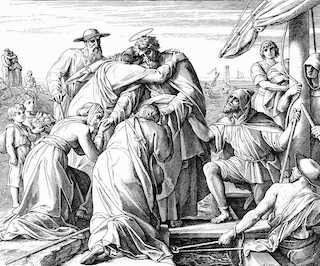
Earlier, Paul asked the Corinthians, “Which do you prefer: should I come to you with a rod, or in love and a spirit of gentleness?” What he learned from Timothy and then saw himself made him speak out with great severity. The result was disastrous. The community as a whole remained deaf to his reproaches, and one of the brothers even insulted the apostle.64 It is not known what the main cause of the quarrel was, only that Paul left the city in the darkest state of mind, with a sense of wasted effort.
When he returned to Ephesus, he wrote a letter full of bitterness to the Corinthians and asked Titus to take it.65 At this point, he was once again reinforced in his original intention—to go to the Macedonians. He sent Timothy and Erastus ahead of him, and arranged for Titus to meet him at Troas, the same city from which he had begun his journey to Europe in 49 AD.
Pentecost, Paul’s favorite holiday, was quickly approaching. The apostle planned to celebrate this feast in Ephesus. However, new events would preclude him from doing so, forcing him to hasten his departure.
The summer of 57 came, and inhabitants from all over the province flooded Ephesus, attracted by the festivals in honor of Artemis. It was easy to cause trouble at times like that—something that Paul’s enemies took advantage of.
According to the account by St. Luke, a certain Demetrius, a silversmith, gathered his fellow craftsmen and warned them against the dangers emanating from the school of Tyrannus, where a certain Jew preached, and who already “seduced a considerable number of people, saying that those made by human hands were not gods.” Yet as craftsmen, they owed their living to Artemis and their craft of making souvenirs for pilgrims in the form of the temple or the goddess. If that troublemaker were allowed to continue, they would soon be left without income.
Of course, this was an exaggeration, and a ridiculous one at that. There were only a handful of Christians in Ephesus compared to the hundreds of thousands of pagans. Obviously, Demetrius was bribed or set up by those who saw Paul as a rival—healers and sorcerers who had tried more than once to remove him from their path.
The speech of Demetrius had an effect on his audience like that of a spark on dry grass. Artisans poured out into the street, shouting the traditional Ephesian slogan: “Great is Artemis of Ephesus!” They were immediately joined by throngs of townspeople, always ready for a rowdy demonstration. Someone tried to find Paul, but he was not at home. Then they seized Gaius and Aristarchus and dragged them by force to the theater. Its benches, designed for 20,000 people, quickly filled up: chaos set in. “Some were shouting one thing, some another,” writes Luke, “for the assembly was confused, and most of them did not know why they had come together.”
Upon hearing the roar of the crowd and learning that his friends were in danger, Paul hurried to the theater, ready to throw himself at the mercy of the mob. On his way to the theater, however, he was noticed by some members of the city council, who were on friendly terms with him. They persuaded him not to go to a certain death and promised to avert the violence by their own measures and rescue Gaius and Aristarchus.
Meanwhile, a surreal scene was unfolding in the theater. The Jewish community, fearing that the rage of the pagans would fall upon them, as it had happened more than once, sent a certain Alexander to declare that they had nothing to do with Paul and his coreligionists. Alexander went up to the podium and motioned with his hand, desiring to speak. However, as soon as they learned that he was a Jew, everyone again began to chant deafeningly: “Great is Artemis of Ephesus!” The shouting went on for almost two hours, and when the people were already out of breath, the “secretary” of Ephesus, a position in Greek cities similar to a mayor, came out on the platform.
He began his address in a composed voice, explaining that no one had encroached on Artemis and her temple. The apprehended two men had not insulted the goddess or committed any blasphemy. And if the handicraftsmen had a complaint against someone, they must file it with the court legally. Then, he proceeded to make a direct threat. Ephesus was a free city, but it was subject to Rome. If the demonstration did not stop, he said, “we are in danger of being charged with rioting today, since there is no cause that we can give to justify this commotion” (Acts 19:40).
His sensible speech calmed the people down. Gradually, the crowd began to disperse. Gaius and Aristarchus were released.
A weight was lifted off Paul’s chest, yet he no longer felt at ease there. He knew he had to leave Ephesus immediately.
All these events—the intrigues of enemies, the contention in Corinth, the unfortunate trip there, the violence of the crowd in Ephesus—completely wore Paul out. Saddened, he parted with the disciples there and walked north along the coast to Troas, hoping that Titus would already be in the city.
However, he was met with a disappointment in Troas: his faithful assistant was not there. This further upset Paul, who needed a friendly word. “Our flesh had no rest,” he would later write of those days, “but we were troubled on every side: conflicts on the outside, fears within” (2 Cor 7:5). He could not even find the strength to preach and spend time with the brethren of Troas, for which he had actually come to the city, and, having hurriedly said goodbye to them, he sailed on a ship to Macedonia.
After the sea crossing and the road through the mountains and forests, Paul finally was back in his beloved Philippi. In that quiet town, he met with those who always understood and loved him. He was especially glad to see Timothy, Erastus (possibly Luke), and Titus, who had arrived from Corinth with some good news: Paul’s letter, written in tears, awakened the brethren’s conscience. The Corinthians felt remorse and were hopeful he would be back to visit them again.
Delighted, Paul was ready to forgive everything, yet he decided to postpone his visit there until the fall. He wanted the Corinthians to feel their guilt more deeply, and he himself needed more time to completely calm down.
He spent the summer traveling across Macedonia and even preached in the neighboring Illyrian land (present-day Albania). However, his thoughts were constantly preoccupied with Corinth. That same summer, he wrote yet another epistle to the Corinthians, which Titus willingly delivered (in the New Testament, this is the Second Epistle to the Corinthians). Titus was very well disposed towards the Corinthian brethren and did anything in his power to promote reconciliation with their mentor.
This epistle is not only an apologia for the apostle, but also an explanation of his mission of an evangelist. In it, the Tarsian describes, in more detail than ever, the misfortunes, difficulties, and dangers that constantly accompany him. How many times he has had a brush with death! And it is all the sadder for him to see the ingratitude of his children. The only reason he is delaying his visit to them is in fact to “spare” them.
Nowhere is the mystery of priesthood more profoundly revealed than in this epistle. God’s messenger, a weak and afflicted person on the one hand, is transformed by the power of the Spirit of God into a co-worker of Christ the Savior on the other. As the shepherd of souls, he becomes the Lord’s instrument to bring justification and reconciliation to people. This highest predestination is now being fulfilled through the apostolic preaching: “Now is the time of God’s favor, now is the day of salvation.” Paul was commanded by Christ Himself to rise above the letter of the Law and teach the spirit of freedom to the children of God.
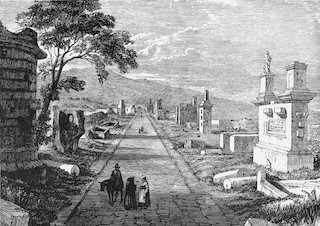
Time and again the apostle brings to remembrance the days of his calling, evoking his visions that cannot be adequately described in words and recalling the help from above, which arrived precisely at the time when he suffered from illness or setbacks. “When I am weak, then I am strong,” he says. And this is not a mere paradox, but the reality of his life.
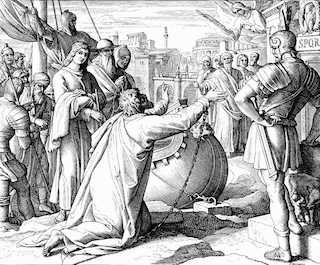
Paul knew himself: in personal communication, he was far more lenient than in his epistles. Therefore, he did not regret that he had been so severe in his previous letter. “For even if I made you sorry with my letter, I do not regret it; though I did regret it. For I perceive that the same epistle made you sorry, though only for a while. Now I rejoice, not that you were grieved, but that you were grieved into repentance” (2 Cor 7:9). This, the fourth letter in a row, was also quite severe in its tone. Yet it was also filled with hope that this severity would bring about good fruit. And Titus, for his part, reinforced Paul’s opinion that the time had finally come to visit the Corinthians in person.
Although the winter was coming and the ships did not sail, the apostle nonetheless decided not to delay his visit any longer. He set off on foot, as he had done the first time, bypassing Athens.
Letters and time did their work. The reconciliation was complete.
The apostle spent three months in Corinth. As the spring of 58 approached, he was able to take his time to reflect on what had been achieved. The Aegean shores had been traversed, and more than once; donations had been collected. The time had come, after visiting Jerusalem, to begin preaching in the western regions of the empire. Of course, it was impossible to avoid Rome, which Paul had long wanted to visit. However, there was already a large community in Rome founded by other missionaries, whereas Paul preferred to work in areas where people had not yet heard the Good News. In view of this, he felt it was his duty to write to the Christians of Rome and expound his Gospel to them.
In this epistle, Paul spoke of the helplessness of man, who is unable to fulfill the Law of God, of the saving faith in Jesus Christ, which justifies each person before God. “As we died with Christ,” Paul wrote, “so we will also rise with Him” (Rom 6).
In the spring of 58, the apostle set out on his return journey from Corinth and eventually arrived in Jerusalem. However, he had too many enemies in that city. While he was in the Temple, someone shouted, “This man has violated the prohibition and brought the Gentiles into this holy place!”[93]
The agitated crowd, swift for reprisal, immediately assaulted the apostle. Hearing the noise, the commander of the garrison sent soldiers, and they snatched Paul from the hands of the angry mob. To investigate the incident, Paul, as a Roman citizen, was sent to Caesarea to the procurator Felix. Learning that they wanted to ambush and murder the arrested Paul during his jail transfer, the tribune sent a detachment of soldiers with him. The procurator became convinced that Paul was not guilty before the Roman laws and allowed him to live freely, but he did not let him out of his residence, hoping to extract a ransom from his coreligionists. Soon, another procurator, who replaced Felix, rendered Paul an acquittal. However, the apostle, secretly hoping to get to Rome, demanded a trial at the imperial court. At such a request, any Roman citizen was required to be taken to the capital for the trial by Caesar.
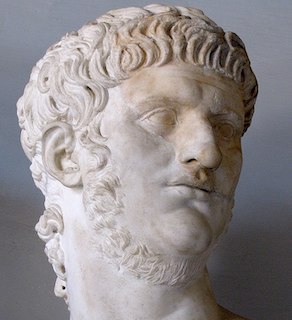
In the fall of 60, Paul, Luke, and his other friends left Caesarea for Italy in a convoy. The voyage dragged on, and it was only in the spring that the apostles, for the first time, set foot on Italian soil. Paul then came to Rome by the Appian Way. For two whole years he lived in the capital, preaching the Kingdom of God.
In 63, Paul was apparently acquitted and left Rome. He visited the churches in Greece and Asia Minor again, and eventually came to the western border of the empire—Spain.
In the meantime, the church of Rome faced a great trial. In the summer of 64, a terrible fire broke out in the capital: out of the fourteen districts of the city only four survived, thousands died or lost their homes. Popular rumor accused Caesar Nero of the arson; his cruelty and extravagance had been known to all. It was said that he wanted to burn Rome, so that a new city, Neropolis, could be built on the ashes. The frightened emperor began to look for a way to placate the rage of the Romans. Knowing that there were sectarians in the city called Christians, he declared them to be the culprits behind the calamity. Mass arrests and tortures of believers ensued.
Not long before this, the Apostle Peter arrived in Rome. Fearing for Peter’s life, the Christians begged him to flee the city. But, as tradition recounts, on the Appian Way, he saw Christ Himself, and to the apostle’s question: “Lord, where are You going?” Christ answered: “I am going to Rome to be crucified again.” Peter returned and was soon captured. Nero turned the executions of Christians into bloody entertainment for the masses. The condemned were thrown into the circus arena to be torn to pieces by animals; they were burned and crucified.
This was when the prophecy of Christ was fulfilled: the shepherd of the Church, Simon Peter, was bound and taken to the place of execution. He was crucified upside down to satisfy the whims of the executioners.
Two years before Peter’s death, the fanatics killed James, the Brother of the Lord. One by one, the eyewitnesses of the Gospel events passed away. And it was at that time that the earthly life of Jesus was put into writing by the disciple of Peter and Paul—Mark. He collected in his Gospel the stories of Peter and the traditions of the Church of Jerusalem.
People in the East know how to preserve oral tradition over a long period of time, so the words of Christ and the events of His life were transmitted by the first generation of Christians in their original purity. The Gospel of Mark was followed by other Gospels. These little books were to conquer the nations and take the Good News of the Savior to the entire world.
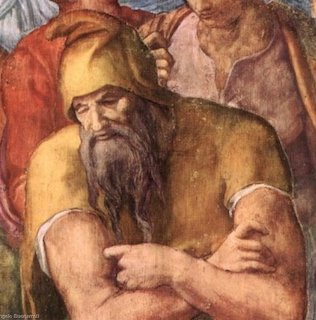
In the year 66 AD, Judea rebelled against Rome. Her four-year struggle with the mighty empire began. Just at that time, the Apostle Paul came to Rome again. Jews and Christians were treated with a greater suspicion because of the war. Soon the apostle was arrested and sent to the same prison where Peter had stayed shortly before. As a Roman citizen, Paul was under a legal investigation. It is unclear what he was accused of, yet Paul knew that his days were numbered. Abandoned by all, he was waiting for his death. The Roman church was decimated. No one came to his defense. Only the physician Luke remained with him until the very end. However, the apostle did not lose heart. “I know whom I have believed,” he wrote to Timothy at Ephesus, “I am even now ready to be sacrificed… I have fought the good fight… I have kept the faith. And now the crown of righteousness awaits me” (2 Tim 1:12, 4:6–8).
Outside the gates of Rome, the apostle of the Gentiles, the evangelist of love and freedom, ascended the scaffold. But the Gospel could no longer be stopped.
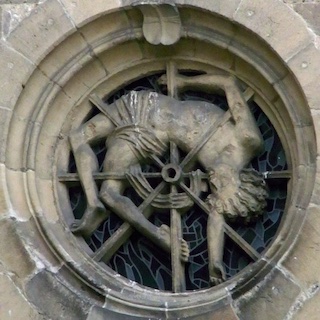
The persecution under Nero was the first serious clash between the Roman authorities and the Christians. Subsequently, the persecution of Christians took on a different character, occasionally turning into a real mass repression, then fading away. For example, at the beginning of the 2nd century, Emperor Trajan recommended not to deliberately seek out the followers of the new religious doctrine, but to punish them whenever they got caught. The pagan authorities fought against Christianity, putting to death mainly its church leaders rather than ordinary believers. One of the martyrs was the bishop of the church of Antioch, Ignatius (c.35–c.107), who was given the nickname of the God-bearer.66 Several of his epistles to the churches of various cities have survived: Ignatius wrote them while being transported to Rome. He wrote about the unity of the Church, which by that time had spread throughout the Mediterranean; about the center of Christian life—the Eucharist, which binds all believers with invisible bonds; about the role of the bishop as the primate of the local church. The Roman authorities did not arrest the Christians who greeted Ignatius on his way to Rome. Instead, they wanted to intimidate the believers by the spectacle of their leader’s execution. The Christians hoped to free Ignatius, bribe the soldiers or take him from them by force, but he held them back, saying: “Do not deprive me of the opportunity to share suffering with Christ.”
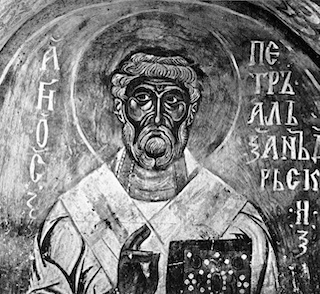
In Rome, Ignatius was sentenced to death. He was thrown into the circus arena to be torn apart by wild animals.
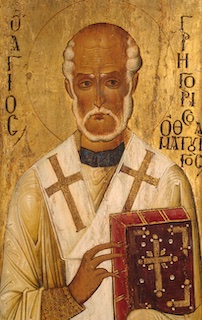
It seemed that such a reprisal against the Christians would crush their spirit. However, the events unfolded in a completely different way. The number of Christians increased, church communities sprang up in many cities of the empire. Among the figures of the Church, along with ordinary people, there were also highly educated representatives of classical antiquity. Such was Justin the Philosopher (c.100–c.165), who came from a rich Syrian family and received a good Hellenistic education. Having mastered Greek philosophy, Justin continued to seek the Truth and found it by turning to the Old Testament and the Gospels. After becoming a Christian, he began to think hard about how best to relate to the mighty civilization that was bustling around him—Rome with its science, technology, political system, law, philosophy, and art. The problem of the relationship between Christianity and antiquity culture concerned many Christians at the time, who addressed it in different ways. Many, like the great church writer Tertullian (c.160–c.220), completely disavowed the pagan heritage. Justin, on the contrary, saw a foreshadowing of the Gospel in the classical culture of Greece and Rome, and he found much in it that was important and valuable. He did not think it possible to simply discard everything that had been previously created by humanity. This attitude, however, did not prevent Justin from conducting polemics with pagan philosophers. In the end, one of his opponents found an easy way to prevail in the debate: he simply reported Justin to the authorities and got him arrested. The then reigning Marcus Aurelius, although a man of high moral qualities, erroneously regarded Christians as a dark sect and therefore authorized their persecution.
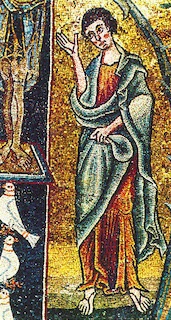
Justin is summoned to court. The dialogue between him and the judge is brief:
“What kind of philosophy do you teach?”
“I teach a new philosophy—the philosophy of Christ.”
“This is a forbidden teaching. Denounce it, or you’ll be punished.”
“I have nothing to denounce. Do your duty.”
The judge pronounces the verdict. Together with Justin, his disciples, too, go to meet their deaths.
The spark of the new philosophy, however, could no longer be put out with repression. A large number of educated people joined the Church. At the end of the 2nd century, in Alexandria, one of the largest cities of the empire, where Egyptians (Copts), Jews, and Greeks lived in close proximity, catechetical schools were established to prepare new converts for baptism. The first catechist was Pantaenus, who later went on being a missionary to India. His successor was Clement of Alexandria (c.150–c.215), who received a brilliant pagan education in Athens and was deeply imbued with Greek philosophy. Like Justin, Clement writes about the synthesis of divine revelation and culture of classical antiquity, about the relationship between faith and knowledge, about the harmony of the heart and mind. He reminds Christians that reason is given to man by God and only a cowardly soul fears knowledge.
A new theological tradition was gradually formed in the Alexandrian Church that would largely determine the further development of Christian thought in the East and the West alike. Among its notable representatives is Origen (c.185–c.254), a disciple of Clement. When Origen began teaching at the catechetical school, he was not yet ordained, yet crowds of people gathered for his lessons. In his numerous theological works, Origen established himself as a free thinker: the dogmas of faith, in his view, afforded him the opportunity and the right to seek a range of interpretations. It is no coincidence that not everything in Origen’s legacy was subsequently accepted by the Church. Nevertheless, in all centuries, Christian theologians of various directions have turned to him as one of the leading authorities. Origen was the first in the history of the Church to compose a detailed exposition of the Christian doctrine. In addition, he laid the foundation for the study of the Holy Scriptures, developing methods for interpreting the Bible. Recognizing the multilayered nature of the biblical text, he also presupposed multifacetedness of its interpretation.
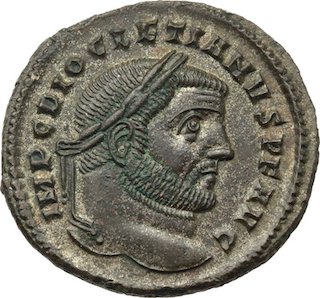
The growth of the number of Christians in all the provinces of the Roman Empire, accompanied by an increased ability of the new religion to resist the prevailing ideology, could not go unnoticed by those who concentrated the power of the state in their hands. Therefore, the Roman emperors would periodically intensify their persecution of Christians, seeking to destroy the Church or at least stunt its growth. Initially, the persecution had a more or less local character. Such were episodic mass repressions in those provinces where the activities of Christians came into direct conflict with the policy of the authorities, such as in Lyon in 177.[94]
An attempt to exterminate all the Christians across the entire state was first made by Emperor Decius in 249. He began by testing all citizens for their loyalty to the state: everyone had to publicly make a pagan offering—to throw a grain of incense into the censer in front of the statue of the deity. To perform such a rite was unthinkable for a Christian: any worship of another deity meant betrayal of Christ. This resulted in mass executions of Christians. The time had come for a severe test of faith: many chose to accept a martyr’s death, some renounced, others went into hiding, trying not only to save their own lives, but also to save the Church from complete destruction. However, the persecution failed to crush the Christians and did not even break down their unity.
It is known, for example, that the bishop of Carthage, Cyprian, a renowned church writer, was forced into exile. He continued to lead the Carthaginian church, which existed in complete secrecy, from a distance. Two years later, when the wave of repression began to subside, Cyprian returned to Carthage, where he received the crown of martyrdom in 258. This took place during another persecution under Emperor Valerian, who, after an unsuccessful ban on mass gatherings for Christians, ordered the destruction of all the clergy, as well as the noble laypersons. Although the emperor’s order was not carried out in full, it cost many church leaders their lives.
The subsequent short period of relative calm was interrupted in 303 by the edict of Emperor Diocletian, who decided that he could preserve the crumbling empire by suppressing dissent. The edict ordered the widespread destruction of Christian churches and the burning of manuscripts of Holy Scripture. In a new edict of 304, the emperor demanded the physical elimination of all Christians. Mass executions began, sometimes resulting in the destruction of entire towns. However, the dying pagan state was unable to drown the living faith in blood. The determination of the martyrs only contributed to the popularity of Christianity.
With the abdication of Diocletian from the throne in 305, the repressions weakened. Soon came a turning point in the history of the Church. Constantine, the former co-ruler of Diocletian, became the head of the Roman state in 306.
In 313, a new edict was published in Milan, signaling a change in the religious policy of Rome. That document, signed by the co-rulers of the empire, Constantine and Licinius (c.265–325), talked about the recognition of Christianity alongside other religions. Christians were granted the right to freely profess their faith, and the property confiscated from them during previous periods of persecution had to be returned, or its cost had to be reimbursed. The state began to provide material assistance to the Church. Later, having defeated Licinius in the struggle for the throne and becoming the sole ruler of Rome in 323, Constantine would consistently pursue a pro-Christian policy. With religious equality, the position of the Church was greatly strengthened, and, although the number of Christians did not exceed even a tenth of the population of the empire, they began to play an important role in its life. It is still debated whether Emperor Constantine was a man of faith or whether his benevolent attitude towards the Church was dictated primarily by political considerations. Being a patron to Christians, the emperor also showed tolerance for pagans: for example, in 324, he minted coins bearing pagan imagery. Constantine was baptized shortly before his death in 337, while retaining the title of pontifex maximus—the supreme pagan priest of the empire. At the same time, as a Roman emperor, he understood the need for a state religion that could become its unifying force. He intended for Christianity to fill that role.
The emperor lavished gifts on the clergy, exempting them from certain civic obligations, restored destroyed churches, and built new ones. This drew the admiration of the Christians. An emperor who patronizes the Church—what more could one ask for? The historian Eusebius, a contemporary and the first biographer of Constantine, speaks of that time as the happiest days the Church had ever seen. However, Christians sometimes failed to notice how, despite all the external well-being of the Church, a process of destruction of genuinely Christian consciousness and morals was underway.
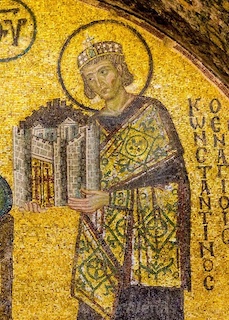
The rapid Christianization of Roman society was often nominal. Many chose to be baptized to please the emperor, either influenced by fashion or simply out of selfish motives. According to the Russian philosopher Aleksey Khomyakov (1804–1860), during that time, “Christian martyrs were replaced by Christian flatterers.”[95] The clergy felt themselves in the position of pagan priests and began to seek accolades, wealth, and power. Money from the imperial treasury flowed in a wide stream to the church treasury, and this further inflamed the greed of the clergy. The Christian life, which had previously been so strikingly different from its pagan counterpart, gradually began to mirror it. Fans of bloody spectacles and circus games no longer had to abandon their habits even after they converted to Christianity.
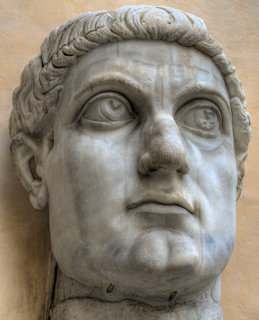
In 330, the Emperor Constantine founded a new capital on the site of Byzantium. Constantinople quickly became the center of the religious and political life in the East. With the capture of Rome by the Germanic tribes in the 5th century, the new city became the only stronghold of the Greco-Roman culture. Ancient and satiated Rome grew weaker and more depraved. The transfer of the capital to the east only intensified this process. Against this background of the moral decay of the empire, the number of adherents of Christianity grew rapidly and the authority of the Church increased. The sons of Constantine realized that they could use these circumstances to their own end, and they became even more supportive of the Church, banning sacrifices and visits to pagan temples. At the same time, the emperor began to regard himself as being entitled to freely interfere with internal church affairs, steering it in a direction most favorable to him. Christianity ended up being in danger of enslavement by the state. Thus, the state church began to be created, which would later become an instrument of politics used by the rulers to, among other things, persecute dissenters.
In 361, Emperor Julian, nicknamed the “Apostate,” ascended the imperial throne. An educated man, inclined towards Neoplatonism rather than Christianity, Julian stripped the Christian Church of its privileges and restored the freedom of all religions, including pagan cults. However, his reign lasted only for three years and could not reverse the course of history. Subsequent emperors restored the privileges to the Church, and in 380, Emperor Theodosius I ultimately conferred Christianity with the status of the state religion. By his edict of Constantinople of 392, pagan worship was banned.
Thus, the path of the Christian Church had had both positive and negative tendencies from the very beginning. Those tendencies were destined to manifest themselves in subsequent centuries. And yet the negative inclinations rooted in the sinful nature of man were always alien to the very spirit of Christianity. The truth of Christ, which laid at the foundation of the Church, helped her to overcome the dangers and temptations along her path. As a result, even the process of the secularization of the Church, which led to many sad consequences, continued to serve the main goal of the Christian Gospel—the sanctification of the world by the name of Christ. For the first time, the pagan state and society became subject to the principle of the single and all-encompassing Truth, which slowly but steadily assumed its place in the world. And although sinful humanity at times accepted the Truth only outwardly, while inwardly fiercely resisting and distorting it, the world was given a chance for a transformation. “Christianity,” wrote the Russian philosopher Vladimir Solovyov, “was not and could not be a ready-made perfect order of things, something that humanity was only left to join…. Christianity has set an absolute ideal for man, has given him the ultimate task for his own work.”[96] This was the main result of the period of Constantine.
The new era that had arrived with the declaration of Christianity as a state religion also posed new problems for the Church. After all, from its very beginning, Christianity was represented by various trends that did not always agree on everything and sometimes were even at odds with one another. But if during the times of persecution those trends were united in order to survive in the difficult struggle against a common enemy, this unifying principle was no longer present. Therefore, the Church had to focus its attention not so much on moral issues (almost all Christian groups competed in moralism and rigor), but on the matters of the Christian faith itself as a coherent philosophical system. Christianity went beyond the narrow confines of catechetical schools and circles, and theology became the topic of discussion among the broad masses. At the same time, not only did the language of Greek philosophy become the language of Christian theology, but the Hellenic spirit itself, with its characteristic polemical fervor and irresistible desire for systemization, found its place in Christianity. Just as there were lively disputes and confrontations of various parties in the public squares in Greece, so the new Christian dogmatics became the subject of a fierce struggle. Contentions and ideological battles between representatives of various Christian movements flared up surrounding the questions of the Incarnation, the Trinity, the Atonement, the mystery of the Church, and other fundamental concepts of Christianity.
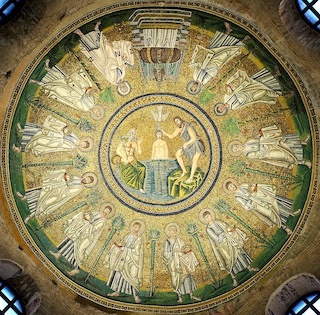
The question arose before the Church: which of the trends of Christianity really represented the undistorted Truth of Christ? Where was true Orthodoxy, and where was heresy?67
Determining the answers to these questions became the main theme of the subsequent period of Church history—the age of Ecumenical Councils (4th–8th centuries). In her struggle against various deviations from Christian truths, the Church developed the conceptual apparatus of Christian theology, with the help of which she expounded and clarified the provisions of the Christian faith. These provisions were summarized and consolidated in short formulas or creeds.
The first and most serious test for the internal life of the Church was the Arian upheaval, which literally shook the Christian world.
In 318, Alexander, Bishop of Alexandria, delivered a sermon on the mystery of the Holy Trinity to the local presbyters. Presbyter Arius, a famous preacher, ascetic, and scholar, began to object to his sermon. Seeking to emphasize the absolute oneness of God, Arius taught that the Son was not pre-eternal, but created by the Father, which meant that the Son of God was unequal to the Father and did not possess the fullness of Godhead. Arius’ ways of addressing the Christological questions68 were rooted in Greek philosophy and were of a purely rationalistic nature. Such views strongly contradicted the emerging doctrine of the Church, which was defended by the theologians of Rome and Alexandria.
A talented preacher and poet, Arius began to passionately promote his ideas. A tense struggle broke out between his supporters and opponents. It even came to street clashes. The whole Church was in a state of agitation, and there was a need for a church-wide response to the challenges that had emerged.
In the summer of 325, Emperor Constantine, at government expense, convoked an all-imperial congress of representatives of the Church in the city of Nicaea. That Congress went down in history as the First Ecumenical Council.
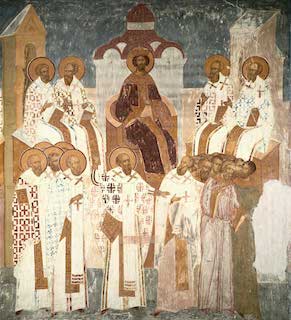
At this Council, the imperial and episcopal authorities came together for the first time. The scholar and historian Eusebius of Caesarea and the Spanish bishop Hosius together with the emperor presided over the Council. Among those present were eyewitnesses of earlier times, confessors of the faith who had suffered from persecution, stern hermits, and cautious court theologians. The Council was attended by at least 200–300 bishops, including Arius and a group of bishops who supported him, headed by Eusebius of Nicomedia. The supporters of Arius were opposed by a large number of bishops, led by Alexander and his secretary Athanasius, a young and talented archdeacon, later the Patriarch of Alexandria. The majority of the participants in the Council, headed by Eusebius of Caesarea, adopted a compromise position.
Athanasius proved to be the most decisive opponent of Arius’ views. First of all, he rejected the position of the rational knowability of God inherent in Arianism. Rivaling Arius in his education and ability to substantiate his conclusions with texts from the Holy Scriptures, Athanasius came down hard on his opponents, who, according to his words, “like busybodies desire to ‘search the deep things of God’ which ‘no one knows but the Spirit of God’, against whom they speak evil.”[97] Yet it does not mean, Athanasius argued, that God has completely hidden His face. He makes His face known to those of true mind who have embraced divine revelation. Athanasius devoted his main attention to the Christological question: by refuting the errors of Arius, he asserted the equality, coeternity, and consubstantiality of Christ with the Father.
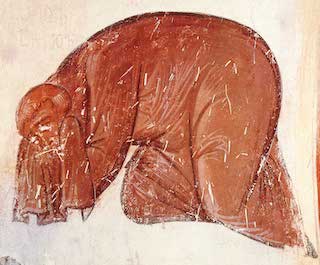
At the end of numerous discussions at the Council, the Creed was formulated. It talked about God the Almighty, the Creator of the whole world, and the Son of God, who was incarnate in Jesus Christ.
The Church’s truth found its full expression here. Christ was declared to be of one essence with the Father and at the same time a Man who lived in a certain period of history (that’s why the name of the Judea’s procurator, Pontius Pilate, was inserted into the Creed). The text of the Creed also enshrined, albeit tersely, the faith in the Holy Spirit.
The main contention surrounded the introduction of the word homoousios (Gr.: “of one essence”) into the Creed. For Arius, as well as Eusebius of Nicomedia and other representatives of the Arian party, agreeing to this was tantamount to recognizing Christ as being consubstantial with God. This was something they were unwilling to do. The participants of the Council began to discuss the possibility of finding a replacement for this new concept.
Eusebius of Caesarea and his supporters suggested replacing the word “of one essence” with “of similar essence”, but Hosius and Alexander, with the support of Athanasius, remained adamant. They recognized that it was their responsibility to preserve the true Christian doctrine. And they prevailed. The truth seemed to have finally triumphed, yet Emperor Constantine made a tragic mistake, once again putting his imperial court above that of the Church. Seeing that the majority of the Council members were leaning towards the new Creed, Constantine sent the recalcitrant Arian leadership into exile. The Council was adjourned. It turned out, however, to be only the beginning of the struggle.
After some time, Arianism began to gain strength and soon became the prevailing doctrine in most areas. The success of Arianism was in many ways enabled by the inner circle of Constantine. The intrigues of the Arian clergy and the mistakes of the Orthodox, too, played their part. For almost half a century, Orthodoxy was persecuted by the state and its defenders could be counted on one hand. Athanasius, who was elected to the Alexandrian bishopric, played a huge part in defending the Christian truth. Leveraging the authority of his office, he engaged in active preaching and literary work, for which he had to endure great hardship during the period of Arian dominance.
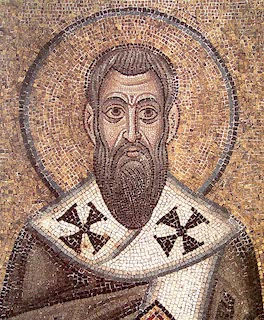
The tenets, which were proclaimed at the Council of Nicaea, were basically kept alive by Athanasius. Left almost alone, he eventually prevailed because he stood up for the Truth.
Arianism, although on the verge of its demise, was not yet defeated and was continually splitting into endless groups and sects. The final extinction of Arianism was delayed by the support afforded to it by the ruling dynasty. As before, the state continued to actively interfere in the affairs of the Church. Such great Fathers and teachers of the Church as Basil the Great, Gregory the Theologian, and Gregory of Nyssa fought against this interference by the authorities.
In 381, the Second Ecumenical Council was convoked in Constantinople, at which Emperor Theodosius I approved the Nicene Creed. The Nicene Creed was further augmented at the Council of Constantinople with an article of faith regarding the Holy Spirit. Thus, the Orthodox understanding of the faith in the one and indivisible Trinity was finally formulated. In addition, the Creed reflects the Orthodox understanding of the Church, the faith of Christians in the saving power of baptism, and salvation through the atoning death of Christ. This creed, called the Nicene-Constantinople Symbol of Faith, was approved at the Council of Chalcedon in 451 and has since been the official creed of the current Orthodox Church (and, in a slightly modified form, of the Roman Catholic Church). Today it is read by the faithful at every liturgy—the main service of the Church.
Translated into English, the Nicene-Constantinople Creed reads as follows: “I believe in one God, the Father Almighty, Maker of heaven and earth and of all things visible and invisible. And in one Lord Jesus Christ, the Son of God, the Only-begotten, begotten of the Father before all ages. Light of Light; true God of true God; begotten, not made; of one essence with the Father, by whom all things were made; who for us men and for our salvation came down from heaven, and was incarnate of the Holy Spirit and the Virgin Mary, and became man. And He was crucified for us under Pontius Pilate, and suffered, and was buried. And the third day He rose again, according to the Scriptures, and ascended into heaven, and sits at the right hand of the Father; and He shall come again with glory to judge the living and the dead; whose kingdom shall have no end. And in the Holy Spirit, the Lord, the Giver of Life, who proceeds from the Father; who with the Father and the Son together is worshipped and glorified; who spoke by the prophets. In one Holy, Catholic, and Apostolic Church. I acknowledge one baptism for the remission of sins. I look for the resurrection of the dead and the life of the world to come. Amen.”
The cultural world of the Late Antiquity and the Early Middle Ages was, using the imagery from the prophet Isaiah, “like the troubled sea, when it cannot rest, and its waters toss up mire and mud.”[98] Against this backdrop of chaotic life, where heretics mingled with sectarians, and sovereigns dictated doctrinal formulas, where literal fistfights over metaphysical subtleties broke out in the marketplaces, and the pagans tried their best to have a rematch, the majestic figure of Basil, Bishop of Caesarea, called the Great by the Church, stands out.
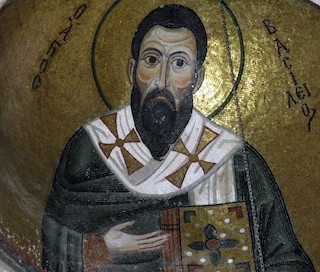
Basil’s life journey as a successor to the works of Athanasius of Alexandria is closely connected with the life of Gregory, the friend of his youth, who would later occupy the patriarchal see of Byzantium. Together they perused Hellenic wisdom in Athens, with the future Emperor Julian studying alongside them, and together they learned in the school of solitary living in the mountainous forests of Pontus.
Even then, the differences in their characters and aspirations began to manifest themselves. Basil was an energetic and active person. His deep statesmanlike mind, noble appearance, and brilliant eloquence allowed him not only to hold on for a long time to the cathedra (bishop’s throne) of one of the largest cities in the East, the capital of Cappadocia, but also to vigorously defend Orthodoxy against numerous pagan and heretical enticements. When the pagan Julian became emperor, Basil, who was then still a presbyter, together with Gregory’s father, openly confronted him. To enlist the support of Christians, Basil toured the settlements of monks in Egypt and Syria. The results of his trip were very successful: Basil’s strict ascetic life made an impression even on the monks. For all his exuberant energy, he highly valued the fruits of monastic living. He devoted a great deal of his time to developing the Rule for monastic communities, which harmoniously combined a contemplative, prayerful life with communal labor, charity, and educational activities.
Basil became the archbishop of Caesarea, when the Christian world was literally being torn apart by controversies and intrigues. Councils and theological congresses followed one after another. At those meetings between the church leaders, numerous opposing sides condemned, cursed each other, argued, often forgetting the original subject of the dispute. National, political, cultural, religious, and dogmatic discords turned Christians into “sheep without a shepherd.” It is not surprising that it was not easy under those conditions to defend the true doctrine of the Church in the struggle against the supporters of Arius.
Basil was brought up in the strong Nicene traditions, and he fought Arianism with his writings from the very beginning of his episcopate. In his teaching on the Trinity, he firmly defended the Orthodox position, although, at times, showing inconsistency when trying to reconcile the various trends within Orthodoxy itself. The main contribution of Basil the Great is that he was able to finalize the theological terminology, which became adopted by the Church.
The reigning Emperor Valens (364–378), a patron of Arianism, began to administratively impose this heresy in the East, especially among the barbarians. When his decisions were met with Basil’s resistance in Asia Minor, the emperor ordered the arrest of the archbishop of Caesarea. The angered local population, however, released Basil, and Valens did not dare to sign the verdict of his expulsion.
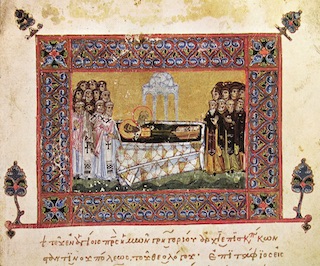
Meanwhile, Basil, as a display of his complete independence from the emperor, built hospitals and schools in the vicinity of the city, which grew into a large settlement called Basiliad. The archbishop would address the public with fiery speeches, promote Orthodoxy in all its centers, and provide encouragement to the Christian youth. His inspirational serving of the divine liturgy brought Basil wide fame. Standing before the altar, he would give himself completely to prayer. Basil of Caesarea was among the first to establish a strict sequence of liturgical instructions—rubrics.
The religious genius and the breadth of the intellect of the bishop of Caesarea were great indeed. Yet he was most in his element when fighting against false teachers, as well as carrying out his administrative church duties. To strengthen his diocese in the face of combating the Arians, he used to ordain his closest associates as bishops. And when it became necessary to fill the newly established bishopric in the town of Sasima, the choice of Basil fell on Gregory, the friend of his youth.
Gregory Nazianzen, better known in the history of the Church as Gregory the Theologian, was born into the family of a bishop from the Cappadocian city of Nazianzus. By temperament, Gregory was a diametric opposite to Basil of Caesarea. Whereas the great Caesarian loved the wilderness only as a place of prayerful retreat, Gregory saw in the solitude of contemplative monasticism his ideal way of life. His versatile education and brilliant poetic gift put him on a par with the most talented writers of that time. A subtle psychologist, he had an innate ability to capture and analyze the innermost thoughts and deepest feelings of his contemporaries.
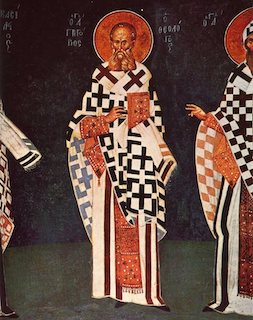
The poetry of Gregory takes us from the noisy streets of Byzantium and Alexandria to a completely different world—one of stillness and peacefulness. He finds the highest joy and peace of heart in living in Christ, in prayer, and in monastic asceticism. Gregory was passionately fond of nature, which was often a source of his poetic inspiration and philosophical reflection. The quiet light of the poetry of Gregory Nazianzen is like a breath of fresh air in the atmosphere of fierce political and religious polemics, which fills the pages of the books of that time.
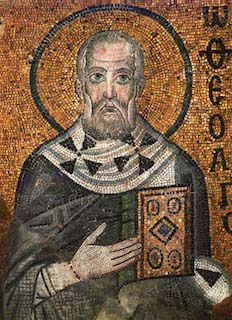
However, Gregory did not seek to hide from the world in his monastic cell or isolate himself from the problems of his contemporaries. Even in solitude, excruciating thoughts about the fate of the Church would not leave him.
The maelstrom of events eventually drew Gregory into the torrent of ecclesiastical and political life, which proved to be very challenging for him. “Wild beasts, will you not receive me? For you, in my view at least, have greater loyalty [than men],”[99] he wrote in despair. This meek man of prayer was forced to go out on the battlefield. In the most difficult moments, Gregory would turn his gaze to Christ to find support and consolation.
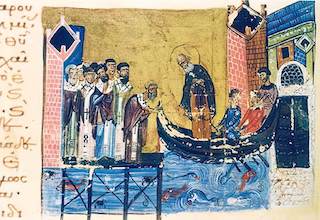
Gregory’s writings are divided into three groups: a collection of poems, letters, and theological works. Especially important for the Church are his “Five Theological Orations,” so named by the author himself, earning him the title of “the Theologian.” In them, Gregory defends the Orthodox doctrine of the Trinity, confronting the Arians and other heretics.
In essence, Gregory’s teaching on the Trinity is equivalent to the teaching of Basil the Great, yet it is more consistent. In addition to Trinitarian theology, Gregory made significant contributions to Christology. In his works, he considered it possible to know the Divine only through revelation: being a keen connoisseur of Greek philosophy, he allowed a very limited use of logical-rational methods for gnosis. On the whole, his attitude to philosophy was critical; Gregory lamented the fact that Hellenistic thought was permeating Christianity.
In 379, Gregory was made Patriarch of Constantinople, yet his new position was precarious. The strife and intrigue that engulfed Eastern Christianity was compounded by the growing suspicion of the West. Gregory, who continued the cause of Basil the Great and sought reconciliation with the West, soon fell out of favor. After the Council of 381, convened by Emperor Theodosius I, he was forced to leave the metropolitan see and died near Nazianzus in 389.
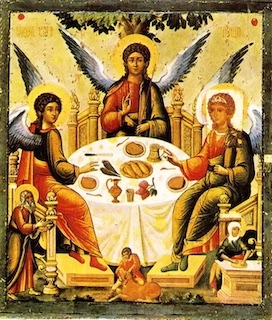
Christ’s warning, “Beware of the leaven of the Pharisees,” became prophetic for Christianity, as seen from the ensuing path of the Church.
Christianity that entered the world without seeking to transform it soon became a slave of society, a slave of the world. At the turn of the Middle Ages, the world itself was experiencing a profound crisis and decline. The emerging feudal system, which gave an impetus to the development of material civilization, the revival of economic life, and the rapid growth of cities, was accompanied by the fatal weakening of cultural life. Paganism had outlived its usefulness: its ideas about the world had degenerated into extreme forms of skepticism and wild superstitions. It would seem that the Church was meant to save culture. Yet the compromise she was willing to make with the old world sealed a different fate for her. As a result, the process of decay did not spare the Church: the clergy became guided by selfish ambitions, while the laity often resembled a crowd of fanatics rather than members of the Church of Christ. And those whose hearts were ablaze with the fire of Truth were often left powerless to stop that process.
Christianity was destined to endure and survive the pride of the princes of the Church, bitter humiliation, and impotence in the face of world history. This fate befell the Church as a severe punishment for the sins of historical Christianity that became imbued with the spirit of paganism. Yet, at the same time, it would serve as a great lesson for future generations of Christians.
Gregory Nazianzen was the first to see the chasm that separated the historical church and the true Church as the Body of Christ. The bishops’ thrones of the West and the East grew increasingly antagonistic to each other. Rome was strict, orthodox, and insistent on its supremacy. Alexandria was slipping from the noble and enlightened Christian freedom into superstition and intolerance. Along with Antioch, it vied against Rome for primacy in Christendom. Constantinople declared itself the second Rome, but it too was bogged down in theological disputes and ecclesiastical intrigues. The decline of morals in Byzantium was alarming: corruption and depravity reigned everywhere.
Forced to leave the Second Ecumenical Council of 381 and give up his patriarchate, Gregory the Theologian warned: “East and West are arrayed on opposite sides, and bid fair to be severed in opinion no less than in position.”[100]
Everything that was happening, according to Gregory, was the result of combining the Gospel message with the old pagan way of life: society was looking “not for priests… not for stewards of souls, but for treasurers of money, not for pure offerers of the sacrifice, but for powerful patrons.”[101]
The Council of Constantinople marked the beginning of the eventual separation of the Church into the Eastern and the Western parts.
The Roman Church was initially successful in actively affecting the peoples of the Western Empire with the Christian ideals. Eventually, however, the papal throne itself became infected with the worldly spirit.
The popes began to assert their primacy in the Christian world, basing their claims on the tradition of the founding of the Roman Church by the Apostle Peter. In addition, the status of Rome as the capital of the once-mighty Roman Empire was of a considerable import: the bishop of the royal city should, too, be entitled to the royal dignity. Such were the reasons behind Rome’s claim to primacy.
In their ecclesiastical activities, the popes relied on the power of the state, and, gradually gaining power, they began to put themselves above secular authorities, especially as the Western Empire significantly weakened.
Pope Damasus was a prominent exponent of the idea of the papacy in the 4th century. A contemporary of Gregory the Theologian and Basil the Great, he occupied the papal throne from 366 to 384. He had no shortage of rivals: the cathedra of St. Peter very early became a privileged and profitable position. One pagan official even stated: “Make me bishop of Rome, and I will at once become a Christian.”[102] Gregory of Nazianzus spoke with indignation about the lifestyle of some of the Roman high priests. The clerics, he said, “rivaled the consuls, the governors, the most illustrious generals, who do not know what to squander their riches on… living in luxury out of the wealth of the poor.”[101]
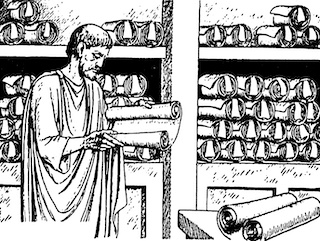
Thus, it was no easy task for Damasus to secure the papal mitre. Without dwelling on the details of his accession, we will only mention that the clashes between his supporters and the party of his rival Ursinus ended in a real massacre and the storming of the cathedral, where Ursinus had been cooped up. According to the historian Ammianus Marcellinus, about 150 dead bodies were left at the site of the carnage.
As a result, Damasus ascended to the papal throne, and, according to the same historian, began to be “enriched from the offerings of matrons, ride seated in carriages, wearing clothing chosen with care, and serve banquets so lavish that their entertainments outdid the tables of kings.”[103]
Was it possible for the Roman Christians to look on with indifference at what was happening? During Damasus’ pontificate (i.e., his term on the papal throne), some eminent Christians began to severely denounce the mores prevailing in the empire. Among them were the most prominent preacher Ambrose, Bishop of Milan, and the famous ascetic, writer and scholar Jerome of Stridon (sometimes referred to by the title of “Blessed” in the Orthodox Church).
Coming from a noble Roman family, Ambrose received an excellent education and became the imperial governor of the Milan region. In 374, at the insistence of the people, he took the position of bishop of Milan, proving himself to be an outstanding church leader and a fearless preacher. Ambrose was not only a well-known theologian but also an excellent diplomat—he skillfully defended Orthodoxy before the authorities, who were often under the influence of the Arians. At the same time, he was uncompromising on matters of principle. Thus, Ambrose would fearlessly raise his voice against the excesses of the imperial power.
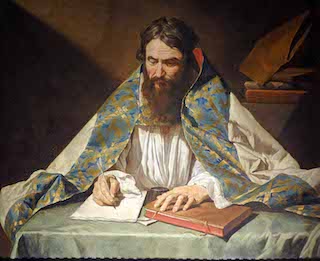
Ambrose became a leading force against the dying paganism. He firmly defended the Nicene Creed, writing several treatises in defense of Orthodoxy. An expert on ancient classical heritage, Ambrose, in his sermons and written works, widely employed the concepts from Greek philosophy. Ambrose was a proponent of the allegorical method of interpreting biblical texts and wrote numerous commentaries on the Holy Scriptures. Ambrose’s teaching on the Holy Spirit is considered a significant contribution to Christian theology. He is the author of the book “On the Duties of the Clergy”—essentially, the first guide on Christian ethics.
Ambrose of Milan also made great contributions to church music. He reworked the musical system of the Greeks and introduced the so-called antiphons (alternating singing of two choirs).
Pope Damasus, not the best of the Roman high priests as far as his way of life was concerned, was nevertheless a liberal and educated man. The most prominent bishops in the East, and especially Basil of Caesarea, hoped that Damasus, who enjoyed a wide influence, would help them defeat the Arian heresy. Damasus justified their expectations to some extent. For example, he helped to resolve the schism in Antioch caused by the Arian controversy. In 382, Pope Damasus set out to prepare a new translation of the Bible into Latin.
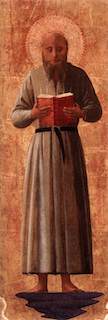
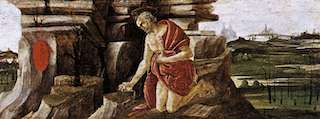
Having heard about the encyclopedic knowledge of the priest Jerome of Stridon, as well as his expertise in languages, the pope summoned him to Rome, made him his secretary, and instructed him to prepare a new translation of the Holy Scriptures. The translation made by Jerome is called the Vulgate and is still authoritative and universally recognized in the Western Church. In addition, Jerome compiled many commentaries on the Bible; he wrote his famous work “On Illustrious Men” modeled after biographies of classical antiquity, where he collected information about the Christian writers of apostolic times and their main works.
Despite his scholarly and literary pursuits, Jerome could not remain indifferent to his surroundings. The society and the church of the western capital made a most repulsive impression on the young scholar. In his open letters, he denounced Roman society with extraordinary acerbity, not inferior to Jonathan Swift in the sharpness of his sarcasm and satirical gift. It is not surprising that the clerics began to hate Jerome, who quickly made enemies for himself.
Jerome mercilessly mocked the eastern pomp that had permeated Rome. He vividly depicted the Roman patricians, who, like the Persian satraps, used to flaunt their magnificent clothes. The “poor” matrons, deprived of the opportunity to wear luxurious dresses with embroidery depicting scenes from mythology, found a substitute by replacing satyrs and bacchantes with the New Testament saints. Men, writes Jerome, would spend all their leisure time in taverns and playing dice. The feasts were accompanied by the same wild orgies as in the days of Nero.
Jerome came down particularly hard on the clergy. Describing the lifestyle of a cleric, the writer recounts: “He rises and goes forth with the sun; he has the order of his visits duly arranged… and forces his way almost into the bedchambers of ladies yet asleep. If he sees a pillow that takes his fancy or an elegant table-cover—or indeed any article of household furniture—he praises it, looks admiringly at it, takes it into his hand, and, complaining that he has nothing of the kind, begs or rather extorts it from the owner. All the women, in fact, fear to cross the news-carrier of the town. Chastity and fasting are alike distasteful to him…. Whatever news is noised abroad he is either the originator of the rumor or its magnifier.”[104]
In denouncing the undignified aspects of social and ecclesiastical life, Jerome sometimes went to extremes, glorifying, for example, excessive asceticism in his writings. Still, the causes that he saw that had resulted in the whole situation were compelling. On the one hand, he pointed out that society had not really adopted Christianity and, on the other, that the tension and decline in social life depended to a large extent on the glaring inequality in the distribution of material goods. That’s why Jerome put forward his famous thesis: “All riches, being a spoliation of others, are born of injustice.”[105]
The literary heritage of St. Jerome is enormous. In addition to the translation of the Bible, it includes Bible commentaries, translations of other books, historical treatises, and theological essays. St. Jerome’s encyclopedic knowledge, erudition in history, geography, and other sciences, which he used in his commentaries on the Holy Scriptures, make him a harbinger and father of biblical criticism69 in its modern sense. Many of Jerome’s works are devoted to apologetics and defend the teaching of the Church against both paganism and heretical teachings, such as Pelagianism and Origenism. Jerome was the first to write a treatise on Christian monasticism.
While the growing influence of the papal throne led to the secularization of the Church in Rome, the Church in the East practically closed in on itself, leaving the world to its own devices. The emperors would pick the side in the conflicting ecclesiastical tendencies that afforded them maximum political advantage. In fact, they often pursued religious policies by the same means as their pagan counterparts.
During the reign of Theodosius, following his final attempt to unify the empire, Orthodoxy finally prevailed at the court of Constantinople. Oddly enough, this resulted in the subsequent events that had nothing to do with the spirit of Christian love and tolerance. The eradication of the remnants of heresy, as well as the attitude towards the Jews who stubbornly refused to believe in Christ, would take anything but Christian forms. In addition, the clergy of the Orthodox empire began to consider it their duty to interfere in political life—often out of purely selfish interests rather than standing up for Christian principles.
In 384, only three years after the Second Ecumenical Council, Western Roman Emperor Maximus, seeking to emphasize his Orthodoxy, accused Bishop Priscillian of heresy. The bishop was later sentenced to death on slanderous charges leveraged against him by his opponents. Ambrose and the monk Martin, who was very popular in the West, strongly protested against the execution of Priscillian. But all was in vain: Priscillian died for his beliefs at the hands of a Christian executioner.
As we recall, Emperor Theodosius finally banned paganism in 392. Fines and confiscations were imposed for the practice of pagan worship both in temples or in private. Although these laws were rarely enforced under Theodosius himself, they would play a fatal role later.
The issue of pagan temples was particularly acute. Their destruction and closure caused great indignation among the population, who were still very little Christianized. The famous pagan sophist Libanius wrote letters to the emperor in defense of the temples—often magnificent monuments of art. At the same time, he remarked, not without reason: “They claim to worship their God with fasting, and yet grow fat on the misfortunes of other folk.”[106]
Yet his addresses went unanswered, as did the protests of Martin, the precepts of Gregory of Nazianzus, and the thunderous sermons of Jerome. Moreover, a fierce campaign was launched in Alexandria to forcibly eradicate paganism. The last refuge of the ancient cults was the grandiose temple of Serapis, which also housed the famous library.
Theodosius, unsettled by the prosperity of this center of pagan life, gave orders to destroy it. The Alexandrian bishop Theophilus, one of the most sinister figures in the history of medieval Christianity, a vivid example of fanaticism and intolerance in the then state church, took up the case. His crude mockery of the Egyptian religion led to an open clash between Christians and pagans in Alexandria, during which there were numerous victims on both sides. Christian fanatics destroyed the temple of Serapis and burned the Library of Alexandria—the largest treasure house of world culture. Theophilus was triumphant, parading the statues of the fallen pagan gods.
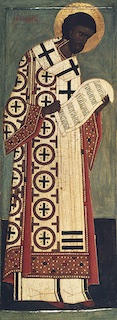
Lastly, allied with the Byzantine court, Theophilus organized a frenzied persecution of the new patriarch of the eastern capital, John Chrysostom, whose role in the church life of Byzantium is comparable to that of St. Jerome in Rome.
John was born into an aristocratic family in Antioch, where he spent most of his life. Raised by a pious mother, he early took a liking to solitude. John studied sciences under the famous Libanius, who had also been the teacher of Basil of Caesarea, Gregory of Nazianzus, and Julian the Apostate. Thanks to his clarity of thought, sharpness of mind, and iron logic, John became a favorite student of Libanius, who saw him as his successor. However, the talented young man chose a different path. Baptized at 21, he became a monk.
At first, the flame of faith drew John to a life in the wilderness, where he voluntarily endured the most severe hardships. However, his views underwent some changes over time. John realized that excessive asceticism often turned into an end in itself. Later, he wrote: “Do not say to me that I fasted for so many days, that I did not eat this or that, that I did not drink wine, that I endured want; but show me if you from an angry man have become gentle, if you from a cruel man have become benevolent. If you are filled with anger, why oppress your flesh?”[107]
John returned to Antioch in 381 with impaired health. But the years of his hermitage were not spent in vain. He came back to the world inspired, with an unbreakable will, incapable of compromise. And this inner fire would guide his course for the rest of his life.
In Antioch, John soon attracted attention: a brilliant church career was predicted for him. However, John, feeling that he was not yet sufficiently prepared for the priesthood, resisted his ordination in every way possible. He expressed his views on the role of a pastor in the Church in his essay “On the Priesthood,” where he speaks about the great responsibility before God that falls on the shoulders of a priest. A priest ought to be “well versed in the affairs of this life as they who are engaged in the world, and yet to be free from them all more than the recluses who occupy the mountains. For since he must mix with men who have wives, and who bring up children, who possess servants, and are surrounded with wealth, and fill public positions, and are persons of influence, he too should be a many-sided man—I say many-sided, not unreal, nor yet fawning and hypocritical, but full of much freedom and assurance, and knowing how to adapt himself profitably.”[108] Chrysostom strictly followed these rules himself after becoming a presbyter in Antioch in 386.
A great preacher, for which he was called Chrysostom (“golden-mouthed”), John mainly interpreted the epistles of the Apostle Paul. About 640 of his sermons on various biblical passages have survived to our day, in which he paid special attention to the issues of morality.
Chrysostom possessed an extraordinary gift to command a colossal audience. It was largely this gift, combined with his deep faith and strong moral principles, that led to his elevation to the throne of the Patriarch of Constantinople in 397. However, even John Chrysostom, this great leader of the Church, was sometimes not free from reckless anger and intolerance. Thus, he is credited with a number of sermons directed against the Jews, where he speaks cruelly and unfairly about them and their faith. These sermons played a significant role in the future anti-Jewish church policies, which had nothing in common with the teachings of Jesus.
Meanwhile, as John tirelessly denounced the unrighteousness and corruption of the imperial court and clergy, literally all the upper strata of society turned against him. Empress Eudoxia and the Pope of Alexandria, Theophilus, were particularly zealous in that regard. In 403, they assembled a church council that wrongfully condemned John Chrysostom of heresy, and he was sent into exile. After some time, Chrysostom returned from exile. Soon, however, he lost his episcopal see and was exiled again, where he died three years later.
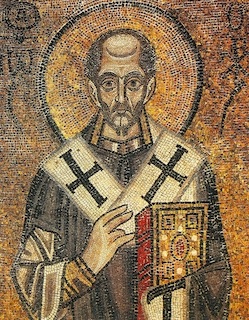
By the beginning of the 5th century, the empire had finally split into Western and Eastern parts. The Christian world and the Church itself were in a severe crisis, mired in luxury, intrigues, and corruption. Bishop Theophilus continued to commit acts of lawlessness until his death in 412. His nephew Cyril inherited from his uncle blind fanaticism, hatred of the memory of Chrysostom, and anger towards those of other faiths. On his initiative, the churches of the adherents of the Roman theologian Novatian, accused of heresy, were closed, and the Novatians themselves were expelled from the city. Cyril personally supervised the massacre of the Jews in Alexandria and the destruction of their synagogues. Finally, he tarnished himself by inciting the crowd to the murder of the female philosopher Hypatia. According to eyewitnesses, this noble and talented woman, who taught Greek philosophy in Alexandria, was captured and dragged naked through the city, after which she was brutally murdered.
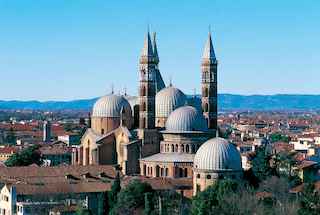
It may appear that the Gospel Message was completely buried under the weight of human sins, and that the passionate protests of the few ascetics of the Church did not find a response in the hearts of the crowd. This impression, however, is not true. The Spirit of God was working in secret, and the Savior’s Word was making its way through the filth and darkness.
With the general decline of religious and moral life in the 4th century, monasticism became the environment that preserved the teachings of Christ intact. The Gospel light would emanate from the monastic abodes, as if from a blessed source, illuminating the world steeped in sin. To get a glimpse of these abodes, we must turn again to the history of Egypt. This ancient land has given the world amazing revelations and great manifestations of the human spirit. Here, in the desert Thebaid to the north of Egypt, the first monks appeared.
What was the immediate cause behind the emergence of monasticism? First of all, the sad state of society and the Church, as already mentioned. The official church no longer seemed to the believers to be the anchor of salvation. Although an extensive church structure was unavoidable, such a structure seemed very far from the Kingdom of God. A sincere Christian within the framework of the official church inevitably experienced a tragic sense of dissatisfaction with one’s own existence.
Many Christians, acutely aware of the sinfulness of the society that now called itself Christian, felt an urge to leave it. People longed to turn again to the Gospel, their souls hungering for the “bread of life” rather than vain worldly possessions.
The course of historical and economic development, too, played an important role in this. Christian churches were increasingly filled with barbarians, who brought with them semi-pagan rituals that were unbearable to pious Christians. The opulence of life in the East evoked a desire for simplicity and asceticism.
A deep sense of contrition also caused some to seek a life in the desert. Many such examples can be found in the hagiographic literature (the lives of the saints). For example, the famous recluse Moses the Black had once been a slave, then escaped from his master and became the leader of a band of robbers. After his fame as a murderer spread through the surrounding area, Moses suddenly believed in the Lord, withdrew to a monastery, and devoted the rest of his life to asceticism and penance. The fervor that once made Moses the terror of the caravans now turned into an unquenchable thirst for spiritual purification.
The climate of the Middle East was also conducive to a life of solitude and immersion in prayer. The dry, warm air and the numerous caves in the mountains relieved monks of the trouble of having to build an abode. The fish-rich waters of the Nile and the fruit trees that grew in abundance, too, made it possible to find food without difficulty and devote oneself wholly to prayerful contemplation.
St. Anthony of Egypt is considered to be the founder of monasticism, whom Church tradition also calls Anthony the Great.
St. Anthony came from a wealthy Alexandrian family. From an early age, he aspired to a spiritual life. The passing cares of life disgusted him. After agonizing indecision, deliberations, and searching, he made his choice. The words of the Gospel, “give away your possessions,”[109] which he heard in church, determined his future.
After selling his estate and distributing the money to the poor, Anthony left the city and took up his abode next to an old hermit. Eventually, striving for complete solitude, Anthony settled in an empty tomb in a remote area, where he began to spend his time in prayer, fasting, and meditation. One should not assume, however, that Anthony’s days were limited only to prayer. According to his contemporaries, “He never suffered himself to be idle, and work did not leave his hands almost the entire day.”[110,111] Anthony considered labor to be an integral part of the monastic feat. He used to make baskets and give them to his friends in return for bread, which he received from them twice a year.
Yet the path to the Kingdom of God was not easy for Anthony. Doubts and regrets about the life he left behind assailed him, visions and demons enticed him with the promise of worldly pleasures. On the cold, starry nights, Antony would be seized with terror. It seemed to him that the enemy was constantly advancing, pressing on him from all sides. It was as if the wild howling of the jackals in the blackness of the night came from the devil himself. More than once, he lost consciousness from the horrifying sounds, images, and visions that presented themselves to his eyes; sometimes only the arrival of friends would bring him to his senses. Occasionally, he was tempted to leave that terrible desert, that harsh abode, full of mysterious sounds and strange ghosts. After all, people were waiting for him in the city; he could serve them instead and, by doing so, free himself from his spiritual torment. Yet the saint did not give up. Antony believed that stopping halfway would mean a victory for darkness. Gradually, his spiritual life grew stronger, and the temptations ceased to torment him.
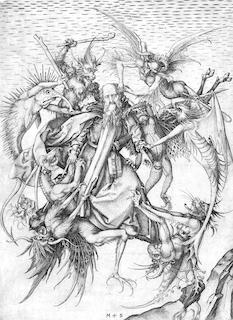
The fame of an extraordinary hermit began to spread throughout Egypt. Disciples began to come to him from the farthest regions, and some wished to settle nearby in order to lead a solitary’s life under his guidance. Thus, in 305, the first monastic community was formed around Anthony.
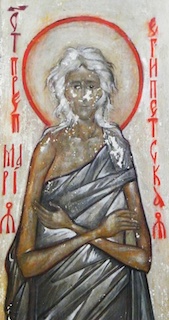
Anthony did not leave detailed instructions concerning monastic life. However, by the example of his own life, he required of his disciples to renounce earthly things, completely surrender to the will of God, and devote every day to work and prayer. People of all social strata, even the pagans, began to come to Anthony for advice and guidance. Emperor Constantine himself corresponded with him.
Being an educated man, Anthony was well aware of the problems of the world and the Church. Several times, he left the desert: he appeared in Alexandria in 311 during the persecution of the faith under Emperor Galerius to encourage his coreligionists and in 351 to support the Orthodox in their struggle against the Arians. Thus, Antony did not completely shut himself up as a recluse but instead shared his spiritual knowledge with the world. After living in the desert for more than 85 years, Anthony died peacefully at the age of 105.
Anthony the Great founded eremitic (anachoretic) monasticism. According to the order established by him, the ascetics, under the guidance of an experienced mentor, lived a solitary life in separate huts or caves. Such communities of monastics were called lavras (hence the names of the major Orthodox monasteries that have been preserved until now—the Trinity Sergius Lavra, the Kiev Pechersk Lavra, etc.). Yet even within the lifetime of Anthony, communities of a different, coenobitic (communal-based) type came into existence.
Another great ascetic, Pachomius the Great, is considered to be the founder of coenobitic monasticism.
Pachomius was born into a family of pagans in Thebes. As a soldier, he became acquainted with Christians, who made a deep impression on him. At the end of his military service at the age of 20, Pachomius was baptized. The fame of the Egyptian ascetics awakened in him the desire for a solitary’s life, and he settled in a secluded place near the Nile. He was soon joined by his brother John. Here, Pachomius conceived the idea of founding a monastic community—monastery (Greek: cenobia), where the monks would live together, spending their days in prayer and work. The rationale behind his plan included several considerations: cooperative work was much more effective, it was easier to repel robbers as a group, and people in the community could support one another in their spiritual life.
By that time, Pachomius and his virtuous life became known throughout Egypt, and many disciples joined him. Living in a single monastery soon became too crowded, and Pachomius founded several monasteries on the banks of the Nile. He also organized the first convent, where Pachomius’ sister Maria became the abbess.
Pachomius was the first to introduce a Rule (or a charter) for monastic living, subjecting it to strict regulations. Monks were obliged to spend their days in work and prayer and to read books of spiritual content. The latter circumstance would play a huge role in the preservation of the cultural heritage by monasticism. Monks were required to follow certain rules regarding clothing, food, and sleep, and they were forbidden to leave the monastery. Pachomius tried to separate the monasteries from the world by enclosing the monastic quarters with walls.
Under Pachomius, the prayer life of the monks began to follow a fixed schedule. The services were performed twice a day, and on the first and last days of the week the liturgy was celebrated, where the monks received Communion of the Holy Mysteries. The abbots of monasteries held regular conversations with their brethren on spiritual topics.
The monks tilled the land, worked in forges, mills, carpentry, and weaved baskets and mats. They were not allowed to have anything of their own; they received food and clothing from the communal assets of the monastery. Thus, Pachomius introduced into monastic life a firm principle, which in the Russian tradition received the name of nestyazhanie (non-possession).
It was not easy to follow the strict rules, and Pachomius established a year-long trial period for those who wished to join the communities. However, the longing among Christians for monastic life was so great that already during Pachomius’ lifetime the number of monks in the monasteries founded by him reached 7000 people.
Eremitic and coenobitic monasticism quickly spread throughout Egypt, and from there to other countries. A contemporary of St. Anthony, Ammon, founded a monastic community in the Nitrian mountains, a few dozen kilometers from Alexandria.
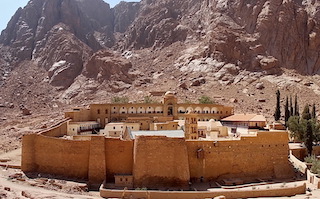
Among the Nitrian monks, Macarius of Egypt (c.300–391) became especially famous; like St. Antony, he was called “the Great.” A former shepherd, he acquired great wisdom and was the first to theoretically substantiate the spiritual advantages of the monastic lifestyle. The ideas of Macarius formed the foundation of the Christian understanding of asceticism. The works of Macarius, who shunned old-fashioned rhetoric and complicated philosophical constructions, are a wonderful example of a clear and lucid style. His prayers (”O Eternal God” and others) fully reflect the holiness of this great ascetic.
In the first half of the 4th century, the favorite disciple of St. Anthony, Hilarion, brought the monastic life to his homeland, Palestine, where he founded the first monastery near Gaza. From there, monasticism spread throughout Palestine and Syria, and in the 5th century—throughout the entire East. As we already know, Basil the Great, after becoming familiar with the life of the monks, wrote his monastic Rule, which later became widely adopted.
In addition to Egypt, monasticism reached its highest peak in Syria. It is known that already during the lifetime of Chrysostom, on the outskirts of Antioch, the hermits used to stop detachments of Theodosius’ men sent there for punitive actions.[112] The school of the disciples of John Chrysostom planted monasteries all along the Syrian coast.
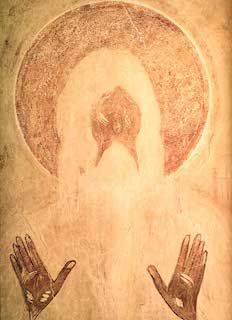
The hymns of hermits also began to sound at the spurs of Mount Sinai. The sky seemed closer in this place, where, according to tradition, Moses had conversed with God. Green oases gave shelter not only to individual settlers, but also to large communities. As the great ascetic Nilus of Sinai, who lived there for many years, wrote, “The sight of the grove and the welcoming singing of the birds and the pure breeze of the fresh wind soothe me like a rocking cradle.”[113]
It comes as no surprise that monastic asceticism in Syria differed from that of Egypt. The writings of the Syrian ascetics are more poetic, filled with love of nature and contemplation. The poems of the great ascetic Ephrem the Syrian fully express the spirit of Syrian monasticism.
Ephrem was born in Nisibis, in the territory of modern-day Turkey. His parents were apparently pagans. As a result of a false accusation, Ephrem was thrown in prison, where he received a dream from God. After that he decided to join Jacob of Nisibis—a famous solitary, missionary, and fighter for Orthodoxy—and was ordained a deacon. Perhaps, Jacob took Ephrem with him to the Council of Nicaea in 325. For many years, Ephrem led an ascetic life in the mountains and studied the Holy Scriptures. In 363, when Nisibis was captured by the Persians, Ephrem settled in Edessa, where he would teach the people and preach to the pagans. His legacy includes numerous expositions of the texts of the Holy Scriptures and other writings in addition to his prayers and hymns of amazing beauty. A highly learned theologian, he also contributed to the victory of the Church over the numerous heresies that flourished in Syria at the time. This spreading of heresies was made especially acute by Syria’s unique location at the junction of the ancient Eastern worlds and the fact that its culture had absorbed a wide variety of religious trends and beliefs.
Whereas the Egyptians sought to retreat from the world in the deserts and mountains, Ephrem chose a different and more engaged way of living. He was an ascetic who devoted most of his life to public service. During the years of severe calamities, sieges, and famines, the Syrian prophet appeared on the walls of Edessa and raised the spirit of its population with his passionate speeches. Ephrem the Syrian’s vocation and the nature of his ministry were greatly influenced by his correspondence and, later, by his personal meeting with St. Basil the Great.
Perhaps Ephrem never had to experience the agonizing internal struggle common to the anchorites. On the other hand, he fully felt the depth of depravity that had prevailed in the East. More than once, the saint was subjected to physical assault by fallen women. Yet, the purity of his soul was such that he could turn even the worst of sinners to the right path. If Anthony was a fighter against the forces of evil that tormented him in the sands of the desert, then Ephrem can be called a prophet of repentance, tirelessly calling people to turn to God. Ephrem taught that a person living in this world must, first and foremost, sober up, awaken, as it were, from a bad dream, completely reassess his life, and repent. Essentially, St. Ephrem devoted his entire life to preaching repentance—this first step on the way to the Kingdom of God.
Like the prophet Jeremiah, he would weep over the iniquities that were being committed around him. His grieving was so great that it left a profound mark on his writings: Ephrem, in essence, became the conscience of mankind before God. This is why, so many centuries later, the wondrous lines of poetry by Ephrem the Syrian continue to live in the hearts of people.
Monks of the East, having withdrawn from the sinful world, sought to cleanse their souls before God, to offer repentance on behalf of themselves and of all humanity. They led an ascetic life, filled with work and prayer, devoting much time to the study of the Holy Scriptures. Many of them, however, believed that it was not enough. In the hope of gaining spiritual insight and forgiveness from the Lord, to receive bliss in heaven, they voluntarily subjected themselves to the extreme “asceticism for the glory of God,” seeking to endure the most severe hardships and torments. Some monks practiced nearly complete abstinence from food, wearing heavy chains, giving themselves up to be eaten by midges and gnats, etc. Often such self-torture exceeded all reasonable bounds. The famous saint, the ascetic Simeon the Stylite, lived for several months buried up to his neck in the ground, and then spent more than 35 years on top of an eighteen-meter pillar—a stylite column. The monk Ammon was famous for never undressing or bathing since the beginning of his life as a hermit. And although the feelings and aspirations of these ascetics are understandable, it is unlikely that such self-mortification of the flesh is the path to Divine harmony in man—harmony that presupposes the unity of soul and body.
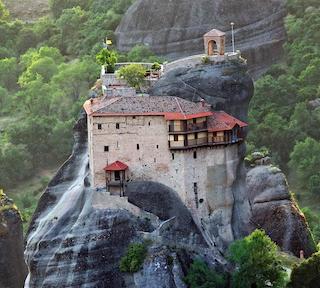
While it is true that many of the Church’s teachers, even the most eminent, welcomed this kind of extreme asceticism, it nevertheless was essentially rejected by the Church. The life of the spirit and the flesh must be brought under strict control of the will and the mind but without exceeding reasonable bounds. Otherwise, excessive asceticism can lead, as it often did, to extremely negative outcomes. The main goal of asceticism is the purification of the heart, and in order to achieve it, the ascetics would only temporarily withdraw themselves from normal living. The perversion of the ideas of asceticism, its absolutization, turned this withdrawal from life into a permanent principle. As a result, such ascetics tended to indiscriminately damn everything that was valuable either in the spiritual heritage of the past or in the secular life of their day. It is no accident that extreme asceticism was often practiced by fanatical Christians, who at times stopped at nothing, even the murder of those whom they perceived as enemies of Christ.
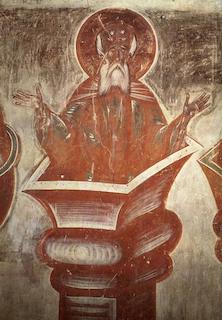
Such intolerance and fanaticism are completely alien to the true spirit of the Church. Life in Christ is possible only where it remains open to human freedom and culture. The calling of the Church is to preserve and carry through the millennia all the best things created by humanity.
Traditionally, it is believed that Athanasius of Alexandria began to spread monasticism in the West during his exile. Western monasticism would differ significantly from its Eastern counterpart, although at first its organization was based on Egyptian and Palestinian models (the life of St. Anthony, in particular, had a great influence on the West). The colder climate forced the monks to attend to their housing and winter food supplies to a much greater extent than in the East. As a result, Western monasticism began to develop along a more practical path, without the extremes of asceticism. A characteristic feature of this type of monasticism was the adoption of monastic tonsure by the clergy of various local churches. As a result, the liturgical life and ecclesiastical ministry became the centerpiece and the basis of monasteries’ life.
St. Jerome, Ambrose of Milan, and, later, St. Augustine were all instrumental to the spread of monasticism in the West. However, it was John Cassian who develop the first Rule of monastic life in the West.
John, a Scythian by birth, became a monk at a very young age. First, he settled in Bethlehem, and later he was trained by the Egyptian hermits. About 399, John moved to Constantinople, where he became a disciple of John Chrysostom. Already ordained a deacon, John was sent to Rome by the clergy of Constantinople. His task was to ask Pope Innocent I to intercede on behalf of Chrysostom, who was persecuted at the time. John was ordained a priest in Rome. In 415, he founded the monastery of St. Victor in Marseilles, where he remained the abbot until his death.
Knowing well the rules of monastic life of the East, John Cassian realized the need to rework them to better adapt to the peculiarities of Western religious life. In 417–429, he wrote his main work, in which he analyzed and systematized in detail both the spiritual and practical tasks of monasticism: the organization of the prayer life, the daily order of the monastic community, requirements for food and clothing for monks. The “Institutes,” as they were called, along with the rules of Basil the Great and St. Pachomius, would remain in effect until the 9th century.
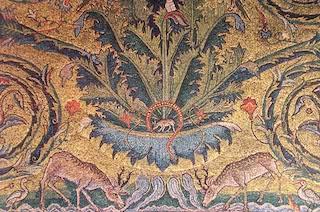
As in the East, John Cassian allowed for the existence of two types of monasticism: anachoretic (eremitic) and coenobitic (communal). In fact, however, only the second type—that of a monastery—gained acceptance in the West. Thus, the first monks in Italy and Gaul did not seek to completely withdraw from the world, but they attached great importance to the evangelization of the pagan population and tried to exemplify the Christian life in the midst of a depraved world. Besides John Cassian, another outstanding contribution to the formation and organization of monastic life was made by St. Martin of Tours.
Martin of Tours was born into a pagan family. While serving in the army, he saw a vision of Christ. Soon, he was baptized and then began to lead a monastic life. In 370, he founded the first monastery in Gaul. In 372, Martin became bishop of the city of Tours, but soon after that he returned to monastic life along with his disciples. Through his efforts, monasticism spread throughout Gaul. Thanks to the active evangelization carried out by Martin and his disciples, a diocesan system of parishes was created, which proved to be very effective, especially in rural areas.
In addition to strengthening monasticism, Martin devoted much of his time and energy to the fight against heretical movements, while demonstrating humaneness and tolerance. Thus, when the emperor had broken his promise to Martin not to execute Bishop Priscillian, accused of heresy, Martin broke off all relations with the Spanish bishops until he received new assurances that there would be no further acts of persecution.
Being extremely popular among the people, Martin of Tours is revered as the patron saint of France.
Christ taught, “Take My yoke upon you” (Mt 11:29). A person must perfect the work of his or her own salvation. Monastic asceticism undertook this great and noble task by providing guidance in this process. It contributed to the realization of the central concept behind the Church—the idea of the Kingdom of God. Achieving the true knowledge of God, at times, by superhuman efforts, the monks carried out their mission to the world. This was a great feat on the path to human regeneration—a feat that required great sacrifices and the renunciation of many earthly pleasures. Such renunciation was necessary for monastics as servants to humanity and agents of the Holy Spirit. Occasionally, monasticism took unreasonably extreme forms, leading to serious consequences that had nothing to do with Christianity. Yet in its spirit and historical significance, monasticism became a great transformative force. It created pockets of deep and passionate faith that would nourish the Church for centuries.
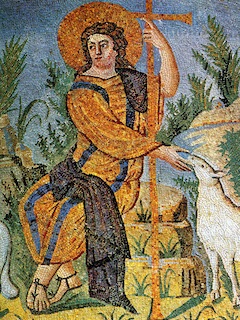
We already know that many of the great Fathers and teachers of the Church received a classical education and were well-versed in Hellenistic literature. The Church assimilated and absorbed the ancient culture and the centuries-old values accrued by different peoples. The result was that she brought a new, Christian, culture into the world. From the very beginning, it combined elements of the cultures of the West and the East. The religious poetry of Israel, Platonic idealism, and Alexandrian philology, all found a place in it.
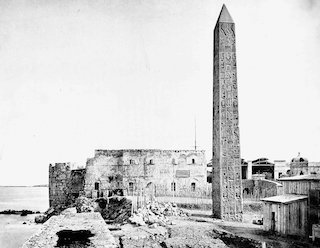
Yet Christian culture was not a mere conglomerate of earlier cultures—nor could it be. Pagan religions, Greek philosophy, and the societal ideals of classical antiquity could no longer satisfy the spiritual needs of the multi-lingual and multi-faceted ecumene. The rapid spread of the new faith, the invasion of barbarians, the approaching collapse of the empire created a sense of instability, turned people away from their familiar statues of pagan gods, forced them to abandon their accepted notions of beauty. The inextricable connection of classical culture with pagan cults was instinctively felt by both pagans and Christians. Therefore, the growing Church, and above all her monastic wing, used to reject the legacy of Antiquity. In doing so, the zeal of some Christians, especially the uneducated and fanatical ones, went too far: beautiful statues and works of art were destroyed, the most educated pagans—scholars and poets—were expelled and even deprived of their lives.
However, the pagan world and its culture—especially the Hellenistic culture, which had long acquired an intrinsic value—could not be destroyed. The religious reform of Constantine did not result in the demise of paganism, which only went on the defensive and would experience a short upsurge again under Emperor Julian the Apostate. The last champions of paganism were sometimes no less firm in their convictions than the Christians. Their persuasion stemmed from the glory and grandeur of ancient Rome, their ancestral pride, and the high level of classical education that was traditional for the pagan aristocracy.
It is important to note that despite the victory by Christianity, the entire educational system remained essentially pagan. In the face of the general decline of culture in the West, intensified by the invasion of barbarians, enlightened pagans and Christians became concerned with maintaining the prior level of education. School became the link between the Greco-Roman culture and the new Christian society. A similar situation developed in the East. Byzantium inherited classical education from the Greco-Roman world. Until the 7th century, there flourished higher educational institutions modelled after antiquity, where rhetoric, Latin grammar, and philosophy had been taught.
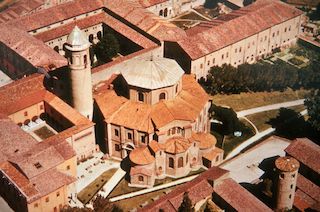
On her part, the Church could not exclude from her sphere of influence those vast areas of life, where the spirit of classical antiquity had not yet faded. Through her efforts, the beautiful artistic, philosophical, literary, and musical forms of Hellenistic culture were being imbued with new content.
Paganism, which was being gradually conquered, penetrated into the spheres of the nascent Christian theology, philosophy, and liturgical practice. Thus, at the junction of the two eras, in a struggle fraught with great achievements and irretrievable losses, the Christian culture was being born.
During the period of persecution, the early Christians held divine services in secluded places, catacombs, and private houses. Over time, when it became possible to practice their faith openly, services began to be held in basilicas, or public meeting spaces, which had previously belonged to wealthy members of the community. Starting from the 4th century, new Christian church structures began to appear. The first to erect Christian temples, according to tradition, were Constantine the Great and his mother Helena. They built many churches in the Holy Land, and later in Constantinople.
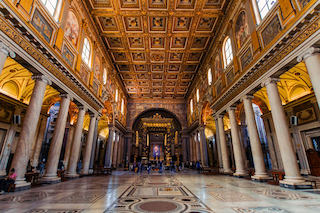
The original basilicas served as an architectural framework for the new churches being built. They were elongated rectangles with two open ship-like galleries (naves) on each side. The naves were flanked by a row of slender columns. There were also rooms for private prayer. After the model of the Jerusalem Temple, the altar space was positioned in the front (eastern) part of the basilica, with an arch rising in front of it. The recess behind the altar (apse) was either open or covered with a curtain. The central part of the church was occupied by the nave, where those who had been baptized worshipped during the service. The western part (portico) was intended for catechumens, that is, those who were preparing to receive the sacrament of baptism. The basilica would be topped by a roof consisting of the usual flat slopes. Most often, the shape of such basilicas was cruciform.
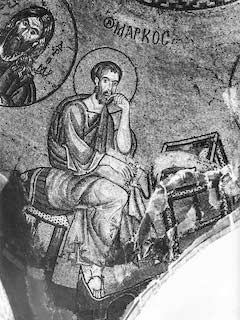
In addition to the oblong, elongated shape, another type of round-shaped temple—the rotunda, with a vaulted ceiling and a dome on top—became established early on in Christian architecture. This form of the temple also came from Antiquity; most often it was used for baptisteries and memorial churches built on the graves of Christian saints. Over time, the shape of the round temple became dominant in the East, while the form of the basilica remained prevalent in the West.
The earliest Christian depictions are the wall paintings in the Roman catacombs. The young Christian art breathed a passionate fire of faith, but it had not yet developed its own style. Often on the walls, one could see images from both ancient classical and Christian themes, where Old Testament and Gospel saints would appear next to Orpheus and Eros. Frequently, the new Christian message was conveyed by the familiar pagan imagery: Orpheus symbolized Christ, Cupid and Psyche appeared as symbols of the immortality of the soul. The motif of the shepherd from the classical world morphed into the scene of “The Good Shepherd”—Christ tending His flock—full of deep Christian meaning.
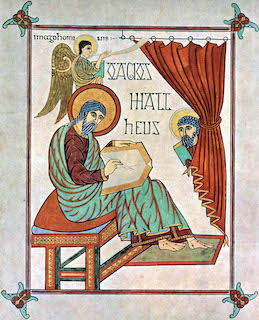
In addition to different compositions, paintings also depicted individual objects of a symbolic nature, full of allusions and intricate associations: the vine signifies the blood of Christ, and baskets with fruits symbolize the eternity of spiritual life. The most popular symbol of early Christian art is the fish—the letters of the corresponding Greek word ichthys are given by the first letters of the words “Jesus Christ, Son of God, Savior.” The bird symbolizes the immortal soul, and the wreath represents Christ’s victory over death. The symbolic images were arranged to form the decorative patterns of the walls and ceilings of the catacombs and later the churches.
In absorbing and reworking traditions of classical antiquity, the Christian Church was at the same time departing from the Jewish ideas about art. Why did Israel so vehemently deny any possibility of depicting God? For the Old Testament, such images were too realistic, comprehensive, and earthly in their nature: there was no room for the ineffable and the transcendent in them—and any image of the kind was perceived as a pagan idol. On the other hand, visual art becomes an integral part of Christianity as a religion of God-Manhood, which teaches about God incarnate in the world.
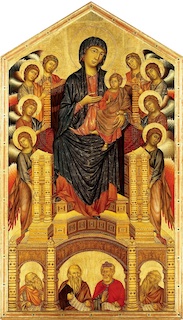
The challenge for Christian art, similar to the process of writing the Gospels, was how to adequately reflect the heavenly with earthly forms of expression without detracting from its divine archetype. Realistic images, as beautiful as they could be, were unable to convey the Divine essence, which set off a search for novel forms of expression in Christian art.
Pictorial compositions began to simplify, their style grew rougher, but they acquired greater expressiveness. At the same time, both due to the uniqueness of the cultural traditions of the West and the East, and as a result of the increasing isolation of the Western and Eastern empires, differences began to appear in their visual art.
Ancient classical culture was deeply rooted in the countries of Western Europe and the Mediterranean. New Christian art was built on the same classical paradigms, with their characteristic multi-figured scenes and elaborate composition. In the East, in the countries of Asia Minor, where the ancient classical tradition took little root, the temples were mostly devoid of sculptural images—the decoration of the temples consisted of crosses, ornaments, images of animals portrayed using the style of folk traditions of the area. The great art of Byzantium was born at the junction of these two cultures: preserving the late Hellenistic traditions and incorporating elements of the art of Egypt, Syria, and Iran. The main form of early Byzantine art is large-scale church compositions (mosaics and frescoes). Small multicolored squares of smalto that make up the mosaics were laid out at a particular angle, so that they, shimmering softly in reflecting light, would create a solemn and exquisite color scheme. The artistic images in mosaics and frescoes depart from the principle of “realistic resemblance” and are instead “spiritualized.” The classical body proportions are gradually violated: the eyes appear motionless and excessively enlarged; the faces become elongated. The depictions on the frescoes become more “flattened,” the contrast of colors and the schematic nature of the image increase, the perspective is shifted. These changes, not yet conspicuous, had already formed a solid foundation for the birth of a completely new form of visual art of icon painting.
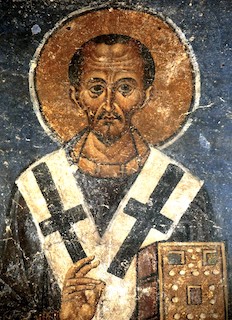
Sculpture undergoes similar changes. When depicting human figures, especially Christ and the Evangelists, young Christian art used to employ traditional forms of plastic art: a chest statue or portrait bust of Antiquity. The Gospel characters and scenes are rendered, as in the early mosaics, in the classical spirit: Christ and the apostles look like antiquity heroes with their comely and serene faces. However, over time, the reliefs become more flat and conditional: the figures give way to symbolic images of the vine, fish, etc. Subsequently, large-scale sculpture gradually ceases to interest Byzantine masters, who were especially wary of its “idolatrous” nature. Plastic art in the East continues to develop mainly in its small forms—applied art and jewelry.
Music very early began to play an important part in the life of the Church, especially in divine services. And this is not accidental—the language of sounds sometimes can express much more than words. Music has the power to appeal to the hidden recesses and strings of the soul bypassing the mind, which is often feeble.
The music of the final centuries of the Roman Empire was closely associated with pagan cults. It was an integral part of the same culture that Christianity tried to abandon. Therefore, the Church was looking for new musical forms. The development of Western Christian music culture was different from that of the East. Religious or temple music in the West had always been distinct from secular music, whereas in Byzantium there was no such clear distinction. In the East, Christian singing could be heard not only in churches, but also in public squares, ceremonial receptions, and even at the hippodrome. Church music, enriched by secular musical motifs and genres, permeated the daily life of the Byzantines.
Almost all researchers of early Christian culture agree that the early Church borrowed its musical forms from the Jewish synagogue service. This is not surprising if we recall that the Church tried to abandon pagan musical forms and that the first Christian communities were formed in the Jewish setting. A special type of recitative was developed in synagogue for the public reading of passages from the Holy Scriptures—a combination of the actual reading aloud with a drawn-out chanting recitation. This manner of reading the Psalms was called psalmody. Since the Psalter remained the most popular Old Testament book in Christian worship, the techniques of psalmody naturally took root in the church singing of early Christians. The Church also assimilated from synagogue the practice of singing alleluias for the opening and closing parts of the prayer. Similar to synagogue service, both the soloist and the congregation took part in church chanting.
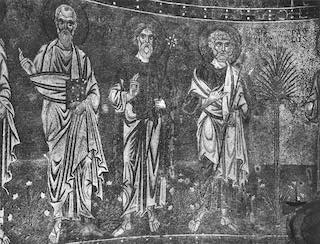
The entire community of many ancient churches would be singing during their services. However, special groups of singers, choirs, began to emerge over time. The accepted practice by the early Church of alternating singing between the two choirs (antiphonal singing) became another important element borrowed from synagogue. Still, the exact history of how antiphonal singing became adopted and even the meaning of the word antiphon as understood by the early Christians are not entirely known. According to church tradition, antiphonal singing in the West was introduced into divine services by Ambrose of Milan, and in the Greek Church—by John Chrysostom, although here, too, the historical sources are contradictory. At first, church singing was simple, more recitative, but over time, their melodies became more complex. As in the synagogue service, singing was not accompanied by playing musical instruments (the tradition of exclusively vocal church music became permanent in the Orthodox Church). Women participated in chanting during the first centuries of Christianity, but this tradition, too, became adopted only in the Eastern Church. From the 6th to the beginning of the 20th century, choirs in the Roman Catholic Church were composed exclusively of men and boys.
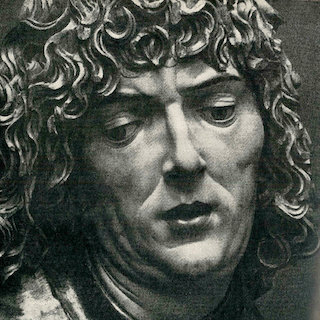
The struggle of the Church against heresies, in particular Arianism, played a significant role in the formation of Christian musical culture. Realizing the importance of music for the perception of religious ideas, many heretics chose to compose hymns to promote their doctrine. To combat this problem, music texts reflecting Orthodox theology were composed by such great Christian saints as Basil the Great, Gregory of Nazianzus, and numerous others. John Chrysostom played a leading role in systematizing the structure of the divine services and, accordingly, their musical organization. Tradition attributes to him the introduction into liturgical practice of akathists (hymns of praise sung by standing worshippers) and troparia (hymns whose content is associated with a particular feast or event of the day). We already know how significant the poetic creations of Ephrem the Syrian were during that period. According to tradition, he composed over 10,000 hymns.
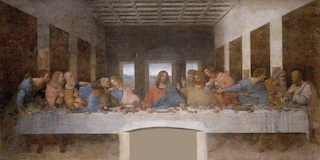
In addition to synagogue worship practices, early church music was also greatly influenced by the musical heritage of classical antiquity. Some genres of secular music found their place in church worship, especially in the East. Musicology began to play a prominent role in the culture of Christianity. For example, early Byzantine works in that area were based entirely on the tenets of classical Greek music theory. Even those among the early Church Fathers who strongly opposed pagan art (such as Clement of Alexandria) unconditionally recognized the authority of Aristotle in musicology. Thus, at the junction of Jewish and classical cultures, Christian musical art was formed, which would give the world the works of amazing spiritual depth and beauty.
All forms of Christian art find their complete and harmonious expression in church worship. Church architecture, music, poetry, and the vestments of the clergy are all dedicated to a single goal—giving glory to the Lord.
In the pre-New Testament era, prayer meals at places other than the Temple became widespread among Jews, which were accompanied by Bible readings and conversations about the faith. The centerpiece of such meals was the blessing of bread and wine, as well as a prayer of thanks. Similar meals, called agape (the feasts of love), were also adopted by the early Christians. Their meals, however, had a pronounced Christological character from the outset: the faithful would partake of bread and wine, remembering the Last Supper, and recite a prayer of thanks, dedicated to the redemptive work of Christ.
Agape meals formed the basis of the early Christian liturgy, the central elements of which have not changed to this day. The Liturgy is the main Christian service, usually held on Sundays. The service is divided into two parts: the liturgy of the catechumens, which is open to all, and the solemn liturgy of the faithful, which is closed to all except the faithful. In addition to the Eucharist, the liturgy consists of Bible readings, psalms, a sermon, prayers of supplication, and a dismissal. At the end of the liturgy of the catechumens, all those who were not permitted to attend the second part, in particular the unbaptized, had to leave the house of worship (to this day, the two parts of the liturgy are symbolically separated by an ancient exclamation, “The doors, the doors!” addressed to the catechumens, although already in the 6th century, these two parts of the liturgy ceased to be divided). The central part of the liturgy of the faithful is the Eucharist—the sacrament of the preparation and consecration of the sacrificial meal, when bread and wine under the influence of the Holy Spirit are transformed into the Holy Mysteries—the Body and Blood of Christ. At the end of the Eucharist, the faithful partake of the Holy Mysteries. Now, as in the past, the Eucharist serves as a reminder of the sacrifice of Christ on the cross, uniting Christians into one Body of Christ, the Church.
In essence, the structure and core content of the Christian liturgy were the same for all early churches, although the rituals themselves and specific prayers could differ. The order of the Eucharistic prayers may have been first established by St. Gregory Thaumaturgus. Another ancient rite (order) of the liturgy with an explanation of its meaning was left to us by St. Cyril of Jerusalem. In the West, the Roman liturgy became dominant. The Milanese liturgy, which tradition ascribes to St. Ambrose, is close to the eastern ones—of Jerusalem, Antioch, and others. Among the rather numerous liturgies in the East, predominantly two Constantinople versions survived to the present day: of St. John Chrysostom and of St. Basil the Great (the liturgy of John Chrysostom is a shortened and slightly modified version of the liturgy of Basil the Great).
The Eucharist is one of the most important Christian sacraments or mysteries. In different epochs, a different number of Christian rituals would be categorized as such sacred rites. However, already at the early stage of the Church’s existence, there were seven rituals, which over time (by the 13th century in the West, and later in the East) received the status of sacraments or mysteries in the Church. In addition to the Eucharist, the holy mysteries include:
baptism is a sign of a person’s entry into the Church. It is usually carried out after a long (about a year) period of preparation;
matrimony is the consecration of conjugal love and family life by the Church;
repentance is a reconciliation of the sinner with God through confession and remission of sins;
chrismation is anointing with oil as a sign of the descent of the Spirit of God on a new member of the Church;
ordination is the laying on of hands on a Christian who is consecrated to the priestly or episcopal rank, thereby realizing the continuity of the church ministry, which goes back to the apostles of Christ;
unction is the anointing of the sick with oil as a sign of sanctification of their body and soul.
Participation in the holy mysteries was, and still is, the foundation of a Christian’s life, consecrating and filling it with spiritual strength.
In his address to Christian youth, St. Basil the Great encouraged them to study classical poetry and science, but to do so critically. The saint and in his person the entire Church define Christianity’s attitude to the pagan literature as following: the criterion for determining the value of the old cultural heritage to a Christian should be based on how well it agrees with the fundamental Christian principles. “Remember,” writes Basil, “that in culling roses we avoid the thorns.”[114] Reflecting on the great ancient Greek poet Homer, Basil notes that, while calling for virtue, the poet actually substituted true inner nobility with external beauty. He finds a similar inconsistency in Euripides. Basil the Great sees the root cause for this in the fact that Greek ethics did not have a proper grounding, not being founded on the principal moral categories that stem from the belief in One God.
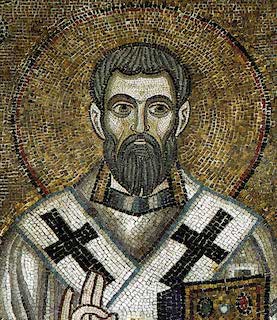
According to Basil the Great, only few Greek philosophers were able to lay a proper groundwork for the true teaching on morality. In this respect, the saint especially points out Plato and Diogenes, saying that these two Greek philosophers even succeeded in providing a theoretical basis for asceticism, which, however, they understood within the confines of the Hellenic spirit.
A brilliant connoisseur of classical culture, Basil the Great deduced from its philosophical achievements the propositions of the nascent Christian philosophy. In his homilies on the creation of the world, called the “Hexaemeron,” he points out the limitations of the Greek ancient thought, which deduced the origin of matter from matter itself (this is what Thales and Anaxagoras taught).
At the heart of existence, says Basil the Great, is the Will of God. Matter is not eternal; only the Absolute Existence, God, can be eternal.
A great man of prayer and an author of the liturgy, a teacher of morality and a deep thinker and theologian, a solitary and a bishop, Basil the Great showed a keen interest in the issues of the study of nature, paying considerable attention to them. The descriptions of the plant and animal world in his works attest to his encyclopedic knowledge of the natural sciences. Some of the questions he raised, e.g., related to the realm of biology, still have not been answered by science. From the example of Basil the Great, we can see that the Church was not merely inclined to think about the world and nature in purely poetic terms, but also encouraged their study as an important element in shaping the Christian worldview.
Another representative of the Church who played an important role in the development of Christian philosophy and theology was Basil’s brother, Gregory of Nyssa.
Gregory, who was born in Cappadocia, in the city of Caesarea, was Basil’s younger brother. He used to refer to Basil and his sister Macrina as his mentors. Having received a good classical education, he taught rhetoric in Athens. Eventually, under the influence of Gregory Nazianzen, he decided to devote himself to the Christian ministry. At the request of Basil, Gregory served as a priest in his diocese of Cappadocia, and later was ordained a bishop, taking up the vacant see of Nyssa in 371. He actively opposed the Arians, which resulted in his removal from his bishopric by Emperor Valens. In 378, he was able to resume his episcopal ministry and helped to establish churches in Palestine and Arabia. During that time, he continued to affirm Orthodox theological views: it is known that at the Council of Constantinople in 381, Gregory defended the Nicene Creed against Apollinaris of Laodicea, who was insisting on incompleteness of Christ’s human nature.
The accomplishments of Gregory of Nyssa as a public and ecclesiastical figure can hardly be regarded as particularly outstanding. In this, he was eclipsed by his brother. On the other hand, being a brilliant philosopher and theologian, Gregory of Nyssa made a truly remarkable contribution to the development of Christian thought. He expanded the Church’s teachings on the resurrection, Divine grace, and the Names of God. His Christological developments and his exposition of the doctrine of the Trinity are truly profound. He wrote on the topics of asceticism and mystical union with God. Like his brother, Gregory paid great attention to the metaphysical questions about the structure of the world and the creation of the Universe by God. The world, according to his views, is sentient, and man is an embodiment of reason in nature. Human thoughts and mind become incarnate in words, the archetype of which is the Logos—the Word of God. The world is being created by the will of the Logos.
Speaking of evil and its origins, Gregory refuses to afford it with its own intrinsic ontological status. Evil appears where good is absent. At the same time, evil is not simply a denial of good but is born inside a person. Yet God is the only Creator of all things. How, then, could God have participated in the emergence of evil in human nature? According to Gregory, “The only thing which is essentially degraded is moral evil… whereas the orderly process of Nature, arranged as it has been by the Divine will and law, is beyond the reach of any misrepresentation on the score of wickedness.”[115] It all comes down to the conflict between the flesh and the spirit of man. Only the spirit can comprehend Divine Love, whereas the body is limited. That’s why the salvation of man could only be accomplished by Christ, who united in Himself the Divinity and Manhood, the flesh and the Spirit.
Gregory of Nyssa, Basil the Great, and Gregory of Nazianzus are the three great figures of the Church, collectively known as the “Cappadocian Fathers” in the Christian tradition. They laid the foundations of the theology of the Eastern Church, being at the same time the illustrious exponents of the ideas of one of the two theological schools of that time, namely, the Alexandrian school.
The teachers of this school had Hellenistic Jewish theologians, philosophers, and writers of Alexandria—the largest center of the Jewish Diaspora—as their predecessors. The Jewish philosopher Aristobulus (2nd century BC)—one of the early representatives of this trend—adopted, along with his followers, the allegorical method of interpreting ancient texts, first developed by the Greek philosophers. The most prolific and influential Jewish theologian of the Alexandrian school was Philo of Alexandria, who lived in the 1st century.
The Christian school of Alexandria grew out of the catechetical school of Alexandria, which was headed by the outstanding theologian Clement of Alexandria (c.150–215). In his apologetic writings, Clement became the first to justify the practice of assimilation of the elements of classical culture, in particular philosophy, by Christianity. His successor, Origen, who would later be regarded as a teacher of the Church, became another leading figure of the Alexandrian school. His legacy in the areas of theology and biblical philology proved invaluable to Christianity. He applied the allegorical method of biblical interpretation with exceptional consistency. Although the Church later condemned some of Origen’s views, his influence on the theologians of the ancient Church was enormous. Not only the “Cappadocian Fathers” were among his followers; the great Western theologians St. Ambrose of Milan, St. Augustine, and St. Jerome, too, greatly benefited from his work. Yet it was Cyril of Alexandria (c.376–444) who became the most prominent representative of Alexandrian theology.
The representatives of the Alexandrian school insistently emphasized the unity of the person of Christ, the inseparability in Him of the two natures, the Divine and the human. At the same time, the Alexandrian theologians did not mix up the two natures in Christ. For Cyril of Alexandria, the God Logos, the pre-existing Jesus Christ, remained unchanged after His incarnation. He assumed human nature to Himself without altering His Godhead.
The understanding of this problem was made difficult by the fact that the theological language of Christianity had not yet been sufficiently developed. In addition, the complexity of the question itself about the union of the two natures in the God-Man prevented a straightforward yet precise formulation. Still, the desire of the Alexandrian theologians to affirm the unity of the personhood of Christ sometimes led to obscuring the differences between the three persons, or hypostases, of the One God—the Father, the Son, and the Holy Spirit. The credit for the development of the doctrine of the Trinity, as, first of all, of the three hypostases of the Godhead without mixing, goes primarily to the theologians of the Antiochian school.
The Antiochian school emerged somewhat later than the Alexandrian school. In contrast to the latter, the theologians of the Antiochian school insisted on a literal and historical interpretation of the Holy Scriptures. As for the doctrine of the Trinity, the peculiarities of the exposition of dogmas by the Antiochians can be illustrated by the example of the “Catechetical Lectures” by Cyril of Jerusalem (c.315–386), one of the early writers of this school.
Cyril based his views on the Nicene Creed and expounded Christian dogma clearly, vividly, and simply. He knew the Scriptures well but did not overuse their quotations.
God, according to Cyril, is in all things, but at the same time, being the Creator, He is outside the world. In order to save people, God came to be incarnate in Christ, becoming a real, complete, and perfect Man. God saved the world and will judge it at the end of time. However, the forces of the Antichrist are present in the world, and these forces will fight against the Kingdom of God until the end of history, when they will suffer a final defeat.
Other representatives of the Antiochian school include Diodorus of Tarsus, Theodoret of Cyrus, and Theodore of Mopsuestia. All of them believed in the fullness of Christ’s humanity, placing a special emphasis on the illegitimacy of mixing up His two natures. The theology of Clement of Alexandria, who stressed the inseparability of the Divine and human natures in Christ, was sometimes met with doubt among the theologians of Antioch. They saw in Clement’s ideas an attempt to obscure the humanity of Christ. The Antiochians, in turn, would be accused of belittling the Divine nature of the Savior, attempting to portray Him only as a man.
In this manner, through the joint efforts by the Alexandrian, Antiochian, and other schools, amidst the heated debates of great theologians, the early Patristic period—the “golden age” of Christian theology—was drawing to a close. It would fall to St. Augustine in the West and the Christological Councils in the East to draw some conclusions about that period and outline new theological developments.
The Roman Empire was on the brink of destruction. The Emperor Theodosius managed to delay the onslaught of the barbarians but by a short time. Following his death in 395 and the final division of the empire into the Western and Eastern parts, all further resistance to the barbarians became futile. The rulers of Rome, sensing the growing power of the peoples under their control, began to look to them for support. The Germans and the Gauls made up the bulk of the army. Yet it was not so much an external invasion that threatened a collapse of the once-mighty empire but, rather, the premonition of an internal catastrophe.
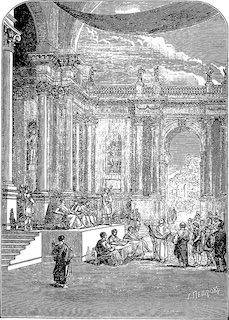
“As for the way of life among the Goths and Vandals,” the presbyter Salvian of Marseille wrote in the 5th century, “in what single respect can we consider ourselves superior to them or even worthy of comparison?”[116] Already, John Chrysostom noticed the dark clouds hanging over the Eternal City, which were ripe to burst into a thunderstorm. According to the unanimous testimony of contemporaries, the spiritual level of the empire’s inhabitants was extremely low. Mass atheism went hand in hand with wild superstitions. Whereas the new Christian art was still in its infancy, the classical art was rapidly degenerating, taking on, for the most part, the most primitive and tasteless forms.
Rome’s streets were occupied by thousands of idlers who lived off free handouts or spend their entire days at circus games. The crowd’s increasing thirst for bloody spectacles bespoke a complete cultural collapse and the growing savagery among the population. Thus, one day, the crowd lynched a monk who tried to stop a brutal gladiator fight.70
The army was in decline as the Romans used to ignore military conscription. Peasants and even slaves began to be recruited, which in turn led to a drop in agricultural production.
Alaric’s troops stormed and took Rome in 410: for the first time in centuries, foreigners entered the Eternal City as conquerors. The fall of the mighty empire was caused by economic, social, and cultural factors. The world was entering a new phase of its development—feudalism, and there was not a sphere of life that would not undergo a drastic dismantling. Having seized vast territories and enslaved the peoples who inhabited them, the empire became a hostage of its own might. The Roman Empire was an example of the most ambitious and ultimately unsuccessful attempt to unite people of different cultures and religious beliefs. Rome sought to achieve unity by adopting a common religion, Christianity, which was supposed to equalize the nations and unite all in Christ. However, this hope did not come to fruition: Rome proved to be unprepared for true Christianity, having embraced it only outwardly. The spirit of the true Church did not imbue the majority of Roman leaders either, who remained captive to their old habits and ideas.
And yet the seeds of Christian culture already sprouted, and this gave the pagans a reason to accuse the Church and blame Christianity for expediting the destruction of Rome. The general decline in the country, which had recently become Christian, too, caused only bitterness and bewilderment among the Christians of the West. They were seized by doubt about the correctness of their path. St. Jerome wept when the news of the city’s demise reached him; many saw in the catastrophe the retribution of history, the smiting hand of God. It was only in 426 that the famous book “The City of God” came out, written by the bishop of Hippo, Augustine, which explained the tragic events to the Christian world.
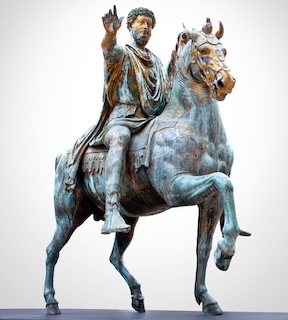
St. Augustine is one of the most significant figures in the history of Christianity. He was exactly the type of person of whom they say, “the soul of the age.” He left an indelible mark on all further development of the culture and the Church, both in the West and in the East. The path that led him to Christ was both unique and worthwhile. Possessing the enormous talents of a writer and a psychologist, Augustine was able to analyze his spiritual quest, reflecting it in his immortal works that would become masterpieces of world literature. Among his writings, “The Confessions” stands out, in which the great teacher of the Church tells of his life’s journey and vocation.
The son of a pagan father and a Christian mother, Augustine was born in Thagaste (modern Algeria) and received a good education. As a young man, he went to the capital of North Africa, Carthage, where he indulged himself in social life. Soon, however, this life bored him, and Augustine began to think more and more about the meaning of human existence. Gradually, his unconscious desires developed into a quest for happiness and harmony (he was especially influenced by the books of Cicero). Augustine came to the conclusion that only true wisdom, or, more exactly, philosophy, could give a person real happiness.
In his spiritual quest, Augustine also tried to turn to the Bible. However, in the beginning, he did not succeed on that path of learning. He studied the Bible in a circle of Manichaeans—followers of a very influential religious teaching of that period, a mixture of Iranian Zoroastrianism with Christianity and Eastern cults. A key feature of Manichaeism was its dualism—the belief in two higher powers that rule the world, eternally opposing one another. To the Manichaeans, the God of the Old Testament was the evil power, and the God of the New Testament was the good power. In addition, Manichaeism saw true reality only in the material phenomena of nature, spiritualizing the sun, moon, planets, and plants. Essentially, devoid of genuine philosophical roots, it was most often reduced to crude materialism. It is not surprising that, after adopting this notion for a period of time, Augustine soon grew disillusioned with it: “But I, thinking of [material] things, very much ensnared and in a measure stifled, was oppressed by those masses; panting under which for the breath of Your Truth, I was not able to breathe it pure and undefiled.”[117]
As a teacher, Augustine soon moved from Carthage to Rome and, in 384, to Milan. A decisive transformation took place in his life during that period.
Struck by the sermons of Ambrose of Milan, Augustine began to realize the gulf that lay between Manichaeism and Christianity. However, he did not see sufficient reasons for him to accept the Church’s teaching on the Incarnation. Only after he became acquainted with the teachings of Aristotle, Plato, and the Neoplatonic philosophers was he able to realize the vastness of immaterial existence, in which the Divine mystery was being revealed. The real revelation for him, however, was his reading of the epistles of the Apostle Paul: Augustine could sense how the Grace of God was attracting him, and how he was stubbornly resisting it. Gradually God, whom his heart had been yearning for so long, became real to him again.
However, giving up his old habits proved to be difficult. Praying for his salvation, Augustine secretly hoped that he would not be heard. Only following a severe inner struggle was Augustine able to make up his mind. In 387, he was baptized by St. Ambrose, a year later, he became a monk, and, two years later, he was ordained a priest. Thus, the Church of Christ received a thinker who would play a prominent role in her history.
Augustine distinguished himself in different areas. In 396, he took the episcopal see of Hippo, where he remained until his death. Augustine founded the first monastery in Latinized Africa and actively preached Christianity. He combined church ministry with literary work.
Augustine’s legacy consists of more than 100 writings. Among them are polemical works directed against the heresies that were literally tearing the Church apart, primarily Manichaeism, Donatism, and Pelagianism, as well as stubbornly tenacious Roman paganism. There are writings on the exegesis of Holy Scripture, dogmatics, historiosophy, and Christian ethics. About 400 of his sermons, numerous letters, and autobiographical works have also been preserved. There is practically no sphere of Christian life that was not profoundly influenced by the ideas of Augustine. Nevertheless, many researchers consider Augustine’s teaching about the Church to be his most original and valuable contribution. Following the capture of Rome by Alaric, this teaching found its full realization in the book “The City of God.” Amidst the general chaos, despair, and confusion, Augustine’s words resounded as a voice of hope. He decisively rejected and derided the pagan view that Christianity helped to destroy Rome; indeed, the world had known social upheavals long before Christ.
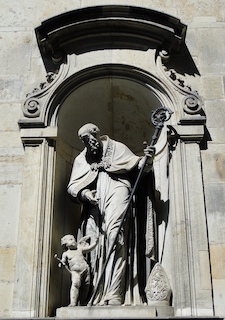
According to Augustine, the fall of Rome once again had to demonstrate that the “Earthly City” and everything connected with it is transitory. Only the City of God cannot be destroyed. What is this City of God? It is a universal coming together in Christ—the Kingdom of Heaven, proclaimed by the Savior. It has a twofold meaning: as an ideal Kingdom of the Spirit, and as the ultimate goal of history. Since ancient times, the history of mankind has been one of a struggle between the two cities. The human city is full of self-love; it is the city of civilization and everything earthly; the City of God lives entirely in the light of Truth. In a dramatic struggle, the City of God overcomes the limitations of the Earthly City. The Church, an embodiment of the City of God, sojourns on the earth, transfiguring it, sanctifying the Earthly City.
Augustine believes that any dream of the Church as a complete, ideal Christian society will essentially remain a dream. The formation of the City is an actual process, whose goal is to prepare for the future Kingdom. The fullness of existence can only be achieved once people become free from the shackles of their fallen human nature. In the time of general despair, Augustine showed that, with the coming of Christ, history did not end, but, instead, a new era began. Thus, he gave hope to the Christians of the West, while at the same time pointing out to the Church her great task.
Augustine died in 430. The Church was going through a deep crisis that coincided with the final historical phase of antiquity—the crisis during which the main doctrinal positions of the Church were consolidated and formulated at the III and IV Ecumenical Councils. The forms of church life in the East and West also took their shape during this period.
This period in the life of the Church is marked by a close relationship that existed between the sociopolitical and religious spheres. In the critical moment of the barbarian invasion, the Church, according to Ambrose of Milan, “stands immovable amid all the seas of the world…. The waves lash but do not shake [her].”[118] To maintain such steadfastness in the face of the collapse of the empire, the church organization had to become a coherent, tightly centralized hierarchical structure. The framework of the Roman imperial government served as a model for such centralization.
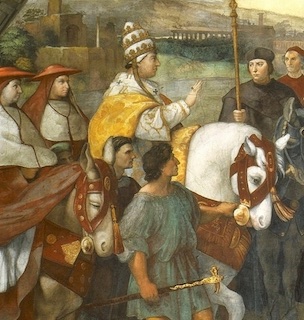
During the reign of the rather weak-willed Emperor Theodosius II the Calligrapher, the Byzantine state was in actuality run by his sister Pulcheria, an energetic, intelligent, and deeply religious woman. Pulcheria saw her main support in the Church, which needed a devoted and strong-willed hierarch as its head. Nestorius, who she thought met those requirements, took over the patriarchal see of Byzantium in 428. He was one of the most learned men of his time, decisive and eloquent. As a new patriarch of Constantinople, he dreamed of elevating his bishopric to the level of the Roman see.
Soon, however, the figure of Nestorius became the cause of heated dogmatic debates. As a student of the Antiochian school, Nestorius said that the Blessed Virgin Mary could not be rightfully called the Theotokos (“God-bearer”). He argued that Mary, as a human being, could not have possibly given birth to God, and therefore it was unacceptable to refer to Mary that way. Nevertheless, the term “Theotokos” was already quite popular among the people. It also received support from the traditional rivals of the Antiochian school—the Alexandrian theologians, and, above all, Cyril of Alexandria. An ardent defender of the Orthodox doctrine, Cyril, known for his uncompromising attitude, sometimes showed intolerance and even aggression to the opinions of his opponents. Moreover, not devoid of ambition, he wanted to strengthen the influence of the Alexandrian see at the expense of Byzantium. The dispute over the Theotokos marked the beginning of a broader controversy involving various dogmatic points.
Nestorius’ teaching was recognized as heretical. Scholars still argue about how much it was in fact so. In reality, significant differences between the disputing parties were the result of inaccurate terminology, and the disputes themselves were largely caused by ecclesiastical and political reasons. In any case, in the ensuing centuries, the attitude towards Nestorius changed, and he was recognized as an honest and sincere Christian thinker, even if mistaken in some of his views.
By issuing a series of open letters against Nestorius, Cyril was able to enlist the support of Pope Celestine, and Emperor Theodosius II was forced to heed their joint statements. In 431, in the Church of the Theotokos in Ephesus, a Council was convened, which is called the III Ecumenical Council.
The Antiochian clergy, led by Bishop John, naturally wanted to exonerate Nestorius, yet the Antiochians did not manage to arrive at the Council in time. Cyril hastened to open the council sessions without the eastern bishops present. Not being particularly scrupulous in his means, Cyril did everything to ensure that his line of argument should prevail. Nestorius was deposed. In Constantinople, John, the bishop of Antioch, appealed to the emperor, complaining of the illegal actions of Cyril and his supporters. As a result, John called his own rival council, known as Conciliabulum.71 A terrible commotion ensued.
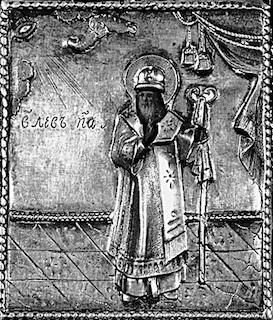
The dispute would have to be arbitrated by the emperor. Pulcheria, however, took Cyril’s side. The city population, too, was on his side, and, as a result, Nestorius’ removal from the bishop’s throne was affirmed. Nevertheless, the eastern Syrian provinces continued to adhere to the teachings of Nestorius and created their own independent churches. This gave the first impetus to divisions within Eastern Christianity.
About twenty years passed, yet the internal church strife did not subside. During these years, a new heresy—Monophysitism—gained strength. Its proponents acknowledged only one nature in Christ, the Divine, while denying the fullness of His human nature. They believed that the Divine nature had subsumed the human nature in Him. At that time, the most influential figure in the European West was Pope Leo the Great. Under the influence of the pope, Emperor Marcian issued an edict to convoke a Council in Chalcedon in 451 to resolve all dogmatic and ecclesiastical issues.
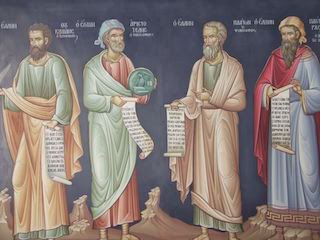
The significance of the Council of Chalcedon, known as the IV Ecumenical Council, is truly enormous. It finally affirmed the theological formula that reflected the unity of God and Man in Christ. This unity was understood as a hypostatic (indivisible and inconfused) union.
It was at this Council, as we have pointed out earlier, that the Symbol of Faith (the so-called Nicene-Constantinopolitan Creed), professed to this day by the Orthodox Church, was adopted. Nevertheless, the Council of Chalcedon had a negative impact on the unity of the Eastern Christian world. After the already mentioned separation by the Eastern Syriac “Nestorian” Church, the decisions of the Council of Chalcedon would not be accepted by the Armenian, Syriac (Jacobite), Egyptian (Coptic), Ethiopian, and Indian Churches. These churches became known as the non-Chalcedonian Churches. Some of them have remained influential to this day, and of others—only a few communities remain. The Byzantine and Roman Churches, which adopted the decision of the Council of Chalcedon, called themselves Orthodox, emphasizing their commitment to the ancient right (correct) apostolic teaching.
Although this division would not have the same consequences for the Christian world as the subsequent Great Schism of 1054, the unity of the Eastern Church was, to a certain extent, undermined, which affected its further historical path.
Still, following a hard and intense struggle, full of brilliant victories and bitter defeats associated with losses, the Church was able to retain the central thing—she remained the bearer of the idea of God-Manhood, called to transform the world. And humanity had entered a new era, no less controversial and tragic—the era of the Middle Ages.
The Middle Ages, i.e., the period from the fall of Rome to the Reformation and the Renaissance (although scholars still argue about the definition of this concept and the chronological boundaries of the Middle Ages), is an extremely rich and controversial period in the history of Christianity. During this time, the Eastern and Western Churches finally became divided, choosing to advance independently of each other. In the Middle Ages, the structure of church government developed and took shape, and the principles and forms of interaction between church and state were established. Ecclesiastical activities in all their aspects received legal implementation; church life began to be governed by precise rules. New economic and social relations had a strong impact on the cultural development of the countries that had been part of the former Roman Empire. Virtually all spheres of life—natural sciences, poetry, philosophy, art—experienced an unprecedented rise. The secular and spiritual components of the Middle Ages, mutually enriching each other, have left us with the greatest cultural heritage. It formed the basis of our present civilization, which is commonly referred to as Christian. However, the development of the medieval society was by no means unambivalent. Its Christian form was often merely external, disguising a lack of Christian essence underneath. Thus, along with the greatest achievements of the Middle Ages stand what can be described as none other than reprehensible and abhorrent. In fact, the very worldview of the Middle Ages (often equated with the true Christianity by today’s fans of “antiquity”) was built on the false and unchristian elements, which were subsequently absorbed by European culture. To comprehend the main malady of the medieval consciousness, one might look for answers in the limited assimilation of the Christian principles by the European nations.
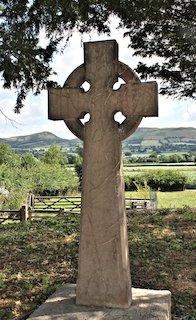
By the beginning of the 5th century, no fewer than two million people must have already been converted to Christianity. Representatives of the established first Christian churches of Rome, Constantinople, and Asia Minor were sent to the most remote regions to take the Gospel message to the peoples.
Around 300 AD, the ruler of Armenia, Tiridates, was baptized and the New Testament was translated into Armenian. Armenia became the first state to officially proclaim itself Christian.
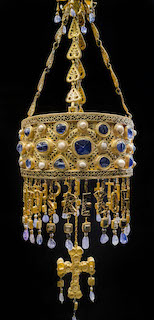
Under Constantine the Great, Christianity spread to Ethiopia, Georgia, and even India. Numerous Christian communities began to appear in the west—in Italy and Carthage—and in the south of Europe. The Council of Elvira in 300–306 was attended by delegates from southern Europe, particularly Spain. In the same 4th century, Christian preachers began their extensive work in northern Africa.
The process of the Christianization of the British Isles and Central Europe was of particular importance to the fate of the Western Church. It is known that the Celtic bishops represented Britain already at the local Church Council of 314.72 Even before the invasion of the western Goths into the Roman Empire, missionary work began among them. The missionary outreach is inextricably linked with the name of the Arian Christian Ulfilas (c.311–383), ordained to the Gothic bishopric, who translated the Holy Scriptures into Gothic. His ministry was very successful in converting Goths to Christianity: many of them were already Christians when they invaded Rome. Martin of Tours (c.317–397) worked hard to spread the Gospel among the Teutonic tribes. His mission was especially important for the Western Church, which was threatened by the raids of the militant Teutons. However, the mission of Martin of Tours already showed intolerance, alien to the spirit of the Gospel. Martin organized the monks subordinate to him into squads, which destroyed and burned pagan temples. For centuries to come, Christian missions would often be accompanied by the practice of baptism with “fire and sword.”
Just as revealing were the conversion and subsequent acts of King Clovis (481–511), the first Frankish king to become Christian. Before the battle with the Germanic tribe of Alemanni, Clovis lost hope of getting help from his “native” gods and called out to Christ: “If You will grant me victory over these enemies, and I will know [Your] power… I will believe in You and be baptized in Your name.”[119] He won and in 496 converted to Christianity under the influence of his wife and St. Remigius. Henceforth, Clovis offered a different justification for his participation in internecine fighting: for example, he moved his forces against Alaric to allegedly wage a war against Arianism. The result of missionary work among the Franks, regardless of the means of its execution, was that almost all Gaul (the territory of present-day France) entered the Christian Church.
Irish monasteries played a unique role in the development of Western Christian culture. It is believed that Christianity was brought to Ireland by St. Patrick (c.389–461), who came there from Britain at the age of 16. The inhabitants of Ireland professed the religion of the Druids—a complex conglomerate of pantheistic pagan ideas. From 432 to 461, Patrick preached the Gospel among the Irish Celts and, despite the opposition from the local pagan priests, made Ireland the backbone of Celtic Christianity. Later, Irish monks, as the most trained and educated, went to different parts of the European continent spreading the Gospel. The Irish monasteries themselves would become the primary “book centers” of the early Middle Ages in the West, where ancient manuscripts were stored, copied, and studied.
After the fall of Rome, the Church faced the task of introducing the barbarians to Christianity, bringing them to the true faith and universal unity. Here, too, the Church encountered difficulties.
One of the issues was the fact that the barbarians who had already converted to Christianity (for example, the Goths) were predominantly Arians. This heretical teaching, more rationalistic than Orthodoxy and, consequently, more accessible to the common man, became deep-rooted among the Goths, especially given that their enlightener, Ulfilas, was an Arian.
The central challenge, however, was that genuine acceptance of the Gospel Message required a rebirth of man, repentance, and moral purification. For educated pagans, a small minority of people, the search for religious and ethical foundations of life was something natural. Many of them already felt an acute contradiction between the traditions of their fathers and the true ideal. As a result of their long spiritual search, they would often come to the One God in Christ. Such reservations were alien to the barbarian world. The free children of the forests—the Goths, the Lombards, the Franks, they did not recognize any rules or restrictions when it came to pursuing their desires. “They actually think it tame and stupid to acquire by the sweat of toil what they might win by their blood,”[120] Tacitus wrote about the early Germans. Naturally, their primitive laws and savage morals were not conducive to their ethical progress and understanding of the spirit and tasks of Christianity. Their concept of virtue was conflated with that of power. Thus, the worldview of barbarians was largely shaped by individualism and the rule of dominance by the strong.
As to the religious beliefs of the barbarians, they were a mixture of crude pantheism and the most primitive paganism. The ancient Germans believed in the formidable god Wotan, who travelled through forests accompanied by the Valkyries, the warlike maidens. Another god, the unstoppable Thor, thundered in the sky and sent rain to the earth. The life of the gods, according to the Germans, was spent in battles and orgies. People believed that the forests were inhabited by goblins, elves, and witches, and that the houses were haunted by kobolds. Sacred stones, trees, and groves were revered throughout Northern Europe. The Germans, who were close to nature, found it difficult to part with their belief in nature spirits. Whereas the pantheon of classical antiquity had dissolved on its own, the Germanic deities remained entrenched in the popular consciousness.
When converting the pagan barbarians to Christianity, the missionaries were often less concerned with how profound that conversion actually was. In order to make quick progress, they, either consciously or unconsciously, took the path of compromise. Without disavowing the pagan gods, they equated them with demons, who from now on would inhabit the underworld. Thus, for millions of newly converted “Christians,” their prior pagan beliefs did not go away but instead were modified. Demonology began to develop rapidly, where demons were endowed with certain cosmic features characteristic of the old pagan spirits. In a similar vein, many minor deities quietly acquired the status of patron saints.
Accordingly, the clergy began to play the role of the pagan priesthood. The early Christian understanding of the role of the pastor as a celebrant before God on behalf of the entire congregation, vested with the right to perform the sacraments, gave way to the belief that real communication with God could only occur via the priest. A special magical power began to be attributed to priests. Such understanding of the role of clergy could not but negatively affect their morals. The majority of clergy in the barbarian countries quickly became a kind of caste of sorcerers, greedy and power-hungry individuals.
Thus, the Christianization of Europe progressed not so much in depth as in breadth, through a formal addition of the population in the new lands to the Church. Curiously, the mission of spreading Christianity was carried out not only by the clergy but also by the newly converted Christians from the barbarians. As already mentioned, the role of “taking up one’s cross” in that mission was often replaced with the sword. Nevertheless, the adoption of Christianity, even in this form, was of great significance to the barbarian peoples of Europe. The same Clovis, although he imagined Christ to be something of a warrior God, tried to change his pagan habits and temper his cruelty. According to the bishop Gregory of Tours, Clovis “made it known to all the army that neither there nor on the way should they spoil anyone or take any one’s property.”[121]
The Christianization of Europe formed a single basis, which would enable a revival of civilization, which previously collapsed with the Roman Empire. Christianity became the religious and ideological foundation on which the new economic relations were built. Yet, such Christianity of a semi-pagan model, being in fact a double faith, could not become the driving force for a genuine spiritual and cultural revival.
The clergy were becoming increasingly susceptible to secular interests and influences. Like the nobility of that period, they began to spend time feasting, hunting, and fighting wars. The level of education fell catastrophically among the clergy, while their greed and debauchery flourished.
The role of monasticism as a bearer of enlightenment, as an institution alien to the world and its temptations, increased significantly during that period. Monasticism was called upon to become a stronghold of the Church in the harsh days of the early Middle Ages. Back then, however, there was no common understanding of the purpose and nature of the mission of monasticism. It was rather fragmented and incapable of acting as a unified force. Monasticism needed a new Rule (charter) that would strictly regulate all aspects of its life and clearly define its place in the life of the Church and society. It fell to St. Benedict of Nursia to create such a Rule.
Monasticism was the mainstay of the Church in the East. Likewise, through the efforts of Benedict of the Italian city of Nursia, monasticism began to play a major role in the spiritual life of the West.
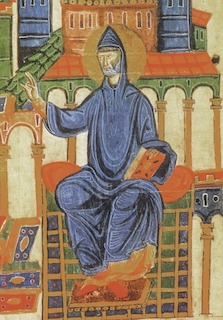
While still very young, Benedict started to lead an ascetic life. He lived in the suburbs of Rome. By the age of 30, he became an abbot of a monastery. He fought resolutely against the abuses and secular mores that had by then penetrated behind the monastery walls. Yet the monks were unwilling to give up their well-fed and comfortable way of life. Benedict had to withdraw to the former places of his ascetic labors as a youth. Soon, people began to flock to the cave where the young solitary lived, eager for spiritual consolation. Many of them decided to settle near St. Benedict, attracted by the blessed atmosphere that surrounded the monk. Thus, several new monasteries appeared. This, however, did not happen without intrigues against Benedict, and, around 520, he and several friends decided to move to the mountain of Monte Cassino. There, he began his active missionary work and built a monastery on the site of the former Apollo temple, where he lived until the end of his days. In that monastery, he created his famous “Rule of St. Benedict” for monastic life.
Like the Eastern ascetics, Benedict taught that all monastics had to perform manual labor. “Idleness is the enemy of the soul,” he said, “and therefore the brethren ought to be employed in manual labor at certain times, at others, in devout reading.”[122] Benedict outlined the two principal occupations of the monks: in addition to physical labor, they had to engage in missions and spiritual education, and, of course, strictly observe the hours of prayer. The Rule of St. Benedict was quite austere, which corresponded to the mission of monasticism at the time. Thus, the monks had to sleep clothed and with knives at the ready in order to repel a sudden attack by robbers. They had to wear the simplest clothing, limit themselves to a minimum amount of food. Only a few hours were allowed for sleep: at night, the monks served long services. However, the Rule of St. Benedict can not be considered cruel or inhumane. It does not contain excessive demands, typical of early Christian ascetics, recommends leniency to weak brethren, and prescribes alternating work with short periods of rest. In the preface to the Rule, St. Benedict writes: “We are about to found a school of the Lord’s service, in which we hope to introduce nothing harsh or burdensome.”
Monasticism must be well organized, consistent with its great responsibility and its important role in the Church. Therefore, St. Benedict developed a hierarchical structure of monastic ministry, with its strict and unquestioning subordination of the lower-ranking ministers to their superiors. Benedict was the first to introduce the monastic vow, which, like the military oath, should confer greater responsibility on those who embark on the narrow path of serving and renouncing the world. According to the Rule, the abbot of the monastery must never abuse his power. Ordinary monks could offer him advice, which he was obliged to pay attention to.
The Rule, developed by St. Benedict, greatly strengthened monasticism as the stronghold of the Church. It took a long time before the monastic rules of St. Benedict had to be revised. Yet to enact fundamental changes in the general life and practices of the Church, pastors of the highest rank were needed, who could measure up to the great and far-reaching challenges facing the Christians. Pope Gregory I, later called Gregory the Great by the Church, became such a pastor.
Monasticism became the true center of church life, and it was precisely from the monastic environment that a young and talented cleric emerged, who, under the name of Gregory I, was destined to occupy the Roman cathedra and become one of the greatest popes in the history of the Church.
Gregory came from the patrician family of the gens Anicia, received an excellent education, and in his youth was the prefect of Rome. But from an early age, he was yearning for a contemplative and spiritual life. As his biographer puts it, “soon quitting his secular habit, he repaired to a monastery,”[123] joining the Benedictine order.
Gregory’s talents and ascetic life attracted the attention of Pope Pelagius II. Gregory was sent to Byzantium for several years as a representative of the see of Rome. He brilliantly managed his assignment: fighting heresies and defending the interests of Rome. However, he truly felt at home only when, in his own words, he “anchored [at] the tranquil shore of prayer, whenever tossed by the ceaseless waves of secular affairs.”[124] In 585, Gregory returned to Rome and became the abbot of a monastery. When Pope Pelagius died in 590, the Senate, the people, and the clergy unanimously elevated the well-known abbot to the see of St. Peter. Gregory opposed his own election as much as he could but eventually conceded to people’s demands. This position was a heavy burden for him to carry. Later, Gregory remarked with sadness: “For I used to strive daily to win my way outside the world, outside the flesh to see incorporeally supernal joys…. But, having been suddenly dashed by the whirlwind, I have fallen into fears and tremors.”[125] Indeed, the situation was extremely challenging, for, as we know, the newly Christianized countries were going back to the darkness of paganism and their spiritual life and education were waning. The Church in the East became increasingly subordinate to the Byzantine emperor, while simultaneously growing further from the Germanized West.
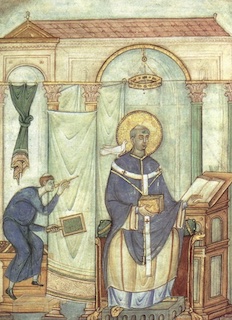
Achieving the unity of the Church, even if only on the outside, became a top priority. Gregory realized that he could use his talents to work towards this goal. Still, his political position was nowhere as extreme as those of most of his successors, and, as a monk, he always put spiritual values first. “Other popes,” the famous medieval historian Bede the Venerable wrote about him, “applied themselves to building churches or adorning them with gold and silver, but Gregory was wholly intent upon gaining souls.”[123] A deep sense of personal humility and kindness virtually never failed Gregory, and there was no pretense in the fact that he called himself “the servant of the servants of God”—Gregory truly felt called to serve his brethren in Christ.
However, a deep longing for the unity of the Church did not prevent Gregory I from defending the primacy of his see. He saw the City of God as a united Church, something he intended to achieve by traditional methods, by persevering in the traditions of the Roman Empire. Naturally, in his eyes, Rome was the center and the head of the Christian world. And, therefore, Gregory became genuinely indignant when the Byzantine patriarch John began to refer to himself as an ecumenical bishop. In a letter to Emperor Maurice, he notes with anger: “[Peter] received the keys of the heavenly kingdom, and yet he is not called the universal apostle; while the most holy man, my fellow priest John, attempts to be called universal bishop!”[126] Thus, the struggle for primacy between the sees of Constantinople and Rome began to manifest itself visibly, which would later lead to most unfortunate consequences.
Gregory’s teaching on the priesthood holds great importance for Christianity. A priest, he believed, should live in two spheres, “in seeking high things he [should not] despise the weak things of his neighbours.”[127] At the same time, a priest differs from a layman only by his readiness to devote his life to God without reserve. “Let one who is still tied and bound with earthly desires beware lest he venture to assume a place of rule [and] an intercessor [in the Church of God].”[128] Gregory altogether rejected a notion of any special superiority of a pastor over laymen, “for man is by nature preferred to the brute beasts, but not to other men, one’s equal.”[129] However, these most important guidelines were not fully understood by the medieval Church: the pagan notions of a clergyman as a type of magician with a special connection to God, which existed among the newly converted Christians of the early Middle Ages, have survived to modern times.
Apart from his unifying mission in the Church, Gregory the Great made a significant contribution to strengthening monasticism. He is known for his missionary activities, primarily in England. He supported reforms in the Christian liturgy and wrote a spiritual and moral guide for pastors.
Not everything in the work of Gregory the Great can be regarded as positive. Resorting to the help of the state in attempts to unite the Church, Pope Gregory greatly contributed to the future consolidation of secular power in the Church, the transformation of the papal see into a military and political force. Proclaiming the equality of priests and laity, he simultaneously raised the clergy to an unprecedented height by his ecclesiastical reforms, essentially endowing them with secular power. The shortcomings of Gregory the Great include his disregard for art and the pre-Christian philosophical and literary heritage. Notwithstanding, Pope Gregory remains one of the most prominent figures of the Church who left a significant mark on her history. His works, more than those of others, showed a blueprint for the future developments of the Church in the West.
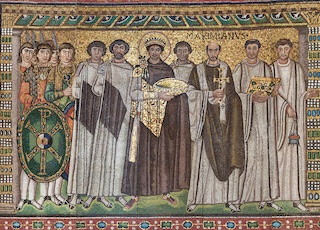
While Rome was working to unite central and northern Europe under its spiritual rule, Byzantium sought to create the City of God in the East. The rulers of Byzantium saw themselves as true heirs of the Roman emperors, and their state as a huge Christian empire built after the Roman model. This aspiration appeared to have been fully realized during the reign of Emperor Justinian (483–565).
Having come to power in 527, this emperor ruled the “second Rome” until his death. An extremely ambitious, intelligent, and educated man, he went down in the history of Christianity as a ruler who greatly influenced the fate of the Church.
First of all, Justinian considered his first priority to strengthen the military and political power of Byzantium. During his military campaigns, he conquered the Vandals and defeated the Ostrogoths; the barbarians lost northern Africa and a large part of Spain. He succeeded in annexing the peoples of the Balkan Peninsula to Byzantium. The borders of Byzantium began to approach those of the former Roman Empire. In his edicts, Justinian referred to himself as a ruler of the Franks, the Alemanni, and similar titles that emphasized his claim over Europe.
Justinian was well aware of how important church unity was for strengthening the imperial state. Already as a co-emperor of Byzantium, he resolutely fought the Monophysites. For this purpose he established ties with Pope John, whom he welcomed with honors in his capital. In 544 AD, Justinian issued an edict of “The Three Chapters” directed against the Monophysites. He also helped to refute Nestorianism.
In relation to the Church, Justinian formally observed the principle of symphonia, which presupposes an equal and friendly coexistence of Church and state. But in fact, he was completing that enormous edifice of imperial absolutism, with the Church being an essential part of it. Christianity was important to Justinian mainly as a tool for strengthening the Byzantine political system. Accordingly, the emperor arrogated to himself the right to freely appoint and remove bishops, and introduce church laws that were convenient for him. In other words, for Justinian, the role of the Church was reduced to serving the state, and this phenomenon in history became known as caesaropapism. The principle of caesaropapism was formalized in his famous legislative code known as “The Codex of Justinian”—a comprehensive set of laws governing all aspects of life of the empire.
Sincerely believing that Christianity and the Christian state can be strengthened through the use of force, Justinian stopped at nothing to achieve his ends. Two years after his accession to the throne, he ordered the University in Athens to be closed. He forbade the Jews to read the Old Testament in Hebrew. In his edicts, Justinian declared that “those who do not rightly worship God shall also be deprived of their earthly goods.”[130] Justinian is the author of the infamous words about heretics: “It is enough to let them live.”[131]
This religious policy of Justinian, little in keeping with the Christian spirit, sometimes led to the results that he did not anticipate. Thus, while mercilessly fighting against heretics, the emperor himself came to be viewed by some as one—his edict “The Three Chapters” led to a contention at the Council of Constantinople in 553. Justinian alienated many clergymen in the East, who were leaning towards Monophysitism, and the pope in the West. This also caused a schism in the West, which lasted for 150 years.73
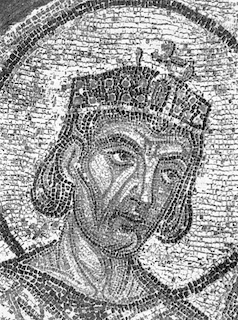
The caesaropapism, which first appeared during the initial Ecumenical Councils, was gradually gaining dominance in Byzantium. It effectively paralyzed the spiritual power of the Church, nearly depriving her of true social significance. The Church became completely preoccupied with worldly affairs, servicing the needs of the rulers of the state. As a result, faith in God and spiritual life began to exist in isolation, fenced off by monastic walls. Sincere Christians, instead of sanctifying the world, fled from it, as the first anchorite monks once had done. The separation of faith from social life further deteriorated the moral state of Byzantine society.
Byzantium claimed the right to be the successor of the Roman Empire and, in a sense, achieved its goal, which was not only about bringing a huge territory under its control. Like the Roman emperor, the Byzantine monarch had an unlimited power. He stood above the law. The inhabitants of the empire were called the “slaves of his majesty.” The humiliating ceremonies of obeisance paid to the Christian emperor were more befitting of the pagan kings of Egypt who believed themselves to be the sons of gods. The despotic rule of some emperors resulted in a deliberate policy of terror, which in turn demoralized society and contributed to the decline in morals. People’s spiritual aspirations were on the wane. The inhabitants of Constantinople would spend their days at the circus arena where the opposing groups of fans provoked riots and bloodshed. On the hippodromes, the spectators were yelling furiously: “Theotokos, grant us victory!” Conjurers were hired to cast a spell on the horses of the opposing team. In the circus, mime artists depicted the most obscene scenes, blaspheming unabashedly. Drunkenness and debauchery flourished in the city. Terrible poverty coexisted with the exorbitant luxury of the imperial nobility and the high clergy. The love for work and the concern for the community interests seemed to have disappeared from the life of the commoners. More than once, during street brawls, the Byzantines nearly burned their capital to the ground. “The idle and indigent members of the populace,” notes the Byzantine historian Leo the Deacon, “used to turn to looting property and destroying houses, and even sometimes to murdering their fellow citizens.”[132]
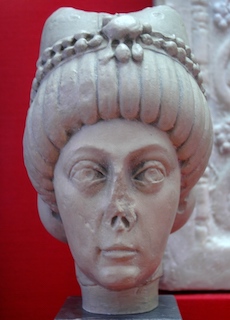
While clergy opposed these indignities, they did not find enough support in the society. In a strange way, the licentiousness of societal morals coexisted with the ubiquitous outward demonstration of piety. The population of Byzantium sang the Trisagion hymn74 before the start of the circus performances and showed a remarkable interest in theology. Thus, according to the historian Agapius, the crowds of idlers in the bazaar and pubs would gather to dispute about God and His essence. According to the witty remark of the Russian philosopher Vladimir Solovyov, “In Byzantium, there were more theologians than Christians.”[133]
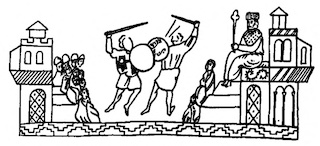
The lack of the Church’s influence on the society’s spiritual life led to a moral decline of the Byzantines. The inevitable retribution was already hanging over the Christian world, which preserved the Divine Commandments but did not keep them. In 614, a symbolic event took place, serving as an ominous warning: the Persians attacked Jerusalem and took the Cross of Christ to their capital as a trophy. But this was only a foreshadowing of more important events that would later shake Byzantium and the entire Christian world.
However, the conflicting nature of Byzantine-style Christianity produced not only negative, but also positive outcomes. The wonderful fruits of Eastern Christianity were ripening within the walls of the monasteries, which concentrated all genuine spiritual life of that time.
The most characteristic and outstanding representative of Byzantine monasticism of that era is John of the Ladder (Climacus) (579–649). His background is not well known. From a rather meager biography of John, written by his contemporary Daniel, we learn that he came to the monastery in Sinai as a 16-year-old youth and was tonsured already at the age of 20. Apparently, John, who received the nickname “Scholastic,” possessed great knowledge: his works are full of examples and images borrowed from both literature and practical life. According to his biographer, “for all his wide learning, [John] taught heavenly simplicity.”[134] Many predicted a great future for the young hermit. Following a long period of seclusion, he began to give advice and instruction to the surrounding monks and soon became the spiritual leader of the monastic community. Even less information has reached us about his life during this period. “He partook of sleep,” says Daniel, “only in such measure as to prevent his mind from being distracted. Before sleep, he prayed much and wrote books. [When some became jealous with his teaching, he stopped instructing the monks. But, once asked,] he resumed his old rule of life.”[135]
His famous book “The Ladder of Paradise”—a guide for monastics—brought John of the Ladder his greatest fame.
John makes a sharp distinction between monastic and secular ethics. He essentially excludes monks from the life of mankind, calling their life “angelic and divine.” He hardly addresses any words of instruction to laity: in his opinion, it is sufficient for them to keep the basic moral principles. “Do all the good you can,” he admonishes the laity, “do not speak evil of anyone; do not steal from anyone; do not lie to anyone; do not be arrogant towards anyone; do not hate anyone; be sure to go to church; be compassionate to the needy… If you behave in this way you will not be far from the Kingdom of Heaven.”[136]
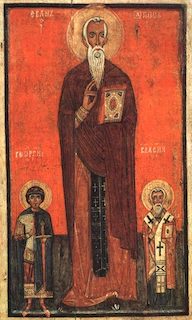
The life of a Christian monk is a different matter. God demands much more of him. Referring to the Gospel’s incident with the rich young ruler, John says that, while it is enough for a layman to keep the commandments, the ascetic should “leave everything” and lead a very special way of life, devoting it entirely to God. The first priority for Climacus is to give instruction to ascetic monks, who ought to “run from the world without looking back.” However, his “Ladder of Paradise” contains many lessons that are extremely important and relevant to the entire Christian world. Climacus explains that Christian obedience and “the cutting off of one’s own will” are not subservience to people and God, but a great feat of curbing one’s egoism or selfishness. It leads to the attainment of Christian love, which is understood as transcending human limitations.
Climacus refers to “the fear of God” or the love for God as an overarching mindset necessary to acquire holiness before God. This implies an impartial and objective evaluation of oneself and the recognition of one’s shortcomings when confronted with the greatness and holiness of God. “As a ray of sun,” says John, “passing through a crack, lights everything in the house and shows up even the finest dust, so the fear of the Lord, entering a man’s heart, reveals to him all his sins.”[137] The monk’s self-perfection, according to Climacus, requires continuous spiritual labor, overcoming his sinfulness, a gradual ascent along the spiritual “ladder” to heaven—hence the name of his book and the naming of John of the Ladder, which became established in the Church Tradition.
Close in spirit to John Climacus was the Palestinian hermit St. Barsanuphius the Great (d.c.563), an Egyptian by birth. In his younger years, he lived in a large city, probably Alexandria. He received a decent education, spoke several languages, and knew the Bible well.
Having chosen the path of ascetic and mystical exploits, Barsanuphius strove to renounce everything earthly as much as possible. Beginning in 540, he lived in complete isolation from the outside world. In a harsh struggle with his own passions, living in austere natural conditions, Barsanuphius developed an extraordinary willpower. “If I write to you,” he once communicated to a brother, “about the temptations that I have endured, nevertheless I say to you that your ears are not able to bear it, and neither perhaps are the ears of anyone else in this age.”[138]
Nobody was allowed near him except for one trusted person, through whom Barsanuphius provided spiritual guidance to a large monastic community. His concern and love for his brethren were so great that Barsanuphius prayed to God either to accept them into His Kingdom or to destroy him instead. Although Barsanuphius never saw the faces of his monks, he knew all the nuances of their spiritual life, and in prayer, he took upon himself the weight of human sins.
The highest goal of a monastic (and indeed of every Christian), according to Barsanuphius, is the attainment of the Spirit of God by means of inner perfection. It is the Spirit of God who directs person to the true path.
While it is possible to perform actions that are not normally possible under the influence of hypnosis or in a state of emotional upheaval, people become capable of doing supernatural, argued Barsanuphius, when they acquire the Spirit: they can perceive the unseen, heal the sick, and even raise the dead. According to him, anyone who reaches such a spiritual height returns to the Creator and becomes a “brother of Jesus.”[139] However, this path is prepared, in Barsanuphius’ opinion, only for the elect.
Abba (father) Dorotheus (d.c.620), Barsonophius’s disciple who wrote down his teachings, dedicated himself to social ministry more so than his teacher, not reckoning it beneath himself to attend to such “superficial” matters. This concerned both his ministry (for example, he helped to set up a hospital) and his literary work: “Directions on the Spiritual Life” by Dorotheus, primarily addressed to the laity, are devoid of specific monastic overtones. Monastic life, according to Dorotheus, is only one of several paths to the Christian perfection. According to his convictions, anyone—a theologian, a scholar, a fighter for the faith, a benefactor, a missionary, a preacher of Christian morality, and, ultimately, any Christian who wages a daily struggle for the mastery of one’s spiritual nature over the physical—is worthy to be called an ascetic.
Asceticism, Abba Dorotheus believes, involves the development of will as a tool for maintaining a person’s spiritual essence. The first prerequisite of this essence, according to him, is conscience—the “natural law” that allows us to distinguish between good and evil.
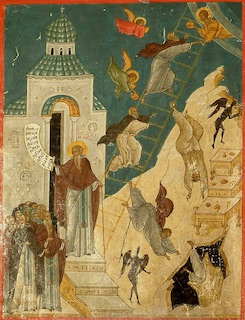
Like many ascetics, Dorotheus considered it necessary for people to realize the inevitability of punishment for sin. But whereas the fear of retribution plays an important role during the early stages of spiritual development, later on, as the person progresses to perfection, that fear disappears. Dorotheus quotes the words of St. Anthony: “I no longer fear God, but love him.”[140]
The love for God and for one’s neighbor is an integral whole. This most important point of Christian teaching is even more pronounced in Dorotheus than in his predecessors: “Let us suppose that the world is a circle and that God Himself is the center; the radii are the lives of people… When they come close to God, they in fact come close to their neighbor.”[141] In providing these amazing insights, Abba Dorotheus approaches the position of the author of the Areopagitic writings—an outstanding philosophical and religious work of that era.
The best achievements of Byzantine literary and philosophical thought are embodied in Corpus Areopagiticum—works written under the name of the former pagan Dionysius, who converted to Christianity upon hearing the Apostle Paul preach in the Athenian Areopagus, and later became the first bishop of Athens.
Judging by the content of the Corpus, it could not have been written earlier than the second half of the 5th century. Almost nothing is known about its real author. Therefore, in the scientific literature, he is commonly referred to as Pseudo-Dionysius the Areopagite.
The main idea underlying the worldview of the Areopagite is Unity and Harmony that is sustained by universal love—“the Divine Love, a good Progression of the surpassing union, which knows neither beginning nor end. It is like an everlasting circle… whirling round… by reason of the Good, from the Good, and in the Good, and to the Good.”[142]
Man, in his limited existence, can and must partake of that great “circle of love”—the Divine existence. However, there are diverse ways of partaking of this existence. The Areopagite identifies three possible pathways.
The first way is by knowing the goodness of God, which is symbolically reflected in the Holy Scriptures.
The second way is through the study of the created world, which is imprinted with Divine love. The love of God is embodied in beauty: “Matter…, having had its beginning from the Essentially Beautiful, has throughout [its] whole range some echoes of the intellectual comeliness.”[143] Continuing to develop the core idea of Christianity—the idea of deification75 of the world and flesh—the Areopagite believes that matter, as God’s creation, is participating in the creation of good. Hence, according to Dionysius, it is unacceptable to neglect the problems of society, something that contemporary Byzantine Christianity tended to do.
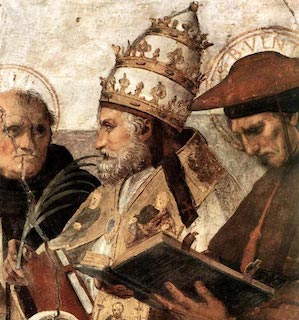
The third way—the highest and most difficult—is the path of Christian perfection or “doing.” It requires a complete renunciation of one’s self and everything earthly. One must give up one’s material sensations and ideas. The laws of nature or even reason should no longer be regarded as the supreme guiding principle, for the Highest is ineffable. “To see and know super-essentially the Superessential is to enter within the super-bright gloom … through not seeing and not knowing,” says the Pseudo-Areopagite.[144] Only the person who has acquired complete “unknowing” can succeed in knowing God, who then mysteriously descends into his or her soul. Thus, for the first time, Pseudo-Dionysius began to develop the theme of Christian mysticism as such. He also became the first to carefully outline the views of Christian worship as a complex system of symbols and sacred rituals, which express the hidden Divine mysteries.
The mysticism of the Areopagite had a special significance in the life of the Eastern Church. Its great popularity was not only due to its deep philosophical foundation. It also seemed to justify the isolation of the religious and monastic-centered life from the social life of Byzantium, while at the same time offering the path of spiritual ascent—not only for the individual but also for the earthly Church as a whole.
As a result, the practice of renouncing the world and the mystical experiencing of the Absolute, which had been previously an exclusive purview of the monks nearly unknown to the common Byzantine, became mainstream in the Byzantine Church. Its various aspects are expressed in the writings that made up the Corpus Areopagiticum: “On Divine Names,” “Mystic Theology,” “On the Heavenly Hierarchy” and some others. Their content greatly influenced medieval Christian thought. During the period of the struggle against heresies—Monothelism and Iconoclasm—excerpts from the Corpus of the Areopagite were read out at the Ecumenical Councils. In the 8th, 9th, and the subsequent centuries, outstanding Christian thinkers drew their ideas from it: John of Damascus and Isaac the Syrian in the East, and Anselm of Canterbury, Bonaventure, and Thomas Aquinas in the West.
Church art rightfully occupies one of the premier places among the many remarkable achievements of Byzantine Christianity. Famous for its artistic mastery, the church art of that period is imbued with deep faith and subtle theological constructs.
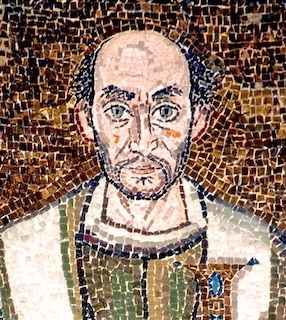
In 537, a solemn consecration of the Cathedral of Hagia Sophia took place in Constantinople. The creation of this masterpiece of Byzantine architecture was a truly significant page in the history of the Church. Its grandiose architecture, brilliantly embodying the idea of Christianity, was like a hymn in stone to the glory of the Creator. Marvelous mosaics, an altar sparkling with gems, giant arches as if hanging in the air, sun rays penetrating through numerous windows—all this makes the cathedral the greatest temple of God, which embodies all the splendor of Eastern Christian art.
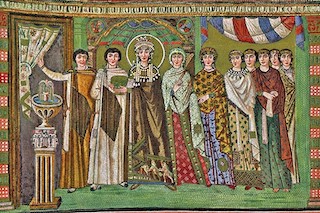
St. Sophia Church made and continues to make an extraordinary impression. No wonder that glowing descriptions and odes were dedicated to it. This was the place where Church Councils gathered, and the most solemn divine services were held. The Kievan princes would be influenced by the grandeur and beauty of the Cathedral of St. Sophia during the period of Rus’ conversion to Christianity.
In addition to the magnificent monuments of church architecture, the Byzantine masters left us examples of mosaics of astonishing beauty, such as in the imperial palace in Constantinople (5th–6th centuries) and the churches of San Vitale and Sant’ Apollinare in Ravenna (6th century). For all the richness and variety of colors, they are surprisingly harmonious. In the frescoes in Ravenna, we see the holy women marching in a procession, the expressive figures of formidable prophets holding scrolls, Moses in the form of a mighty young man among rugged cliffs, and the angels with lowered wings. Somewhat elongated figures against the golden background, large thoughtful eyes—their frozen poses give the characters a special charm. The figures are static, yet the sense of the imperishable and the eternal is conveyed with extraordinary force.
One characteristic feature of Byzantine art is its dazzling luxury. The masters used an incredible amount of marble, enamel, precious stones, and gold in their works. At the early stage of the development of Byzantine art, the opulence of artistic works was combined with the fine craftsmanship of their execution. Unfortunately, this trend later gave rise to numerous tasteless pieces, which were seemingly competing with each other in the amount of precious metal spent on them.
No less remarkable was the art of miniature painting, which became widespread in the 6th century. For example, in the miniatures illustrating the manuscript of Cosmas Indicopleustes “Christian Topography,” we see light and elegant figures of saints and prophets, each endowed with perfect proportions and unique features.
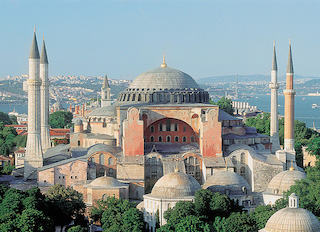
The influence of the art of Byzantium on the art of subsequent centuries was enormous. Its characteristics can be traced in the Cathedral of St. Mark in Venice, Aachen Cathedral in Germany, the Cathedral of St. Sophia of Kiev, and numerous works created by masters of other lands.
The deep crisis of Byzantine society had grave consequences for its future. Deprived of spiritual support, it decayed in all its spheres, and above all in the area that Byzantine Christianity sought to renounce with consternation and contempt—the sociopolitical sphere. And it was here that the threat to Christianity itself arose. A new religion, Islam, born in the Arabian expanses, quickly won many supporters and turned into the main opponent of Christendom. The birth of Islam is inextricably linked with the name of its founder—the Arab prophet Muhammad.
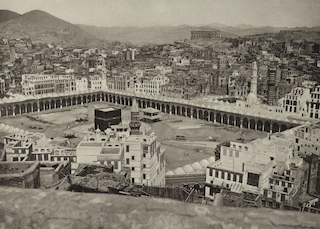
Muhammad was born in the city of Mecca. In his youth, he was engaged in trade, and, having married a rich widow, he was able to devote much of his time to contemplate religion. Being a spiritually gifted and impressionable man, Muhammad had experienced several visions that became a divine revelation to him. However, he resisted, for a long time, the voice calling him and even contemplated suicide. It was only in 610, at the age of forty, that Muhammad first appeared as a prophet in Mecca, where he did not gain much popularity at the time. His preaching had more success with the pilgrims who came to Mecca from Medina. This increased the hostility of the local residents to Muhammad, and in 622 he was forced to flee with his closest companions to Medina, where he headed a religious and political community. At first, Muhammad’s spiritual thoughts were directed towards Jerusalem. The Jews of the Diaspora who lived in Mecca also turned their eyes to that holy city, yet, after Muhammad could not gain their support, he transferred the status of the holy city to Mecca.
Aiming to eradicate paganism in his native city, Muhammad, who by that point led a large number of supporters, declared a holy war (jihad) on the inhabitants of Mecca. Following numerous battles with varying degrees of success, Mecca was finally taken in 630. Muhammad returned to Medina, where he died two years later.
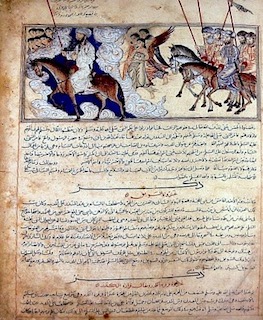
Being familiar with Judaism and Christianity (in its Monophysite form) from his young age, Muhammad combined the fundamentals of these religions in his teaching. In doing so, he stripped Judaism of its inherent national color and excluded the idea of the Trinity and redemption by grace from Christianity. Recognizing himself as a messenger and confidant of God, he began to preach the new religion of Islam. The duty of a person, according to Muhammad, is to strive with all his might to fulfill the Law of God, completely obeying it.
Moral laws appeared to him as simple and natural restraints on human passions.
As the number of his supporters grew, Muhammad, a domineering and powerful personality, became increasingly imbued with political goals and objectives. He united numerous Arab tribes into a single people and set before them the task of subjugating the world to the true religion of Islam. The Arabs, infinitely loyal to their prophet, full of enthusiasm and energy, quickly became formidable foes to their nearest neighbor, Byzantium.
At the court of Emperor Heraclius, who ruled Byzantium at the time, the emergence of the new force in Arabia was initially welcomed. The emperor hoped that this would weaken the position of his main enemy, the Persians. However, already in 633, the Arabs defeated Heraclius and took Damascus, and in 637, the troops of Caliph Omar were already by the walls of Jerusalem. The Patriarch of Jerusalem, Sophronius, agreed to the capitulation on the condition of preserving intact the holy sites associated with the suffering and death of Christ. Yet, a few decades later, a shrine would be built on the site of the Temple of Solomon, called Qubbat al-Sakhra, the “Dome of the Rock,” which has survived to the present day.
In a short period, the Arabs conquered Antioch, Egypt, defeated their enemies in Africa, and took the islands of Cyprus and Rhodes. Fiercely resisting, the Byzantine Empire was steadily shrinking and weakening year after year.
The population of the eastern Christian provinces welcomed the arrival of the Arabs. This was explained by the strong influence of the Monophysite heresy on the Christians of Armenia, Persia, Arabia, and neighboring countries, and the fact that some of the views of Monophysitism were close to those of Islam. The position of Emperor Heraclius was desperate, and that’s when the intelligent and energetic Patriarch Sergius of Constantinople suggested that the emperor should make a concession to the eastern countries and establish a union with the Monophysites who were prevalent there. In 638, Heraclius published the Ecthesis, “the statement of faith,” in which he proposed for the Christian world to recognize in Christ two natures, but one will, the Divine one. Thus, the old Monophysite heresy about one Divine nature in Christ was overcome, but at the cost of the emergence of a new heresy, which was called Monothelitism.76 The essence of the new heresy remained basically the same: the Divine nature in Christ suppressed the human one. As a result, the Church’s teaching about the God-Manhood of the Savior was rendered powerless. The new dogmatic propositions, designed to unite the Christian world in the face of the formidable Islam, provoked fierce controversy and bitter resistance on the part of Orthodox Christians, but, by the bitter irony of fate, did nothing to improve the political situation of Byzantium.
In 647, Patriarch Paul of Constantinople and Emperor Constans II prepared an edict, which, under the threat of the most severe punishments, forbade any theological disputes about the will of Christ. In fact, this edict confirmed the inviolability of the Monothelite heresy.
As a result of theological concessions to heretics in the East, only small groups of the most consistent and steadfast Christians found themselves in the position of defenders of Orthodoxy. They were headed by a monk, the emperor’s personal secretary Maximus, who went down in the history of the Church under the name of St. Maximus the Confessor (c.580–662). Pope Martin I, another saintly bishop unswervingly devoted to the cause of the Church, who occupied the see of Rome from 649 to 655, would offer ardent support to Maximus’ Orthodox views.
After many years of unsuccessful struggle, Maximus left Byzantium in 680 for the West, hoping to find support in Rome. Pope Martin I, realizing the seriousness of the situation, convened a Council in the Lateran, the actual head of which became Maximus the Confessor. At the Council, the works of Pseudo-Dionysius the Areopagite were read out, in which the idea of the sanctification and sanctity of matter and creation was brilliantly justified—the idea of “deification [by] grace, for the sake of which everything was brought into being and given existence.”[145] This became one of the weighty arguments against the heretics who sought to demean the created nature of man by belittling the human will of Christ. Maximus himself emphatically declared that “in Christ there is one composite hypostasis realized from two natures … united without being compromised.”[146] As a result, the Council members unanimously rejected the new heresy.
The decisions of the Lateran Council were regarded as high treason in Byzantium. Soldiers were dispatched to Rome, who broke into the cathedral, arrested Pope Martin I and brought him to Constantinople, from where he was exiled to Chersonesus, where he died in 655. St. Maximus was exiled to the harsh Scythia, where he “remained until the end of his days” (d.662).
It seemed that the resolve of the defenders of the Orthodox faith had been crushed: even the popes of Rome, the successors of the courageous Martin I, stopped protesting against the theological innovations. But in 668, Emperor Constantine IV the Younger ascended the Byzantine throne. Not inclined to Monothelitism, he asked the pope to send a delegation to Constantinople to discuss and peacefully resolve the problems that continued to trouble the Church, and later, in 680, an Ecumenical Council was convoked by the emperor’s manifesto.
Following lengthy debates, the participants of the Council finally condemned the Monothelite heresy, having acknowledged the Savior’s two natures and two wills, Divine and human. The Sixth Ecumenical Council (680–681) put an end to the Christological disputes, which had been tearing the Church apart for several centuries. However, the Church soon had to go through another trial and overcome a new heresy, which had different roots.
We already know that a significant part of the Byzantine Empire in the 7th century, including many spiritual centers of Christianity, found themselves in the territory captured by the Arabs. Gradually, the process of intermingling of the Arab conquerors and the subjugated peoples began. As a result, many residents of these countries, who professed different religions, converted to Islam, while Islam also became influenced by ancient traditions. Thus, a multifaceted and rich Muslim culture emerged, absorbing the Byzantine-Christian heritage, Persian spirituality, and Jewish religious thought. In turn, Arab culture had a significant impact on the spiritual life of Asia, Southern and Eastern Europe. The most striking example of this influence is the culture of Spain in the 10th century during the Umayyad dynasty.
The interpenetration of cultures was largely enabled by a fairly long period of religious tolerance, albeit limited, which the Muslims initially practiced in relation to the conquered peoples. The main religious groups of the occupied territories of the Byzantine Empire—Christians and Jews—were allowed to worship freely and attend their churches and synagogues. It was during that period of Muslim rule that the centers of Christian culture were born and flourished, which would give the Church a constellation of remarkable ascetics, writers, poets, and thinkers.
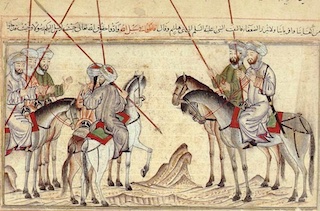
In Mesopotamia, that ancient center of world culture, the birthplace of Babylonian religion, astrology, Jewish mysticism—Kabbalah, and Syriac Gnosticism, an intense spiritual life, as in the time of Ephrem the Syrian, was once again in full swing. Traditional oriental mysticism was combined there with a tendency towards rationalism. The heresies that had not been overcome in the East—Nestorianism, Monophysitism, and Monothelitism—were all guided by rationalistic constructs, leaning towards the schemes that can be reasoned out. It is no coincidence that the works of Aristotle gained special popularity in that area, the rationalistic basis of which was opposed to Plato’s idealism. The works of Aristotle began to be translated into Arabic and commented on, which played an important role in the development of philosophy and natural science in the East. Thanks to the Latin translations of Aristotle, the legacy of this great Greek thinker would influence all subsequent European philosophy.
In Damascus, one of the largest Arab centers, almost the entire intellectual and artistic elite consisted of Byzantine Christians. Caliph Walid I, who initiated the creation of the first significant works of Arab architecture, employed the services of Christian masters. For example, the Umayyad Mosque in Damascus, built by Walid, proves that Muslim art was formed under the heavy influence of Byzantine art. Thus, the decorative design of the mosque does not yet have those intricate patterns (arabesques) that are so characteristic of the subsequent Islamic art; the colonnade also has a pronounced Byzantine style.
Similarly, Christianity influenced Islam in other spheres of life. For example, it is known that the financial affairs of Walid I were managed by a certain Greek, who was a devout Christian. His son, John, after the death of his father, became the governor of Damascus and first minister of the Caliph.
Such atmosphere of tolerance contributed to the development of Christian culture, which reached its heyday at the time. This was most clearly manifested in the works of two great Christian thinkers—Saints Isaac the Syrian and John of Damascus.
St. Isaac was born in Nineveh.77 In his early youth, he withdrew to the monastery of Mar-Matthew with his brother. However, even the strict monastic life could not satisfy Isaac. Despite the requests of his brother, who became the abbot of that monastery, he settled as a recluse in the desert. When the inhabitants of Nineveh learned about his ascetic exploits, they asked Isaac to become their bishop—and he agreed. He was ordained bishop by the head of the East Syrian Church, which was then under the influence of Nestorianism. After serving as bishop for only five months, Isaac left the see, apparently due to dogmatic disagreements with the Church leadership. Isaac’s refusal to compromise on matters of morality also played a role in his decision. When he, referring to the precepts of Christ, tried to protest against the unchristian lifestyle of his flock, he was told: “Leave your Gospel out of this!” Isaac withdrew first to the mountains, and then to the monastery of Rabban Shabur. There he remained for the rest of his life, eventually turning blind from his scholarly pursuits and exhausting fasts.
At first, Isaac’s works, written in Syriac, went almost unnoticed. Only later, the attention of the Christian world was drawn to this remarkable ascetic, philosopher, and mystic. His writings had a great influence on the Christian thought of both the East and the West.
Possessing a subtle and impressionable nature, Isaac developed his inner world to such an extent that he was called “the pinnacle.” His vast experience of self-observation and the analysis of hidden mechanisms of human consciousness allow us to view St. Isaac as a great Christian psychologist.
St. Isaac considered it possible to discuss spiritual matters only with those who have already gained a certain level of spiritual experience, whose “soul has tasted the sweetness of spiritual works.”[147] In helping people in their quest for God, he developed a special path of knowledge of the higher worlds, in many ways reminiscent of the path to knowing the Supreme Being in Eastern religions. At the same time, he directly linked the possibility of enlightenment with Christian ethics and deeds.
Isaac the Syrian made a significant contribution to the Christian understanding of the relationship between reason and faith. St. Isaac showed all the falsity of the “philosophers’ discursive way of thought,” which can only arrive at external and superficial conclusions.[148] He contrasts “philosophical discourse” with “spiritual knowledge” based on religious intuition. It is this type of knowledge that makes a person free and not bounded by material laws. Though reason in its essence is the opposite of faith, it can nevertheless lead to this higher type of knowledge. Such “spiritual knowledge,” according to St. Isaac, is the higher form of knowledge, which does not take comprehending material laws as its goal.
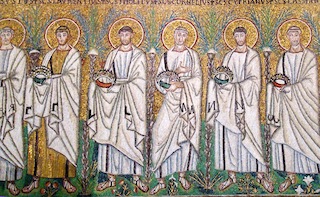
Isaac is a resolute proponent of the absolute supremacy of spirit over matter. For him, living in God and acquiring divine wisdom is the only true and direct path of knowledge, while the rest are either false or roundabout. The true way consists in simplicity, faith, and trust in God. Doubt, a characteristic and necessary factor of scientific inquiry, has no place here: when a person obtains a “measure of faith,” he feels the reality of the unseen world more so than the reality of his own self, and “there is nothing further that keeps him from Christ.”[149] In its highest phase of development, faith becomes one with knowledge. Such a person knows and sees that which is hidden from others.
The key to true knowledge, Isaac believes, is love for people and the world. “And what is a merciful heart?” he inquires, “It is the heart burning for the sake of all creation, for men, for birds, for animals, for demons, and for every created thing; and by the recollection of them the eyes of a merciful man pour forth abundant tears [from] the strong and vehement mercy which grips his heart.”[150]
Looking into the future, the solitary, not without regret, thinks that a new heaven and a new earth will replace the nature that surrounds us. He talks about the orderly passage of time, about the development of creatures, about beautiful flowers, about the daily bustle of life. All this will pass away. At the end of the evolution of the world, completely new relations will come into effect: “Another age [will be established], wherein the memory of the former creation will never again enter into the heart of any man.”[151] Then what is the purpose of suffering in this world? Thus St. Isaac approaches the central philosophical problem—“theodicy” or justification of God—and solves it in a truly Christian spirit. Suffering is necessary for the development and realization of our free will. The world is a foundry where the human spirit is being forged in order to go beyond this subconscious temporal existence and enter the Kingdom of God—the Kingdom of eternal and ineffable Light.
In the person of John of Damascus, the Byzantine Church gained an unfading glory. The future great poet, brilliant theologian, and fighter for Orthodoxy, John was born in Damascus, to a rich Christian family. His father defended the rights of Christians in the Caliph’s court. John received a comprehensive and profound education: his father made sure that the teacher of the gifted and impressionable boy was a Christian. To this end, he ransomed a monk from slavery, and under his guidance, John studied philosophy, mathematics, astronomy, and music.
Initially, John succeeded his father in his government position but later withdrew to the Monastery of St. Sabbas near Jerusalem, where he stayed until his death.
The spiritual and poetic heritage of John, a priceless treasure of the Church, is enormous. Church tradition names John the author of wonderful church hymns, full of wisdom, strength, and consolation for Christians. It is believed that he composed the Paschal Canon and the services of other holidays; the mighty hymn “Having beheld the Resurrection of Christ,” which resounds as a courageous confession of the entire Christian world; the remarkable funeral hymns, filled with deep contrition, which became part of the very fabric of the Church liturgical life. The brevity and vividness of his language, the combination of touching lyricism with the depth of thought—all this makes the Damascene the greatest poet of Byzantium and the entire Christian world. It is no coincidence that he was given the by-name of Chrysorrhoas (“streaming with gold”).
The Damascene’s poetry was closely intertwined with his musical talent. He is the author of the first church system of musical notation. He is also responsible for the arrangement of the majority of Christian hymns in the liturgical collections of the Typicon and the Octoechos. He was one of the first to compile a calendar of commemoration days for Christian saints and ascetics.
John of Damascus is even more famous as a theologian. His fundamental work “The Fountain of Knowledge” consists of three parts. The first, “Dialectics,” sets out the philosophical ideas of Aristotle, the second, “Concerning Heresy,” lists and analyzes the teachings contrary to Christianity, and the third, “An Exact Exposition of the Orthodox Faith,” systematizes the Orthodox doctrine.
Through the works of Pseudo-Dionysius the Areopagite, the Damascene was profoundly influenced by Greek wisdom both as a theologian and as a philosopher. Thus, John emphasizes the omnipresence of God and His immanence to the world: “For, like some limitless and boundless sea of essence, He contains all being in Himself.”[152] This brings his position close to that of the Neoplatonists. Yet, at the same time, John persistently affirms the transcendence of God and the fact that the Creator is completely antithetical to His creation. John barred the path of the pantheistic tendencies (God being one with the world) that began to permeate medieval Christian philosophy. From his youth, the Damascene also took great interest in the ideas of Aristotle; he compiled collections of the works of that great Greek.
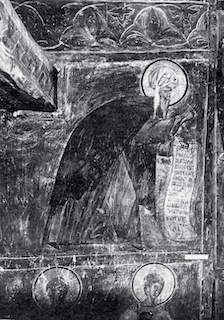
In his teaching concerning Creation, he preferred the idea that God directly created only the “primal matter,” that is, the basic elements, from which all the variety of forms existing in the world has subsequently emerged.
The Damascene highly values the vocation of humans and their role in the Universe. One with the organic world, human beings, at the same time, are endowed with a powerful and free spirit. They were created “as a bond between the visible and invisible natures.”[153] John profoundly explicates the concepts of the image and the likeness of God that elevate humanity above the rest of creation. The image of God is the mind and free will of a person, whereas the likeness of God consists in one’s virtuous deeds. God cannot predetermine all the actions of a person because of free will, but He can foresee them.
“An exact exposition of the Orthodox faith,” which was based on the rulings of the Councils and followed the teachings of the most prominent Church Fathers, especially Gregory the Theologian, was written by John towards the end of his life. This work became the final word in the Eastern Christian thought of the ancient period. The development of theological thought in the East stalled after that, and theology in the West began to develop rapidly instead. The Damascene, as the greatest thinker of that transition period, had a tremendous influence on future generations of not only Eastern but also Western theologians, Thomas Aquinas in particular. Even today, that work of John of Damascus remains the main source of Christian doctrine for the Orthodox Church.
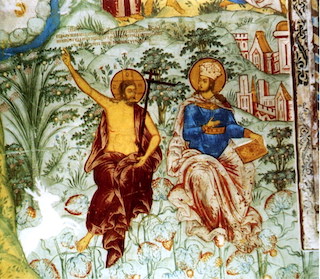
John spent his life as a monk and ecclesiastic writer fighting Christian heresies and non-Christian religions. In addition to his book “Concerning heresies,” he authored works devoted to polemics with Muslims, Manichaeans, Nestorians, and Monophysites. Yet the most outstanding contribution by John in that area was his fight against iconoclasm—a new heresy that shook the Church in the 8th century.
In 717, when Islam was conquering Asia Minor and threatening Europe, Leo III the Isaurian (675–741) ascended the shaken Byzantine throne. That talented and courageous emperor made every effort to revive the empire’s might. The Arabs, already at Constantinople, were driven back by his troops. Byzantium’s status, as a result of the emperor’s actions, was restored on the international stage to a large degree.
Without wasting time, Leo the Isaurian took decisive actions on the internal reforms, paying close attention to the Church. He had to face what became a common phenomenon of the church life of his time: the veneration of relics (the remains of saints and sacred objects) and icons took on unprecedented proportions, becoming, in essence, a form of superstition.
Icons, which were sacred images intended to help a person connect with the spirit of prayer and draw nearer to God, were held, at times, in such high regard that some elements of that Christian art began to border on idolatry.
It is not surprising, therefore, that the distorted worship of icons became a target of the ridicule from Muslims who adhered to a strict monotheism. Leo understood the grave importance of refuting idolatry accusations against Christians. The emperor’s views were quite Orthodox, and he could have made a significant contribution to the defense of Christian truths if he had not got political motives mixed up with his fight against idolatry.
Church historians believe that Leo the Isaurian’s efforts to combat the excessive veneration of icons were only part of his vast plans to reorganize the entire state-church system of the Byzantine Empire. In particular, Leo sought to restrict the rights of the higher clergy who held the leading government positions. The clergy often exploited their flock’s superstitions and pagan habits in order to enrich themselves and increase their influence. As a result, one of the forms of rivalry between the secular rulers of Byzantium and the clergy was the struggle against the “veneration of icons.” However, it is also possible that Leo the Isaurian was influenced by an event to which he attached a mystical significance. In the summer of 726, a volcanic eruption occurred on the Mediterranean Sea, which the emperor took as a sign from above, interpreting it as the wrath of God on the account of the veneration of icons.
Thus, what was essentially a righteous motive to suppress idolatry instead warped into a merciless war against the veneration of icons per se, aimed at destroying the sacred images.
The same year, the emperor issued a decree prohibiting the worship of icons as divine images and ordering them to be placed in churches at a considerable height. This measure, had it been timely adopted by the Church authorities themselves, could only have had a positive effect. However, some of the clergy, who sought the benefit of preserving the superstition, resisted the imperial decree and counteracted its implementation. Moreover, the emperor was accused of insulting Christian objects of worship. The confrontation between the parties escalated and spiraled into the iconoclastic heresy—a total ban on church images imposed by the emperor. Icons began to be destroyed, which in turn led to riots throughout the entire country. Leo and Constantine Copronymus, who succeeded him on the throne, brutally suppressed popular unrest. The persecution of monasteries and icons became widespread. In 754, Constantine Copronymus convoked a Council in Constantinople, which condemned the veneration of icons.
The Christian thinkers of that time realized the dangers of the new heresy. The dispute, in fact, was not about the icons as such. By denying the divine images, the iconoclasts thereby denied the possibility of the incarnation of the Spirit and the spiritualization of matter, which contradicted the foundations of Orthodox teaching. Therefore, the major figures of the Church led a decisive battle against iconoclasm. Pope Gregory II, followed by Pope Gregory III, strongly condemned this heresy. Gregory III ordered to stop collecting taxes for Byzantium, making it clear that from now on he did not consider himself a subject of the Byzantine emperor. The speech of Gregory III was supported by everyone in Italy.
Some of the most staunch Greek Christians were in solidarity with the pope. Byzantium was engulfed in the fires of civil strife, which provoked a renewed persecution from the government. As it always happens, the most superstitious and dark members of the mob, who had recently turned icons into idols, now turned to the destruction of churches and monasteries. Many Christians risked their lives to save the icons. Patriarch Germanus of Constantinople, a well-known church poet, found himself under repression from the government. According to tradition, the iconographer Lazarus was terribly mutilated and thrown into prison, where, nevertheless, he persisted in painting icons. Many Christians had their lives ended on the chopping block, while others were lynched by the crowd.
Still, the best representatives of the Church selflessly and sacrificially continued to defend the truths of Orthodoxy. Of great importance for overcoming the heresy of iconoclasm was the work of John of Damascus, who sought to dogmatically and philosophically justify the importance and necessity of icons to Christian life and worship. The Damascene viewed religious art in two ways: as an objective process that captures the reality of the world and as a subjective process that reveals the inner world of the artist. For him, art, like the Gospels, embodies religious truths perceived through the artist’s faith. “God,” writes John, “for our salvation was made man in truth, not in the appearance of man, as He was seen by Abraham or the Prophets, but really made man in substance. Then He abode on earth, conversed with men, worked miracles, suffered, was crucified, rose again, and was taken up; and all these things really happened and were seen by men and, indeed, written down to remind and instruct us, who were not present then.”[154] The Gospels represented the life of Christ on earth. And since, John continues, not everyone can read, the icons serve “as a sort of memorial and a terse reminder.” It often happens, writes the Damascene, “that at times when we do not have the Lord’s Passion in mind, we may see the image of His crucifixion and, being thus reminded of His saving Passion, fall down and adore. But it is not the material which we adore, but that which is represented.”[154]
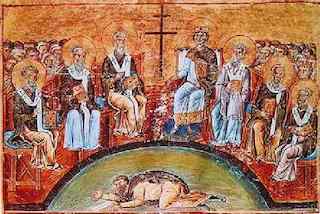
John of Damascus clearly formulated the Christian understanding of the icon, and his concept became later established in the Church. However, the iconoclasts remained relentless. Through the efforts of the Byzantine court, the Damascene lost the confidence of the Caliph and was forced to leave public service. Meanwhile, the persecution intensified, with widespread mass arrests. The persecuted monks left en masse for Spain, where the pope was already on the threshold of a political independence; other monks who remained in Byzantium, together with Orthodox Christians, formed a large anti-government party who was fighting to achieve the independence of the Church. This party was led by the abbot of the Monastery of Stoudios, Theodore the Studite (759–826), one of the outstanding figures of Eastern Christianity.
By the end of the 8th century, the iconoclastic movement was on the wane. The regent of the Byzantine throne, Irene, a domineering and cunning woman, was an ardent iconodule.78 Plus, in her bid to seize the throne, she needed the support of influential ecclesiastical figures. At that time, Patriarch Tarasius was elevated to the see of Constantinople, which he agreed to occupy on the condition that the veneration of icons be approved at an Ecumenical Council. Irene, who had already become empress, convened a Council, which opened in 786 in Constantinople under the chairmanship of Patriarch Tarasius. The Council was attended by the legates of Pope Adrian I. There were clashes between supporters and opponents of iconoclasm; the Council was disrupted and reopened again a year later. The iconoclastic bishops were pardoned, and during the final sessions, a decree was drawn up on the veneration of icons, which stated: “We defend free from any innovations all the written and unwritten ecclesiastical traditions that have been entrusted to us. One of these is the production of representational art; this is quite in harmony with the history of the spread of the Gospel, as it provides confirmation that the becoming man of the Word of God was real and not just imaginary, and as it brings us a similar benefit.”[155] Icons were recognized as “open books that remind us of God”—they were only allowed to be venerated as types. Thus, the Council rejected the heresy of iconoclasm and at the same time overcame the extremes of veneration of icons, which regarded them almost as idols.
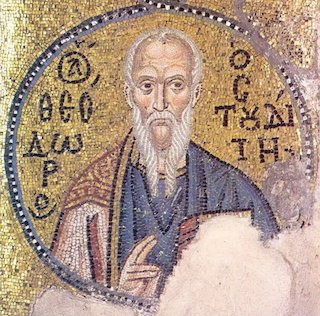
Irene brought back Theodore the Studite from exile. Bringing an end to the iconoclastic persecution made her highly popular among the people. The position of Irene was strengthened so much that the Frankish King Charles, who then was nearing the zenith of his fame, sought her hand. However, the political situation changed quickly. The West grew stronger, and Byzantium continued to weaken. In 802, Irene was dethroned and sent into exile. At the end of 814, the soldiers desecrated the icon of the Savior, which was placed over the palace gate in Constantinople. The emperor ordered its removal. Patriarch Nicephorus refused to do so, and he called a Council of 70 bishops at night, which ended with a prayer in the Church of St. Sophia to avert a future catastrophe. Following this, Patriarch Nicephorus was deposed and exiled, despite the protests of other bishops and a stirring speech by Theodore the Studite denouncing the emperor’s actions.
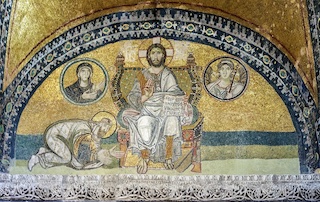
In 815, the new Patriarch Theodotus solemnly proclaimed in the cathedral of St. Sophia the lawfulness of the iconoclastic edicts. This provoked a reaction, with ensuing closings of monasteries, confiscations of their lands, exiles and even executions of the monks. The authorities also arrested Theodore the Studite, who courageously addressed the emperor: “Leave the Church to pastors.”[156] The monastery, where he had been the abbot for many years and established a school and a hospital, was destroyed. For a long time, Theodore was held in dungeons and subject to tortures, yet he continued to resist. As a result, he was exiled and was able to return to Byzantium only many years later, where he died in 826.
However, the persecution was gradually subsiding. The wife of Emperor Theophilus, who came to power in 829, was an iconodule. In 843, she helped elevate the monk Methodius to the see of Constantinople. He convened a Council, which reaffirmed the decisions of the Seventh Ecumenical Council on the veneration of icons.
This concluded the story of heresies in the Eastern Church. After a long struggle with Arianism, Nestorianism, Monophysitism, Monothelitism, iconoclasm, and other heresies, Orthodoxy finally prevailed. For the first time, on March 11, 843, the Church celebrated the triumph of Orthodoxy. Since then, this event is celebrated annually on the first Sunday of Great Lent, which is called “The Sunday of the Triumph of Orthodoxy.”
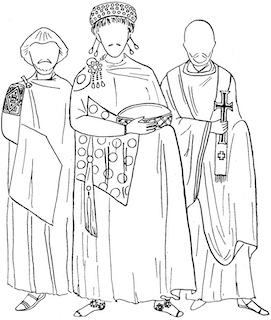
However, in addition to the positive results of the development of Byzantine Christianity, its highly negative consequences were made manifest as well. The fact that the emperors became the decisive arbiters in the life of the Church, and that the fate of Orthodoxy depended on their will, testified to the victory of caesaropapism in Byzantium. Beginning from the 9th century, Christianity of Byzantium was increasingly distancing itself from the world, moving to Mount Athos, into the deserts, and behind the strong stone walls of monasteries. The active spiritual participation of the laity, which favorably distinguished Byzantium from the barbarian peoples of Europe of the 8th century, was, too, disappearing from the life of the Church. The level of theological education, as well as general literacy, which had hitherto been almost universal, was in sharp decline. Orphanages, almshouses, free schools, and homes for the poor—all that Christianity had once brought with it to the Byzantine Empire—fell into disrepair and were gradually disappearing. The spiritual life of the East began to fade. The legacy of the Greeks and that of Byzantium, would soon be passed on to the Slavs. It would fall to them and the peoples of Western Europe to determine the future of the Church.
As we have seen, the Church life of Byzantium had mixed results. The strengthening of the Orthodox faith and the successful overcoming of heresies on one hand was accompanied by the aggregation of Christian spirituality behind the walls of monasteries and a moral decline in society on the other.
And what was happening in the West with the Roman Church?
Rome was in a difficult position. Byzantium, despite its decline, still sought to end the independence of the see of Rome and assume the leading position in the life of the Universal Church. The Arabs cherished the idea of seizing new European lands. The Germanic tribe of the Lombards, having invaded Italy at the end of the 6th century, dreamed of Roman treasures; the danger of their attack, like the sword of Damocles, constantly hung over the city. The other Germanic tribes, the Franks, were unpredictable: at any moment they could easily turn out to be either allies or enemies of the pope.
Pope Gregory III, who courageously opposed the iconoclastic heresy forcefully imposed by Leo the Isaurian, began to see the Franks as the only defenders of the Roman see from Byzantium and, most importantly, from the onslaught of the Lombards. He sent a letter to the Frankish commander Charles Martel asking for help, pointing out the greatness and sanctity of his cathedra.
There turned out to be no need for the intervention by the Franks after all. The fleet sent by Leo the Isaurian against the defiant Rome was scattered by a storm, and an agreement was finally reached with the Lombards. In 741, Pope Zachary I ascended to the see of Rome. Seeing the growing power of the Frankish kings and still fearing the intrigues of Byzantium, the pope actively sought to strengthen the Church’s influence among the Franks. He sent there Bishop Boniface (680–754), who would later be canonized as a saint by the Church. Boniface had always dreamed of being a missionary among the Gentiles and was ready to give his life for the preaching of the Word of Christ. But the far-sighted and politically savvy pope had other plans: not so much to turn the baptized Franks away from their pagan way of life but to spread and strengthen his own influence.
Boniface is sometimes called the apostle of the Germanic peoples. Pursuing a policy of unification under the auspices of the see of St. Peter, he first of all sought to bring the Franks back to the path of true Christianity. To this end, he called a council of the clergy, at which he forbade priests to carry weapons, participate in wars or hunt, and also introduced celibacy for the clergy.
Meanwhile, Zachary I, quite satisfied with the fact that the Frankish Church had sworn allegiance to him, sought an even closer rapprochement with their king. He had no further use for the aged Boniface and allowed him to go and preach to the pagans in Frisia, where the missionary met a martyr’s death. Both the pope and Martel’s son Pepin the Short took advantage of the fruits of Boniface’s labors. Pepin, in particular, relying on the increased authority of the pope, decided to assume the throne by overthrowing the ruling Merovingian dynasty. Zachary I, in 752, officially anointed Pepin as king by the hands of then-living St. Boniface. However, the decisive moment for the future empire arrived during the term of the next pope, Stephen II (752–757), when the Lombards advanced on Rome. The city of St. Peter was on the verge of destruction, and Stephen immediately headed to France to see Pepin. There, their historic meeting took place: the representatives of two future hostile worlds—the German Empire and the Papacy—fell to their knees before one another. Stephen anointed Pepin a second time and legitimized his dynasty.
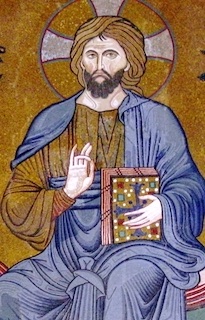
Subsequently, Pepin appeared in Italy, and the Lombards were forced to retreat and sign a treaty. But as soon as he left, Rome was besieged again. Who could possibly come to their rescue? Certainly not Byzantium, where iconoclasm was rampant at the time. The only choice that remained was Pepin. Pope Stephen sent him one desperate letter after another, saying that the king owed his coronation to the Apostle Peter. His letters, however, went unanswered. Then, the clever pope wrote a message that was more effective than all the previous ones. It began with the words:
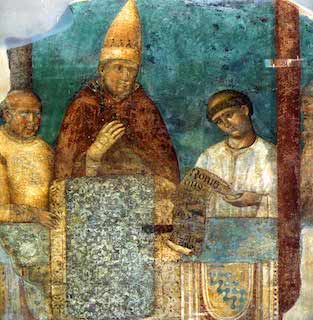
“Peter, called to be an apostle by Jesus Christ, the Son of the Living God, to three most excellent kings… For this reason, I, God’s apostle Peter, have you, Franks, as my adopted children, as a people entrusted to me by God… Think not otherwise, beloved, but only that I am standing before your very eyes as my own self, as if living and acting in my flesh… I entrust to you the city of Rome, the sheep of Christ who inhabit it, and the Holy Church, whom the Lord has given to my care. See that you make haste, not wasting a moment, to quickly set it free from the wickedness of the Lombards.”[157]
This remarkable letter touched the hearts of the simple-minded Franks. Pepin’s troops advanced to Italy and defeated the Lombards. Rome was saved. Furthermore, Pepin, in gratitude for his coronation, gave the pope the territories that previously belonged to the Byzantine emperor (Ravenna, Ancona, and twelve other cities). Thus, in 756, the papal state was formed. The Pope became not only the supreme spiritual shepherd but also a secular sovereign. Rome became finally separated from the East.
In 768, Pepin the Short, on whom the pope had bestowed the title of patrician, a protector of Rome, was succeeded by his son, the clever and decisive Charlemagne, or Charles the Great (742–814), who immediately attracted the attention of the entire Christendom. In Byzantium, a party was formed that sought to form an alliance with him. The powerful Caliph Harun al-Rashid sought his friendship. As to the popes, their attitude towards Charles remained ambivalent. On the one hand, he could prove to be a reliable defender of the faith and the Church. Yet at the same time, his successful policies aimed at expansion and his growing power also made him a dangerous opponent of the papacy. It was then that the cunning Pope Stephen II remembered about the “Donation of Constantine.”
It is difficult to say when exactly the legend about the “Donation of Constantine” first appeared. Scholars have not yet reached a consensus. This legend speaks of a miraculous deliverance of Emperor Constantine the Great from leprosy through the prayers of the Roman bishop Sylvester (314–335). In gratitude for his healing, Constantine the Great allegedly bequeathed to the vicars of Peter the “power and honor imperial,” “the supremacy” in relation to all other churches, as well as the right to all the western lands, which henceforth belonged to the Roman see. Then, according to the legend, Constantine the Great “transferred his kingdom to the east.”[158]
The first extant manuscript of this “charter of Constantine” dates back to the beginning of the 9th century, which approximately marks the time when the Donation began to play an important role in shaping the relationship between the Western Church and state. However, the document received considerable criticism from the very beginning. At first, its critics challenged the content of the letter without disputing its authenticity. They pointed out that Constantine never relinquished his power over Rome, that he was baptized at the time when Arianism became predominant, etc. Only in the 15th century, the authenticity of the document came into question, and in the 19th century, Catholic theologians finally arrived at the conclusion that the document had been forged.
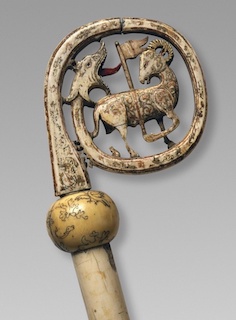
According to some scholars, the letter dates back to the time of Pope Stephen II. Such a document could help the pope to assert his claims to land and power in view of the rising political might of Charlemagne. It prevented the Frankish kings from repossessing the “once-donated” lands and also kept in check the claims of the Byzantine emperors to Italy. In his negotiations with Charles, Stephen II constantly insisted that he merely sought to “uphold and maintain justice” by reinstating the rightful ownership of what was unduly taken away from the Church. He could then present the “Donation of Constantine” to further bolster his case.
Charlemagne was favorably disposed towards the Church, comparing the Church to the soul of man and the state to the body. In the emperor of the Franks, the Roman Church and the papal state received a staunch defender of its land possessions. The emperor legalized the church tithe, which began to be levied on the entire population.
Despite the emperor’s support for the Church, the attempt of the Roman see to establish itself in power still failed, even with the help of the legend of the “Donation of Constantine.”
From his initial mission of the “protector of the Church,” Charles quickly turned to subduing it to himself. He exploited the evangelism to strengthen the political influence of his state. Proclaiming the spread of Christianity as his banner, Charles began devastating wars, seeking to conquer all of Europe. The scholar and theologian at the court of Charles, Alcuin (c.735–804), pinned great hopes on his campaigns as a means of spreading Christianity, and not in vain: the victorious war with the Saxons led to their adoption of the Christian faith and uniting with the Franks into a single nation. Charlemagne subdued all of Italy to Rome, most of Germany, and the entire territory of modern France. The Song of Roland proudly states that after Charles’ campaign, there were no more pagans left—all were baptized, except those who were “hanged or burned or otherwise put to death.”[159] The same fate befell the other nations conquered by Charlemagne.
In domestic politics, Charles showed himself to be as much an outstanding statesman as he was a military leader. Having significantly increased the territory of the empire, he began to implement social and religious reforms with zeal and determination.
Despite the fact that Boniface and Pepin had previously tried hard to raise the moral level of the clergy, little had changed by the time of Charles’ reign. Clerics continued to lead essentially a secular lifestyle, were fond of hunting, and took part in military campaigns. Licentiousness prevalent in the society of that time was common among the clergy. Therefore, being determined to continue the work of Boniface, Charles could not rely on the clergy for his domestic reforms. Moreover, he completely disregarded the ecclesiastical authorities. Incessantly reading St. Augustine’s “City of God,” which became his reference book, Charles dreamed of a state system where two types of power—the secular and the ecclesiastical—would coexist, but with the absolute predominance of the secular power. At the same time, Charlemagne built the state on the religious foundation; it was obvious to him that the state system should be subject to Christian principles. The very fact that Charles wanted to accept the imperial crown from the pope is quite telling.
Charlemagne can undoubtedly be called one of the most outstanding Christian rulers. A man of keen intellect, broad views, and many talents, he seemed to be called upon to lay the foundation for the City of God on earth, to build a “Christian empire.” Despite the fact that Charles Christianized the peoples of Europe with the help of the sword, he also made great efforts to reform the morality of society and the Church. Charles did everything possible to raise the level of pastoral preaching, to make it more accessible to the common man and serve as his guide in life. He categorically forbade the clergy to take part in secular affairs, such as trade and wars, and to visit inns and taverns. Simony, that is, the sale of ecclesiastical offices, was also severely punished. Charles encouraged charity and care for the poor. The vision of the perfect City of Christ was his source of inspiration.
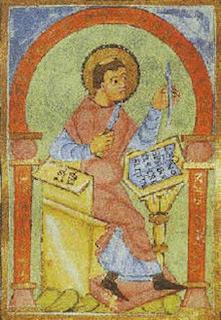
Charles paid special attention to the development of culture. At that time, Byzantium had an unconditional superiority over the West in the areas of education, science, and art. Among the achievements of the Eastern Empire were the cathedral of St. Sophia, the hymns of John of Damascus, the works of such outstanding theologians as Maximus the Confessor, Theodore the Studite, and Pseudo-Dionysius the Areopagite. Meanwhile, in the West, the Franks, by their own admission, remained in the darkness of ignorance. Charles was not content with this situation and made every effort to develop religious and secular culture. During the fourteen years of his reign, the culture of the West experienced an unprecedented rise, called the “Carolingian Renaissance.” At its head was the English scholar and theologian Alcuin who possessed an encyclopedic knowledge and was specially invited by Charles from York, along with other famous scholars. Following Charles’ call not only to not to neglect scholarly pursuits but, with all meekness and good intentions before God, to “devote oneself to them gainfully,” Alcuin founded a palace school in Aachen, where the children of the royal family and the highest courtiers could receive a decent education.
Alcuin’s educational activities were not limited to the circle of the nobility. Drawing on the Roman educational system, Alcuin laid the foundations for future medieval schools and universities. He also introduced primary education for common people, which was based on the Bible. During that period, the New Testament began to be translated from incomprehensible Latin into the local vernaculars, the canonical text of the Bible was unified, liturgical reform was carried out, and the single Roman model of church services was adopted throughout the empire. On Alcuin’s advice, Charlemagne called upon the popes to set up monastic schools to train interpreters of the Holy Scriptures.
The efforts of Charlemagne and Alcuin gave a powerful impetus to the development of philosophy and theology. The foundations of scholasticism began to be laid at that time—a theological system that would reign supreme in Western thought for several centuries. The greatest representative of pre-scholasticism, as scholars call the period from 800 to 1050, was John Scotus Eriugena.
John Scotus Eriugena was born in Ireland. Little is known about his life, even though numerous works of this outstanding thinker remain. He is known as the translator of Gregory of Nyssa and Pseudo-Dionysius into Latin, with his comments on the latter. There are also John Scotus’ commentaries on the Gospel of John and on the works of the philosopher Boethius. Eriugena, too, wrote a treatise on the liberal arts.
In his treatise “On Divine Predestination,” completed in 851, Eriugena argues that predestination exists only for good and not for evil. Because of free will granted to people, they can sin, but evil, not being a physical reality, is never predetermined by God.
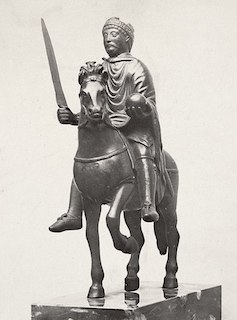
The main work of John Scotus is the book on “The Division of Nature.” Written between 862 and 866, it is a dialogue between a teacher and a student. It is strongly influenced by Latin and Greek Platonic authors, such as St. Augustine, Pseudo-Dionysius, and Maximus the Confessor. It has five parts: in the first, the author reflects on God and His unknowability; the second discusses various questions of existence, created and uncreated; the third is devoted to the manifestations of God in the world, and the fourth and fifth are related to the destiny of man—his initially sinless state, the fall, and the return to God in Christ.
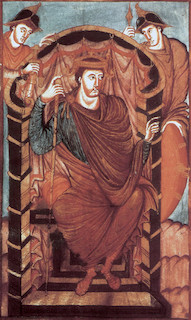
John Scotus considers faith to be a prerequisite for knowledge, although the knowledge of God is impossible outside His manifestations. God is “Superexistence”, “Superintellectuality”, “Supervitality.” God is present in all creation but does not merge with it: “He makes all things [without] ceasing to be above all things, and thus makes all things from nothing… from His Superessentiality.”[160] Having a rationalistic mindset and bowing to reason, John Scotus at the same time stands on the threshold that separates rational knowledge from mystical insight. Reason itself is nothing, and only in the light of the Divine Word can it be accepted as a guiding principle. But what is the Divine Word? First of all, it is the God-inspired Holy Scripture. On the other hand, according to the ideas of the Church at that time, the Divine Word was inseparable from the authority of the Church and her teachers. However, Eriugena views the mind of each person as primary in nature, giving it preference over the heritage of the Church Fathers. Thus, Eriugena builds the hierarchy of the process of ascertaining meaning: the highest being the Holy Scripture, followed by reason, and then the authority of the Fathers.
A difficult fate awaited Eriugena’s writings. His work “On Divine Predestination” was condemned by the local councils of the 9th century. The philosopher’s ideas about the omnipresence of God in the world led to him being accused of pantheism: Eriugena’s main book on “The Division of Nature” was condemned by local councils of the 13th century and sentenced to be burned. First published in Oxford in 1681, it was immediately placed in the “Index of Forbidden Books.” Although pantheistic tendencies are indeed strong in Eriugena’s writings, affecting not only medieval but also Renaissance and even modern thought, his synthesis of theology and Neoplatonism became an important milestone in the development of Western European philosophy.
Despite all the apparent achievements of Charles, his plans to create an enlightened and happy Christian empire failed and instead led to some rather sad results. When the emperor extended his power to Italy, the see of Rome, having escaped the Byzantine dictate, fell under the Germanic one instead. While assigning the pope a place of honor, Charles, in reality, positioned himself much higher. Like the Byzantine emperors, he thought it possible to provide guidance to the Church on dogmatic matters. When, in 800, Pope Leo III gave him, then still a king, the imperial crown, Charles in fact became the dictator in the “City of God” that he was creating. As to the popes, they were relegated to being mere puppets in the hand of the emperor. In declaring Christianity to have the power of law, Charles imposed punishments for violating it. As a result, Western Christianity, like its Byzantine counterpart, became a purely external and easily controllable attribute of state power.
It is not surprising that such Christianity did not become the inner religious backbone of the empire. Following the death of Charlemagne, the state began to decline. Already in 817, the son of Charlemagne, Louis the Pious, divided the empire among his three sons, retaining only his right to the supreme power. The internecine feuds of the grandsons of Charles led to a further division of the empire in 843 (the so-called Treaty of Verdun). In the newly formed territories, the future largest European states—France, Italy, and Germany—began to take shape.
After the break-up of Charlemagne’s empire, the papal state initially gained some political advantage. Already commanding a certain level of influence, the papacy, freed from the dictates of the all-powerful emperor, became an independent political entity in the international arena. In the ensuing years, Rome itself dictated military and political decisions to the European rulers. This situation, however, did not last long.
The collapse of the Carolingian Empire plunged Europe into a state of feudal fragmentation and decline. Dozens of independent kingdoms appeared, each becoming increasingly isolated and waging continuous wars against its neighbors. Besides, Europe was under constant attacks by the Normans, which prevented trade and normal economic life.
This greatly shook the position of Rome, which perceived itself as a political force. Earlier, Charles dictated his will to the pope but, at the same time, provided the see of Rome with protection, viewing it as an important instrument of his policies. Now, the papal state was left to fend for itself. The Holy See became an arena of clashing interests of feudal lords in their struggle for power and influence. A sharp decline in the morals of the higher clergy ensued, and corruption increased. The most monstrous stories circulated about the mores prevailing in Rome. Bishops, archbishops, and abbots, after the example of secular feudal lords, commanded troops, hunted, and lived in luxury and debauchery. Once again, simony became widespread: not only the rank of cardinal but even that of the pope could be bought with money. Over the next 150 years, 50 different vicars ascended the throne of St. Peter.
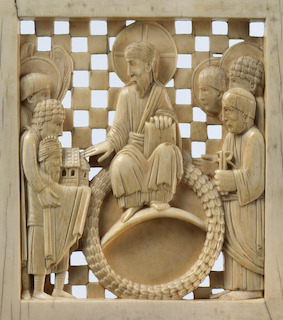
Already in the 60s of the 10th century, Pope John XII tried to save the papal state, torn apart by the feudal lords, and retain his power. Supported by the reformist party, John XII turned to the German King Otto I for help. At this time, the king made attempts to restore the Roman Empire and continue the unifying policy of Charlemagne. The German king had already captured Normandy and defeated a strong Hungarian army; significant European territories fell under his control. Aware of the king’s deep religiosity, the reformists in Rome hoped that his arrival would restore the papal authority. Eventually, Otto I marched into Italy and defeated the feudal armies. In 962, he was crowned by John XII. The creation of the Holy Roman Empire, headed by the German King, was announced the same year. By a special treaty, Otto I recognized the pope’s claim to secular possessions in Italy, but the emperor was proclaimed their supreme seigneur. The mandatory oath of the pope to the emperor was introduced, signifying the pontificate’s subordination to the empire. The secular authority, in essence, had arrogated to itself the right of “investiture”—the appointment and confirmation of hierarchs in the Church. During the appropriate ceremony, the bishop had to kneel before the secular sovereign and receive from him a ring and a staff as a sign of his authority. Thus, the Church in the West fell into complete dependence upon the state.
At the turn of the 10th and 11th centuries, when the Western Church was in the midst of a profound crisis, a new religious movement, aimed at changing the situation, began. A monastery at Cluny in French Burgundy became the center of this struggle for the Church’s revival.
The Cluniac reforms sought to strengthen the Church organization, put its material base in order, and strictly regulate the relations of the Church with the secular authorities. The Church, the reformers believed, should free itself from the control of the state and become, as once under Pope Nicholas I, an independent force. To this purpose, the Pope, as the vicar of God on earth, needed to be proclaimed the supreme arbiter in secular and worldly affairs.
Monasteries began to be confiscated from the ownership of laymen and bishops alike, which contributed to the centralization of the Church’s administration.
In addition to strengthening the legal and economic status of the Church, the Clunians demanded a radical change in her internal, spiritual life. They advocated the strictest observance of ecclesiastical vows, severely condemned any sales of ecclesiastical offices, denounced the mores of the clergy, and demanded celibacy for them. During the reform period, at first a cautious, covert, and then an open struggle began against two of the most common and shameful phenomena of the Middle Ages: trials by ordeal (“judgment of God”) and the atrocities of the feudal lords.
The “judgments of God” consisted in “testing the innocence” of a defendant with fire, water, hot iron, and other savage means. The belief in the efficacy of such methods to determine one’s guilt was extremely strong, and the Church had great difficulty in putting an end to ordeals: the hatred of witches and heretics, stemming from the pagan superstitions of ignorant and uneducated commoners, was widespread. Thus, according to the annals of a medieval monk, in the 11th century, “on the king’s orders and with the consent of the whole people,”[161] several freethinkers were burned (in a few centuries, the practice of burning heretics at stake would become commonplace).
The hopes of the Clunians had a strong mystical undertone: the end of the world was anticipated by the year 1000. The anticipation of the Second Coming of Christ and the establishment of His Millennial Kingdom (such sentiments are called chiliastic or millenarian) intensified among the people. Ascetic tendencies, the desire for a pure life and atonement of one’s sins, too, became widespread.
The ascetic ideal seemed to many Christians to be the only way of salvation, especially against the background of savagery, so common among the feudal lords and the clergy. The mendicant monastic communities grew at an unprecedented rate. Christians passionately committed themselves to the exploits of self-denial and asceticism, as they once did at the dawn of monasticism. Itinerant preachers roamed all over Europe, calling for repentance and denouncing those in power; religious and mystical aspirations were accompanied by spontaneous demands for social justice. Thus began a powerful popular religious movement, which ended only in the 13th century.
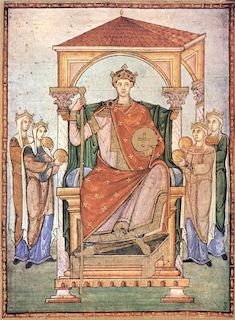
The Church under the influence of the Clunians tried to overcome or at least moderate the mores that prevailed among the feudal lords in relation to each other and especially towards their disenfranchised poor. In 1027, a local Council banned war and military action for at least one day a week, and declared “anathema to him who plunders the property of the poor.” The Council of 1041 developed in detail a system of periodic truces, the so-called “Peace of God.” This was a significant development for the feudal society, where wars of “all against all” were continually waged. The Cluniac monks also paid great attention to the education of clergy, for the purpose of which the clergy training schools, characterized by strict discipline, were organized at the monasteries.
The Clunians’ idea of the necessity of peace in the bosom of the Christian Church along with their belief in the primacy of the cathedra of St. Peter revived the old aspirations of building the City of God here on earth. Humanity, the Church believed, ought to live in a single union under the banner of God-rule, theocracy. However, the City of God was understood as the visible Church, the church organization, hence the need to achieve political freedom and independence of the Church. Such grandiose plans could only be carried out under the leadership of an unusually strong figure, which would combine the firmness and foresight of a politician with a commitment to the best cultural and religious traditions. The Church found such a figure in the person of the Clunian monk Hildebrand, the future Pope Gregory VII.
The future pope was born into a poor Italian family, in a small town in Tuscany. Like the Apostle Paul and John Chrysostom, he was small in stature and rather plain in appearance. He was educated at the monastery of St. Mary in Rome and was ordained a Benedictine monk.
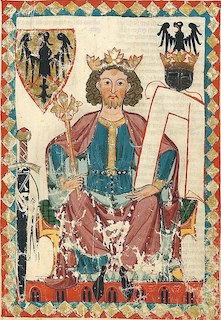
The ardent and impressionable young monk (no wonder he chose the name Hildebrand, which means “a bright flame”) was deeply impressed by the reform initiatives of the Clunians. Since that time, he nurtured grandiose plans to reform the Church. Thanks to his outstanding abilities and fame, Hildebrand became an assistant to Pope Gregory VI in 1046 and accompanied him during his exile to Germany. After the death of Gregory VI, he settled in one of the Cluniac monasteries, where he received further mental conditioning and became even more uncompromising. For example, when the emperor appointed the Clunian Leo IX as pope, Hildebrand apparently insisted that the newly elected pope should seek endorsement from the people. Accompanied by Hildebrand, Leo IX arrived in Rome clothed as a penitent and announced that he would not accept the see until the people’s assembly removed his guilt of being appointed to the papacy by a layman. From then on, Hildebrand became the most influential figure who largely determined the reformist policies of several popes. Having renounced his pretensions to the Holy See, he, as an archdeacon, held the position of papal treasurer and, in fact, exercised control over the election of each new pope.
After the death of Leo IX in 1054, in the atmosphere of turmoil, civil strife and anarchy, Hildebrand launched his tireless activity. Believing that the reform of the Church was too important a matter for the world’s future, he made extensive use of all means possible in his struggle, including rather dubious ones. Thus, in order to undermine the dependence of the Holy See on the Italian feudal lords, the archdeacon, with generous cash handouts, turned the population of Rome against Pope Benedict X, who was installed by the barons. Hildebrand sacrificed him to his cause. The pope was deposed and died a pauper in a poorhouse, and the feudal lords were no longer allowed to choose the pope. As a result, Hildebrand was able to put an end to the practice of simony.
In another case, Cardinal Humbert (this name will be mentioned later when we talk about the final separation of the Churches), an advocate of celibacy, advised Hildebrand to prohibit the laity from attending the services by married priests, who should be humiliated in every way possible. To this end, gangs of patarines (ragamuffins) were engaged in looting throughout Italy. Humbert’s idea led to success—slowly but surely celibacy was becoming established in the church practice.
After the death of Pope Alexander II in 1073, Hildebrand finally agreed to take the papal throne himself under the name of Pope Gregory VII. From that moment, he began to pursue his active church policies, which would largely determine the fate of the Church, and of Europe as a whole.
Hildebrand’s first act as pope was the final prohibition of marriage among the clergy. He considered it necessary to free the clergyman from the family, which distracted him from religious affairs, and thereby increase the morality of the clergy. These were the darkest pages of Gregory’s papacy: there were robberies, arsons, and murders of married clergymen. Curses and prophecies were hurled in vain at the pope, who remained true to his credo: “the end justifies the means.”
Next, Gregory had to realize the final and most difficult step of his program—to elevate the see of Rome to its former height. Steadily implementing his policy of subordination of secular states to the Holy See, the pope also pursued an active foreign policy. He led negotiations with Byzantium and even established contacts with the princes of Russia. He assured the Spaniards that their Church had been founded by Peter and Paul, and therefore inevitably belonged to the jurisdiction of Rome. In the Kingdom of Poland, where the influence of Rome greatly increased, Gregory excommunicated and deposed King Boleslaw the Bold. Thus, Gregory was making it increasingly clear that the pope was the king of kings, and the Roman Church was the mother of all churches.
However, his dream of having the supreme world power, where the high priest would wield both the spiritual and the secular swords, inevitably put Gregory VII on the collision path with the interests of the German Empire, which refused to be content with such state of affairs. A life-and-death struggle ensued.
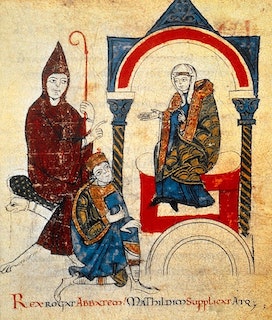
Emperor Henry IV not only refused to stop the practice of selling ecclesiastical positions, but also, having convened the Synod of Worms in 1076, rejected the papal authority. In response, the pope excommunicated him, removing from all German feudal lords their obligation of being loyal to Henry. “The pope would rather give his life than leave the royal crown on the head of an impenitent sinner,” Gregory declared. Henry was soon abandoned by most of his vassals, and his position became dire. Sensing that it was impossible to fight the pope, he himself went to Italy and arrived at the castle of Matilda in Canossa. Gregory VII fortified himself there, waiting for the emperor to attack. Instead, “laying aside his royal garb, with nothing of the king in his appearance, with no display of splendor, with bare feet, [Henry] remained fasting from morning to evening, waiting for the judgment of the Roman pontiff.”[162] There could be no greater humiliation of the empire before the papacy. After some hesitation, the pope finally forgave Henry.
However, Henry’s humility was ostentatious. As soon as the political situation changed in his favor, the conflict flared up with renewed vigor. This time, success was on the emperor’s side. Riots broke out in Rome, and Gregory VII had to flee. His death came at a time when a new pope had already ascended to the throne of the Roman Church.
Despite the defeat of Gregory VII, his idea of freeing the Church from state dependence had already acquired flesh and blood and received its final approval at the First Lateran Council of 1123. The reforms advocated by Gregory VII and the Clunians not only had a strong impact on the position of the Church in relation to secular authorities but also led to a number of promising changes in the internal life of the Church, her spiritual and cultural character.
None of the reforms would have yielded results had the Western Church not realized the need to improve the religious culture of its people and promote education of the superstitious and illiterate masses. In addition to organizing schools for clergy, some scholars in monastic circles began to study classical philosophy and read the works of Jewish and Arab thinkers. The monks were supported in their educational efforts by some popes, especially Sylvester II, who occupied the Roman see from 999 to 1003, and later Gregory VII.
Following the prior period of decline in monasteries and ecclesiastical schools, the reformed clergy zealously took up the sciences. The soldier bishop type was a thing of the past. By the end of the 11th century, there were more prominent philosophers, theologians, historians, and poets in the Western Church than in the previous several centuries combined.
The future spiritual and cultural heritage of the Church was being prepared in the quiet of monastery schools and libraries. Especially famous in this regard was the monastery school in St. Gallen, in what is now Switzerland. The bulk of work of book copying was carried out there. The monastery libraries held great treasures of world culture; in addition to Christian literature, there were also works of classical and Arabic authors. Not only the monks but also the nuns were engaged in the transcription of books.
New pedagogical principles were being developed in monastic schools. If previously, the key to the success of education was seen in the severity of the teacher, now influential thinkers, in particular the famous philosopher and educator Anselm of Canterbury, challenged the view that the correcting rod was the basis of education. He especially insisted on giving students the opportunity to develop independently. Artificial and harsh conditions, he said, cripple souls.
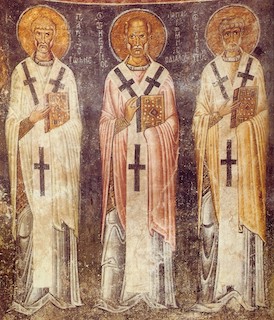
In the field of theology, scholars sought answers to the most pressing questions of the moral and religious life of the day, addressing chiliastic tendencies and the needs of ascetic movements.
Translations of Greek writers, especially John of Damascus, provided an inexhaustible source for new ideas and reflections. The rapid development of Arab philosophy demanded a worthy Christian response. Philosophers sought new forms of expressing theological concepts, directing their inquiries primarily on determining the limits of the knowable and exploring the relationship between reason and faith.
The philosophical and religious quest of this epoch found its fullest expression in the conceptual system of the outstanding philosopher and theologian Anselm, bishop of Canterbury (c.1033–1109).
Anselm lived a long and eventful life. He was a prominent ecclesiastical figure and thinker, a promoter of the ideas of Gregory VII in England. In 1099, he attempted to strengthen the unity of the Churches, and shortly before his death, he witnessed the first campaign of the Crusaders headed to Palestine.
Anselm fully re-introduced the ideas of St. Augustine into theology. Paying tribute to the nascent infatuation with rationalism, Anselm sought to prove the existence of God by pure reasoning. At first, Anselm considered his desire to be a temptation, but in the end, in his book “Proslogion,” he presented the rational proofs of the existence of God as he perceived them.
The first proof of Anselm comes down to the concept of the absolute, perfect Good and Goodness. The Good manifests itself in the most diverse aspects of existence. But it must also exist in itself as an independent supremely good being. This Being is God.
The second proof is associated with causality in nature. Whatever exists in the world must have a cause. The world, as the totality of things, must also have a cause, but one that is itself causeless and possesses creative power, that is, capable of becoming a cause itself. This unconditional ultimate first cause is God.
The third proof stems from recognizing and distinguishing the degrees of perfection (or reality). One object is more perfect than another, and since there is such a thing as relative perfection, there must also exist absolute perfection, which is God.
Finally, Anselm outlines his fourth proof as follows: “Even the fool is convinced that something exists in the understanding, at least, than which nothing greater can be conceived…. And assuredly that, than which nothing greater can be conceived, cannot exist in the understanding alone. For, suppose it exists in the understanding alone: then it can be conceived to exist in reality; which is greater…. Hence, there is no doubt that there exists a being, than which nothing greater can be conceived, and it exists both in the understanding and in reality.”[163]
Anselm’s desire to formulate the fundamental provisions of Christian doctrine into a rational framework brought medieval theology closer to the patristic heritage. At the same time, Anselm himself did not overestimate the power of reason. An unconditional supporter of dogmatic authority, Anselm believed that his proofs were completely superfluous for the Christian faith. Indeed, the martyrs did not go to the stake in the name of an “ultimate cause” or an “indispensable consequence.” Only when faith becomes a living experience that it can refer to its rational and logical presuppositions. Therefore, theology is only a theoretical generalization or conceptualization of faith. One must, in the words of Anselm, “believe in order to understand.”[164] In addition to the questions about the logical justification of the Existence of God and His manifestations in the world, Anselm of Canterbury developed in detail the doctrines of original sin and atonement. His treatment of these two topics greatly influenced the future development of scholasticism.
Anselm’s understanding of the problem of evil and free will was also unusual. Whereas freedom had been traditionally regarded as the freedom to choose between good and evil, Anselm based his views on the teachings of the Apostle Paul and St. Augustine: every good has God as its author, and true freedom is the freedom to maintain good. The mystery of the Holy Trinity was also the subject of his reflections: he saw the Divine Logos as the eternal self-knowledge and self-love of God.
Whereas John Scotus Eriugena only approached the essential methods and ideas of scholastic theology, Anselm of Canterbury is often called the father of scholasticism. Recognized as the greatest Western theologian in the period between St. Augustine and Thomas Aquinas, Anselm of Canterbury had a significant influence on many prominent theologians and philosophers, including some modern ones.
It was the period of the last cultural heyday of Byzantium. The time was quickly approaching when it would become a mentor of other nations large and small, passing its spiritual heritage on to them. Byzantine missionaries took the Christian message all over the world, traveling to distant lands—to Arabs, Jews, and Slavs. Pilgrims from those countries, too, visited Byzantium. Struck by the grandeur and beauty of the ancient empire, many of them converted to Christianity. Byzantium, that “elegant Paris of the Middle Ages,”[165] as it is sometimes called, fulfilled its mission with honor.
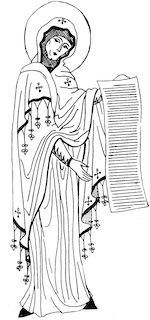
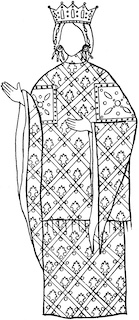
By the time of Patriarch Photius, the empire had practically regained its former greatness. The borders were well protected, the government apparatus was strengthened, and the power of its monarch—basileus—reached its apogee. At the court, classical trends came into fashion, giving that era the name of the “Byzantine Renaissance.” The capital sparkled with its fabulous luxury and splendor.
The spiritual life of the Eastern Empire had also awakened. Scholars, theologians, philosophers, poets, historians, and orators were creating masterpieces of literature and art. Emperor Constantine VII Porphyrogenitus, who occupied the Byzantine throne from 913 to 959, had a remarkable literary talent: he wrote a number of medical, historical, and agricultural treatises. He was one of the first to treat history not as an abstract study, but as a concrete field of knowledge necessary in practical life. He compiled many lives of saints, similar to the famous poet Symeon the Metaphrast, the author of a huge hagiographic collection based on legends and folklore. In the same era, the outstanding chronicler and historian Leo the Deacon wrote his “History,” and Archbishop Arethas of Caesarea collected the works of Greek thinkers.
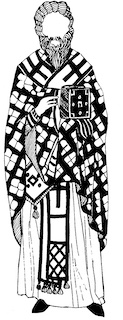
During this period, the influence of the Church on public life increased significantly. The union of the Church with the state was particularly strong, although the Church occupied a subordinate position in relation to the secular authorities. The election of the patriarch depended on the emperor, and the bishops were denied the right to own any real estate. The income of the Church was, too, determined by the graces of the emperor—these conditions did not allow clergy to become like feudal lords, as in the West.
Monasticism in Byzantium was incomparably more numerous than in the West. Each emperor, a prominent dignitary, or a military commander sought to build a monastery, endowing it with rich possessions. The largest monasteries intervened in politics, while prominent laymen sought the support of the monastic community in their struggle for power.
As in the West, the mystical sentiments intensified in Byzantium, especially among the disadvantaged masses. Many peasants, waiting for the end of the world, took monastic vows and devoted themselves to spiritual contemplation. Athos became the center of the spiritual and mystical life of Byzantium and later of the entire East.
The origin of this unique monastic republic in Greece, located on the shores of the Aegean Sea, goes back to the distant past. The settlement of the holy Mount Athos by solitaries began very early, perhaps in the 4th century. Monastic life here went through all the phases of development: eremitic monasticism, then the establishment of the lavra, and, finally, monastic communities with strict ascetic rules. The founder of the cenobitic monastic life on Mount Athos is considered to be St. Athanasius of Athos, who founded the famous Great Lavra, which was named after him in 960. In the 12th century, Athos was already becoming a recognized center of Byzantine monasticism, the center of the spiritual and mystical life of the East.
The founding of the Great Lavra is associated with the following legend. The Byzantine general Nicephoros Phokas, who was distinguished by his austerity of life, love of prayer and solitude, and the monk Athanasius, with whom the rugged soldier had developed a strong friendship, decided to spend the rest of their days in one of the monasteries. To this end, Athanasius chose Mount Athos, which jutted into the sea and seemed cut off from the rest of the world. Nicephorus’ life, however, turned out differently: he became the Byzantine emperor and got married. Athanasius greatly grieved over the “apostasy” of his friend. But even on the throne, Nicephorus Phocas continued to lead a modest lifestyle. Wanting to make amends, he gave every possible gift to the small monastery on Mount Athos. In 963, after other monasteries appeared there, Nicephorus issued a decree prohibiting the construction of new monasteries on Athos.
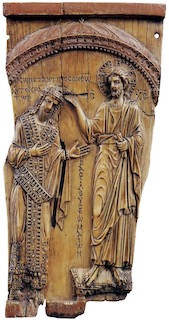
Athos would have a great future in preserving and enhancing the spiritual heritage of the East. Having survived centuries of enemy attacks and fires, the monastery, or rather several Orthodox monasteries, still exist today, attracting a large number of pilgrims. According to one historian, “From year to year, throughout the Christian East, the desire for seclusion attracted new crowds to Mount Athos, caused the proudest heads to bow to the austere Rule of Athanasius, and commanded an invincible charm even over the hearts of princes.”
Athos played a particularly important role after the fall of the Byzantine Empire in the 15th century when all the spiritual life of the Greek East was concentrated within the walls of the monasteries on this holy mountain.
Yet the efforts of the Athonite monks alone would not be sufficient to preserve and multiply the spiritual riches of Eastern Christianity. This mission, during the decline and future demise of the Byzantine Empire, would be assumed by the Slavic peoples.
As if anticipating the approaching decline and subsequent demise of the Byzantine Empire, Eastern Christianity began to spread and grow stronger among the younger peoples who were on the verge of attaining their statehood and religious and national identity. We are referring primarily to the spread of Christianity among the Slavs. That mission is inextricably linked with the names of two brothers, the future saints Cyril (c.826–869) and Methodius (c.815–885).
The two brothers were born in the Greek city of Thessaloniki, in the family of a prominent military commander close to the imperial court. Methodius, the older brother, served in the Slavic garrison, where he learned the local language. During the time of the struggle against the iconoclastic heresy, he became a monk, withdrawing to the monastery of Olympus in Asia Minor.
Constantine, the younger brother, from his early youth began to show extraordinary talent, excellent memory, and curiosity. As a boy, he fell in love with the writings of Gregory the Theologian, constantly read them, and knew many passages by heart. As a gifted student, Constantine was sent to the University of Constantinople, a Byzantine academy organized by Bardas at the imperial court. There, together with the young heir to the throne, Michael III, he learned from the best mentors (including the future Patriarch Photius). According to the life of this saint, “he was soon trained in all worldly wisdom: grammar and Homeric poetry, rhetoric and philosophy, arithmetic and astronomy, music and all Hellenic science, and was, to the surprise of his teachers, because of his quickness of mind, later called the Philosopher, because he excelled in philosophy above others. But not only was he skilled in the Hellenic language, but also in other languages: he studied the Roman writings well and the Syriac dialogues, and learned other foreign languages.”[166]
Seeing the brilliant talents of Constantine, the imperial dignitary Theoktistos wanted to marry him to his relative and promote his career at the court. However, Constantine had completely different plans. He secretly traveled to one of the monasteries on the seacoast and was tonsured a monk under the name of Cyril—as he would become known in the history of Christianity. Still, the young philosopher was persuaded that with his knowledge and talents he could be of great benefit to the Church without retiring to a monastery. Cyril returned to Constantinople and received the position of a teacher of philosophy and a librarian of the Church of St. Sophia. His great erudition and preaching talent allowed the young scholar to win several brilliant victories in disputes and made his name widely known. In 851, when one of the Muslim emirs asked the emperor to send him an experienced Christian mentor, the choice fell on Cyril.
Upon his return, Cyril spent several years in the Olympus Monastery, where his brother Methodius was the abbot. In 860, at the initiative of Patriarch Ignatius and on the instructions of the emperor, the brothers were sent to the Khazars at their request. The mission was a success: the brothers not only converted many Khazars to Christianity but also assisted in the return of captured Greeks to Constantinople.
In 863, during the patriarchy of Photius, the brothers traveled to the Slavic lands. This moment marked the beginning of the most glorious page in their lives. After laboring for three years, first in Moravia, and then in Pannonia, the brothers converted many pagans and built up the faith and moral norms of the new converts. However, their main contribution was the invention of the Slavic alphabet on the basis of Greek letters, which effectively makes them the creators of the Slavic language and its writing system. They translated the parts of the Holy Scripture used in the divine liturgy and the main church services into the Slavic language. Cyril created schools for young people, where the teaching was done in the Slavic dialect.
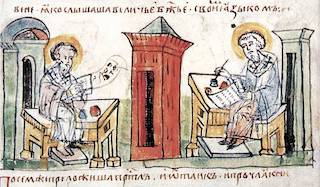
However, the missionary labors of the two brothers were greatly complicated by the confrontation between the Eastern and Western Churches, which intensified during that period. The Latinized German clergy, who had their sights set on the Slavic lands, fearing Byzantine influence, accused Cyril and Methodius of heresy. The pretext for the accusations was the introduction of the Slavic language into the divine liturgy; according to the German clergy, it was possible to give praise to the Lord only in three languages—Hebrew, Greek, and Latin—those that were used to make the inscription on the Cross of the Lord.
In 868, the brothers went to Rome to seek support from Pope Adrian II. The pope endorsed the missionary work of Cyril and Methodius, confirmed their right to serve in Slavic, and consecrated Slavic books. In Rome, Cyril, who was in poor health, fell ill and died. Before his death, he took a promise from Methodius that he would continue the work they had begun in Moravia.
Methodius, elevated to the rank of Archbishop of Pannonia, began to gradually expand his missionary activity. Meanwhile, political and ecclesiastical strife flared up. In 870, on charges of violating the hierarchical rights to Pannonia and Moravia, Methodius was summoned to a council of German bishops in Bavaria, where he was subjected to beatings and spent about three years in prison. Only in 873, the new Pope John VIII compelled the Bavarian episcopate to release Methodius. In the next six years, with the active participation of Methodius, the Slavic Church expanded significantly, covering the territories of Czechia and Poland. At the same time, the outspoken and principled Methodius fought against the licentiousness of the secular rulers, which set them against Methodius. As before, the German clergy continued to plot against him, accusing him of heresy. Yet the main opponent of Methodius became his own assistant, the German Wiching, ordained to the bishopric by the pope. Forced to defend himself from constant accusations, Methodius nevertheless actively engaged in church and teaching activities. In 883, he began to translate the full text of the Holy Scriptures and certain writings from the patristic literature into the Slavic language. Thus, in the midst of his labors and struggles, he met his death in 885.
Following the death of Methodius, his disciples were persecuted, along with the still fragile Slavic Church. As a result, Byzantine Christianity could not gain a foothold in the Western Slavic lands: the Western Slavs joined the Germanic-Roman world. Nevertheless, the mission of the Thessaloniki brothers was continued among the southern Slavs, where many of Cyril and Methodius’ disciples had gone to: the Serbs, the Bulgarians, and later the Russians, who in the near future would unite their destinies with the Byzantine Church. Cyril and Methodius would become the most beloved and revered saints not only in the Russian Orthodox Church, but also in all the Eastern Churches and, indeed, the entire Christian world.
By the time of Charlemagne, the estrangement between Western and Eastern Christianity became clearly visible, although the process of alienation itself had begun many centuries earlier. When Constantine the Great moved the capital of the Roman Empire to Constantinople in 330, he laid the foundation for a political and later ecclesiastical division of the empire into East and West. Emperor Theodosius in 395 instituted a separate administration of the western and eastern parts of the empire. The barbarian invasion and the fall of the Western Roman Empire at the end of the 5th century consummated the political division. The Church formally remained united, as was expressed in convening Ecumenical Councils, but as far as church governance was concerned, it also split into the Eastern and Western counterparts. As we already know, caesaropapism flourished in the East, where the emperors essentially ruled the Eastern Church, assuming the role of “popes.” In the West, the popes increasingly concentrated financial, military, and political power in their hands, turning into secular sovereigns (some historians define this situation as “papocaesarism”). Consequently, the Church in the East became a vital instrument and appendage of secular power, while in the West, on the contrary, the state was seen as an instrument of ecclesiastical authority.
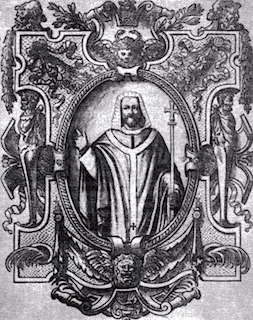
Unsurprisingly, this difference in views provoked ongoing conflicts. Another important reason for the schism was the internal struggle for primacy between the sees, each vying for greater influence in the Universal Church. Of the several largest bishoprics established in the first few centuries, the two stood distinctly out, representing Rome and Constantinople, the two capitals of the empire, locked in a centuries-long rivalry with one another.
An important, though not decisive, reason for such division was the theological differences that had long existed between East and West. The Greek consciousness leaning towards a more theoretical understanding of Christian teaching was engaged in the elaboration and formulation of complex theological doctrines. For this reason, most of the heresies that tore the Church apart were born in the East. The West, on the other hand, was more concerned with the issues of practical church life. As a result, the development of the Eastern and Western Churches had characteristic differences both in terms of formulation of religious and theological problems as well as their solutions.
The separation of the Churches traces back primarily to cultural, historical, and ethnographic reasons. Each local Church, to a certain extent, assimilated traditions, rituals, and the way of thinking of the local population. These traditions varied among different ethnic groups and different regions, resulting in a number of ritual and dogmatic dissimilarities. While the vast majority of these differences were merely expressions of the politico-ecclesiastical rivalry, their own religious dimension cannot be ignored.
By the 10th century, the following differences had historically developed and consolidated in the ritual and dogmatic life of the Western and Eastern Churches:
1. Differences in the Creed. Since the 6th century, the Western Church began to introduce the addition of “and the Son” (filioque) to the wording of the Creed referring to the proceeding of the Holy Spirit. By the 11th century, this version of the Creed became fully entrenched in the West.
2. By the middle of the 2nd century, there emerged a problem with the date of celebrating Pascha (or Easter). A difference in the dates between the East and the West in the celebration of Pascha, the main Christian holiday, and, as a result, the mismatch in the church calendars, impeded the development of healthy relations between the two Churches.
3. In the West, Latin was established early on as a main church language, while in the East, Greek continued to be commonly used in the Church. This ‘division of languages’ also contributed to a theological demarcation.
4. The opposition of the Western Church to the iconoclastic heresy indirectly led to its interference in the affairs of the Eastern Church, which in turn increased tensions between them.
5. The West early established the custom of celebrating the liturgy on unleavened bread (hostia), while in the East it was celebrated on leavened bread.
6. In the East, the marriage of “white clergy,” i.e., priests who did not become monks, was allowed. In contrast, the Western Church required a vow of celibacy for all clergy.
7. There also existed seemingly minor differences, such as whether it was proper to fast on the Sabbath or whether it was permissible for priests to shave their beards. In the East, the clergy was required to wear a beard, while in the West, priests were allowed to shave. And yet even such minor discrepancies at times provoked a fierce controversy, causing major conflicts.
All of the above reasons inevitably led to a formal breakup of the Church. The tragic history of the schism, which concluded the contradictions accumulated over the years, consists of two stages. The first one took place in the 9th century and is associated with the names of Pope Nicholas I and Patriarch Photius of Constantinople.
The idea of building the “City of God” in the Carolingian monarchy turned out to be untenable, and the empire collapsed. Its inhabitants, however, continued to long for unity, which for them was embodied in the form of the Church and represented by the see of Rome.
The first to decisively endow the papacy with imperial state functions was Nicholas I, who held the papal throne from 858 until his death in 867. He was a man of imposing appearance, unstoppable energy, and firm belief in the universal monarchical significance of the papacy. Having taken the rank of Rome’s high priest, he was the first of the popes to be crowned with a three-tiered crown (tiara) as a sign of his royal dignity. The fragmented Europe was powerless before the clever and strong-willed “athlete of God,”[167] as the chronicler calls him. Nicholas I made the rebellious bishops, barons, and kings bow down to his will. Referring to the examples of Pepin and Charlemagne, he argued that only the pope could bestow power on emperors. According to the pope, as God rules over the world, so the pope, his vicar, should stand at the head of earthly kingdoms: everyone should fall at the feet of the Roman archbishop, as before the throne of God. For this reason, Nicholas I, according to the chronicler, “tamed kings and tyrants, and ruled the world like a sovereign.”[168]
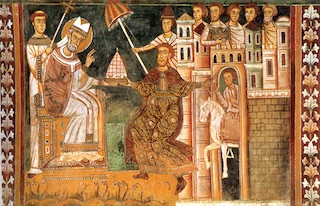
The pope considered it his duty to suppress the willfulness of bishops of the national churches. If someone was removed from the clerical position without his approval, he, no matter what, forced others to restore the excommunicated and, on the contrary, excommunicated the insubordinate.
The unlimited power of the papacy was legally justified by a collection of documents first published under Nicholas I, which became known as the “Pseudo-Isidore decretals.” It included the already mentioned “Donation of Constantine,” papal documents and letters from the time of Clement of Rome, and certain resolutions of church councils. Its compilation was associated with the name of Isidore of Seville, the head of the Spanish Church in the 6th century. The documents (mostly forged) proclaimed the authority of the pope over all church leaders and gave every bishop the right to address the pope directly. At the same time, the decretals proclaimed the freedom of the Church from any secular control. Moreover, they declared the subordinate position of secular authority in relation to church authority. And in the pope’s mind, his ecclesiastical authority extended everywhere. The “athlete of God” closely monitored church life around the world, and when he heard rumors about the successes or failures of the Eastern Church in distant Byzantium or Slavic lands, he considered it his right and duty to get directly involved in the events and steer them in the direction favorable for the see of Rome.
By the end of the 9th century, an intense struggle between opposing factions was brewing in the Eastern Church. Already in the period of the Seventh Ecumenical Council, the entire brotherhood of the Studite Monastery, the center of opposition to the government, was set against the excessively liberal Patriarch Tarasius. The inclination of the Byzantine emperors to iconoclasm led the Studites to sharply condemn the patriarchs’ loyalty to the authorities and turn their eyes to the West. The popes of that time had great respect for Greek Orthodoxy and supported it in difficult times—it was no coincidence that Theodore the Studite called the pope “the most divine head of heads.”[169] However, this situation changed when, in 847, Patriarch Ignatius was appointed to the see of Constantinople.
According to a contemporary, Ignatius was “an excellent monk, but not a brilliant patriarch.”[170] He was uneducated and saw little sense in getting an education, believing that an ascetic lifestyle and constant prayer were sufficient for a Christian. He considered the strengthening of monasteries to be his main goal, which was often done at the expense of other spheres of public life; moreover, Ignatius could sometimes be harsh and unfair in his assessments and decisions. In the end, his actions began to cause dissatisfaction in secular circles.
At the time, the empire was formally ruled by Theodora, the mother of the young Emperor Michael III. The latter was under the influence of his uncle Bardas, a vicious man who did not disdain any means to gain power. Patriarch Ignatius sharply denounced Bardas’ depraved behavior, and once forbid him to take communion. When Michael III tried to remove his mother from power, demanding that Ignatius forcibly tonsure her as a nun, he refused. His enemies never forgave him for that: in 858, Ignatius was deposed and sent into exile, and the imperial secretary Photius (c.820–891) was made the patriarch.
The talented and highly educated Photius understood that Ignatius had a huge number of supporters, especially among the monastics, and therefore promised to honor him as his father. However, his hopes for a peaceful transition of church power did not materialize. Ignatius did not agree to a voluntary abdication. His supporters anathematized Photius. In response, Photius convened a Council, where, in turn, he anathematized Ignatius. After that, the followers of Patriarch Ignatius were harassed and persecuted by Bardas, despite Photius’ intercession.
When Photius ascended the patriarchal see, he only informed the Eastern patriarchs about it. It took three more years before Rome received an official notice from Constantinople about the change that had taken place. This happened when the desperate Ignatius appealed to Pope Nicholas I. Addressing the pope as “the patriarch of all sees, the successor of the Prince of the Apostles,”[171] Ignatius complained about his illegal removal from his cathedra. Photius, too, sent a letter to Rome, justifying his patriarchate by the force of circumstances and emphasizing that he had unwillingly agreed to take over the see.
Pope Nicholas I dispatched two legates to Constantinople to deal with the situation on the spot. In 861, a Council was held with their participation, at which the patriarchate of Photius was affirmed as legitimate. Ignatius sent another appeal to Rome; the emperor and Photius also wrote to the pope. This time, Nicholas I declared that he had not given his legates the authority to decide the case, and did not agree with the Council’s resolution. In 863, he denounced Photius, deposed him, and recognized Ignatius as the legitimate patriarch. Photius, naturally, did not agree with Rome’s decision.
The relations between Rome and Constantinople were additionally complicated by the ecclesiastical and political events of that time. The pope accepted Bulgaria under his ecclesiastical jurisdiction, which caused extreme indignation in Photius, who viewed the pope’s act as an encroachment on the eastern territories. In 867, Photius sent a letter to the Eastern bishops, where he complained about the “Latins” encroaching on the true Christian faith. He recalled the numerous theological differences between East and West, declaring the Western teachings to be false and fatal to Christianity. It is in this epistle that the theological contradictions between the two Churches were formulated explicitly for the first time and given such significance (curiously, Photius’ earlier letter to the pope in 861, on the contrary, was characterized by a liberal attitude to ritual and dogmatic issues). At the same time, Photius convened a Council, which anathematized Pope Nicholas I.
Further events moved with kaleidoscopic speed: Constantinople lived through a number of emperors, and several popes succeeded one another to the see of Rome. Over the many years of ecclesiastical and political struggle, Photius was first deposed, then reinstated as patriarch again, and finally, in 886, he was deposed for good. The struggle between Rome and Constantinople temporarily subsided, but only to flare up again a century and a half later and end in the most regrettable way possible.
The second stage of the struggle between the two largest episcopal sees and the final separation of the Churches are associated with the names of two other prominent representatives of Rome and Constantinople: Pope Leo IX and Patriarch Michael Cerularius.
The papacy was greatly strengthened by the middle of the 11th century thanks to the Cluniac reform movement and the support of the German kings. The Roman see gained its special prestige under the pontificate of Pope Leo IX, who occupied it between 1048 and 1054.
Prior to his election as pope, Leo had been a German bishop and had long refused to be elevated to the papal throne. He agreed to take it only at the insistence of Emperor Henry III. A capable leader and a staunch supporter of the Cluniac reforms, he began his public fight against simony and the marriages of the clergy—the fight that would be later successfully completed by Gregory VII. The Roman cathedra was gradually coming out of the crisis that had lasted for a long time. Italy and Rome were constantly threatened by the Normans, and yet Henry III refused to intervene on behalf of the pope. Finding himself in need of a political alliance with Byzantium, the pope could not but wish for peace with the patriarch of Constantinople. However, Leo IX did not want to lose the ecclesiastical and political preeminence of Rome, of which he was deeply convinced. This was something that his opponent, the patriarch of Constantinople Michael Cerularius, could not agree to.
Michael Cerularius came from a noble family. From a young age, he expressed interest in a career in politics. He was even expected to become emperor during a next palace coup. The coup, however, was foiled, and Michael Cerularius, deprived of all his property, was tonsured a monk in the summer of 1040. In 1043, Constantine IX Monomachos ascended the throne and brought Michael into his inner circle, making him his closest adviser; and soon Michael assumed the patriarchal cathedra. Having devoted himself to the service of the Church, Michael Cerularius retained the traits of an imperious statesman; he was so self-assertive that he could not tolerate even the slightest diminution of his authority or that of the see of Constantinople.
Byzantium, in contrast to Rome, following a brief period of prosperity in the 10th century, began to slide into a deep economic and political decline. The situation was aggravated by the appearance of a new enemy in the East, the Seljuk Turks, against whom Byzantium, weakened from within, could no longer prevail on its own. It is not surprising that Byzantium needed an alliance with the West.
It seemed that in such circumstances, when the East and the West, united by the common Christian faith, needed each other, their union would only be natural. Indeed, the long process of negotiations began. However, it ended in a complete rupture of the two branches—the Western and the Eastern—of the Universal Church.
Emperor Constantine Monomachos tried to negotiate a treaty with the pope on the joint defense of Italy against the Normans, for which he promised Leo IX to return the southern Italian provinces that were then under the jurisdiction of Constantinople. The treaty was going to be concealed from the ambitious Michael Cerularius since the patriarch of Constantinople might not agree to the loss of his territories. However, the patriarch learned about the upcoming treaty and decided to prove to the emperor his independence and firm adherence to principles. In 1053, Michael Cerularius closed Latin churches and monasteries in Constantinople, which the pope, taking advantage of the political situation, used to promote the Latin rite. In addition, on the instructions of the patriarch, one of the Byzantine hierarchs, Leo of Ohrid, wrote an essay directed against the Latin traditions (the use of unleavened bread, fasting on Sabbath, etc.). In response, the pope sent a message to the patriarch, which indicated that peace and harmony should reign in the Church: “Customs that differ according to place and time do not in any way prevent the salvation of believers, if they are all entrusted to God by the common faith that works with love, producing all the possible good.”[172] However, the pope did not fail to point out the sins of the former Constantinople hierarchs, noting the tendency of the latter to heretical views and even referencing a purely mythical story about a woman who had allegedly occupied the see of Constantinople. In fact, in his letter, the pope suggested that the Church of Constantinople should honor the Roman Church as her mother. The political situation was very tense, and Cerularius, despite the offensive tone of the letter, was inclined towards reconciliation and even making some concessions. He remained uncompromising on one issue, however: he demanded that the rights of the Patriarch of Constantinople be recognized as equal to those of the pope. The pope could not agree to this; instead, he reproached Michael Cerularius for using the title “ecumenical patriarch,” which, according to Leo IX, should only be worn by the pope.
The conflict began to flare up. On behalf of the patriarch, the monk Niketas Stethatos wrote a new denunciation of the Western Church. At the beginning of 1054, an embassy from Rome, authorized to discuss the alliance with Byzantium against the Normans, arrived in Constantinople. One of the papal ambassadors, Cardinal Humbert, had prepared in advance a refutation of Stethatos’ accusations. In the course of the dispute, Stethatos admitted that he was wrong, and his treatise was solemnly burned. However, Humbert did not show sufficient wisdom and tact by trying to get along with the patriarch and treating him with due respect. At the Council, which was convoked soon after, the irate Michael Cerularius assigned the papal legates seats behind the Greek bishops. The papal legates considered this a humiliation and refused to take them; then the patriarch broke off all relations with the visitors.
The emperor was concerned about the fate of the treaty with Rome. He and the papal legates decided to convene a Council of their own and denounce the patriarch. Pope Leo IX died during that period, yet his ambassadors remained uncompromising. On July 15, 1054, during a divine service in St. Sophia Cathedral, in front of a huge crowd of people, the legates went to the altar and addressed the Byzantines with a sermon, complaining about the persistence of their patriarch, after which they placed a bull on the holy altar, in which the patriarch and his followers were accused of heresies and anathematized. However, the population of Constantinople supported their patriarch; unrest began, almost costing the lives of the Roman ambassadors and the emperor himself. Michael Cerularius called a Council, and on July 20, 1054, anathema was pronounced “against all those who worked to prepare the bull,”[173] and the bull itself was burned.
Thus, the mutual anathemas marked the great schism of the Universal Church into the Eastern and the Western parts. Hundreds of books have been written about the causes and nature of the split, and both sides have been declared guilty. Historians still argue about the events of those years and try to determine whose fault was greater: Rome’s or Constantinople’s, that of the Western or the Eastern Church. It seems that the blame was equally shared by both sides, or, more precisely, by the Church as a whole, since her activities very often had nothing to do with the ideals of the Gospel. In any case, by the end of the 9th century, the ideological, ecclesiastical, and political prerequisites for the imminent split of the Church had already taken shape, and in the middle of the 11th century, they were finally realized.
The newly formed independent branches of the Church were called the Catholic Church and the Orthodox Church respectively, the names that they have been known under for the past ten centuries. However, whereas the Western Church is still personified and headed by the see of Rome and its primate, the pope, Byzantium ceased to be the stronghold of Eastern Christianity. During the final centuries of its decline, and then its subsequent destruction under the blows of the Turks in the 15th century, the center of Orthodoxy moved to the north, to the Russian lands. It was the Russian Orthodox Church that would become a new stronghold of Orthodoxy.
Undoubtedly, the separation of the Churches is a deeply tragic event for the consciousness of every Christian, because it violates the basic principle of the Church life—her unity. There have been a number of attempts to overcome the split, but they were mostly superficial in nature and led to poor results. Nevertheless, achieving Christian unity still remains a vital goal for Christians of the East and the West who have gained invaluable experience on their separate paths. This idea was brilliantly expressed by the Russian philosopher N. Berdyaev: “For the mysteried purposes of Divine Providence, the religious life of mankind split onto two experiences and two pathways. Both experiences have their own mission and they complement each the other…. But to comprehend these different experiences and to overcome the enmity in our varied pathways, we both must and should.”[174] The reunification of Christians should follow the path of mutual understanding and knowledge. The spiritual experience of the West must belong to the East as much as the knowledge of God by the East must become an asset to the West. When the alienation disappears, so will the confessional barriers. Only then will there be one flock, the Universal Church, and one shepherd—Christ!
Christianity first came to Russia long before its baptism in 988. There is indisputable historical evidence that part of Rus’ was baptized earlier, under Askold (d.882) in the 9th century. This official event was accompanied by the patriarch of Constantinople, Photius, sending an archbishop to Russia to set up a church structure there. During that period, however, there was an intense struggle between the Christian and pagan factions before Christianity finally took root more than a hundred years later. Nevertheless, according to the chronicles, there were quite a few Christians among the troops of Prince Igor (d.945), and there was a Christian church in Kiev, where divine services were celebrated and oaths were taken, “since many of the Varangians were Christians.”[175] Princess Olga of Kiev, who arrived in Byzantium in 957, was, too, already a Christian. Four out of five wives of Prince Vladimir (d.1015), Olga’s grandson, were Christians even before his baptism. There was also a large enclave of Christians inhabiting the city of Novgorod prior to Russia’s baptism, where the Church of the Transfiguration functioned.
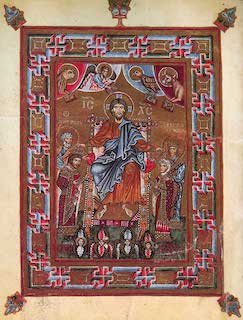
Russia in the 9th–10th centuries was traditionally connected with resplendent Constantinople—the Imperial City—and with the Slavs in central Europe and the Balkan Peninsula. These ties largely determined the orientation of Kievan Rus’ towards the Eastern Christian world. At the same time, the Kievan princes had an opportunity to choose between different religions since different states that professed them were interested in gaining control over the rich Russian lands. This kind of religious rivalry between the largest monotheistic religions was depicted in “The Tale of Bygone Years,” a monument of ancient Russian literature. One of the episodes tells us “The Legend of St. Vladimir’s Baptism,” although the authenticity of its events is denied by many scholars. According to the legend, in 986, Kiev was visited by envoys representing Eastern Christianity from Constantinople, missionaries from Rome, representatives of Judaism, and members of Islam. Prince Vladimir liked the speech of the Greek preacher most of all, although he was in no hurry to adopt Christianity of the Eastern rite. The following year, the prince sent envoys to different countries so that they could get acquainted with each of the religions on the spot. The chronicle says that the Latin and Muslim rites did not make a special impression on the ambassadors, but Constantinople and the Greek church services enraptured them, and they began to persuade Vladimir to accept Christianity of the Eastern rite. However, the final decision to adopt Christianity by Vladimir was associated with military and political circumstances, namely, his campaign against Chersonesus and his marriage to a Greek princess, which had Prince Vladimir’s baptism as its precondition. After his return to Kiev in 988, Vladimir destroyed pagan temples and baptized the people in the Dnieper. He also immediately began to “found churches and assign priests throughout the cities.”[176]
Even from the description above it is evident that the baptism of Russia by Prince Vladimir was not as simple and swift as it is often portrayed. First of all, the chronicles paint a vivid and contradictory figure of the prince, who, prior to his baptism, bore very little resemblance to a Christian saint. A pagan by nature and belief, he kept a harem, had orgies, and even sacrificed Christians. He combined the experience of a general and the wisdom of a politician along with unbridled cruelty.
The process of baptism was preceded by Vladimir’s attempts to reform the pagan worship and even introduce Islam, which is clearly mentioned in historical sources. Nevertheless, there is no doubt that after having received baptism, Prince Vladimir turned from being a pagan to a zealous Christian. What exactly accounted for this change—a divine revelation, spiritual experience, or political circumstances—is not entirely clear. However, he decisively rejected paganism and espoused the new religion. Naturally, the population could not so easily abandon their centuries-old beliefs, so the process of baptizing the people was carried out by a princely order. According to Hilarion, Metropolitan of Kiev, “If some were not baptized for love, then in fear of Vladimir’s command.”[177] In some places, particularly in Novgorod, the replacement of the traditional pagan worship with a new one was met with an open resistance. Nevertheless, Russia was mostly prepared to accept the new faith. Subsequently, Vladimir actively contributed to the spreading and strengthening of Christianity, and the year 988 became traditionally considered the official date of the baptism of Russia.
In the Slavs’ Russia, Christ’s faith was destined to acquire its own flavor and appearance. The light of truth, refracted through the prism of the Russian national character, resulted in one of the most striking and significant phenomena of Christianity—Russian Orthodoxy. It was formed in the process of the historical development of Russia and the growth of its national consciousness. The Kievan period (before the Mongol invasion) stands apart from the subsequent history in this respect, but even then, the image of Holy Russia, which would become the center of Eastern Christian knowledge of God, began to take shape.
Before the adoption of Christianity, similar to that of other barbarians, a lifestyle in Russia was closely connected with nature. The peasant life was at the mercy of the elements ruled by pagan gods, whose abandoning risked jeopardizing the person’s very existence. At the same time, the ancient Slavic religion was quite primitive and did not hold much sway over the people. Therefore, when Perun79 was eventually replaced by the Prophet Elijah, the transition was painless, albeit not completely conscious. In addition, the grandeur of Byzantine Orthodoxy, assimilated by Russia, contributed to the emphasis on the rituals rather than the content of Christianity. It is no coincidence that the piety of the heroes of ancient epic stories tended to be attributed to the fact that they “made the sign of the cross in the prescribed manner, and made their bows as enjoined.”[178]
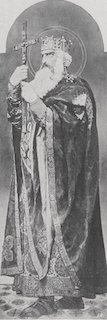
But the natural character of pre-Christian popular beliefs also had a positive aspect. It allowed the populace to develop a sense of closeness to God, closeness to Christ, the “Lord-dear Father,” who is present not somewhere in the sky, but here, on earth, with people. People believed that Christ helps and sympathizes with them. This sense of the natural and immediate closeness of Christ became the basis of Russian sainthood, generally devoid of passions and impetuousness, which was typical of Western Christianity.
The Kievan period was the most warlike time in the history of Rus’, during which the armies of princes stormed Byzantium, and pagan warriors drank from the skulls of their defeated enemies. This was the moment when Christianity came to Russia, and Russia accepted the moral essence of the Gospel message. Unlike the Germans, Russia perceived Christ not as a leader, but as a “Mercy-giver.”
Of course, the Christian moral laws did not always work to their full potential; the pagan past frequently made itself felt in the popular consciousness (which led to the emergence of double faith in relation to Russia—a combination of Christian faith and pagan beliefs), and it continues to manifest itself up to the present day. The clash of violent and warlike paganism with the bright and loving spirit of Christianity resulted in a spiritual struggle. Its first heroes and martyrs were Princes Boris and Gleb, the sons of Vladimir, who are rightly honored by the Russian people.
When the question of who would succeed Vladimir was being decided, one of his sons, Sviatopolk, intended to seize the grand ducal throne and physically eliminate his brothers Boris and Gleb. In response to his army’s urges to start the fight, Boris replied: “Be it not for me to raise my hand against my elder brother… let him take the place of my father in my heart.”[179] These were the first truly Christian words uttered in Rus’. Boris’s own army abandoned him, considering his words to be a manifestation of weakness. When the murderers came to Boris, as the life of the saint narrates, his servants wept, “O dear and precious lord of ours, how filled with goodness you are that for the sake of the love of Christ you desired not to resist!”[180] Boris was murdered, and the same fate befell the young Gleb. Russia deemed their death a martyrdom for their faith and canonized them as saints. The Christian meekness and humility of the passion-bearing princes inspired the Russian people to retain their patience and wisdom in the most difficult historical moments for centuries to come.
The Kievan throne was taken by another son of Vladimir, Yaroslav the Wise (978–1054), who accomplished no less for the Russian Church than his father in the area of education and strengthening Christianity in Russia. A man of broad views, an accomplished ruler, closely connected to European sovereigns through the ties of his marriage, Yaroslav sought to strengthen Christianity in the Kievan state and to achieve cultural parity with Byzantium and Western Europe. Education was of vital importance to Russia of those days, especially as it was a very young and undeveloped culture. Russia’s remoteness from the spiritual and economic centers of the world created a sad prospect of isolation and savagery. Therefore, Yaroslav sought to establish contacts with different states, willingly received ambassadors, and sought to adopt all the achievements of Christian civilizations, especially paying attention to the dissemination of spiritual literature. Priests began to arrive from the South Slavic countries—Greeks, Bulgarians, and Serbs. They brought with them church utensils, ancient religious literature, and liturgical books, which began to be translated into the Slavic language. There were scribes skilled at copying books. At the same time, common people began to learn how to read and write—the Christian Church became the enlightener of Russia.
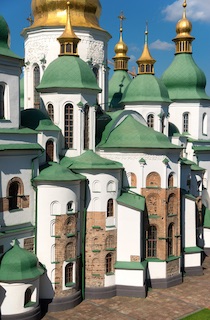
Yaroslav founded a large public library. The oldest Russian manuscript of the Gospel (the so-called Ostromir Gospels) dates back to that time. He gave out special allowances for priests to preach to the people and created a school for boyar children. Yaroslav’s educational mission was continued by his son Sviatoslav II (1027–1076), who published Izbornik,80 a book composed of translations into Slavic of excerpts from the works of Basil the Great, Gregory the Theologian, John Chrysostom, Augustine, Maximus the Confessor, John of Damascus, and other Church Fathers.
Yaroslav the Wise is credited with establishing the Russian legal system. The introduction of Christianity played a huge role in changing the moral state of the people, who had previously lived with pagan notions of good and evil. The norms of ancient Russian law in their Christian reinterpretation became the norms of church law. A number of such norms in their humaneness even surpassed their Byzantine counterparts: for example, the laws on marriage, murder, and insult. Such rules were first introduced by Vladimir, but their most complete and detailed form are captured in the so-called Statute of Yaroslav, which was co-authored by Hilarion—the first Russian metropolitan.
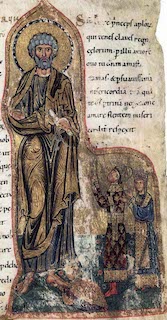
Soon after the introduction of Christianity in Russia, the initial church structure was established in the form of a metropolis of the Constantinople Patriarchate. It was headed by metropolitan, located in St. Sophia’s Cathedral in Kiev and appointed by Constantinople. The episcopates were also established in other major cities, including Belgorod, Novgorod, and Polotsk. The Russian Church in the 11th and 12th centuries was ruled by metropolitans of Greek origin. This structure made the Russian Church partly independent from the pressures of a particular faction and the authorities. But already Yaroslav made an attempt to change this arrangement by appointing the Russian clergyman Hilarion as metropolitan in 1051. Hilarion was an outstanding thinker and writer and the author of the famous “Sermon on Law and Grace.” This first surviving monument of ancient Russian literature testifies to the spiritual uplift experienced by Russia of that time, and what great pastors nurtured her, although not even a hundred years had passed since the baptism of Russia by Vladimir. Hilarion developed three main ideas in his solemn “Sermon”: the spiritual superiority of the New Testament (“grace”) over the Old Testament (“law”), the great significance of Russia’s embracing Christianity enabled by Princes Vladimir and Yaroslav, and the greatness of the Russian land. It is interesting that in the “Sermon,” Prince Vladimir is extolled as “a new Constantine,”[181] and his legacy is likened to the deeds of the apostles. Prince Vladimir is portrayed as a wise politician and a brave warrior who adopted Christianity at divine prompting. The “Sermon” is also distinguished by its literary merits: its solemn style follows the genre of Byzantine rhetoric with abundant symbolic parallels, which were the traditional techniques of Byzantine eloquence. It is no coincidence that the “Sermon” made a strong impact on the development of subsequent ancient Russian literature.
Likewise, of great importance for the formation of Russian culture, literature, and history were chronicles. Similar to Hilarion’s “Sermon,” chronicling reflected the writer’s desire to understand contemporaneous events by referring to the past. Therefore, the monk-chroniclers expressed their interest in the history of their people by glorifying not only the deeds of their national Christian ascetics, but also the exploits of ancient pagan princes. The chroniclers relied in their narrative on a variety of materials, such as historical documents, oral traditions, and common folklore. Their style is marked by direct speech of characters, expository writing techniques, and the use of proverbs and sayings. In Kiev, the chronicles were composed in the second half of the 11th century by the abbot of the Kiev-Pechersk Lavra Nikon. At the beginning of the 12th century, the Kiev-Pechersk monk Nestor combined the annals together. This collection was named “The Tale of Bygone Years” and became the main source of information for modern historians.
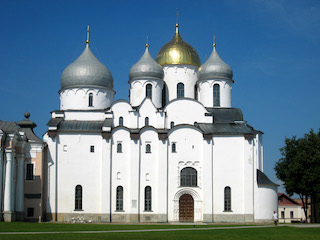
The majority of scholars, writers, and artists of that time were concentrated in numerous monasteries. Church scribes, architects, and icon painters came from Byzantium and other countries and passed on the secrets of their craft to the Russians. Soon, Russian masters were already independently erecting churches, painting frescoes and icons, which fascinated foreigners and are now counted among the treasures of the world’s cultural heritage.
Yaroslav wanted to make his capital Kiev as great as Constantinople. He built a palace in Kiev, the Golden Gate, and, finally, the majestic Church of St. Sophia (1037). In this magnificent structure, the Byzantine architectural techniques were creatively reworked by Greek and, in all likelihood, Russian masters to incorporate local traditions.
The outside of the temple is crowned with five round domes. The interior of the temple is decorated with a grand mosaic depicting the raised hand of the Theotokos, as if she is extending her blessing to the people. Her six-meter figure towers in the center of the apse above the altar, appearing, as it were, to support the church building.
The mosaic figures of the Church Fathers in the lower section of the apse are unforgettable; their faces and bright vestments with black crosses are depicted surprisingly subtly and harmoniously. In the mosaic composition “The Eucharist,” the artist managed to perfectly convey an impetuous eagerness with which the apostles are heading to the temple.
During the same years, the Church of the Savior at Berestove with bas-reliefs, based on ancient Eastern motifs, and the remarkably beautiful church of St. Sophia in Novgorod with five domes in the form of military helmets were built. The Novgorod Cathedral of St. Sophia became the boundary when Russian religious art ceased to be merely a branch of Byzantine art. The cathedrals of the 11th century played an enormous role in the life of Russia, turning into centers of spiritual enlightenment, national sanctuaries, and the banner of unity for Russian Christians.
The entire Christian world became a place of learning and gaining new religious experience for thousands of recent converts. The Russian people had a special love for holy places—often the only sources of knowledge and inspiration. Yesterday’s pagans, still living in the power of their past, they traveled to all corners of the world where the grace-filled power of prayer and the Holy Spirit flourished—the power preserved and multiplied by ascetics and saints. The monasteries of Byzantium, the Holy Land, and Mount Athos received their first streams of pilgrims coming from distant Russia to partake of treasures of the Christian faith. And, finally, the spiritual level of Russian Christianity increased so much that similar jewels began to emerge on Russian soil. Among them was the Kiev-Pechersk Lavra, a monastery that was to become the heart of the faith in Christ in Russia.
During the time of Prince Yaroslav, a young pilgrim, Antipas, was among the numerous pilgrims who set out on an arduous journey to the holy places. After long wanderings, he settled on Mount Athos and soon became a monk there, adopting the name of Anthony. His fervent faith and holy life attracted the attention of the abbot. The abbot of the monastery, as the chronicle tells, “bade [Anthony] return to Rus’ accompanied by the blessing of the Holy Mount, that many other monks might spring from his example.”[182] It is symbolic that it was on Mount Athos—the holy site of Byzantine Christianity—that St. Anthony, the future founder of the Russian Christian holy site, was given a parting blessing.
In a forest cave on the banks of the Dnieper River, where Hilarion “offered his prayer to God in secret,” Anthony lit the first candle of the Kiev-Pechersk Monastery. Soon, his monastic exploits were spoken about everywhere. Anthony did not shut himself off from people, and many came to him for a blessing. There also appeared zealous disciples who sought to imitate the saint in everything. A small community of monks was formed who spent their days in prayer, labor, and abstinence. Anthony appointed one of the ascetics, Theodosius, to be his assistant. The community of monks attracted the attention of Prince Izyaslav, who allowed them to build a monastery on the hill. The community grew, and soon Antony, accustomed to living alone, built himself a hut nearby. There he died in 1073. Theodosius gathered up to 100 monks and, with the blessing of Anthony, moved the main cells of the monastery to a nearby hill. After the model of the Greek Studite Monastery, Theodosius introduced a strict Rule (ustav) in his monastery (named Pechersk—from the word “cave”).
St. Theodosius (d.1074) is one of the most prominent figures in the bright host of Kievan ascetics. He was a boyar’s son who had a disregard for worldly pleasures since his childhood. Theodosius longed for a life in quiet forest sketes81 of distant Greek monasteries, about which he heard from pilgrims, and he also dreamed of visiting the Holy Land. However, his family did not want this kind of future for their son and hindered him in every way possible. Finally, in 1056, he secretly left home and came before Anthony, asking to be accepted as a monk. Theodosius’ mother also became a nun despite her early attempts to persuade him otherwise.
Despite his young age, Theodosius immediately showed a true example of love, obedience, and meekness. In 1063, he became the abbot of the Pechersk Monastery.
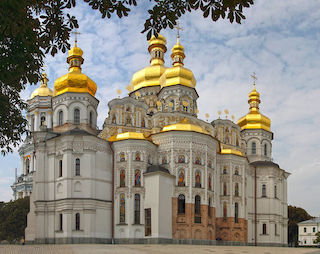
The hallmark of the holy abbot was his hard work. He was always the first to set an example in everything. As an elder, Theodosius, according to the life of the saint, “often went out into the bakehouse and worked with those who were doing the baking, rejoicing in his spirit.” This description of his “rejoicing in the spirit”[183] is striking in the absence of gloomy asceticism and self-abasement that was so common in the East.
The ascetic knew the Holy Scriptures well and always taught the monks to appreciate “the traditions of the fathers and the reading of books.”[184] According to the chronicler, he devoted many hours to bookbinding alongside monk Nikon. Thus, the efforts of Theodosius also laid the foundation for the educational activities of the Kiev-Pechersk Monastery.
The spiritual guidance of the brethren was of primary importance for Theodosius. He taught them abstinence as a sign of voluntary sacrifice to God. He spoke to them about the meaning of the Jesus prayer, “Lord Jesus Christ, Son of God, have mercy on me, a sinner,” about the great mystical power that is contained even in the very name of the Savior. For Theodosius, the concentration of one’s thoughts and feelings on the Divine image of Christ was the equivalent of a purifying fire.
Theodosius cared not only for his monks, “but also for people in the world, as regards the salvation of their souls. He showed a special concern for his spiritual sons, and comforted and instructed all those who came to him; sometimes he went to their houses and gave them his blessing.”[185] In the person of Theodosius, Russia was able to overcome one shortcoming of Byzantium: as one of Russia’s greatest ascetics and monastics, he did not shut himself off from the world and society, but taught the people, fighting pagan vestiges. “The Lord and the apostles,” he said addressing those who celebrated the new Christian feasts but according to the old pagan customs, “commanded us to celebrate the holy feasts spiritually rather than fleshly, toiling not for unfit drunkenness, but in order to feed the poor, praying to God on the account of our sins.”[186]
St. Theodosius devoted his whole life to strengthening Christianity in Russia. After the death of Theodosius, the Lavra continued to live according to his precepts. “They all dwelt together in love: the younger ones submitted to their seniors… likewise the seniors showed love towards the younger ones, instructing them and comforting them like their beloved children,”[187] says the chronicler.
The spiritual atmosphere in the first Russian monastery can be judged by the words of his disciple, the author of “The Tale of Bygone Years.” “For all is perfected in love,” he writes, “Through love sins are washed away, out of love the Lord descended to earth and was crucified for us sinners, and after taking away our sins he was nailed to the Cross, thus giving us his Cross for the elimination of the devil’s hatred.”[188]
The greatness of their love made the Kiev-Pechersk ascetics rise to the height from which they still shine for us with their lives—with the unquenchable light—almost ten centuries later.
C. Paterculus, Compedium of Roman History: Res Gestae Divi Augusti. With an English Translation by Frederick W. Shipley, Book II, Heinemann, United States, 1924.
m.Sanhedrin 1:6.
M. James, The Apocryphal New Testament: Being the Apocryphal Gospels, Acts, Epistles, and Apocalypses : with Other Narratives and Fragments Newly Translated, Clarendon Press, United States, 1924.
P. Benoit, Jesus and the Gospel trans. by Benet Weatherhead, Darton, Longman & Todd, London, 1973.
St. Clement of Alexandria, The Stromata, IV, 6, 35.
Matthew 19:28.
Exodus 34:22; Numbers 28:26; Leviticus 23:15–21; Deuteronomy 16:9–11; Jubilees 1:1; m.Pesachim 68b; Midrash Tanchuma, Devarim 2.
m.Sotah 9:15.
m.Makkot 3:15.
St. Clement of Alexandria, The Stromata, VI, 5, 43.
A. von Harnack, J. Moffatt, The Mission and Expansion of Christianity in the First Three Centuries, Williams and Norgate, New York, 1908, p. 8.
The Jewish People in the First Century: Historical Geography, Political History, Social, Cultural and Religious Life and Institutions, (Eds.: S. Safrai, M. Stern), Fortress Press, Assen, 1974, p. 122.
m.Megillah 26a.
F. Josephus, W. Whiston, The Wars of the Jews or History of the Destruction of Jerusalem, Josephus, Jewish War 2.20.5; available online; accessed 19-October-2020.
m.Sanhedrin 4:4.
F. Josephus, W. Whiston, The Antiquities of the Jews, Josephus, Antiquities 18.4.2; available online; accessed 25-December-2020.
The Jewish People in the First Century: Historical Geography, Political History, Social, Cultural and Religious Life and Institutions, (Eds.: S. Safrai, M. Stern), Fortress Press, Assen, 1974, pp. 68–70.
Philippians 3:5.
m.Sanhedrin 6:6.
2 Corinthians 5:16.
Suetonius, The Lives of the Twelve Caesars, Caligula, 22; available online; accessed 18-January-2021.
F. Josephus, W. Whiston, The Antiquities of the Jews, Josephus, Antiquities 18.8; available online; accessed 8-January-2021.
Philo, On the Embassy to Gaius. General Indexes, Philo, Embassy XXIX, 1962.
St. Justin Martyr, First Apology, 26; 56.
St. Justin Martyr, Second Apology, 15.
St. Justin Martyr, Dialogue with Trypho, 120.
St. Irenaeus of Lyons, Against Heresies, I, 23.
St. Clement of Alexandria, The Stromata, II, 11; VII, 17.
Origen, Contra Celsum, I, 57; V, 62; VI, 11.
Eusebius of Caesarea, Church History, II, 13.
St. Epiphanius of Salamis, Panarion, I, 21.
Apocryphal Acts of Peter, Ref. 3, p. 300.
A. Roberts, J. Donaldson, The Ante-Nicene Fathers: Volume VIII: The Twelve Patriarchs, Excerpts and Epistles, the Clementina, Apocrypha, Decretals, Memoirs of Edessa and Syriac Documents, Remains of the First Ages, Pseudo-Clementine Literature, Charles Scribner’s Sons, 1903, p. 75.
St. Hippolytus of Rome, Philosophumena, VI, 15.
Origen, Contra Celsum, I, 57.
V. Rybinsky, Samaritans: A review of sources for the study of Samaritanism. History and religion of the Samaritans, (In Russian), Pyotr Barsky’s Publishing House, Kiev, 1913, pp. 540–542.
St. Irenaeus of Lyons, Against Heresies, III, 12, 8.
T. Mommsen, W. Dickson, The Provinces of the Roman Empire: From Caesar to Diocletian, R. Bentley E Son, 1886, p. 126.
F. Josephus, W. Whiston, The Wars of the Jews or History of the Destruction of Jerusalem, Josephus, Jewish War 7.3.3; available online; accessed 22-February-2021.
Apocryphal Acts of Paul, Ref. 3, p. 273.
J. Malalas, E. Jeffreys, M. Jeffreys, R. Scott, B. Croke, A. A. for Byzantine Studies, The Chronicle of John Malalas, Book X, 37, Australian Association for Byzantine Studies, 1986, p. 136.
J. Jeremias, Jerusalem in the Time of Jesus: An Investigation Into Economic and Social Conditions During the New Testament Period, Fortress Press, 1969, p. 320.
F. Josephus, W. Whiston, The Antiquities of the Jews, Josephus, Antiquities 20.2.4; available online; accessed 11-January-2021.
Suetonius, The Lives of the Twelve Caesars, Claudius, 18, 2; available online; accessed 18-January-2021.
C. Tacitus, The Annals, Tac. Ann. 12.43; available online; accessed 18-January-2021.
C. Dio, Roman History, Dio, LX, 11; available online; accessed 18-January-2021.
F. Josephus, W. Whiston, The Antiquities of the Jews, Josephus, Antiquities 20.5.2; available online; accessed 18-January-2021.
Eusebius of Caesarea, Church History, II, 9.
O. Cullmann, Recherches de science religieuse 1972, 60, (In French), 55–68.
F. Josephus, W. Whiston, The Antiquities of the Jews, Josephus, Antiquities 19.8.2; available online; accessed 22-January-2021.
F. Filson, A New Testament History, The Westminster Press, Philadelphia, 1965, pp. 218–220.
Acts 11:19–21.
Corpus Inscriptionum Latinorum VI.31545.
F. Josephus, W. Whiston, The Antiquities of the Jews, Josephus, Antiquities 20.7.2; available online; accessed 22-January-2021.
P. the Elder, The Natural History, Plin. Nat. 30.2; available online; accessed 22-January-2021.
Strabo, The Geography, Strab. 12.6.5; available online; accessed 22-January-2021.
C. Dio, Roman History, Dio, LIII, 26; available online; accessed 2-February-2021.
P. the Elder, The Natural History, Plin. Nat. 5.25; available online; accessed 2-February-2021.
I. Artobolevsky, The First Journey of St. Paul to Preach the Gospel, (In Russian), Sergiyev Posad, Moscow, 1900, pp. 166–167.
I. Chauncy, Plutarch’s Morals, Plut. De Fort. Rom. 2, 1704, p. 197.
Suetonius, The Lives of the Twelve Caesars, Tiberius, 36; available online; accessed 7-February-2021.
C. Tacitus, The Annals, Tac. Ann. 11.15; available online; accessed 7-February-2021.
Ref. 11, p. 101.
Ovid, Metamorphoses, 8.626ff.
Galatians 6:17.
W. Wrede, E. Lummis, Paul, Philip Green, London, 1907, p. 23.
Genesis 17:12–13, Exodus 12:14, 27:21, 28:43, Leviticus 7:36, 16:34, Numbers 18:19.
Cf. m.Sotah 5:5.
Eusebius of Caesarea, Church History, II, 1 and 23.
St. Clement of Alexandria, The Stromata, VII.
F. Williams, The Panarion of Epiphanius of Salamis: Books II and III: De Fide, Society of Biblical Literature, 2016, pp. 626–627.
Cf. Galatians 2:3.
Cf. Matthew 5:17.
F. Bruce, The Book of Acts: The English Text with Introduction, Exposition and Notes, Eerdmans, United States, 1954, p. 311.
Sanhedrin 56b.
G. Moore, Judaism in the First Century of the Christian Era: the Age of the Tannaim, Vol. 1, Harvard University Press, Cambridge, 1962, p. 274.
Cf. 1 Corinthians 1:12, 9:5.
Eusebius of Caesarea, Church History, III, 1 and 39.
Ref. 3, p. 300 ff.
Y. Golubinsky, The History of the Russian Church, Vol. 1, (In Russian), Moscow, 1901, p. 1.
John 12:24.
A. Schmemann, The Historial Road of Eastern Orthodoxy, (In Russian; also available as English translation, published by Holt, Rinehart & Winston, New York, 1963. This quote, however, is missing in the English translation.), Palomnik, Moscow, 2007, p. 28.
m.Megillah 4:4.
Suetonius, The Lives of the Twelve Caesars, Claudius, 25, 3; available online; accessed 12-February-2021.
Pausanias, Description of Greece, Paus. 1.1.4; available online; accessed 12-February-2021.
F. Philostratus, E. Berwick, The life of Apollonius of Tyana: Translated from the Greek of Philostratus, Book IV, Chapter 3, Payne, London, 1809, p. 305.
Cf. Daniel 8:9–14, 26–27; 11:36; Matthew 24:15; Luke 21:24.
Cicero, P. Walsh, On Obligations, Oxford University Press, 2000, p. 50.
Acts 18:26.
Acts 19:6.
Eusebius of Caesarea, Church History, III, 14.
1 Corinthians 7:24.
Acts 21:28.
Eusebius of Caesarea, Church History, V, 1.
A. S. Khomyakov, Collection of Works in 8 Volumes, Vol. 6, (In Russian), Moscow, 1904, p. 474.
V. Solovyev, Collection of Works in 10 Volumes, Vol. 6, (In Russian), St. Petersburg, 1914, pp. 349–351.
C. Shapland, The Letters of Saint Athanasius Concerning the Holy Spirit [to Saint Serapion]. Translated, with Introduction and Notes by C.R.B. Shapland, Epistle I, 15, Epworth Press, London, 1951, p. 98.
Isaiah 57:20.
S. G. of Nazianzus, D. Meehan, T. Halton, Three Poems: Concerning His Own Affairs, Concerning Himself and the Bishops, and Concerning His Own Life (The Fathers of the Church, Volume 75), Concerning His Own Life, v. 484–5, Catholic University of America Press, 2010, p. 90.
St. Gregory of Nazianzus, Oration 42, 21.
St. Gregory of Nazianzus, Oration 42, 24.
Jerome, To Pammachius Against John of Jerusalem, 8.
A. Marcellinus, Rerum Gestarum, Amm. 27.3.14; available online; accessed 9-March-2021.
Jerome, To Eustochium, 28.
J. A. Ryan, International Journal of Ethics 1903, 14, 26–39.
Libanius, Oration 30. To the Emperor Theodosius, For the Temples, 11.
J. Chrysostom, The works of our holy father John Chrysostom, Archbishop of Constantinople, Vol. 2, (In Russian), The Theological Academy, St. Petersburg, 1896, 906–910.
John Chrysostom, On the Priesthood VI, 4.
Matthew 19:21.
Sozomen, Ecclesiastical History, I, 13.
N. the Hagiorite, M. of Corinth, Philokalia translated from Greek by Theophan the Recluse, Vol. 1, (In Russian), Sretensky Monastery, Moscow, 2010, p. 11.
N. Morozov, Revelation within Thunderstorm and Tempest. History of the Apocalypses Origin. (In Russian), Byloye, St. Petersburg, 1907, p. 212.
N. of Sinai, The Works of the Holy Fathers in Russian Translation, Vol. 31, To monk Agathias, The Theological Academy, Moscow, 1858, p. 1.
Basil the Great, Address to young men on the right use of Greek literature, 4.
Gregory of Nyssa, The Great Catechism, Chapter 28.
S. of Marseille, E. Sanford, On The Government Of God, Book V, Chapter 4, Columbia University Press, New York, p. 138.
Augustine of Hippo, The Confessions, Book V, Chapter 11.
The Letters of S. Ambrose, Bishop of Milan, Ambrose to Constantius, J. Parker, 1881, p. 5.
G. B. of Tours, E. Brehaut, History of the Franks, Book II, 30, Columbia University Press, New York, 1916, p. 40.
C. Tacitus, Germany and its Tribes, Tac. Ger. 14; available online; accessed 18-March-2021.
Ref. 119, Book II, 37, p. 46.
Benedict of Nursia, The Rule of St. Benedict, Ch. 48.
Venerable Bede, Ecclesiastical History of the English People, Book II, Chapter 1.
P. G. I, Morals on the Book of Job, Volume I, the Epistle to Bishop Leander, J. Parker, 1883, p. 4.
Gregory the Great, Epistle V. To Theoctista, Sister of the Emperor.
Gregory the Great, Registrum Epistolarum, Book V, Letter 20, To Emperor Maurice.
Gregory the Great, Pastoral Rule, Book II, Ch. 5.
Ref. 127, Book I, Ch. 10–11.
Ref. 127, Book II, Ch. 6.
F. Blume, B. Frier, P. Krueger, S. Connolly, S. Corcoran, M. Crawford, J. Dillon, D. Kehoe, N. Lenski, T. McGinn, et al., The Codex of Justinian: A New Annotated Translation, with Parallel Latin and Greek Text (3 volume set), Vol. 1, C.J. 1.5.12.5, Cambridge University Press, 2016, p. 203.
Justinian’s Novels, Novel 37 (Authenticum 39), Concerning the African Church, available online; accessed 22-March-2021.
A. Talbot, D. Sullivan, The History of Leo the Deacon, Book VI, 1, Dumbarton Oaks Research Library and Collection, 2005, p. 144.
V. Solovyov, The Great Debate and the Christian Politics, (In Russian), Moscow, 1883, p. 99.
S. J. Climacus, L. Archim. Moore, The Ladder of Divine Ascent, Faber and Faber, London, 1959, p. 36.
Ref. 134, p. 38.
Ref. 134, Step 1, 21, p. 55.
Ref. 134, Step 26, 38, p. 233.
Barsanuphius, John, J. Chryssavgis, Letters, Letter 13, Catholic University of America Press, Washington, D.C, 2006, p. 33.
Ref. 138, Letter 90, p. 112.
G. Dorotheus, E. Wheeler, Discourses and Sayings, Directions on the Spiritual Life, Instruction IV, On the Fear of God, Cistercian Publications, 1977.
Ref. 140, Directions on the Spiritual Life, Instruction VI, On Refusal to Judge our Neighbor, p. 138–139.
D. the Areopagite, J. Parker, The works of Dionysius the Areopagite, Part I, On Divine Names, Chapter IV, Section XIV, J. Parker, London, 1897, p. 50.
Ref. 142, Part II, On the Heavenly Hierarchy, Chapter II, Section IV, p. 11.
Ref. 142, Part I, Mystic Theology, Chapter II, Section I, p. 133.
The philokalia: the complete text. Vol. 2, (Eds.: Nikodēmos, M. Notaras, G. E. H. Palmer, P. Sherrard, K. Ware), Faber and Faber, London, 1990, p. 173.
P. Blowers, R. Wilken, On the Cosmic Mystery of Jesus Christ: Selected Writings from St. Maximus the Confessor, St. Vladimir’s Seminary Press, 2003, pp. 123–124.
Early fathers from the Philokalia, (Eds.: E. Kadloubovsky, G. E. H. Palmer), St. Isaac of Syria, Directions on spiritual training, 171, Faber and Faber, London, 1954, p. 234.
H. Alfeyev, K. Ware, The Spiritual World Of Isaac The Syrian, Liturgical Press, 2016, p. 264.
Isaac, The ascetical homilies of Saint Isaac the Syrian, Rev. 2nd ed, Homily 72, The Holy Transfiguration Monastery, Boston, Massachusetts, 2011, p. 500.
Ref. 148, p. 43.
Ref. 148, p. 272.
S. J. of Damascus, F. Chase, Writings: [The Fount of Knowledge], An exact exposition of the Orthodox Faith, Book I, Ch. 9, Fathers of the Church, Incorporated, 1958, p. 189.
Ref. 152, Book II, Ch. 12, p. 234.
Ref. 152, Book IV, Ch. 16, pp. 371–372.
Decrees of the ecumenical councils, Vol. 1, (Ed.: N. P. Tanner), Second Council of Nicaea (787), Sheed & Ward ; Georgetown University Press, London : Washington, DC, 1990, p. 135.
G. Dagron, J. Birrell, Emperor and Priest: The Imperial Office in Byzantium, Cambridge University Press, 2003, p. 189.
J. Migne, Patrologiae Cursus Completus: Series Latina: Sive, Bibliotheca Universalis, Integra, Uniformis, Commoda, Oeconomica, Omnium SS. Patrum, Doctorum Scriptorumque Ecclesiasticorum Qui Ab Aevo Apostolico Ad Usuque Innocentii III Tempora Floruerunt, Stephani Papae II ad Francos, Excudebat Migne, 1850, p. 1004.
C. Coleman, The treatise of Lorenzo Valla on the Donation of Constantine, text and translation into English, Yale University Press, 1922, pp. 11–19.
G. Brault, The Song of Roland: Oxford text and English translation, CCLXVI, Pennsylvania State University Press, 1978, p. 116.
J. Erigena, I. Sheldon-Williams, J. O’Meara, Periphyseon, Bellarmin, 1987, p. 310.
R. Glaber, J. France, N. Bulst, R. Glaber, Rodulfi Glabri Historiarum libri quinque, Book III, Ch. 31, Clarendon Press ; Oxford University Press, Oxford [England] : New York, 1989, p. 149.
I. Robinson, The Annals of Lampert of Hersfeld, Manchester University Press, 2015, pp. 354–355.
S. Deane, Proslogium; Monologium; an Appendix, In Behalf of the Fool by Gaunilon; and Cur Deus Homo; Alselm’s Proslogium, Ch. 2, Open Court, 1910, p. 8.
Ref. 163, Ch. 1, p. 7.
H. Morton, Middle East: A Record of Travel in the Countries of Egypt, Palestine, Iraq, Turkey and Greece, Methuen, 1941, p. 238.
St. Demetrius of Rostov, The Great Collection of the Lives of the Saints, on Cyril the Philosopher, Teacher of the Slavs.
J. Roy, M. Maitland, Saint Nicholas I. Duckworth, 1901, p. 164.
H. Milman, History of Latin Christianity: Including that of the Popes to the Ponticicate of Nicolas V, A.C. Armstrong, 1887, p. 57.
St. Theodore the Studite, Epistles, Book 1, Epistle 33 to Leo III, pope of Rome (In Russian), The St. Ignatius of Stavropol Publisher, Moscow: The Descent of the Holy Spirit Church, 2003, p. 103.
A. Lebedev, Historical sketches of the state of the Byzantine-Eastern Church, (In Russian), A.I. Snegiryova’s Publisher, Moscow, 1902, p. 89.
A. Fortescue, The Orthodox Eastern Church, Catholic Truth Society, 1908, p. 146.
J. Migne, Patrologiae Cursus Completus: Series Latina: Sive, Bibliotheca Universalis, Integra, Uniformis, Commoda, Oeconomica, Omnium SS. Patrum, Doctorum Scriptorumque Ecclesiasticorum Qui Ab Aevo Apostolico Ad Usuque Innocentii III Tempora Floruerunt, Leo IX, Epistolae et decreta, 100, XXVIII, excudebat Migne, 1853, p. 764.
M. Posnov, The History of the Christian Church Until the Great Schism of 1054, AuthorHouse, 2004, p. 473.
N. Berdyaev, The Problem of East and West within the Religious Consiousness of V. Solovyev, available online; accessed 16-April-2021.
Nestor, S. H. Cross, O. P. Sherbowitz-Wetzor, The Russian Primary chronicle: Laurentian text, The Mediaeval Academy of America, Cambridge, MA, 1953, p. 77.
Ref. 175, p. 117.
S. Franklin, K. Smoliatich, Sermons and Rhetoric of Kievan Rus’, Hilarion, metropolitan of Kiev, Sermon on Law and Grace, Harvard University Press, 1991, p. 19.
This theme runs through the byliny; see Russian Heroic Poetry, The University Press, 1932.
Ref. 175, p. 126.
M. Kantor, Medieval Slavic Lives of Saints and Princes, University of Michigan, Department of Slavic Languages and Literatures, 1983, p. 179.
Ref. 177, p. 22.
Ref. 175, p. 126.
M. Heppell, The Paterik of the Kievan Caves Monastery, Harvard University Press, 1989, p. 52.
Ref. 175, p. 156.
Ref. 183, p. 93.
I. Sreznevsky, Scientific Notes of the Second Division of the Imperial Academy of Sciences, Book II, Issue II, Sermon on the plagues of God, attributed to Theodosius of Pechersk (In Russian); available online; accessed 16-April-2021, Imperial Academy of Sciences, 1856, p. 196.
Ref. 183, p. 108.
Ref. 175, p. 167.
Acts, book of, 10
Adrian I (pope), 11
Adrian II (pope), 12
Agapius of Hierapolis, 13
Agrippa, Herod, I (king), 14, 15, 16, 17, 18
Aksum (queen), 19
Alaric I (king), 20, 21
Alcuin, 22
Alexander I of Alexandria (patriarch), 23, 24
Alexander II (pope of Rome), 25
Alexandria, 26, 27, 28, 29, 30
school of, 31, 32, 33, 34, 35
allegorism, 36, see also Alexandria, school of
Ambrose of Milan, 38, 39, 40, 41, 42, 43, 44, 45
contribution to church music, 46
Ananias and Sapphira, 47, 48
Andrew (apostle), 49
Anselm of Canterbury, 50, 51, 52, 53
as father of scholasticism, 54
proofs of God’s existence by, 55
Proslogion, 56
Anthony of Kiev, 57, 58
Anthony the Great, 59, 60, 61
Antioch, 62, 63
school of, 64, 65
Antioch, of Pisidia, 66
Antioch, Syrian, 67, 68, 69, 70, 71, 72, 73
as center of Christianity, 74
Aphrodite (goddess), 75
Apion, 76
Apollinaris of Laodicea, 77
Apollo (god), 78
Apollos (apostle), 79, 80, 81, 82, 83, 84, 85, 86
Apostles, see the Twelve
Appian Way, 88, 89
Aquila and Priscilla, 90, 91, 92, 93, 94, 95, 96, 97, 98
the Areopagite, see Dionysius the Areopagite
Aretas IV (king), 100
Arethas of Caesarea, 101
Aristobulus, 102
Aristotle, 103, 104, 105
Arius/Arianism, 106, 107, 108, 109, 110, 111, 112, 113, 114, 115, 116, 117, 118, 119, 120, 121, 122, 123
dominance of, 124
art, Christian, 125, 126, 127, 128, 129
architecture, 130, 131, 132, 133
frescos, 134, 135
iconography, 136
mosaics, 137
sculpture, 138
Artemis (goddess), 139
asceticism, see monasticism, 141
extremes of, 142
Askold (prince), 143
Astarte (goddess), 144, 145
Athanasius of Alexandria, 146, 147, 148, 149, 150, 151
Athanasius the Athonite, 152
atheism, 153
Athens, 154, 155, 156
agora, 157
Areopagus, 158
Athos, Mount, 159, 160, 161, 162, see also monasticism
Great Lavra, 164
Augustine of Hippo, 165, 166, 167, 168, 169, 170, 171, 172
The City of God, 173, 174, 175
Confessions, 176
Augustus (emperor), 177, 178, 179, 180
Aurelius, Marcus (emperor), 181
baptism, 182, 183, 184, 185, 186, 187, 188, 189, 190
Bardas (regent), 191, 192
Barnabas (apostle), 193, 194, 195, 196, 197, 198, 199, 200, 201, 202, 203, 204, 205, 206, 207, 208, 209, 210, 211, 212, 213, 214, 215, 216, 217, 218, 219, 220, 221, 222, 223, 224, 225, 226, 227, 228, 229, 230
Barsanuphius the Great, 231, 232, 233
Basil the Great, 234, 235, 236, 237, 238, 239, 240, 241
Basiliad, 242
contribution to dogmatics, 243
contribution to liturgics, 244
Hexaemeron, 245
monastic Rule of, 246, 247
on classical culture, 248
Bede the Venerable, 249
Benedict of Nursia, 250, 251
monastic Rule of, 252, 253, 254
Berdyaev, Nikolai, 255
Boleslaw the Bold (king), 256
Bonaventure, 257
Boniface of Mainz, 258
Byzantine Empire, see Byzantium
Byzantium, 260, 261, 262, 263, 264, 265, 266, 267, 268, 269
Byzantine Renaissance, 270
Christian mission by, 271
cultural peak of, 272
mores of, 273, 274, 275
Slavs, as successors to, 276
weakening of, 277, 278
Caesarea Maritima, 279, 280, 281, 282, 283, 284, 285, 286, 287, 288
caesaropapism, 289, 290, 291
Caiaphas, Joseph, 292, 293, 294, 295, 296, 297, 298, 299, 300, 301, 302
Caligula (emperor), 303, 304, 305
Cappadocian Fathers, 306, 307
Carthage, 308
cathechumens, 309
Celestine (pope), 310
Charlemagne, 311
Charlemagne (emperor), 312, 313, 314, 315, 316, 317, 318, 319, 320, 321, 322, 323
Carolingian Renaissance, 324
Charles the Great, see Charlemagne
chiliasm, 326, 327
Christianity
and paganism, 328, 329
as state religion, 330, 331, 332, 333, 334, 335
Christology, 336, 337, 338, 339, 340, 341, 342, 343
culture of, 344, 345, 346
dogmatics of, 347, 348
Orthodoxy in, 349, 350, 351
Church, 352
and society, 353, 354, 355, 356, 357
as political tool, 358
birth of, 359
built by Christ, 360
corruption in, 361, 362, 363
divisions in, 364, 365, 366, 367, 368, 369
Eastern, 370, 371, 372, 373, 374, 375, 376, 377
Eastern Orthodox, 378
Gentiles’ acceptance into, 379, 380
in Antioch, 381, 382, 383, 384, 385
in Jerusalem, 386, 387, 388, 389, 390, 391, 392, 393, 394, 395, 396, 397, 398
Roman Catholic, 399
secularization of, 400, 401
state interference with, 402
subjugated by state, 403, 404, 405
unity of, 406
Universal, 407, 408, 409, 410
Western, 411, 412, 413, 414, 415, 416, 417
worship, see liturgy
circumcision, 419, 420, 421
Claudius (emperor), 422, 423, 424, 425, 426
Clement of Alexandria, 427, 428, 429, 430
Clovis I (king), 431
Cluniac reforms, 432, 433, 434, 435
Communion, see Eucharist
community, see also Church
Haburot, 438
love in, 439
of Nazarenes, 440, 441, 442, 443
Constans II (emperor), 444
Constantine Copronymus (emperor), 445
Constantine IV (emperor), 446
Constantine IX Monomachos (emperor), 447, 448
Constantine the Great, 449
Constantine the Great (emperor), 450, 451, 452, 453, 454, 455, 456, 457, 458, 459, 460
Constantine VII Porphyrogenitus (emperor), 461
Constantine, Donation of, see under papacy
Constantinople, 463, see also Byzantium, 465, 466, 467
as second Rome, 468
rivalry with Rome, 469, 470, 471
Corinth, 472, 473, 474, 475, 476, 477, 478, 479, 480
mores of, 481
Cornelius the Centurion, 482, 483, 484, 485, 486
Council, Church
Ecumenical, 487, 488
Lateran, AD 649, 489
of Chalcedon, AD 451, 490, 491, 492, 493
of Constantinople, AD 381, 494, 495, 496, 497
of Constantinople, AD 553, 498
of Constantinople, AD 680-681, 499
of Ephesus, AD 431, 500, 501
of Jerusalem, 502, 503, 504, 505, 506, 507, 508, 509
of Nicaea, AD 325, 510, 511, 512, 513
of Nicaea, AD 787, 514, 515
Creed
Nicene, 516, 517, 518
Nicene-Constantinople, 519, 520
Creed, Nicene-Constantinopolitan, 521
Cyprian of Carthage, 522
Cyprus, 523, 524
Jewish magicians of, 525
New Paphos, 526
Salamis, 527
Cyril and Methodius, missionaries to Slavs, 528, 529, 530, 531
persecuted by German clergy, 532
Slavic alphabet, 533
Cyril of Alexandria, 534, 535, 536
persecution of other faiths by, 537
Cyril of Jerusalem, 538
Catechetical Lectures, 539
Damascus, 540
Damasus I (pope), 541, 542, 543, 544, 545
Decius (emperor), 546
Diaspora, Jewish, 547, 548, 549, 550, 551, 552
Diocletian (emperor), 553
Diodorus of Tarsus, 554
Dionysius the Areopagite, 555, 556, 557, 558, 559, 560
Corpus Areopagiticum, 561, 562
impact on theology, 563
Pseudo-, 564
Dnieper, river, 565, 566
Dorotheus, Abba, 567, 568
Directions on the Spiritual Life, 569
double faith, 570, 571
Easter, see Passover
Ebionites, 573, 574, 575
the ecumene, 576, 577
Edessa, 578
the Edict of Milan, 579
Ephesus, 580, 581, 582, 583, 584, 585, 586
Great Theater in, 587
occultism in, 588
riot by craftsmen, 589, 590
Ephrem the Syrian, 591, 592, 593, 594
Essenes, 595, 596, 597
Ethiopian eunuch, 598, 599
Eucharist, 600, 601
Eudoxia (empress), 602
Eusebius of Caesarea, 603, 604, 605, 606, 607, 608
Eusebius of Nicomedia, 609, 610
filioque, 611, see also schism
Galatia, 613, 614, 615
Galatians, epistle, 616
Galerius (emperor), 617
Galilee/Galileans, 618, 619, 620, 621, 622, 623, 624, 625, 626, 627
Gamaliel (rabban), 628, 629
Germanus I of Constantinople (patriarch), 630
glossolalia, 631
Gospels, as Church’s writings, 632
Greek, language of the Roman Empire, 633
Gregory II (pope), 634
Gregory III (pope), 635, 636
Gregory Nazianzen, see Gregory the Theologian
Gregory of Nyssa, 638, 639, 640, 641, 642
Gregory Thaumaturgus, 643
Gregory the Great (pope), 644, 645, 646, 647, 648
Gregory the Theologian, 649, 650, 651, 652, 653
contribution to theology, 654
patriarchate of, 655
Gregory VI (pope), 656
Gregory VII (pope), 657, 658, 659, 660, 661, 662, 663, 664
Haburot, see under community
Hagia Sophia, cathedral, 666, 667, 668
halukka, help for the poor, 669, 670
Harun al-Rashid (caliph), 671
Hegesippus, 672
Hellenists, 673, 674, 675, 676, 677, 678, 679
“Libertines”, 680
and Hebrews, 681
Henry III (emperor), 682
Henry IV (emperor), 683
Heraclius (emperor), 684
Ecthesis, 685
Hilarion of Kiev (metropolitan), 686, 687, 688
Sermon on Law and Grace, 689
Hildebrand, see Gregory VII (pope)
Holy Spirit, 691, 692, 693
at Pentecost, 694
baptism in, 695
Gentile Pentecost, 696
Hosius of Corduba, 697, 698
Humbert (cardinal), 699, 700
iconoclasm, 701, 702
alienation with Rome, as result of, 703
condemned as heresy, 704
defeat of, Triumph of Orthodoxy, 705
persecution, caused by, 706, 707, 708
second wave of, 709, 710
Ignatius of Antioch, 711
martyrdom of, 712
Ignatius of Constantinople (patriarch), 713, 714, 715
Igor (prince), 716
investiture, 717
Irene (empress), 718, 719
Isaac the Syrian, 720, 721, 722, 723, 724
Islam, 725, 726, 727, 728, 729, 730
art of, influenced by Byzantium, 731
culture of, 732
Izyaslav (prince), 733
Jacob of Nisibis, 734
James the Just (apostle), 735, 736, 737, 738, 739, 740, 741, 742, 743, 744
martyrdom of, 745
James, Zebedee (apostle), 746
Jerome of Stridon, 747, 748, 749, 750, 751
criticism of society, by, 752
On Illustrious Men, 753
Jerusalem, 754, 755, 756, 757, 758, 759, 760, 761, 762, 763, 764, 765, 766, 767
John (apostle), 768, 769, 770, 771, 772, 773, 774, 775, 776, 777, 778, 779, 780
John Cassian, 781, 782
Insitutes, 783
John Chrysostom, 784, 785, 786, 787, 788
On the Priesthood, 789
John Climacus, 790
The Ladder of Paradise, 791, 792, 793
John of Antioch, 794
John of Damascus, 795, 796, 797, 798, 799, 800, 801
Concerning Heresies, 802
contribution to liturgics, 803, 804
contribution to theology, 805
The Fountain of Knowledge, 806
John Scotus Eriugena, 807, 808
censorship of, 809
The Division of Nature, 810
On Divine Predestination, 811
John VIII (pope), 812
John XII (pope), 813
Josephus, Flavius, 814, 815, 816, 817
Judaism, 818, 819
Judas, death of, 820
Judea, rebellion against Rome, 821
Julian, the Apostate (emperor), 822, 823
Justin, Martyr, 824, 825, 826
Justinian I (emperor), 827, 828
claim over Europe by, 829
The Codex of Justinian, 830
persecution of other faiths by, 831
religious policy of, 832
The Three Chapters, 833
Khomyakov, Aleksey, 834
Kiev-Pechersk Lavra, 835, 836
Kingdom of God, 837, 838, 839, 840
Law of Moses, 841, 842, 843, 844, 845, 846, 847, 848, 849, 850, 851, 852, 853, 854, 855, 856, 857
and Christ, 858, 859, 860, 861, 862
and controversy in Church, 863, 864
and Paul, 865, 866
Maccabeans, martyrs for, 867
Nazarenes, as followers of, 868
zealots of, 869, 870
Lazarus Zographos, 871
Leo III (pope), 872
Leo III the Isaurian (emperor), 873, 874, 875, 876
Leo IX (pope), 877, 878, 879
Leo of Ohrid, 880
Leo the Deacon, 881
History, 882
Leo the Great (pope), 883
Libanius, 884, 885
Licinius (emperor), 886
literalism, 887, see also Antioch, school of
liturgy, 889
akathists, 890
Milanese, 891
of Antioch, 892
of Basil the Great, 893
of Jerusalem, 894
of John Chrysostom, 895
of the catechumens, 896
of the faithful, 897
Roman, 898
troparia, 899
Louis the Pious (co-emperor), 900
Luke, the Evangelist, 901, 902, 903, 904, 905, 906, 907, 908, 909, 910, 911, 912, 913, 914, 915, 916, 917, 918, 919, 920
Lyon, martyrs of, 921
Lystra, 922, 923, 924, 925
Macarius the Great, 926
Macedonia, 927, 928
Malalas, John, 929
Manichaeism, 930
Marcellinus, Ammianus, 931
Marcellus (prefect), 932
Marcian (emperor), 933
Mark, the Evangelist, 934, 935, 936, 937, 938, 939, 940, 941, 942, 943, 944, 945, 946, 947
Martel, Charles (ruler), 948
Martin I (pope), 949, 950
Martin of Tours, 951, 952, 953, 954, 955
Mary or Miriam (Theotokos), 956
venerated by early Christians, 957
Mary, of Jerusalem, 958, 959, 960, 961, 962, 963
Matthew (apostle), 964
Matthias (apostle), 965, 966
Maximus the Confessor, 967, 968, 969, 970
Maximus, Magnus, 971
Methodius I of Constantinople (patriarch), 972
Michael Cerularius (patriarch), 973, 974, 975, 976
Michael III (emperor), 977, 978
Middle Ages, Early, 979, 980
mikveh, see baptism
Milan, 982
miracle, 983, 984, 985
monastecism
in Syria, 986
monasticism, 987, 988, 989, 990, 991
coenobitic, 992
contribution to scholarship, 993
eremitic, 994
in Egypt, 995
in Palestine, 996
in Syria, 997
in the West, 998
skete, 999
spread of, 1000
Monophysites, 1001
Monophysitism, 1002, 1003, 1004, 1005
Monothelitism, 1006, 1007, 1008
Moses the Black, 1009
Muhammad, 1010, 1011
music, church
antiphonal singing, 1012
importance of pagan art to, 1013
in the East, 1014
in the West, 1015
psalmody, 1016
mysteries, see sacraments
Nazarenes, 1018, see also under community
Neoplatonism, 1020, 1021
Nero (emperor), 1022, 1023
Nestor the Chronicler
The Tale of Bygone Years, 1024, 1025, 1026
Nestorius/Nestorianism, 1027, 1028, 1029, 1030, 1031
Nicholas I (pope), 1032, 1033, 1034, 1035
Nikephoros I of Constantinople (patriarch), 1036
Nikephoros II Phokas (emperor), 1037
Niketas Stethatos, 1038
Nilus of Sinai, 1039
Nisibis, 1040
Noah’s commandments, 1041
Novatian/Novatianism, 1042
Olga (princess), 1043
ordeal, trials by, 1044
Origen, 1045, 1046, 1047
biblical studies by, 1048
Origenism, 1049
Orontes, river, 1050, 1051
Otto I (emperor), 1052
Pachomius the Great, 1053, 1054
paganism, 1055
culture of, 1056
opposition to Christianity, 1057
outlawed, 1058, 1059, 1060
temporary upsurge of, 1061
Pamphilus of Caesarea, 1062
Pangaion, Mount, 1063
papacy, 1064
claim to primacy, 1065
claim to primacy by, 1066, 1067, 1068, 1069
corruption, 1070
Donation of Constantine, 1071, 1072, 1073, 1074, 1075
in relation to secular authorities, 1076
papal state formed, 1077
Pseudo-Isidore, False Decretals of, 1078
rise to power by, 1079
papocaesarism, 1080
Pascha, see Passover
Passover, 1082, 1083, 1084
patarines (reform group), 1085
Paterculus, Velleius, 1086
Patrick of Ireland, 1087
patristics, “golden age” of, 1088
Paul (apostle), 1089, 1090, 1091, 1092, 1093, 1094, 1095, 1096, 1097, 1098, 1099, 1100, 1101, 1102, 1103, 1104, 1105, 1106, 1107, 1108, 1109, 1110, 1111, 1112, 1113, 1114, 1115, 1116, 1117, 1118, 1119, 1120, 1121, 1122, 1123, 1124, 1125, 1126, 1127, 1128, 1129, 1130, 1131, 1132, 1133, 1134, 1135, 1136, 1137, 1138, 1139, 1140, 1141, 1142, 1143, 1144, 1145, 1146, 1147, 1148, 1149, 1150, 1151, 1152, 1153, 1154, 1155, 1156, 1157, 1158, 1159, 1160, 1161, 1162, 1163, 1164, 1165
in Nabatea, 1166
apostle to the Gentiles, 1167, 1168, 1169, 1170
appearance of, 1171, 1172
arrest in Jerusalem, 1173
character of, 1174, 1175
disciple of Gamaliel, 1176
illness of, 1177
in Antioch, 1178
in Athens, 1179, 1180
in Rome, 1181, 1182
in Tarsus, 1183
martyrdom of, 1184
Roman citizenship of, 1185
Saul, conversion of, 1186, 1187, 1188, 1189, 1190
Saul, the Pharisee, 1191, 1192, 1193, 1194, 1195, 1196, 1197
Paul II of Constantinople (patriarch), 1198
Pelagianism, 1199
Pelagius II (pope), 1200
Pentecost, 1201, 1202, 1203, 1204
Pepin the Short (king), 1205
Perga, 1206, 1207
persecution
by Christians, 1208, 1209, 1210, 1211
of Christians, 1212, 1213, 1214, 1215
of Christians, end of, 1216
Perun (god), 1217
Peter (apostle), 1218, 1219, 1220, 1221, 1222, 1223, 1224, 1225, 1226, 1227, 1228, 1229, 1230, 1231, 1232, 1233, 1234, 1235, 1236, 1237, 1238, 1239, 1240, 1241, 1242, 1243, 1244, 1245, 1246, 1247, 1248, 1249, 1250, 1251, 1252, 1253, 1254, 1255, 1256, 1257, 1258, 1259, 1260, 1261, 1262, 1263, 1264, 1265, 1266, 1267
in Antioch, 1268, 1269
in Jaffa, 1270
in Rome, 1271
martyrdom of, 1272
Petronius, Publius (governor), 1273
Pharisees, 1274, 1275, 1276, 1277
Philip, of the Seven, 1278, 1279, 1280, 1281, 1282, 1283
Philippi, 1284, 1285, 1286, 1287, 1288, 1289, 1290
Paul meeting Lydia in, 1291
slavegirl, incident with, 1292
Philo of Alexandria, 1293, 1294
philosophy, 1295, 1296, 1297, 1298, 1299, 1300, 1301
Photius I of Constantinople (patriarch), 1302, 1303, 1304, 1305, 1306, 1307
Pilate, Pontius (governor), 1308, 1309, 1310, 1311
Plato, 1312, 1313
Plutarch, 1314
pontifex maximus, title, 1315
poor, of the Lord, 1316, see also Ebionites
Priscillian (bishop), execution of, 1318, 1319
proselytes, 1320, 1321, 1322, 1323, 1324
Pseudo-Isidore, False Decretals of, see under papacy
Pulcheria (empress), 1326, 1327
Remigius of Reims, 1328
resurrection, 1329, 1330, 1331
Romans, epistle, 1332
Rome, 1333, 1334, 1335, 1336, 1337, 1338
citizenship of, 1339
decline of, 1340
Empire of, 1341, 1342, 1343, 1344, 1345
fall of, 1346, 1347
military roads of, 1348
Russia
art, Christian, 1349
baptism of, 1350
Boris and Gleb, first saints of, 1351
Christian culture, beginning of, 1352
Christianity in, 1353, 1354, 1355
sacraments, of Church
baptism, 1356, see also baptism
chrismation, 1358
Eucharist, 1359, see also Eucharist
matrimony, 1361
ordination, 1362
repentance, 1363
unction, 1364
Sadducees, 1365, 1366, 1367, 1368, 1369
Salvian of Marseille, 1370
Samaritans, 1371, 1372
Sebastia, 1373
Sanhedrin, 1374, 1375, 1376, 1377, 1378, 1379, 1380
schism
Great, 1381, 1382, 1383
Great, reasons for, 1384, 1385, 1386, 1387, 1388
Nestorian, 1389
Seleucia, 1390
Septuagint, 1391, 1392
Serapis, temple of, 1393
Sergius of Constantinople (patriarch), 1394
Sergius Paulus (statesman), 1395, 1396, 1397
the Seven, 1398, 1399, 1400
deacons, later ascribed as, 1401
parnasim, 1402
shaluah, 1403, see also Apostles
Shavuot, 1405
Silas (apostle), 1406, 1407, 1408, 1409, 1410, 1411, 1412, 1413, 1414, 1415, 1416
Silpius, Mount, 1417
Simon Magus, see Simon of Gitta
Simon of Gitta, 1419, 1420, 1421
as heresiarch, 1422
simony, 1423
Solovyov, Vladimir, 1424, 1425
Sophronius of Jerusalem (patriarch), 1426
Stephen II (pope), 1427, 1428, 1429
Stephen, of the Seven, 1430, 1431, 1432, 1433, 1434, 1435, 1436
martyrdom of, 1437
Suetonius, 1438
Sviatoslav II (prince), 1439
Sylvester I of Rome, 1440
Sylvester II (pope), 1441
Symeon the Metaphrast, 1442
symphonia, of Church and state, 1443
Tacitus, Publius, 1444
Tarasius of Constantinople (patriarch), 1445, 1446
the Tarsian, see Paul
Temple, in Jerusalem, 1448, 1449, 1450, 1451, 1452, 1453, 1454, 1455, 1456, 1457, 1458, 1459, 1460, 1461, 1462
Tertullian, 1463
Thaddeus (apostle), 1464
Theodora (9th century empress), 1465
Theodore of Mopsuestia, 1466
Theodore the Studite, 1467, 1468, 1469
Theodoret of Cyrus, 1470
Theodosius I (emperor), 1471, 1472, 1473, 1474, 1475, 1476
Theodosius II (emperor), 1477
Theodosius of Kiev, 1478, 1479, 1480
Theodotus I of Constantinople (patriarch), 1481
Theoktistos (regent), 1482
Theophilus (emperor), 1483
Theophilus of Alexandria, 1484, 1485, 1486
theosophy, 1487, 1488
the Theotokos, 1489, see Mary
Thessaloniki, 1491, 1492, 1493
Thomas (apostle), 1494
Thomas Aquinas, 1495, 1496, 1497
Tiberius (emperor), 1498, 1499, 1500, 1501
Timothy (apostle), 1502, 1503, 1504, 1505, 1506, 1507, 1508, 1509, 1510, 1511, 1512, 1513, 1514, 1515, 1516, 1517
Tiridates I (king), 1518
Titus (apostle), 1519, 1520, 1521, 1522, 1523, 1524, 1525
Torah, see Law of Moses
Trajan (emperor), 1527
Treaty of Verdun, 1528
tref , (forbidden) food, 1529
the Twelve, 1530, 1531, 1532, 1533, 1534
Ulfilas, bishop of the Goths, 1535, 1536
Ursinus (antipope), 1537
Valens (emperor), 1538
Valerian (emperor), 1539
Via Egnatia, 1540, 1541
Vitellius, Lucius (governor), 1542
Vladimir (prince), 1543, 1544
baptism of, 1545
Russia, baptism of, by, 1546
the Vulgate, 1547
Walid I (caliph), 1548
Wiching of Nitra, 1549
women, Christ’s disciples, 1550, 1551
Worms, Synod of, 1552
Yaroslav the Wise (prince), 1553, 1554, 1555
Yohanan ben Zakkai (rabban), 1556